
AEOLIAN
STUDIO SPYROPOULOS
PHASE 2
2021-2023
STUDIO DIRECTOR

DR THEODORE SPYROPOULOS
STUDIO ASSISTANTS
OCTAVIAN MIHAI GHEORGHIU
HANJUN KIM
APOSTOLOS DESPOTIDIS
DAVID GREENE
TEAM
ILYA KATLIARSKI
PAWIN WATTANACHAIYINGCHAROEN SELIM HELSE YUN LU AKT II
ENGINEERING CONSULTANCY HELPERS

ANASTASIYA KATLIARSKAYA
CAROLE EL DANAF
SHENGYING TAO
ALHERD HAVARTSOU
NAI YI CHEN
30 % OF EARTH IS LAND

9 % OF EARTH IS DESERT
33 % OF ALL LAND IS DESERT
20 % OF ALL DESERTS ARE COVERED BY SAND
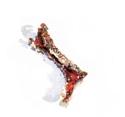
CONTENT THESIS 01 STUDIO BRIEF 02 THESIS STATEMENT 03 FRAMEWORK 04 METHODOLOGY RESEARCH 01 CASE STUDIES 02 SAND BEHAVIOUR 03 GLASS STRATEGY 01 SAND STUDIES 02 COLLECTIVE SCENARIO AGENT PROTOTYPE 01 BEHAVIOURAL PROTOTYPE 02 DIGITAL PROTOTYPE BIBLIOGRAPHY APPENDIX 6 8 10 14 28 36 38 48 82 160 162 190 262 306 308 346 404 406

STUDIO BRIEF THESIS

STUDIO BRIEF

ELEMENTAL
Everything is architecture.
Hans Hollein
The research undertaken by the year’s studio under the guidance of Dr. Theodore Spyropoulos emphasises aspects of the elemental and how natural phenomena can be utilised as a form of technology and to devise strategies of a performative architecture as a response to global challenges in a planetary scale Sustaining life is the key motivation behind this brief. Students are to research, explore, and experiment with natural phenomena to develop techniques for generating materials and architecture depending on the on-site conditions and material contingencies. The harmonious relationship between architecture and nature is a key feature in this brief in an attempt to establish agendas for sustainable living. Architecture in this instance serves as an environmental machine. The elemental approach of this research challenges what architecture can be. How materials are devised? How energy can be harnessed? And How life can be sustained?
| 8 | AEOLIAN |
THESIS
| 9 | AEOLIAN | THESIS | 9 |
THESIS STATEMENT
GLASS ARCHITECTURE
The research addresses the process of desertification by utilising the desert’s onsite materiality and investigating its material contingency. The project focuses on the literal meaning of desertification, the physical spread of a desert over the living ecosystems, be it urban environment, rural vegetation or agricultural lands. The opportunity to bind particles by welding the sand surface was explored by attempting to replicate the emergence of fulgurites, glass formations created by lightning striking the desert surface.
By implementing models which force the material transformation of sand, the research is looking into the fusion of sand into the glass under high temperatures. The process has revealed an opportunity for applications of the strategy of the onsite fabrication of infrastructural formations which addresses the primary goal - the intervention to the physical spread of the desert. The glass structures augment the existing landscape and act as an obstacle against particle movements and will grow together with the dunes. Looking into the dynamics of dunes the aim is to slow down and redirect certain particles in a way to shape a new boundary of a desert.
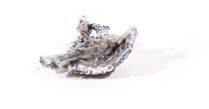
| 10 | AEOLIAN | THESIS
Due to the harsh dynamic context and the big scale of implementation, the glass structures is to be constructed by a high population of agents, which agency let them be autonomous in decision making in a constantly changing environment, where solutions cannot be preplanned, thereby introducing another aspect of the project: the systematic organisation of the collective behaviour of agents.
The agents are programmed to be autonomous in the decision making of on-site fabrication, the trajectory of movement, and collaborative production. The network of movement is logistically simulated according to the local data and satellite imagine. This network is constantly changing with the movement of dunes and alterations to the landscape, creating a one-to-one dialogue between agents and the dynamic landscape.
Spreading toward the desert, structures would potentially leave a safe trace behind, giving the opportunity for the development of natural or urban fabric. Therefore, the strategy works not only as the prevention of desert spread but also as an amplification of life within the desert.
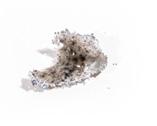
| 11 | AEOLIAN | THESIS | 11 |


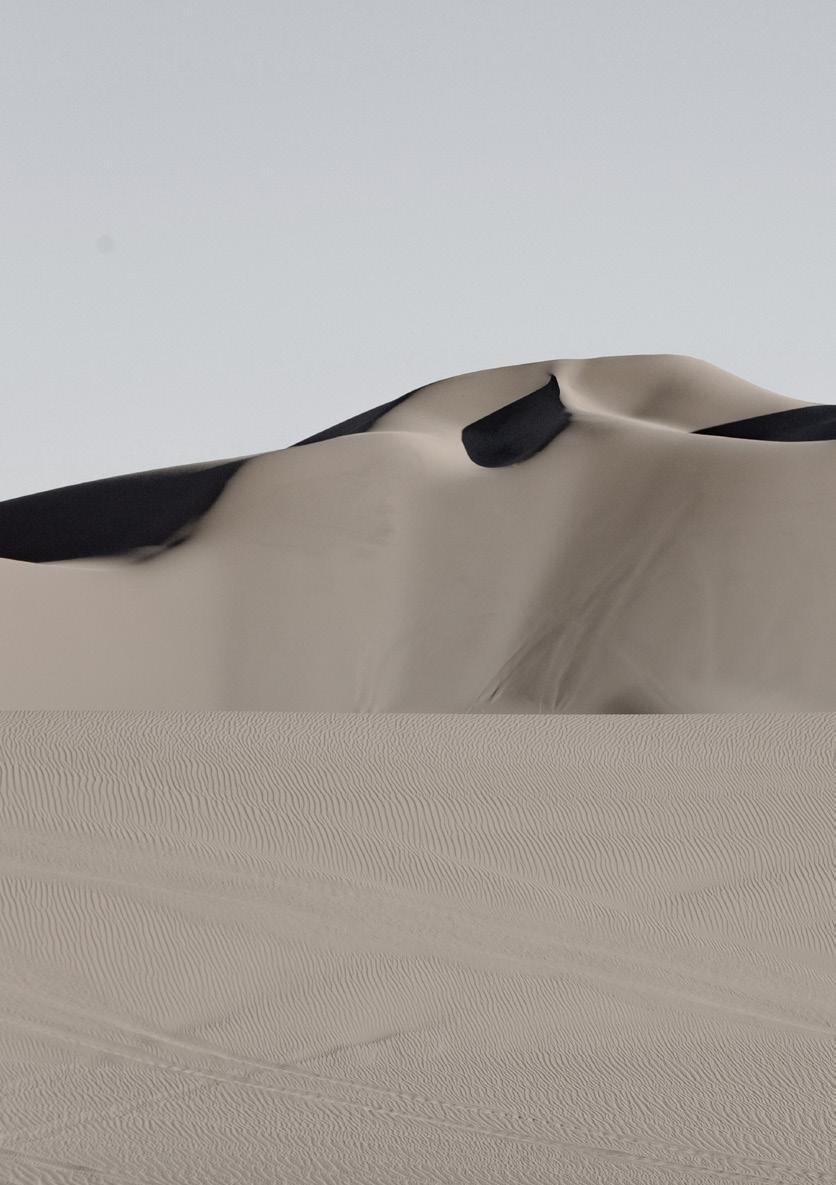
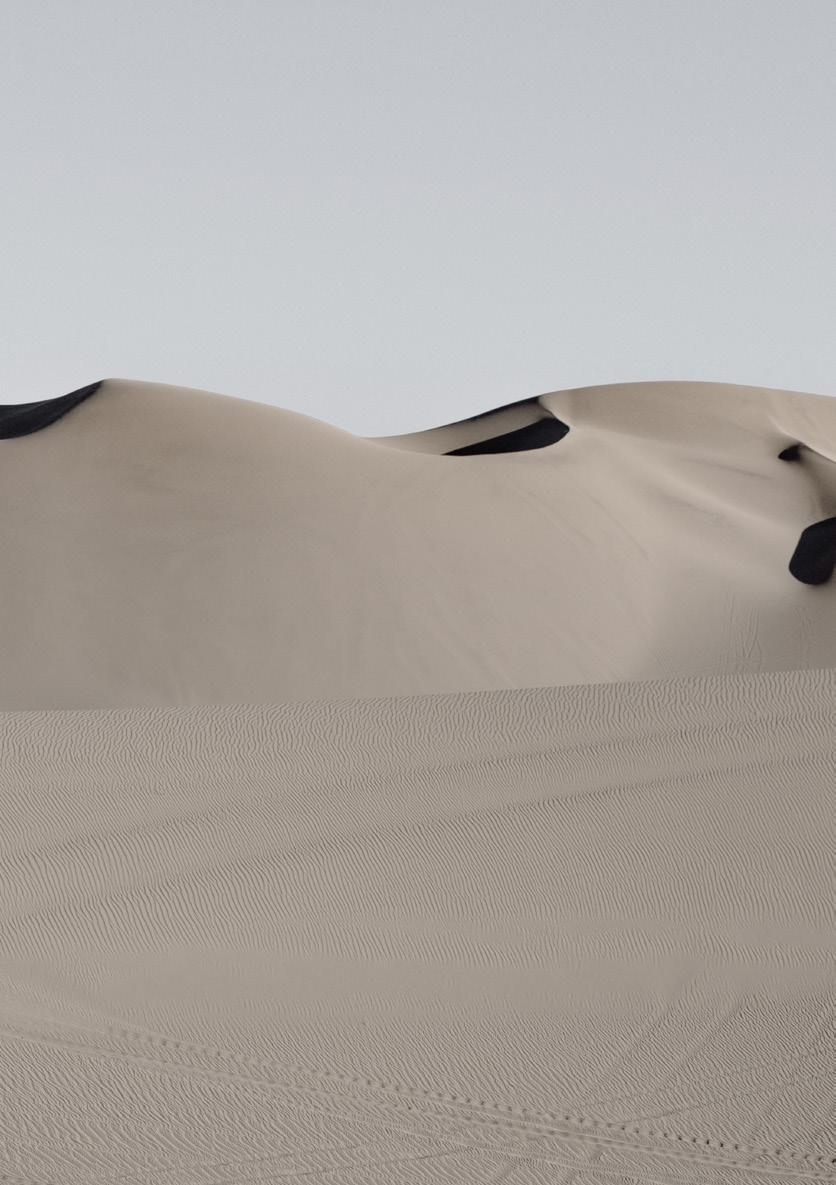
FRAMEWORK THESIS
FRAMEWORK DESERTIFICATION
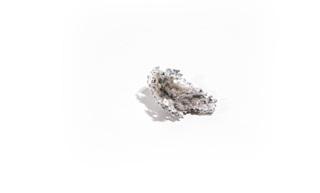
Desertification is the degradation of land by transforming fertile earth to dirt, terraforming an environment lush with life to an extreme environment where life is unable to thrive. The desert expands through a process called “soil erosion”, which describes how nutrient rich soil is stripped away from the land through the actions of the wind and rain. This phenomena is caused by variations in climate which is attributed by human activities such as urbanization, agriculture, and extraction of resources. Urbanization requires an extensive amount of land and energy to be self sufficient. Agricultural practices overuses, fertilizes, and treats soil to an extent where it becomes at risk of erosion. Resource extracting operations such as oil fields and mining strips essential elements from land by terraforming the landscape to a harsh environment. Reduced water retention capacity of degraded soils amplifies floods. It reinforces degradation processes through soil erosion, and reduces the annual intake of water to aquifers, exacerbating existing water scarcities.
Desertification is generally associated with biodiversity loss whilst many species within drylands are threatened with extinction. “For example, species richness decreased from 234 species in 1978 to 95 in 2011 following long periods of drought and human-driven degradation on the steppe land of southwestern Algeria. In North Africa, long-term monitoring (1978–2014) has shown that important plant perennial species have also disappeared due to drought.”1
About 821 million people globally were food insecure in 2017, of whom 63% in Asia, 31% in Africa and 5% in Latin America and the Caribbean. The global number of food insecure people rose by 37 million since 2014.
There is also robust evidence of the negative impacts on agricultural productivity and incomes due to desertification. Cultivating wheat, maize, and rice with unsustainable land management practices is currently resulting in global losses of 56.6 billion USD annually, with another 8.7 billion USD of annual losses due to lower livestock productivity caused by rangeland degradation.
Climate change impacts migration as well. UN investigations predicted that around 250 million people would be displaced by 2050 if no climate action is taken.
In addition, this effect is exacerbated as plants are removed from the environments. Plants are capable of absorbing carbon dioxide and using it as a source to produce oxygen and transporting nutrients to Earth. Reducing the plants population decreases the amount of carbon dioxide removed from the air, which contributes to the warming of the earth, deserts’ expansion, desertification.
| 16 | AEOLIAN | THESIS
1 Alisher Mirzabaev and Jianguo Wu, “SPECIAL REPORT: SPECIAL REPORT ON CLIMATE CHANGE AND LAND, Chapter 3, Desertification”. The Intergovernmental Panel on Climate Change (IPCC), https://www.ipcc.ch/srccl/chapter/chapter-3/
BETWEEN 1980’S - PRESENT VEGETATION DECLINE IS AT 9.2%
4.18 MILLION SQUARE KILOMTRES IS DEGRADED ANNUALLY, AFRICA AND ASIA BEING THE MOST AFFECTED


Desertifying Areas On Earth

Desertification currently occurs in arid, semi-arid, and dry sub-humid areas of the world, home to approximately 3 billion people. Over the past several decades, the range and intensity of desertification have increased in dryland areas. Figure 1 shows a map of areas in the world suffering from the effects of desertification. These areas are identified by the decline of vegetation over time between the 1980’s until present. As seen on the map, areas that would be most affected are in Australia, South and East Asia, the Sahara region in North Africa, the Middle East, Mexico and the Eastern States in the United States of America. Additionally, some parts along South America could also be affected.
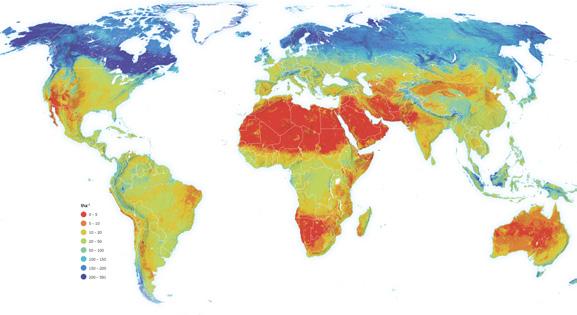
Impact On Life On Earth
Desertification places significant environmental, social, economical, and political stress on humanity through the damage of ecosystems and the eventual competition on the little available resources. Additionally, all forms of lives on earth would be at risk, disrupting the global chains. Already has the effects of desertification reduce productivity and income in the agricultural sector and over extraction of water have depleted supplies.
| 18 | AEOLIAN | THESIS
Figure 1. Soil Organic Carbon Stock Map

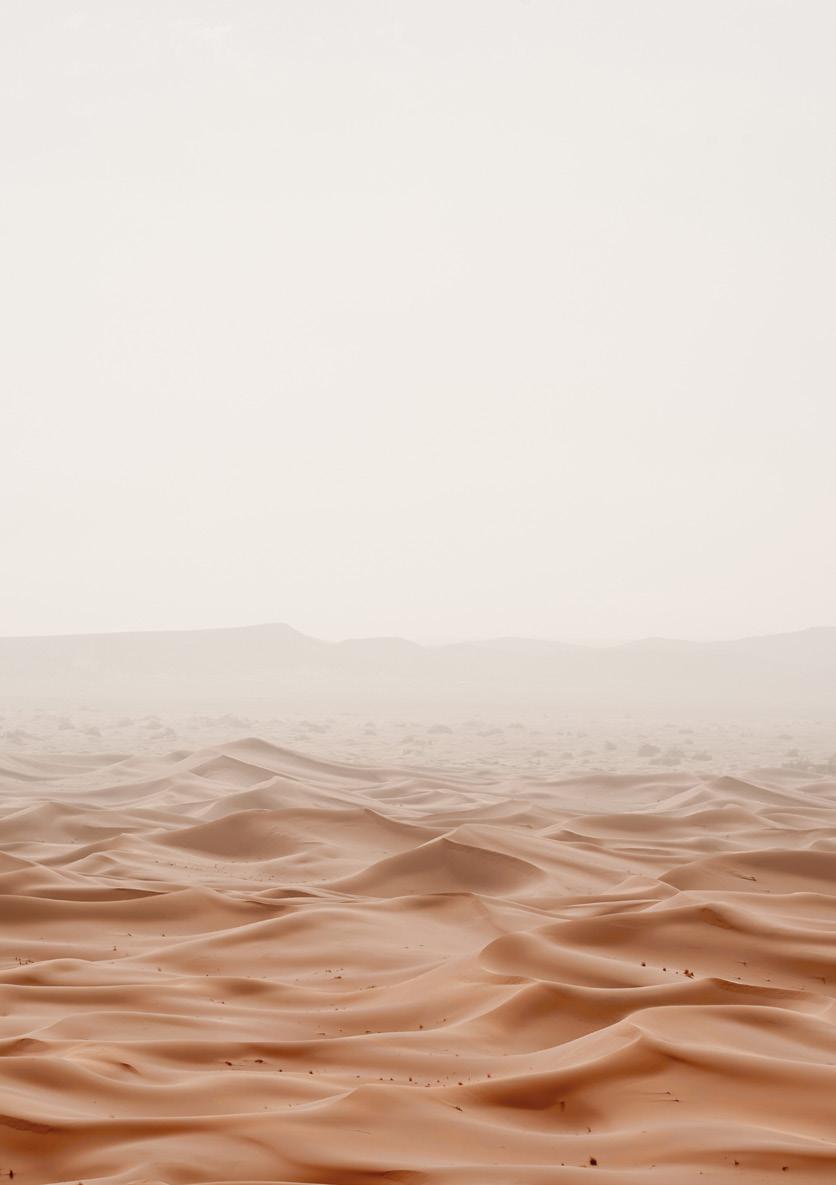
Seasonality
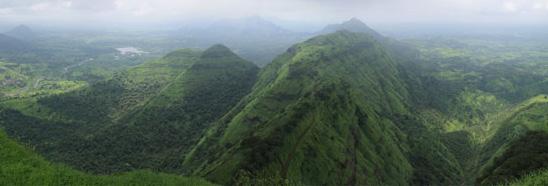
Depending on the time of the year, the ratio between vegetation and desert goes through dramatic changes that influences the global ecosystem. This is due to the fact the plants grow best at certain temperatures. In areas with cold temperatures, plants go into a state of hibernation while in areas with hot temperatures, plants are unable to grow. The summer time is an essential time of the year where plant growth is at its highest as seen (on the right) for the months of June, July, and August, while it is at its lowest in winter months of December, January, and February. In countries that experience monsoons, the change in landscape is extensively dramatic. Prior to the monsoon season, the landscape is bare and dry. After the monsoon, the landscape is green and full of life, as seen in the images below.
Using satellite images from NASA’s earth observatory allows a comprehensive visual understanding of global-scale patterns of vegetation. These diagrams are often used by scientists and other experts to study changes in the biome. Additionally, it helps analysing the activity of photosynthesis and its ability in removing carbon dioxide from the atmosphere (a study of carbon cycles). Desertification has made the shift more drastic, occupying more land than the norm.
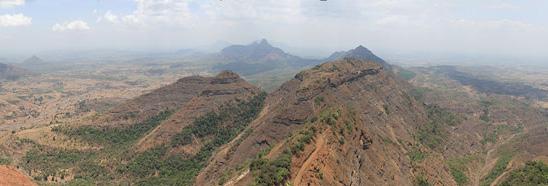
| 20 | AEOLIAN | THESIS
Western Ghats, India - Before Monsoon
Western Ghats, India - After Monsoon

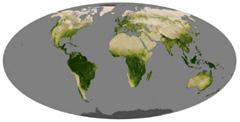

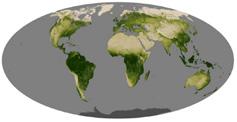

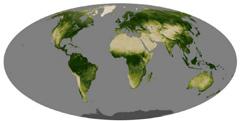
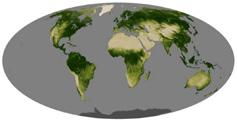
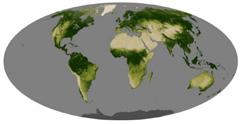

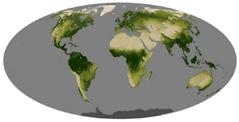
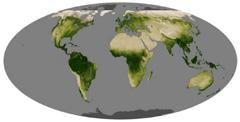
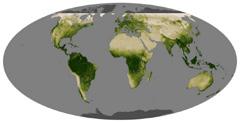
| 21 | AEOLIAN | THESIS | 21 | January February March April May June October November December July August September
CARBON DIOXIDE EMISSIONS:
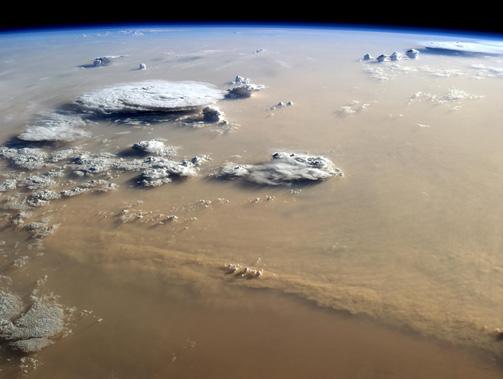
As the process of desertification occupies and transforms green life to deserts, carbon dioxide absorbtion decreases, resulting in increased levels of CO2 emissions, heating the earth further.
DROUGHT:
Due to increased temperatures, water sources such as lakes are prone to evaporation, Drying land that previously hosted an abundance of life. Dry lands are incapable of hosting any form of life to thrive in such conditions.
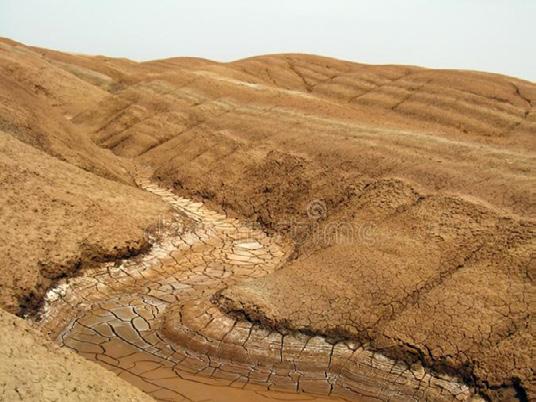
| 22 | AEOLIAN | THESIS
Sand Storm - Satellite Photo - Earth Satellite view; A large portion of sand covers the atmosphere during a sand storm.
Lake Mead Drying; Colorado, Arizona, USA;The light colored rock bed above the shoreline indicates the decreased water levels of the reservoir
MALNUTRITION:
Farm lands are significantly affected by desertification either by drought or wind erosion. Drought dries land, makes crop growth difficult or not possible. Wind erosion carries fertile soil away from the land, transforming microbes found in soil to dirt.
MASS DISPLACEMENT:
As the effects of desertification eradicates water sources and farm land, expands onto civilized land, those living near affected land are forced to migrate. In addition, a lack of resources often generates competition for resources which often result in violence and war. According to the United Nation’s World Water Development Report, it is estimated that by the year 2050, approximately 200 million people could be displaced as a result of desertification.


| 23 | AEOLIAN | THESIS | 23 |
Desertified Farm Land; Almeria, Spain; The image indicates a farmland in Spain that yields low crops due to desertification.
Desert refugees; Sahara Desert, Africa; The light colored rock bed above the shoreline indicates the decreased water levels of the reservoir
SAHARA DESERT EXPANSION

As the process of global warming accelerates, the desertification expands as well. The Sahara desert expanded for more than 10% since 1920.1 According to the satellite images, the expansion of Sahara is accelerating during the last decade.

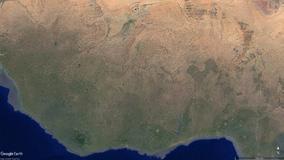
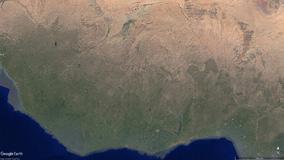
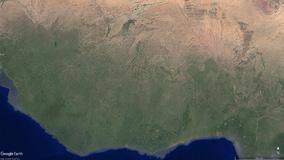
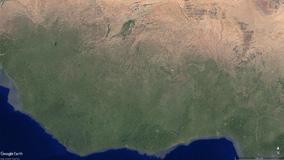
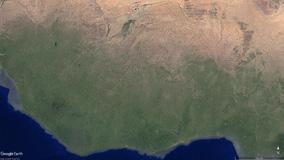

| 24 | AEOLIAN | THESIS
1 Richard Gray, “The wall holding back a desert”, BBC, September 9, 2019. https://www.bbc.com/future/article/20190902-the-wall-holding-back-a-desert#:~:text=Over%20the%20 past%20century%2C%20the,km%20over%20the%20same%20period.
2002-12
2005-12
2009-12
2012-12
2013-12
2016-12
2018-12
2020-12
DESERT OVERTAKE
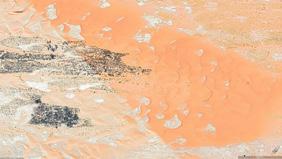


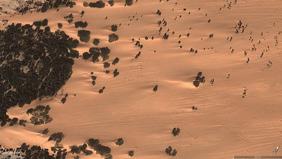
The desert keeps overtaking living environments. For the 20 years, it may take 50 meters of vegetation. Greenery on the border with the desert is extremely vulnerable. Sand literally is burying the growing plants. If the plant is young, small and fragile, it barely has chances to rise under the pressure of the sand.
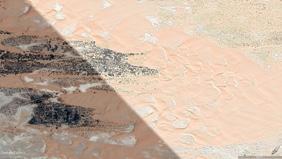
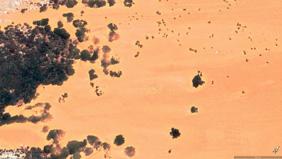
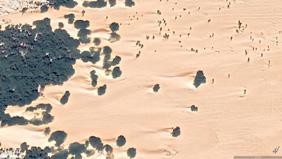
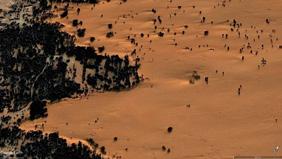
| 25 | AEOLIAN | THESIS | 25 |
2002-12
2002-12
2012-12
2012-12
2018-11
2018-11
2021-12
2021-5
NATURAL BARRIER
In the desert rocks and hills organise natural barriers. Located under the angle to the wind direction, the sand is moving avoiding the space behind the barrier.
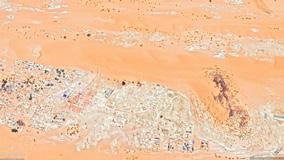
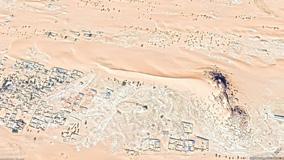
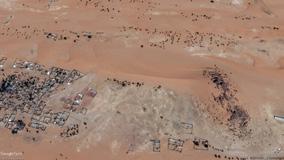
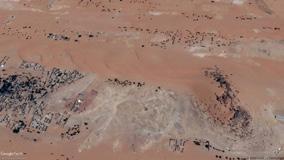
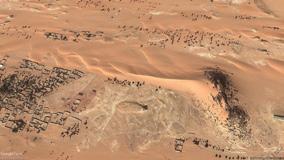
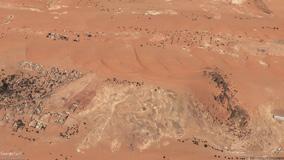
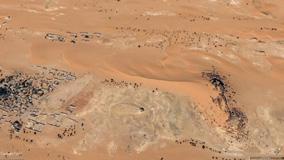
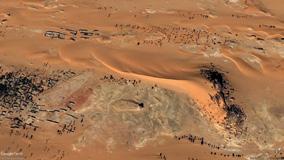
| 26 | AEOLIAN | THESIS
2002-12 2005-10 2009-06 2012-12 2013-07 2016-07 2018-11 2021-05
DUNE MOVEMENT
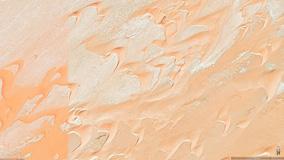
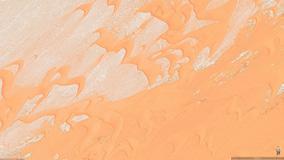


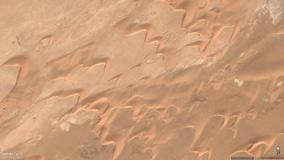
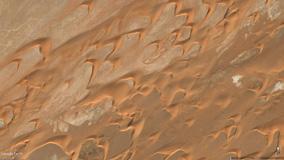
The desert keeps overtaking living environments. For the 20 years, it may take 50 meters of vegetation. Greenery on the border with the desert is extremely vulnerable. Sand literally is burying the growing plants. If the plant is young, small and fragile, it barely has chances to rise under the pressure of the sand.
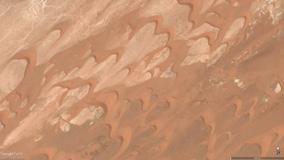
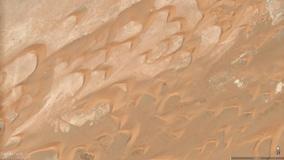
| 27 | AEOLIAN | THESIS | 27 |
2002-12 2005-10 2009-06 2012-12 2013-07 2016-07 2018-11 2021-05
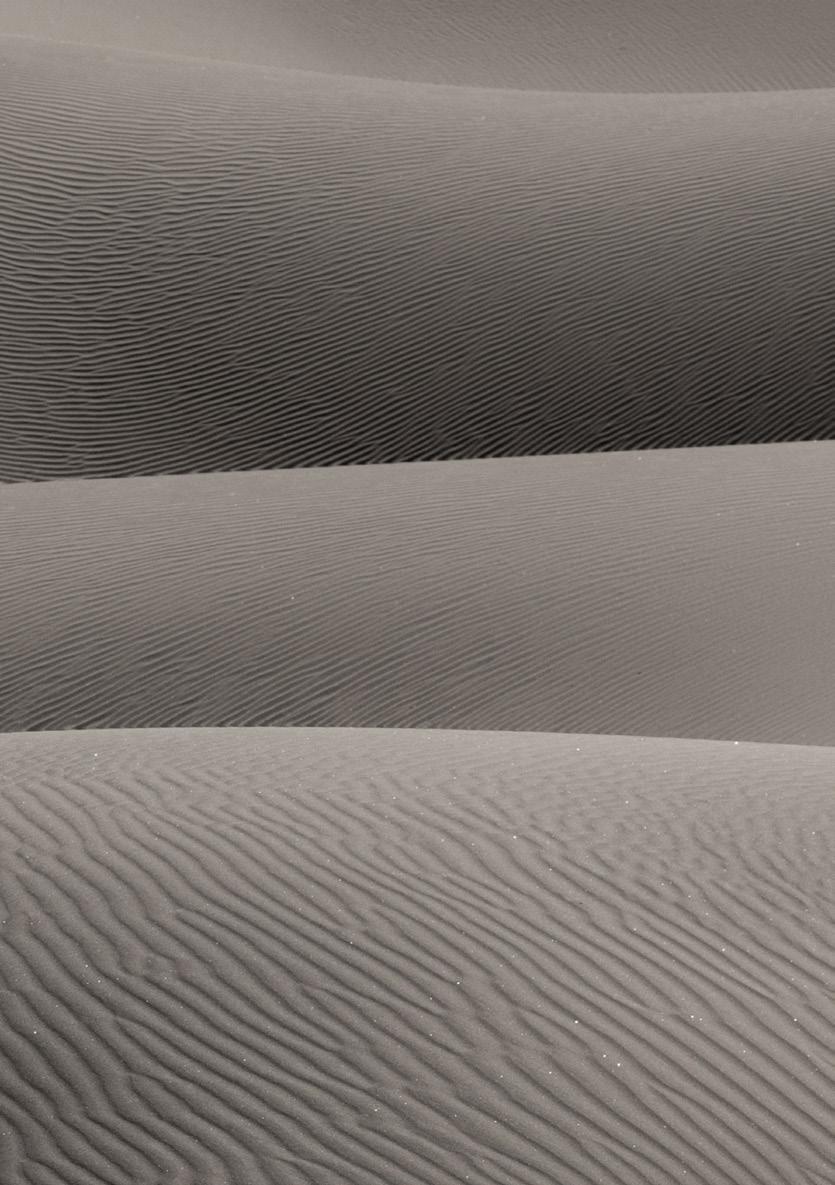
METHODOLOGY THESIS

METHODOLOGY
CYBERNETICS
The altered environmental conditions of today can no longer be mastered with the architectural resources of the past..
Frei Otto
For the dynamic and extreme environment conditions like in desert, traditional architecture lacks agency, as conditions and landscape formations cannot be predicted and solution cannot be planned, not to say lack of accessibility and infrastructure. The only way of having architecture there, is to construct not with already preplanned solution but in the exact moment in time according to the exact conditions of the environment. Architecture must be done immediately according to specific rules, but not blueprints. Simply stated, what we are evolving are the rules for generating form, rather than the forms themselves. We are describing processes, not components; ours is the packet-of-seeds as opposed to the bag-of-bricks approach.1
The use and harnessing of nature as a form of technology are vital to the research and core design methodology. To achieve such lofty goals, the proposal of the project is in the deployment of high populations of machinic agents on-site whose agency is central to the thesis: the fuse of sand into the glass for purposes of creating structures capable of diffusing and deflecting the expanding desert away from populated areas and living ecosystem. For such a system, cybernetic concepts became central to the overall integrity of the agenda at hand.
| 30 | AEOLIAN | THESIS
1 John Frazer, An Evolutionary Architecture, (London: E.G. Bond Ltd., 1995), 99
Two types of relationships were employed, the first being a machine-to-machine relationship as a strategy of communication between localised agents on a grander global scale. This was achieved through the implementation of stigmergic behaviours such as those found in ant colonies. Thus, like ants who indicate information on directions towards a food source or back home to the colony through pheromones, the glass structures would like-wise convey information for agents on where their target locations are and where to fuse sand into glass. The agents have the necessary sensors for communication with each other and to sense the landscape and manufactured structures to behave accordingly.
Another cybernetic relationship is more unusual as it commands the conveying on-site conditions in real-time, that is, a machine-to-nature relationship, which attempts for the machine to learn from the site and its conditions whilst the natural landscape in return would react to the conditions of the structures generated by the deployed machines. This strategy unfolds through the use of real-time data sensing technology in the agents, however, more importantly, it is expressed in how agents respond to on-site conditions and vice-versa, how the dynamic landscape reacts to the glass structures infused on site.
| 31 | AEOLIAN | THESIS | 31 |
NATURE AS A PHENOMENA REALIZING NATURAL RESOURCES

To sustain life, locally available resources must be utilized efficiently and intelligently to produce outcomes that are viable for material sourcing, and to promote a way of life that is self-sustaining. At first glance the desert gives an impression of emptiness, however, it is in abundance of resources that could fuel a new life.
Material
Constructing spatial environments in the desert where there are no forms of supply chains (highways, ports, etc..), harnessing on-site resources as for materialization and construction is essential.

Environment
Understanding the properties of the desert and the unique phenomena’s that couldn’t be generated elsewhere to strategize methods of using environmental phenomena as technology.
| 32 | AEOLIAN | THESIS
MATERIAL
SAND: IT’S PROPERTIES & PARAMETERS Sand
Without sand there is no desert. Sand is nothing more than grain-like material composed of fine rock and mineral particles. Mainly made of silicate minerals and silicate rock granular particles.
| 33 | AEOLIAN | THESIS | 33 |
Very Fine Fine Medium Coarse Very Coarse 0.074 mm - 0.125 mm 0.125 mm - 0.250 mm 0.250 mm - 0.500 mm 0.500 mm - 1.000 mm 1.000 mm - 2.000 mm Classes of Sand: Size Volume Weight 0.074 m - 4.75 m 0.00012 m - 4.2 m 0.3 μg - 13 mg Essential Parameters: Shape Cohesiveness pH Thermal Conductivity Rounded Very little Cohesions 7 - Neutral 2-4 W/m-K Properties of Sand: I)
7.5 QUADRILLION
GRAINS OF SAND EXIST ON EARTH
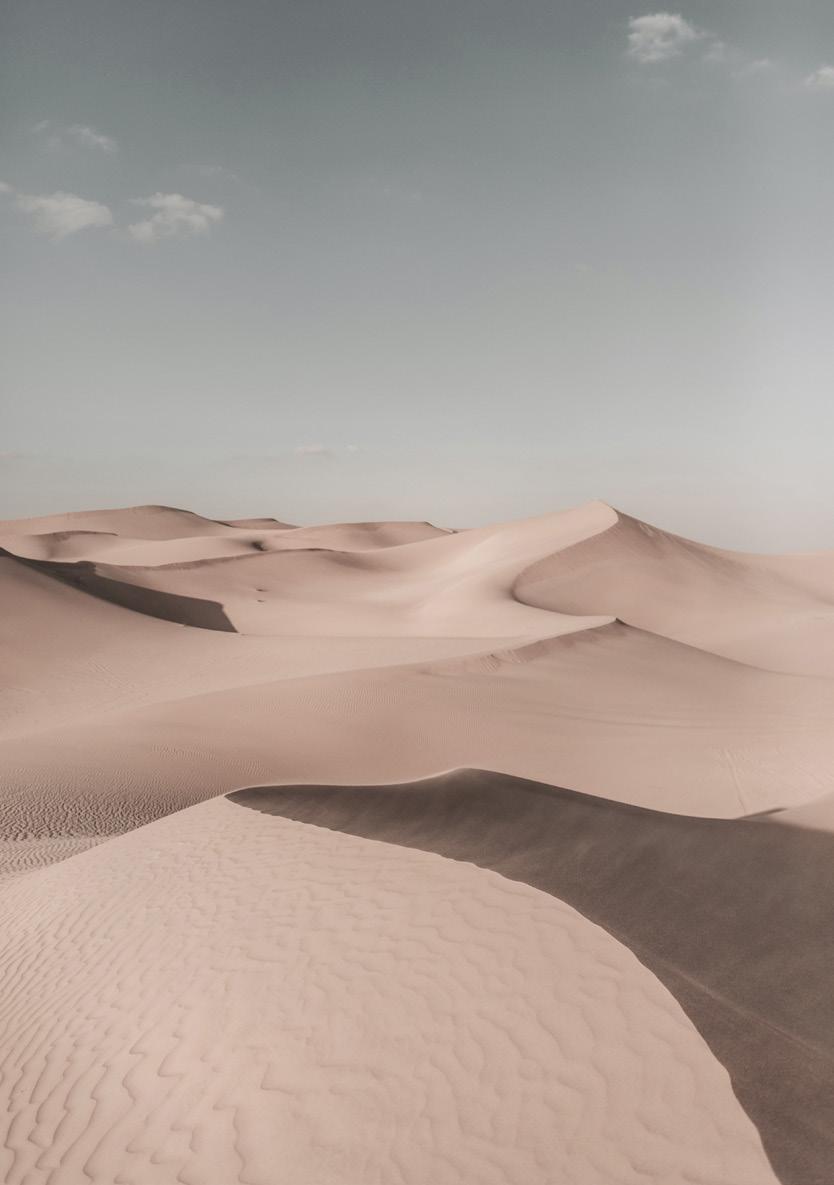
ENVIRONMENT
THE WIND & THE HEAT: HOW THEY INFLUENCE THE DESERT
II)
Wind
The shaper of the desert, wind plays a large role in the desert, crafting the shapes of dunes, moving sand particles to great distances, and the main catalyst/parameter of the overall phenotype that is the desert. Wind is also the driving force of soil erosion, a natural process where soil is transported from one location to another. When fields of soil are damaged, it does so abundantly, desertifying landscapes.
III)
Heat
High temperatures mark the deserts, creating extreme environments where it becomes incredibly difficult for any form of life to thrive. Among all biomes, rainfall is least in deserts, giving it a vital characteristic of dryness. Allowing the desert air to become very cool at night as heat escapes the sands. Extreme conditions enables species to evolve and adapt. Extreme heat allows for adaptation. Plants and animal that do live in the desert acquire special adaptations to survive in such an environment. For example, most animals living in deserts are nocturnal, and stay beneath shades or remain buried underground during the significant heat of the day time. They develop efficient strategies for water conservation and extraction or simply remain in a state called “dormancy”.
| 35 | AEOLIAN | THESIS | 35 |

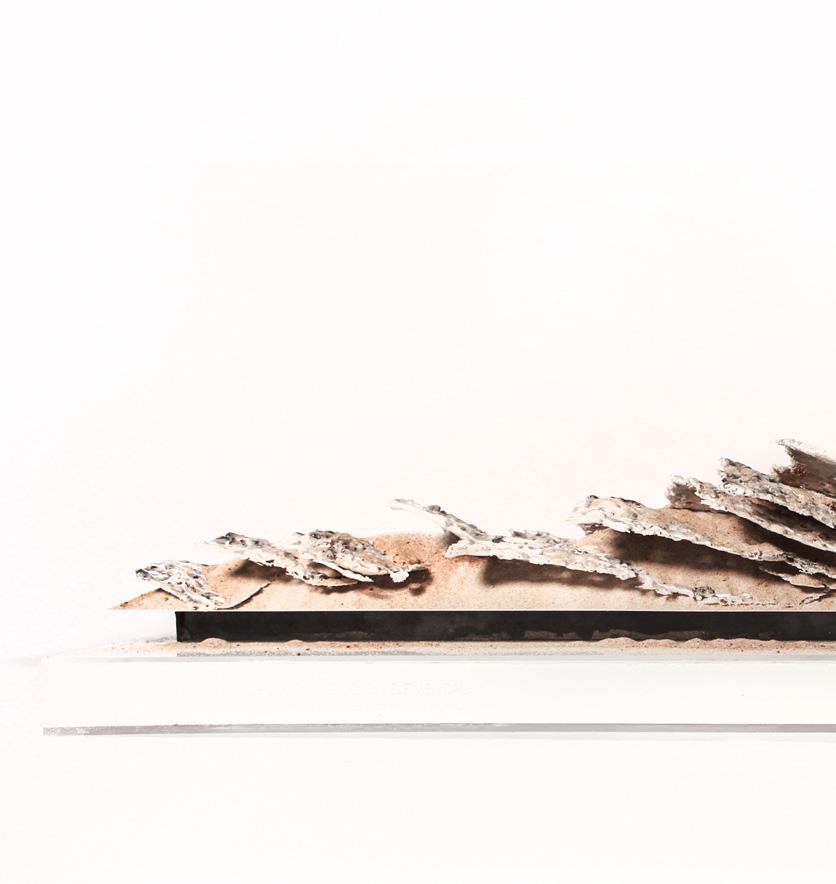
RESEARCH MATERIAL SYSTEM


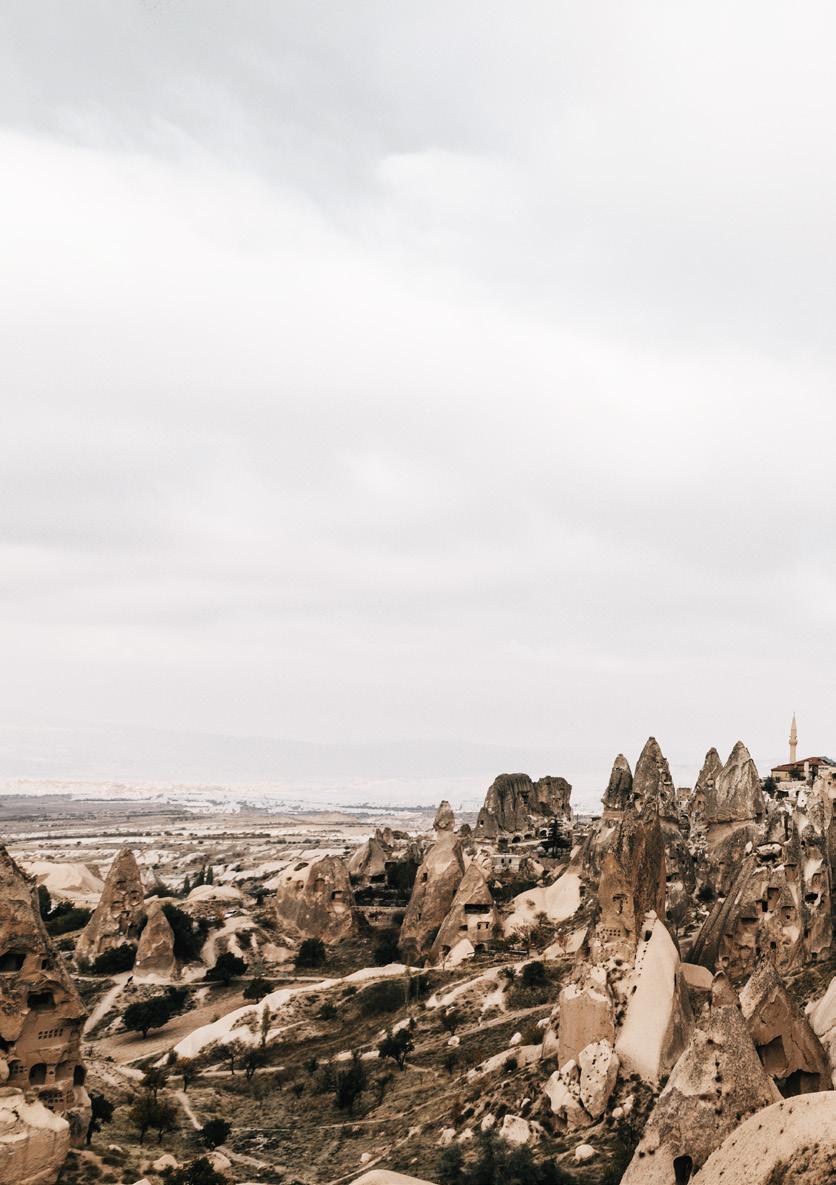
CASE STUDIES
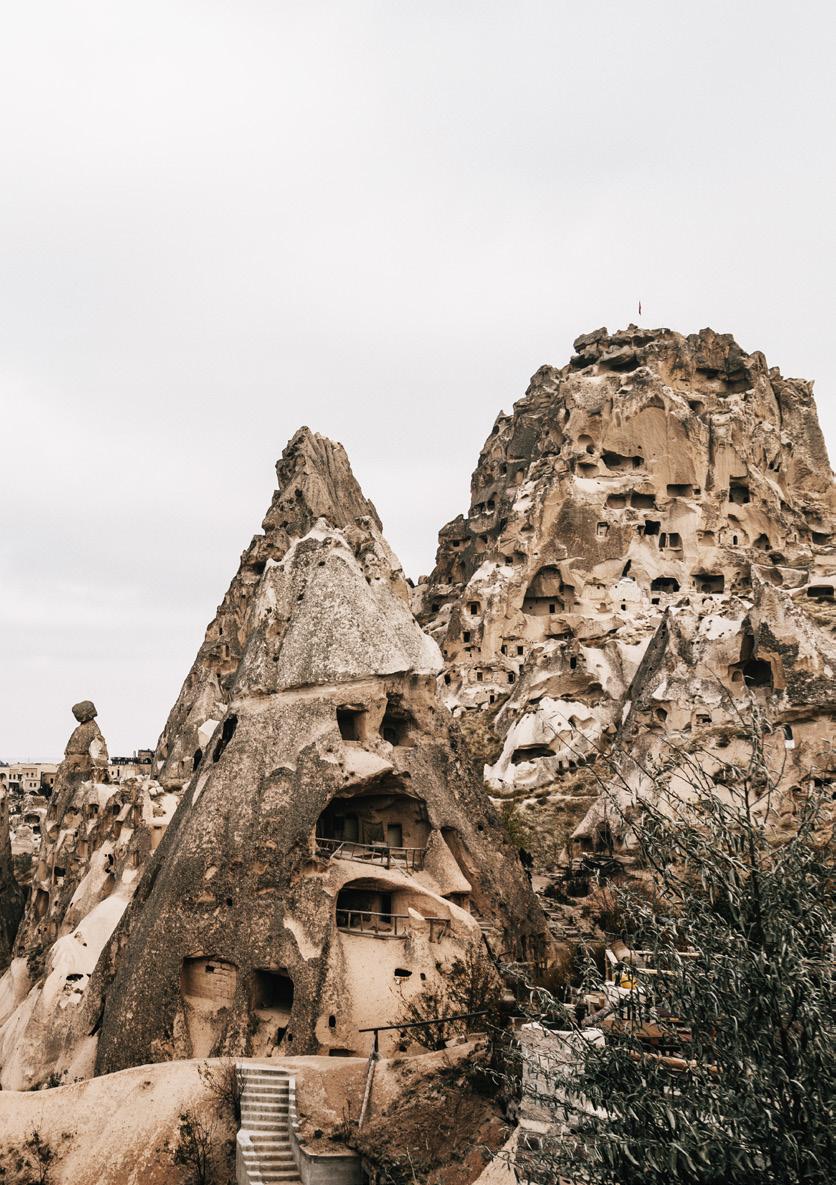
GLASS MANUFACTURE
The glass used for domestic purposes increased the growth of the industrial revolution. During the 19th century, people prefer to use glass as material for windows and doors for decorative purposes. Architectural designers apply glass for stained glass in decorative windows. In the 20th century, the versatile purpose in the glass was widely used for windows on skyscrapers, houses and offices. There are two common ways to manufacture glass: Float Glass and Glass-blowing.
I) Float Glass1
Sheet glass
Batching: Raw materials, including soda lime glass, silica sand (73%), calcium oxide (9%), soda (13%), and magnesium (4%), are weighed and mixed together in batches, which also includes recycled glass (cullet).
Melting:
The raw materials are then moved to a five-chambered furnace where they are heated to approximately 1500°C, turning them into a molten state.
Drawing:
The molten glass is “floated” onto a bath of molten tin at a temperature of about 1000°C, forming a ribbon with a width of 3210mm and a thickness between 3 and 25mm.
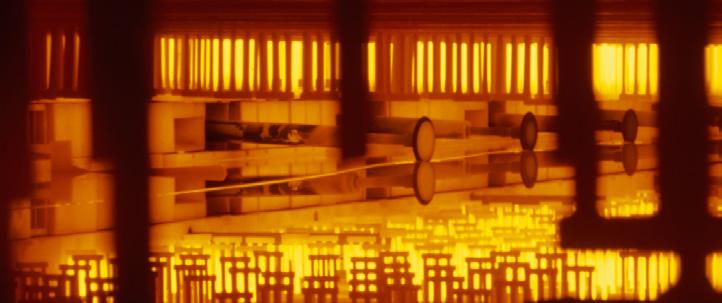
Cooling:
After leaving the tin bath, the glass cools to 600°C, it is then passed to an annealing chamber, which modifies the internal stresses and ensures flatness of the glass.
Cutting and Storage:
After cooling, the glass goes through a quality check, is washed and then cut into sheets of up to 6000mm x 3210mm, which are stacked, stored and ready for transport.”
1"Glass Academy - Float Glass Production Process." last modified September 10th, 2022. http://glass-academy.com/float-glass-production-process/
AEOLIAN |
SYSTEM | 40 |
MATERIAL
1
Moulding : Heated liquid glass is dropped into a blank mould
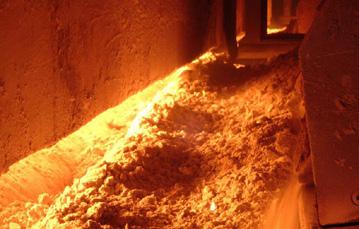
Forming : Shaping the neck part
Blowing: A blast of air is introduced through the formed neck, expanding the liquid glass into the walls of the partition mould. The reheated glass takes on its final shape in the moulds.
Finishing: The final shape is achieved by using compressed air.
The most important take away from this research is the evolution and applicability of making glass, a vital element to consider in the team’s research as various methods are explored for strategizing the fabrication of such elements.

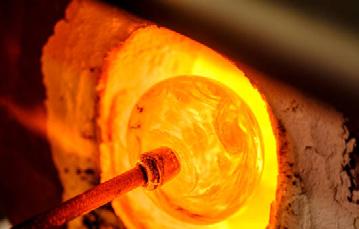

AEOLIAN | MATERIAL SYSTEM | 41 |
Fig. 1 Float tank interior
Fig. 2 Meilting raw material in the furnace
Fig. 3 Solid glass from the annealer
Fig. 4 Forming the bottles
Fig. 5 Glassblowing process
II) Glass-blowing Bottles and other containers
2 | 3 4 | 5
STONE SPRAY
ANNA KILIK, INDER SHERGILL, PETR NOVIKOV for IAAC
Student from Institute for Advanced Architecture of Catalonia have built a robotic 3D printer that creates architectural structures from sand. The Stone Spray robot sprays the grains of sand or soil out of one nozzle and glue out of another to make a mixture that solidifies as it hits a surface. The robot’s arm moves multi-directionally and can also print onto vertical surfaces.


The use of robotic systems to fabricate complex and generative morphology using sand mixture as a material. The disadvantage of the technique is a lack of scalability as the printer uses glue to bind sand particles, therefore the system cannot be autonomous to work on site

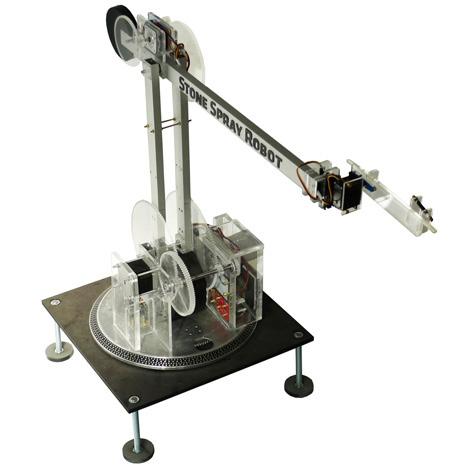
AEOLIAN | MATERIAL SYSTEM | 42 |

GLASS II MIT MEDIA LAB
The glass 3d printer made by MIT Media Lab has the ability to fuse sand into glass however it is very limited with the scale as the model should fit into the bounding box of the printer. The research resulted into the working version of the tool being capble of actually printing glass with the layering to be able for the model to grow in z direction.
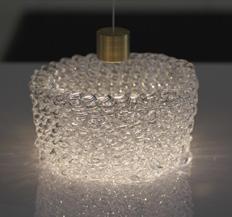
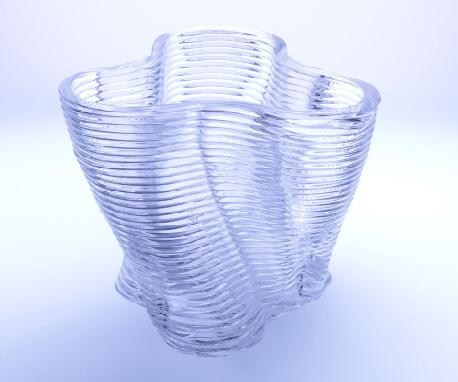
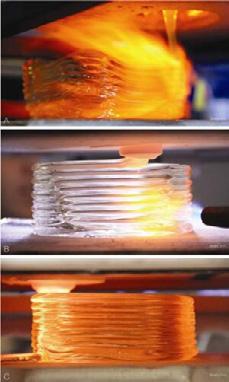
The properties and intricate knowledge regarding the properties of glass and how automative mechanisms can be used as a method of interactive with the material contengincy of glass was an essential in this research.
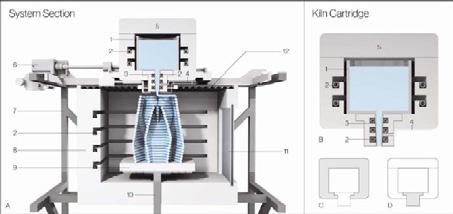
AEOLIAN | MATERIAL SYSTEM | 44 |
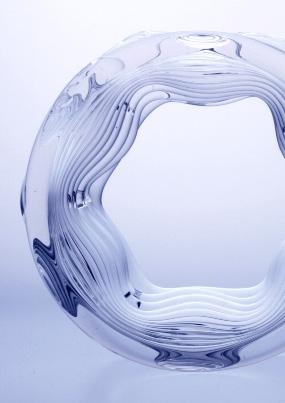
SOLAR PRINTING
HARNESSING SOLAR ENERGY FOR DIGITAL FABRICATION
German artist Markus Kayser devised an ingenious way of using natural phenomena as a technology to digitally fabricate using nothing more than the environment around him; the desert. He built a device that uses a large fresnal lense to focus beams of sun light, generating high amounts of energy, enough to melt sand and turn into solid glass. The project explores the potential of manufacturing in extreme environments like deserts by harnessing resources from the surroundings such as raw energy and materials to fabricate three-dimensionl objects. The following are two essential learnings from Kayser’s method of digital fabrication:
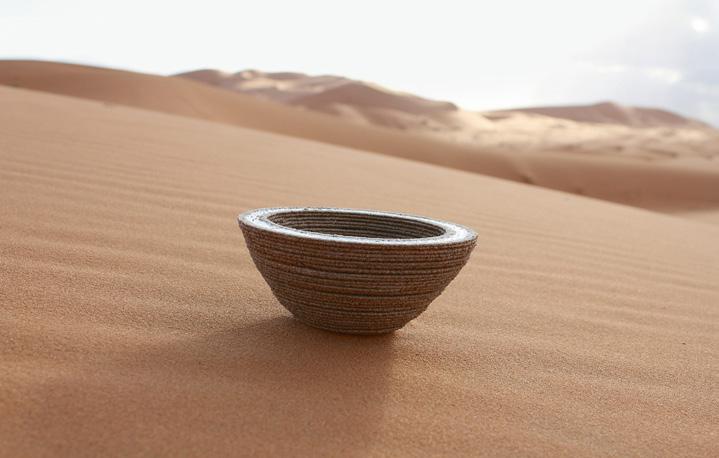
I. Machine
The machine is an essential part for this method of fabrication, it’s components are designed and put in place to enable a machine-like process tackle the surrounding environment and harnessing its resources. In this case, the heat as a form of energy and sand as a form of material resource
II) Fabrication Process
It is important to understand the essential factors of how glass objects can be fabricated using this machine. Beyond convert sunlight to highly concentrated sun-beams, the fabrication process goes through multiple stages that are not so different from traditional 3D printers. Recognizing both similarities and differences between both processes is an essential takeaway.
AEOLIAN | MATERIAL SYSTEM | 46 |
Fresnal Lense
The lense focuses beams of sun light, generating high amounts of energy, sufficient enough to melt sand and transforming it into solid glass.
Sandbox
The sandbox is used as field for the entire fabrication process. It is necessary to allow the entire remain in a static state, undisturbed by external forces.
Motorized Box
By placing motors on the box, it is able to move the printing field in the XY direction controlled via computer software.
Solar Panels
Harvesting energy from the sun and converting into electrical energy to power the entire the system offsite, allowing it to be a dynamic process of fabrication.
Fabrication Process
Converting Phenomena Into a Piece of Technology
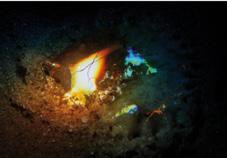
1. Heating
To convert sand particles into glass, the fresnal lense focuses the sunbeams onto the sand box with temperatures as high 1600 degrees Celsius. The generated energy converts sand to glass. The motion of the sandbox allows for custom shapes.
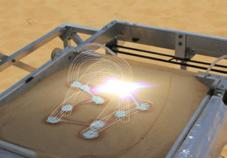
2. Layering
While the motion of the sandbox derives shapes, the result is twodimensional. To generate threedimensional shapes, the field is layered onto the vertical axis. Adding the Z-direction to the printing field.
3. Retrieval
Once the process is complete, the sandbox contains a lever, once pulled or rowed, it brings up the printed object buried underneath the sand.
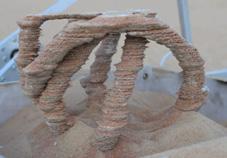
Certain aspects of the Solar Sintering research proved to be a vital element and source of inspiration with the project’s capabilities of using basic tools and equipments to harness natural phenomena as a form of technology.
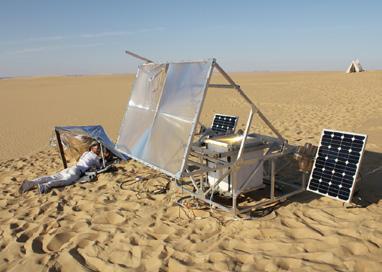
AEOLIAN | MATERIAL SYSTEM | 47 |
PARTICLE BEHAVIOUR
AEOLIAN PROCESS & THE BEHAVIOUR OF SAND

Aeolian refers to the Greek God of wind named Aeolus, the word translates to “rising from the actions of the wind”. It is used to describe many wind generated geological processes, especially those involving sand. In this chapter, the focus is on how the Aeolian Process shape the dynamic landscapes of the desert and the development of a research centered around these interactions to explore the forces that drive the geographic formations found in deserts.
I. Aeolian Transportation
It is the process by which dunes are formed. It defines the migrations of sand particles of all scales and how they journey across the desert, affecting it’s landscapes. An Individual particle has such a small impact if looked at a small lens however the aggregation and motion of the collective create the dynamism of the desert.
II. Aeolian Erosion
It is the process by which geological formations with unique geometries are generated in the desert. The wind becomes an essential tool, not only shaping the desert by motion but also by subtractive methods.
AEOLIAN | MATERIAL SYSTEM | 48 |
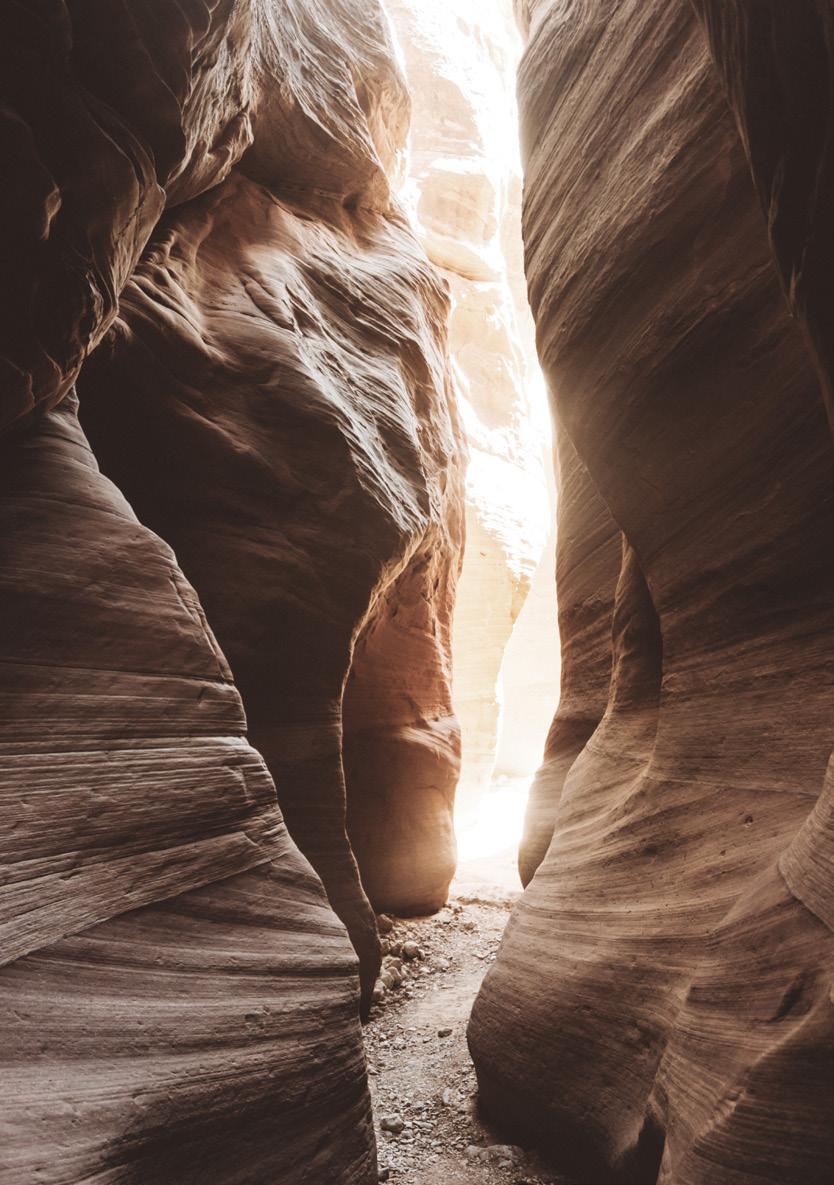
AEOLIAN TRANSPORTATION
THE PROCESS BEHIND THE FORMATION OF DUNES
This process describes the formations of dunes, and how the wind as a power force that shapes the desert and its overall environment. The dynamic, ever-changing formation of the desert can be mainly attributed by the wind. It is mainly a description of different classifications of particles and how the wind affect each of them differently to create a dune.
Aeolian Deposition
As the wind loses energy, it deposits these sand particles it has been carrying. This happens when either the wind loses its energy over a period of time or when sand particles collide with objects such as sedimentary rocks, causing the particles to accumulate over time. As the object gets larger, more material is deposited. Particles classified under the surface creep process begin this accumulation as they are closer to the ground, making obstacle collisions more frequent. Particles classified under the saltation processes contribute to this accumulation by colliding by either an obstacle it has collide with or with the pile of sand that has already accumulated after a period of time. Lastly, particles classified under the suspension process are only affected after they collide with a larger body of sand that has accumulated. With this process, dunes are formed; shaped by the wind.

AEOLIAN | MATERIAL SYSTEM | 50 |
01. SUSPENSION

Particle Size: <0.1 mm
Suspension defines the transportation of sand particles ranging from sizes smaller than 0.1 mm. As these particles are small and light, the wind carries them for very long distances; from hundreds to thousands of kilometers.
02.SALTATION
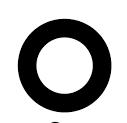
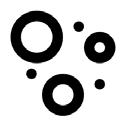
Particle Size: 0.1 mm - 1.00 mm
Saltation defines the transportation of sand particles ranging from sizes between 0.1 mm up to 1.00 mm. As the particles are heavier, the wind carries them tens to a few hundred kilometres. They often bounce up to 1.5 meters in height. This explains why rock formations eroded faster from the bottom.
03.SURFACE CREEP
Particle Size: >1.00mm
Surface Creep defines the transportation of sand particles ranging from sizes larger than 1.00 mm. As the particles are heavier, the wind is unable to carry them, instead the wind pushes and rolls them along the ground plane. This process leads to another process called Aeolian Deposition, which further explains how dunes are formed.
AEOLIAN | MATERIAL SYSTEM | 51 |
AEOLIAN EROSION
THE PROCESS BEHIND THE GEOLOGICAL FORMATION
This process describes how geological formations are formed (such as the images below), are formed in the desert. It is Aeolian, shaped by the wind. As part of Aeolian Transportation is defined as a process by which sand particles are carried throughout the desert, Aeolian Erosion is the process by which these particles collide with sedimentary rocks, little by little subtracting away very tiny particles, creating geological formation that is a result of an emergent behaviour. Small - low level components that contribute to a large - macrobehavior.

Deflation
Occurs when fine sand particles are picked up and carried by the wind away from a site, leaving piles upon piles of larger rocks in that was once burred by the sand ,behind, and resulting in a phenomena called “desert pavement”.
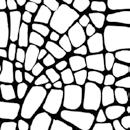
Abrasion
Occurs when sand particles carried in the wind blasts rock surfaces, this causes them to ware away. Rough edges become smoother and flatter. Desert rocks are susceptible to abrasions because they lack protective layers of soil and vegetation and are left exposed by the wind.
AEOLIAN | MATERIAL SYSTEM | 52 |
GEOLOGICAL FORMATIONS THE PROCESS BEHIND
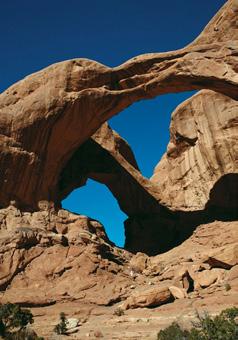
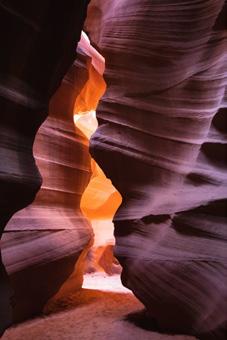
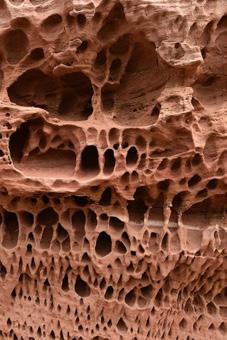
Geological Formations
Representing unique shapes and geometries that are produced naturally geological formations are defined by their physical characteristics. These characteristics are called Lithology, they include characteristics such as chemical, mineralogical composition, colour, texture, depositional structures, fossils (rock forming particles) and other organic compounds.
These formations take millions of years to occur in nature and enable geologists to create time markers to date the formation of strata. In addition, these formations offer insite to complex structures, geometries and spaces that can offer insight to designers. Their unique geometries draws people from all over the world to witness and experience a walk through geological time.
AEOLIAN | MATERIAL SYSTEM | 53 |
Tassili n’ Ajjer, Sahara, Algeria
Antelope Canyon, USA
Arches National Park, USA
DUNE FORMATION
In order to research the desert behaviour the difference in dune formation strategies were explored. There is a direct relationship between wind direction, speed and sand supply to generate specific type of the dune. The behaviour of sand dunes in the desert is significantly affected by the wind’s direction in seasonal changes. The formation of dunes is indicated by the influence of winds regimes. Morphologies of the sand dunes are divided into five major types based on the directionality of the on-site wind effect.
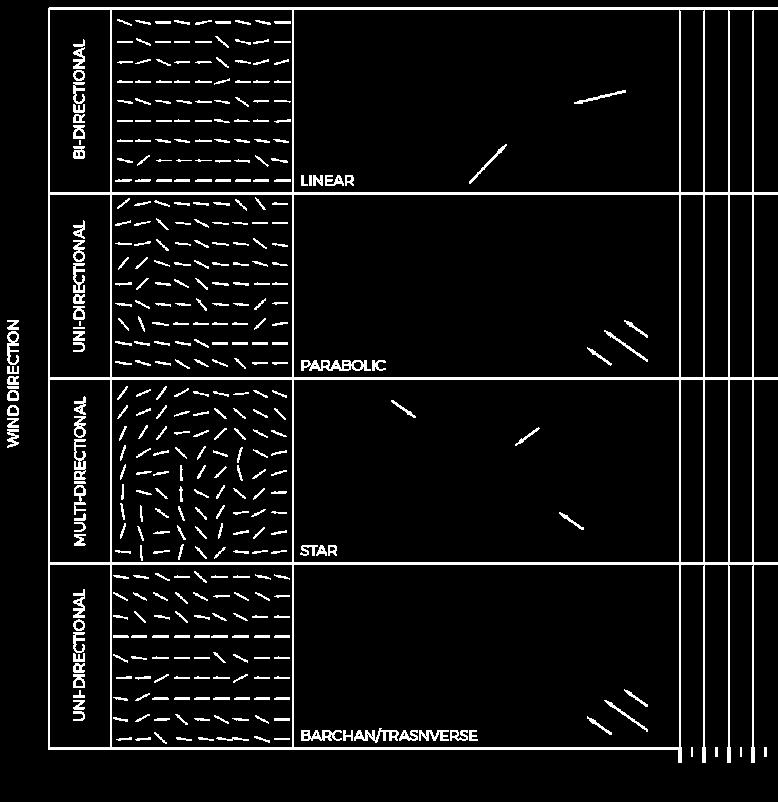
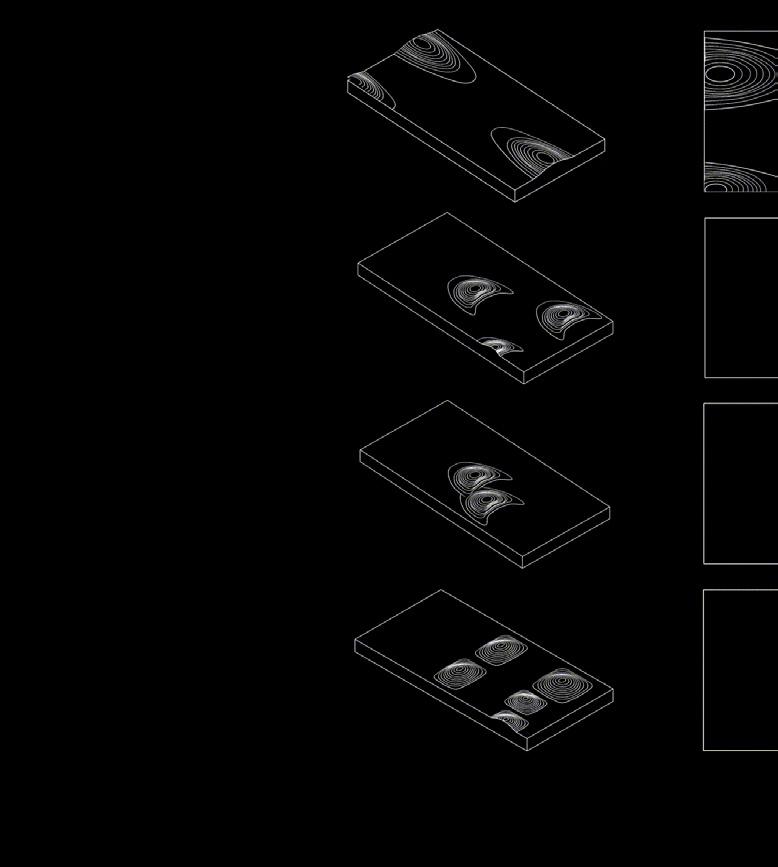
AEOLIAN | MATERIAL SYSTEM
The energy carried by the wind force in the desert plays an important role in the transformation and accumulation of the huge amount of sand. For instance, the formation of Barchans dunes requires continual wind supply from one direction. The character of Longitudinal dunes has ridges that are caused by parallel wind directions carrying limited sand supply within one direction. On the other hand, Star dunes are formed by wind force from various directions during seasons of a year. Dune behaviour and formation are strongly affected by on-site conditions: wind force, temperature, and solid terrain.
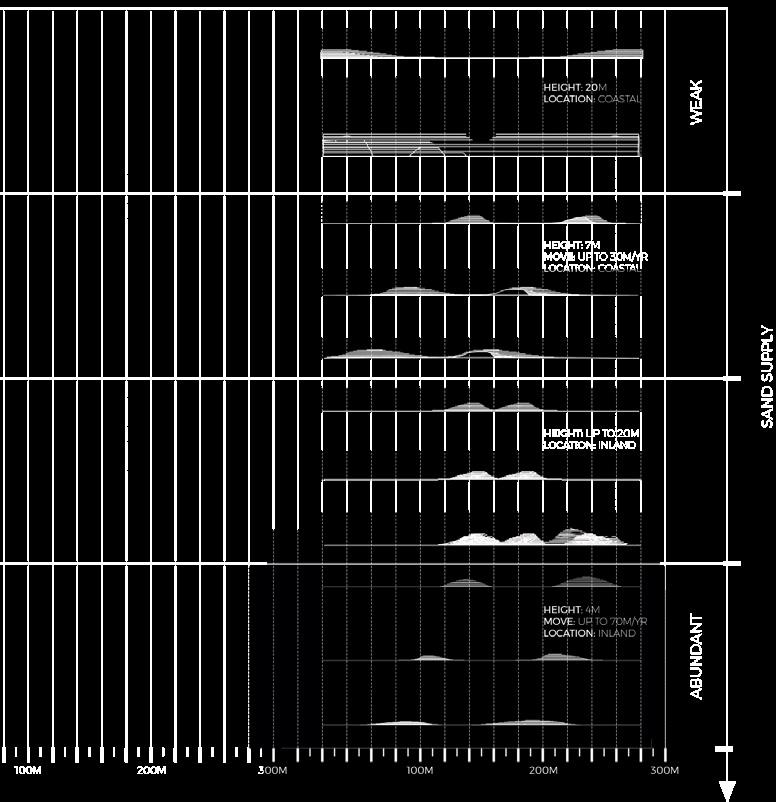

AEOLIAN | MATERIAL SYSTEM | 55 |
PARTICLE BEHAVIOR
DUNE FORMATION
Dune Formation Experiment
Next simulations attempt to recreate dune formations by using the computational logic behind the Cellular Automata: Abelian Sand-Pile Model rule set. Adjustable variables are put in place to control various parameters of the simulation and to visualize the different outcomes they create. Dune Frequency adjusts the size of the dunes formulating in X,Y,Z directions. Surface Amplitude generates the initial X,Y,Z conditions of the surface before the simulation starts, affecting how the dunes will collapse onto one another after meeting its height threshold. Lastly, Ripple Amplitude adjusts the frequency of sand ripples.
Cellular Automata : Abelian Sand-Pile Model
The model of cellular automata is specified to the generate a computational algorithm that follows the behavioural outset of how particles move and form dunes, as well as how dunes collapse to create new dunes.. It’s formulation functions as follows: each site on a finite grid has an associated value that corresponds to the slope of the pile. This slope builds up as “grains of sand” are randomly placed onto the pile until the slope exceeds a specified threshold value at which time that site collapses, transferring sand into the adjacent.
AEOLIAN | MATERIAL SYSTEM | 56 |

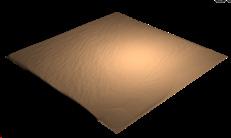
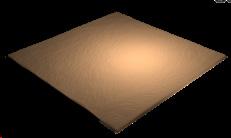

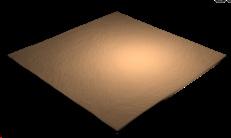

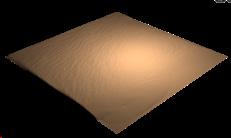
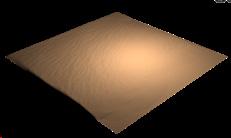
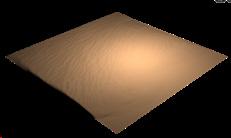

AEOLIAN | MATERIAL SYSTEM | 58 | 0 Seconds Elapsed 6 Seconds Elapsed 12 Seconds Elapsed 2 Seconds Elapsed 8 Seconds Elapsed 14 Seconds Elapsed 4 Seconds Elapsed 10 Seconds Elapsed 16 Seconds Elapsed Dune Frequency Surface Amplitude Ripple Amplitude Iteration 001 - Dune Formation 0.2mm 0.2mm 0.003mm
PARTICLE BEHAVIOUR

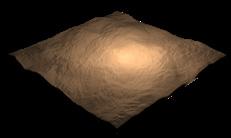
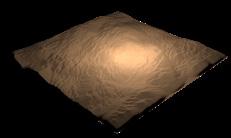
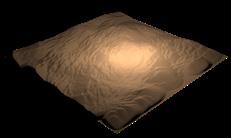

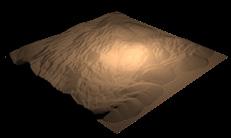

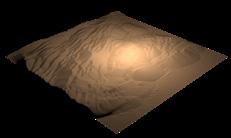
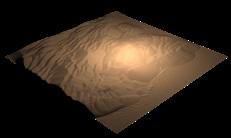
AEOLIAN | MATERIAL SYSTEM | 59 | 0 Seconds Elapsed 6 Seconds Elapsed 12 Seconds Elapsed 2 Seconds Elapsed 8 Seconds Elapsed 14 Seconds Elapsed 4 Seconds Elapsed 10 Seconds Elapsed 16 Seconds Elapsed Dune Frequency Surface Amplitude Ripple Amplitude Iteration 002 - Dune Formation 0.4mm 0.4mm 0.003mm
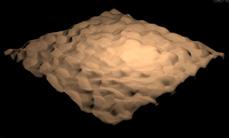
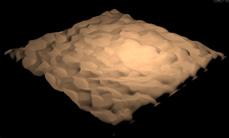


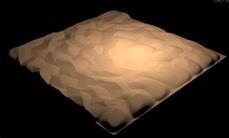

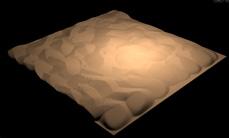
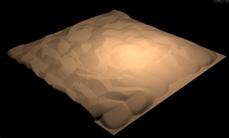
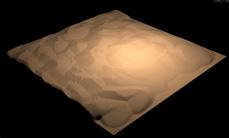
AEOLIAN | MATERIAL SYSTEM | 60 | 0 Seconds Elapsed 6 Seconds Elapsed 12 Seconds Elapsed 2 Seconds Elapsed 8 Seconds Elapsed 14 Seconds Elapsed 4 Seconds Elapsed 10 Seconds Elapsed 16 Seconds Elapsed Dune Frequency Surface Amplitude Ripple Amplitude Iteration 003 - Dune Formation 0.8mm 0.8mm 0.003mm
PARTICLE BEHAVIOUR
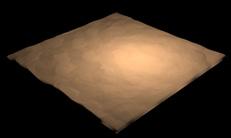
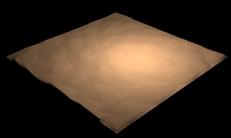
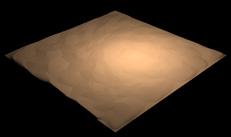


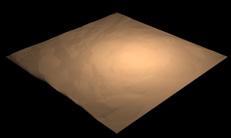
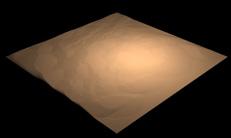

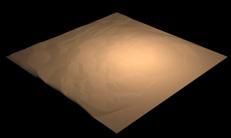
AEOLIAN | MATERIAL SYSTEM | 61 | 0 Seconds Elapsed 6 Seconds Elapsed 12 Seconds Elapsed 2 Seconds Elapsed 8 Seconds Elapsed 14 Seconds Elapsed 4 Seconds Elapsed 10 Seconds Elapsed 16 Seconds Elapsed Dune Frequency Surface Amplitude Ripple Amplitude Iteration 004 - Dune Formation 1.2mm 1.2mm 0.003mm
DUNE BEHAVIOUR
The result of the simulation was fabricated with the CNC to physically examine the scale and different typologies dunes.
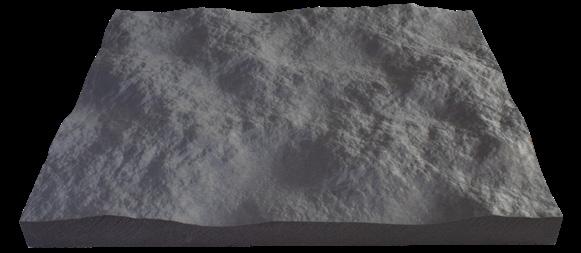
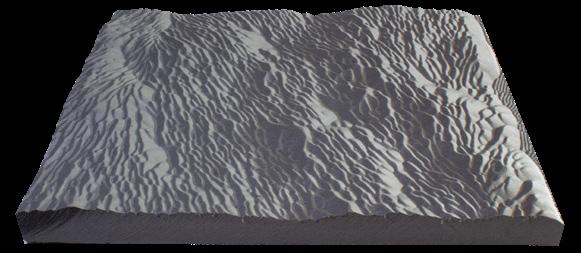
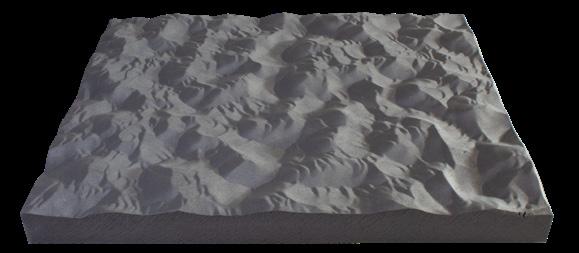
AEOLIAN | MATERIAL SYSTEM | 62 |



AEOLIAN | MATERIAL SYSTEM | 63 |
WIND & EROSIVE FORCES
USING THE WIND TO CREATE A RESPONSIVE ARCHITECTURE
Wind is the most influential factor in shaping the desert through a process known as aeolian. What is interesting is how the traces of these geological formations can be traced in their textures. Vector fields are visible in their surfaces, creating a visual graphic of the geometric formology sculpting the rock over time. To generate an understanding of how different objects react to the flow of wind and how sand particles would react in colliding with them. We attempt to achieve this level of analysis through the following simulations/experiments:
Vector Field


The aim of next experiment is to analyse the effect of vector fields with different geometric objects acting as colliders. These tests were conducted by creating formations composed in four basic shapes suitable for the task at hand, such as: linear formations, concave formations, convex formations, and wave formations (combining both concave and convex).
Particle Simulations
The aim of the experiment is to analyse the effect of sand particles colliding with formations composed of four three-dimensional shapes at different levels of inclination to generate an understanding of how the change in these parameters affects the macrobehavior of a desert.
AEOLIAN | MATERIAL SYSTEM | 64 |

LINEAR FORMATIONS
Vector Field Analysis
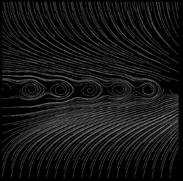


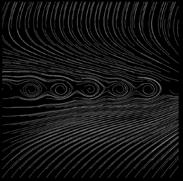
Linear collisions illustrates a vector field behaviour where the vectors motion forward is halted and shifted to a side. This collision strategy fails to consider the vector direction post-collision.
Particle Simulations Analysis


With a gradual inclination and declined obstacle, the particles are capable of compiling and rolling upwards, allowing an accumilation of particles that may climb up the obstacle. The more declined the surface the faster the particles accumulate and climb it. With an inclined obstacle at an acute angle, the particles are unable to climb the obstacle due to the surface leaning against the particle flow. However, neither strategy considers particle flow post collision, making all strategies at risk of particle accumulation over time.
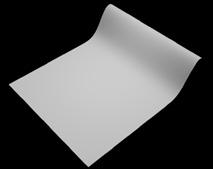
Particle Simulations:
I) Gradually Inclined Barrier
AEOLIAN | MATERIAL SYSTEM | 66 |
0 Seconds Elapsed 8 Seconds Elapsed 16 Seconds Elapsed Angle - 30 ° Angle - 60 ° Angle - 90 ° Angle - 120 °
Declined Barrier
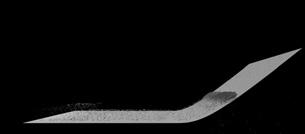
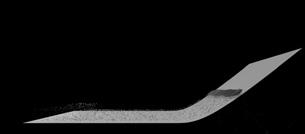

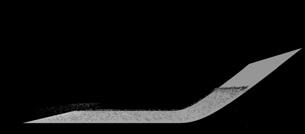

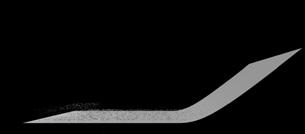
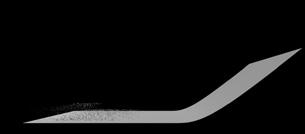
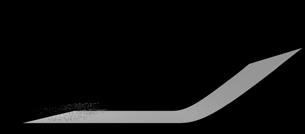
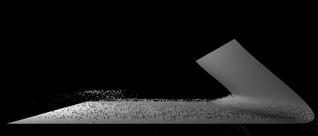
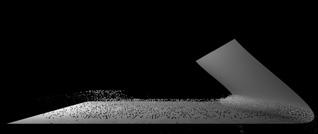
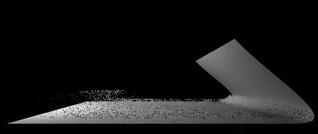


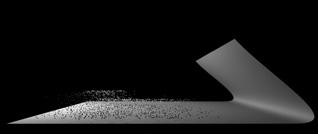

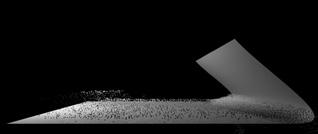
AEOLIAN | MATERIAL SYSTEM | 67 |
04
06
08
10
III)
II) Inclined Barrier 02 Seconds Elapsed
Seconds Elapsed
Seconds Elapsed
Seconds Elapsed
Seconds Elapsed 12 Seconds Elapsed 14 Seconds Elapsed 16 Seconds Elapsed
CONCAVE FORMATIONS
Vector Field Analysis



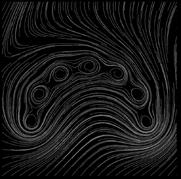
Concave collisions illustrates a vector field behaviour where the vectors motion forward accumulates inward. This collision strategy is capable of shifting the field outwards post collision.
Particle Simulations Analysis
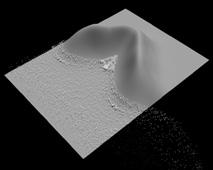

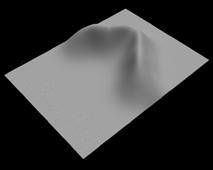
Concave formations are able to accumulate particles towards the centre and gradually shifting their direction out of the concave shape. A declined strategy is inefficient as particles easily move upwards due to its curvature in the middle. With an inclined obstacle at an acute angle, the particles are unable to climb the obstacle and are instead, shifted to the side. A declined formation could be used for strategies for harvesting particles, while the inclined formation shows a potential strategy for compiling and shifting particle flow.
Particle Simulations:
I) Gradually Inclined Barrier
AEOLIAN | MATERIAL SYSTEM | 68 |
Angle - 30 ° Angle - 60 ° Angle - 90 ° Angle - 120 ° 16 Seconds Elapsed
0 Seconds Elapsed 8 Seconds Elapsed
III) Declined Barrier II) Inclined Barrier
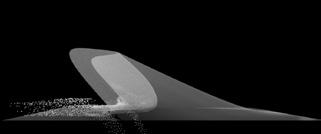
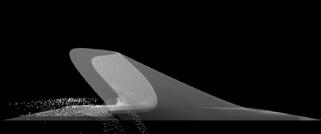
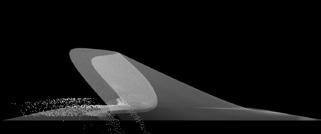
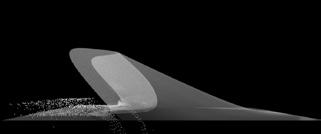
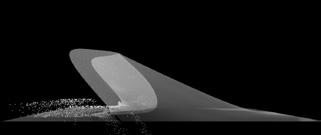


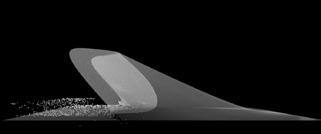

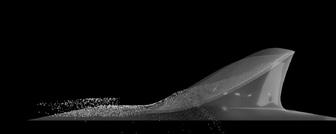

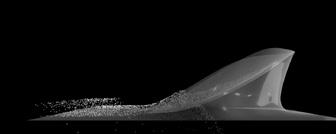
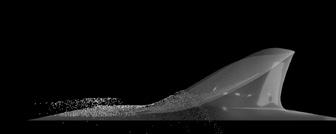
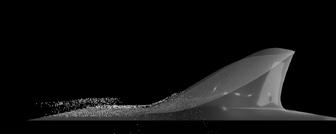
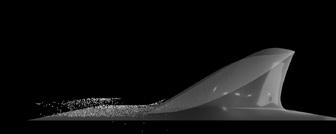
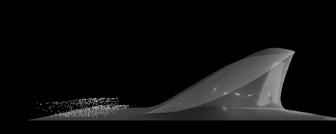
AEOLIAN | MATERIAL SYSTEM | 69 |
02 Seconds Elapsed 04 Seconds Elapsed 06 Seconds Elapsed 08 Seconds Elapsed 10 Seconds Elapsed 12 Seconds Elapsed 14 Seconds Elapsed 16 Seconds Elapsed
CONCAVE FORMATIONS
Vector Field Analysis
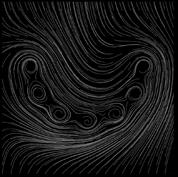

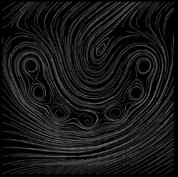
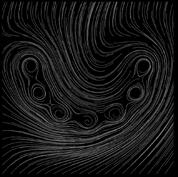
Linear collisions illustrates a vector field behaviour where the vectors motion forward is halted and shifted to a side. This collision strategy fails to consider the vector direction post-collision.
Particle Simulations Analysis
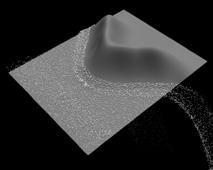
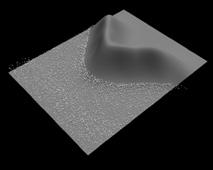

Convex Formations are able to split particles and divert them. A declined strategy carries particles upwards before splitting them whilst an inclined strategy maintains particles at the surface while splitting them and diverting them to the side. A declined formation could be used for strategies for lifting and spliting particles for transportation purposes, while an inclined formation could be used for purely splitting particles from a low elevation.
Particle Simulations:
I) Gradually Inclined Barrier
AEOLIAN | MATERIAL SYSTEM | 70 |
Angle - 30 ° Angle - 60 ° Angle - 90 ° Angle - 120 ° 16 Seconds Elapsed
0 Seconds Elapsed 8 Seconds Elapsed
III)
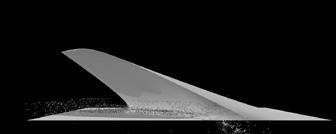

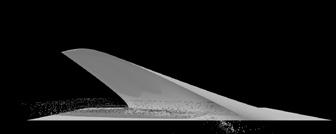
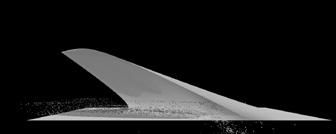

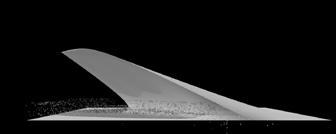
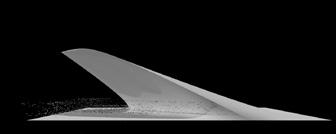

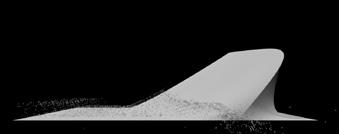
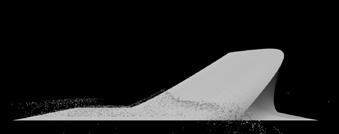





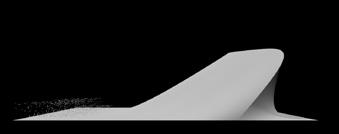
AEOLIAN | MATERIAL SYSTEM | 71 | 02 Seconds Elapsed 04 Seconds Elapsed 06 Seconds Elapsed 08 Seconds Elapsed 10 Seconds Elapsed 12 Seconds Elapsed 14 Seconds Elapsed 16 Seconds Elapsed
Declined Barrier II) Inclined Barrier
WAVE FORMATIONS
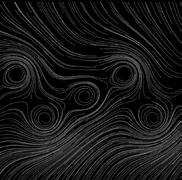
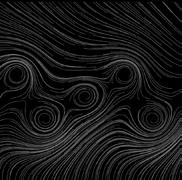


Vector Field Analysis
Linear collisions illustrates a vector field behaviour where the vectors motion forward is halted and shifted to a side. This collision strategy fails to consider the vector direction post-collision.
Particle Simulations Analysis
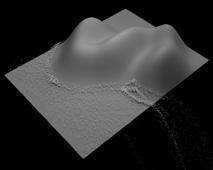

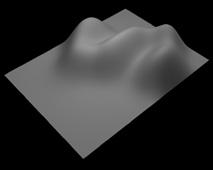
Wave Formations combine both aspects of concaved and convexed formations utilizing properties for accumulations and splitting. A declined strategy carries and splits particles as it is convexed, and accumulates and redirects particles as it is concaved. Whilst inclined, the particles create a smooth transition from splitting whilst it is convexed and accumulates shortly without lifting particles upwards before redirecting as it is concaved.
Particle Simulations:
I) Gradually Inclined Barrier
AEOLIAN | MATERIAL SYSTEM | 72 |
16 Seconds Elapsed
0 Seconds Elapsed 8 Seconds Elapsed Angle - 30 ° Angle - 60 ° Angle - 90 ° Angle - 120 °
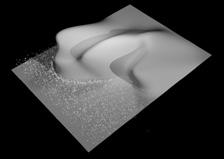


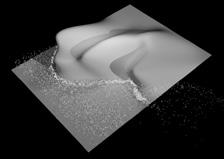
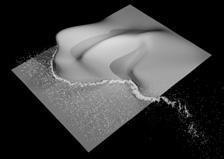
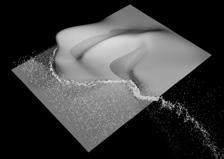
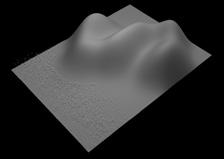
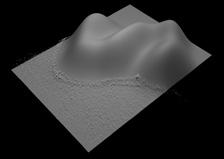
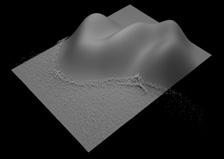
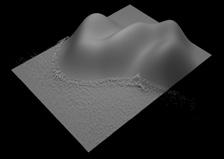


AEOLIAN | MATERIAL SYSTEM | 73 | 04 Seconds Elapsed 06 Seconds Elapsed 08 Seconds Elapsed 10 Seconds Elapsed 12 Seconds Elapsed 14 Seconds Elapsed
Declined Barrier II) Inclined Barrier Iteration 1
III)
PANEL EXPERIMENTS
To investigate desert as a particle system we conducted various experiments with sand and obstacles. In the experiment, the use of slabs caused different accumulations of sand particles, and the hole properties of the panel controlled the range of sand particles being accumulated.

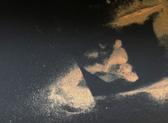
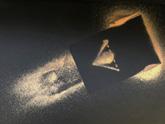



Iteration 1
Area 12cm2 Holes 0
Force. Direction East Panel 15x10cm
Perspective | Top Accumulation
Iteration 2
Area 12cm2 Holes 1
Force. Direction East Panel 15x10cm
Iteration 3
Area 12cm2


Holes 2
Force. Direction East Panel 15x10cm
Iteration 4

Area 6cm2 Holes 0


Force. Direction East Panel 15x10cm

AEOLIAN | MATERIAL SYSTEM | 74 |
Iteration 5
Area 9cm2 Holes 1 Force. Direction East Panel 15x10cm




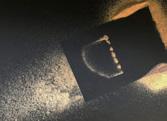


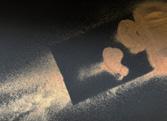
Iteration 6
Area 15cm2 Holes 2 Force. Direction East Panel 15x10cm
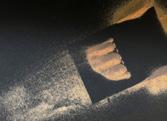
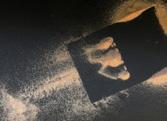

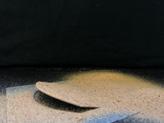


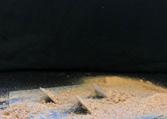
Iteration 7
Area 24cm2 Holes 0 Force. Direction East Panel 15x10cm
Iteration 8
Area 20cm2 Holes 2 Force. Direction East Panel 15x10cm
Iteration 9
Area 23cm2 Holes 8 Force. Direction East Panel 15x10cm
AEOLIAN | MATERIAL SYSTEM | 75 |
Iteration 1
SAND-WIND EXPERIMENTS
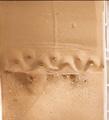

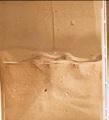
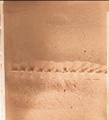
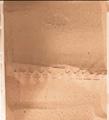

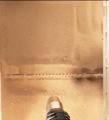
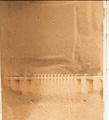
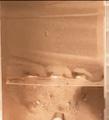
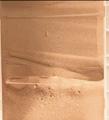
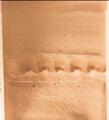
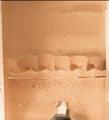
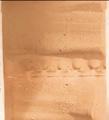
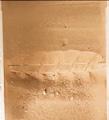

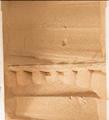
Iteration 1
Hole.Distance 2cm
Hole.Diameter 4cm
Force.Direction South
Panel 23.5x6cm
Iteration 2
Hole.Distance 2cm


Hole.Diameter 2cm
Force.Direction South
Panel 23.5x6cm
Iteration 3
Hole.Distance 4cm
Hole.Diameter 1.5cm
Force.Diameter South





Panel 23.5x6cm
Iteration 4




Hole.Distance 1cm

Hole.Diameter 1.5cm
Force.Direction South
Panel 23.5x6cm
Iteration 5
Hole.Distance 6-0.5cm
Hole.Diameter 0.5cm
Force.Direction South
Panel 23.5x6cm
Iteration 6
Hole.Distance 4cm
Hole.Diameter 1.5-0.5cm
Force.Direction South
Panel 23.5x6cm


AEOLIAN | MATERIAL SYSTEM | 76 |
Initial 0:00 | Processing 1:30 | Static 3:00 Shifting
OBSTACLE EXPERIMENTS
The required conditions for dunes are sand sediment, intense wind energy to transport sand particles, and the location for accumulation. Obstacles areas such as dunes or rocks (onsite geographical feature) serve as a accumulation spots where sand particles are stoped and accumulated.

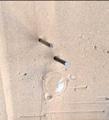

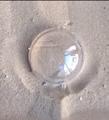
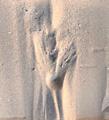
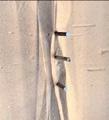
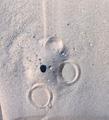


2:00
Iteration 3
Obstacle.Scale D=2-3cm Obstacle.Number 3
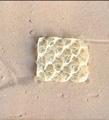
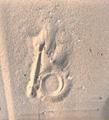
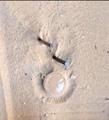
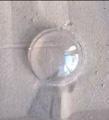

Force.Direction Top Iteration 5
Obstacle.Scale 7-10cm Obstacle.Number 3
Force.Direction South
Iteration 7
Obstacle.Scale 15cm2 Obstacle.Number 1
Force.Direction South
Iteration 8
Obstacle.Scale 3-7cm Obstacle.Number 3
Force.Direction South Iteration 9
Obstacle.Scale 15cm Obstacle.Number 1
Force.Direction South

AEOLIAN | MATERIAL SYSTEM | 77 |
Initial 0:00 | Processing 1:00 | Static
MOVING OBJECT EXPERIMENTS
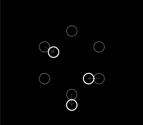
Ability of wind to move objects on sand was tested. Surprisingly the rocks in the experiment were moving not along the wind but against the wind as particles below the objects were blown away forcing the rocks to roll backwards because of the gravity force.
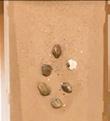
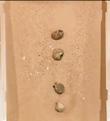
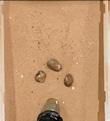

Iteration 1
Obstacle.Scale D=3cm
Force.Direction South
Movnig.Distance 6.5cm
Iteration 2
Obstacle.Scale D=5.5cm
Force.Direction South
Movnig.Distance 4cm
Iteration 3
Obstacle.Scale D=3-5.5cm
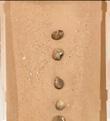
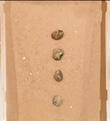

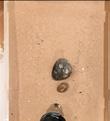

Force.Direction South
Movnig.Distance 1-2.5cm
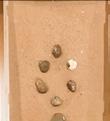
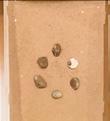
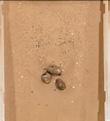
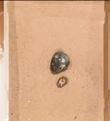
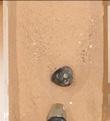
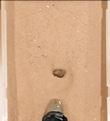

Iteration 4
Obstacle.Scale D=3cm
Force.Direction South
Movnig.Distance 3-4cm
Iteration 5
Obstacle.Scale D=3cm
Force.Direction South
Movnig.Distance 1cm
Iteration 6
Obstacle.Scale D=3cm
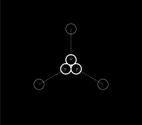


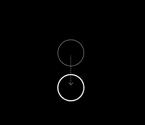
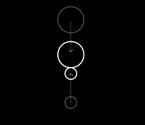
Force.Direction South
Movnig.Distance 1.5cm
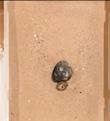
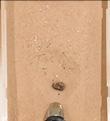
AEOLIAN | MATERIAL SYSTEM | 78 |
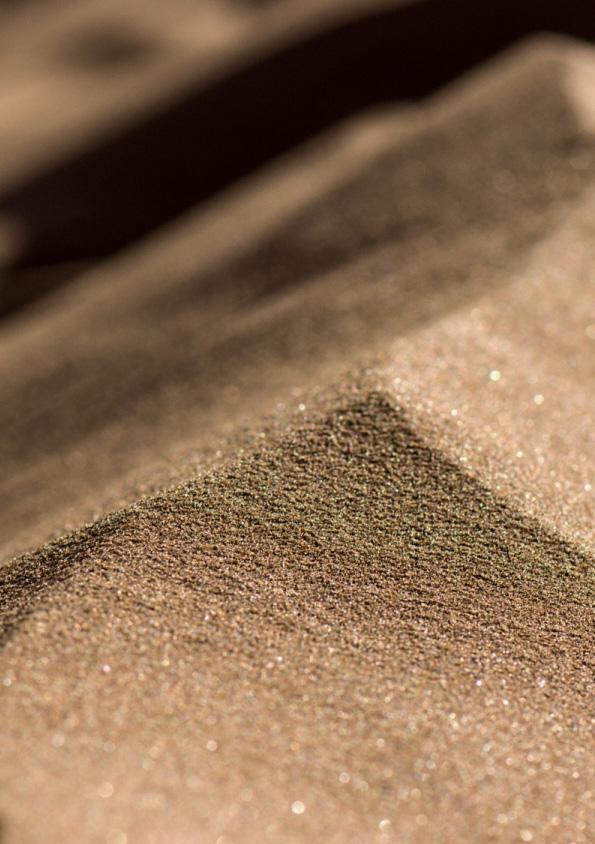
CONNECTION
BUILDING A LARGER NETWORK
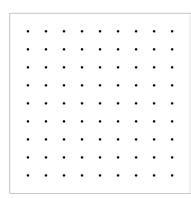
To further understand how sand particles aggregate, a small experiment was constructed inspired by Frei Otto’s granular aggregation experiment. This research examined the formulative behaviour of sand grains, how they aggregate, and what parameters affect the generate topology. The results in the catalogue below illustrates that no matter how many voids are placed or how thick each of these voids are, sand grains will retain
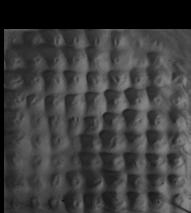
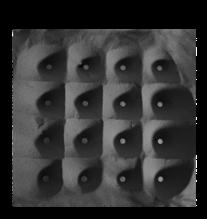
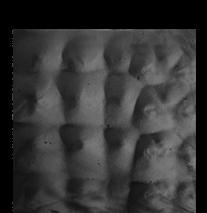

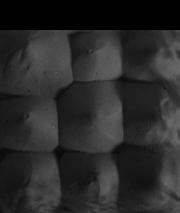
SUBTRACTIVE CONTAINER
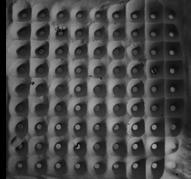
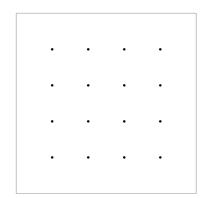
ADDITIVE CONTAINER

AEOLIAN | MATERIAL SYSTEM | 80 |
GRID SIZE VOID DIAMETER PANEL
3 x 3 2.5mm 4 x 4 2.5mm 9 x 9 2.5mm
an angle of inclination of 30-35 degrees. However, an influential change was how the number of voids affected the field topology. In specific, the more the voids, the more hill-like aggregations on an additive container , and more downward slopes on the subtractive container.
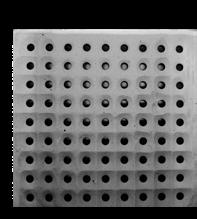
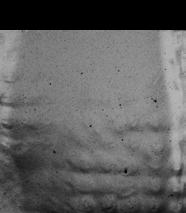
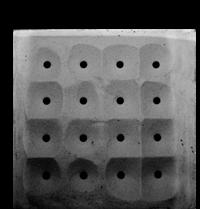

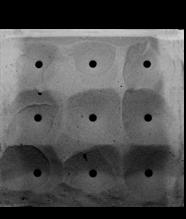
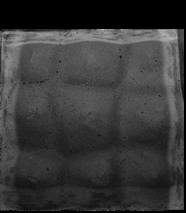

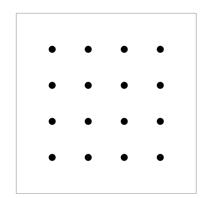

AEOLIAN | MATERIAL SYSTEM | 81 | 3
7.5mm 4
4 7.5mm 9
7.5mm
x 3
x
x 9
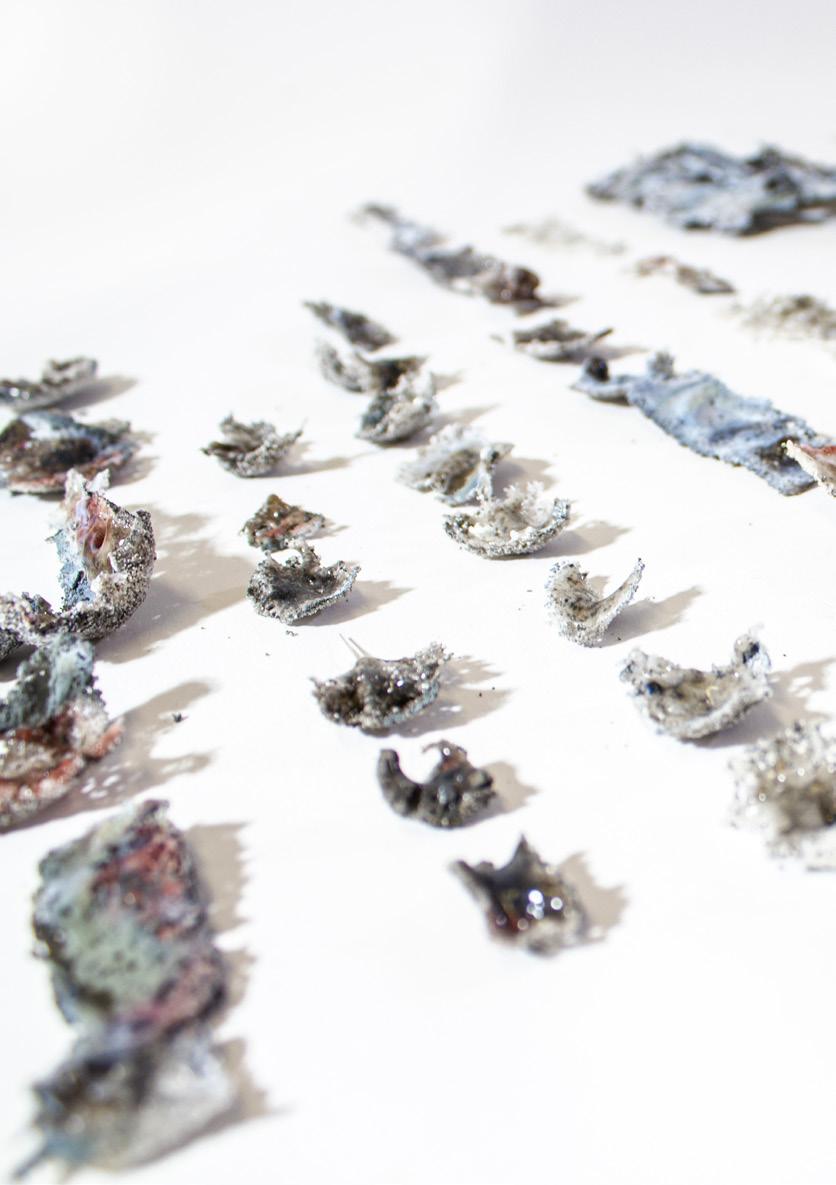
GLASS
The research addresses the process of desertification by utilising the desert’s onsite materiality and investigating its material contingency. The elemental aspect of sand is explored as form of technology, whereas the research is looking into the possibilities of material transformation of sand into glass under high temperature.

SAND WELDING 1.0
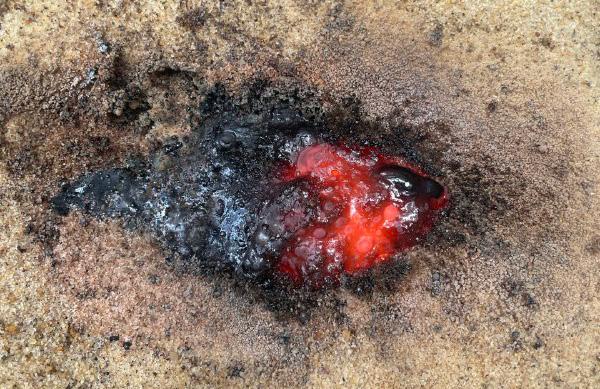
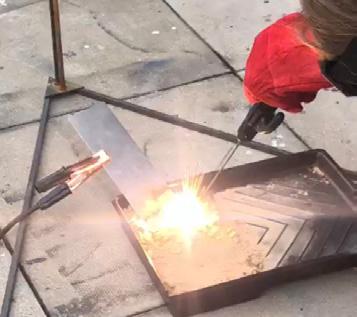
The welder with a maximum of 120 Ampere was used for the experiments with sand welding. The initial idea was to raise a glass structure on top of a piece of steel plate. For the welding process, there is a need for the skills of such craftsmanship, therefore some training process was necessary for the execution of the experiment. The first iteration was to touch the metal plate with the electrode under the surface of the sand to have a bigger surface area of glass, however, the welding under the sand was very hard to execute and worked without continuous welding. Therefore the welding process was done on top of the surface.
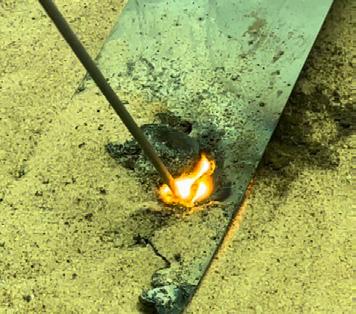
AEOLIAN | GLASS | 84 |
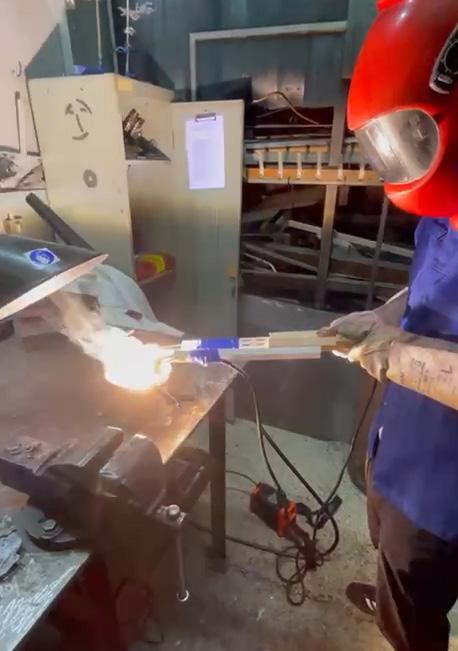
SAND WELDING 1.0
The experiment shows that the sand was indeed melting, however, it was mixing together with metal and is not clear. The glazing might be seen as a shiny cover on top of the metal. The sand which has not melted but was close to high temperatures changed its colour from warm terracotta to white.

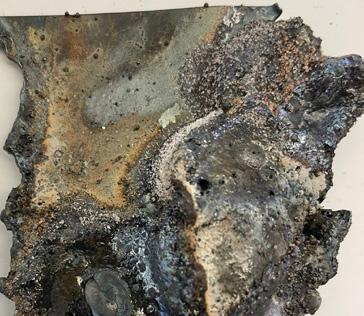
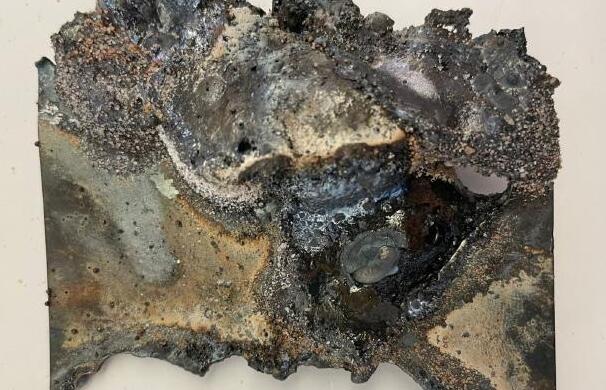
AEOLIAN | GLASS | 86 |
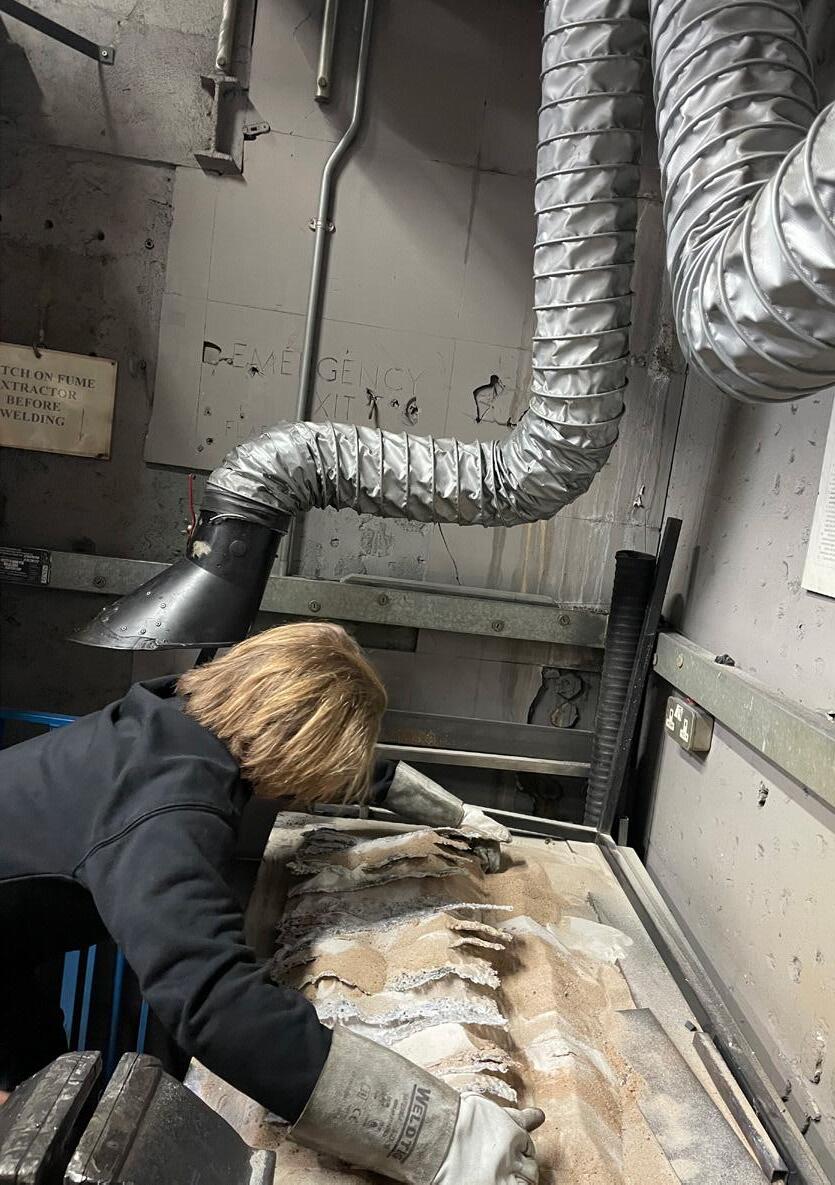
SAND FUSION. WELDING 2.0
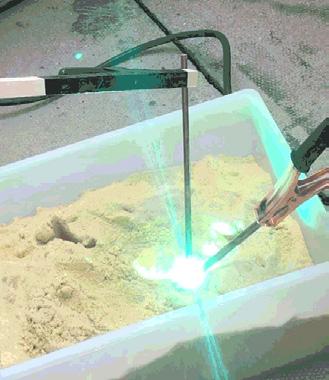
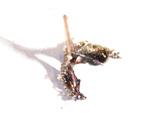
The next experiment was executed without an electrode but with a copper rod 8mm in diameter soldering to another copper rod in the sand. The resulting pieces are almost pure glass with a little content of copper, which is the reason for the colour. Sand under high temperature begins to conduct electricity and therefore there is a feasibility to produce pure glass pieces. Glass was formed in bubbles, hollow inside. The maximum length achieve is no more than 2 cm, because of the lack of voltage of the tool.
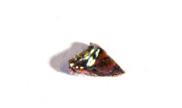

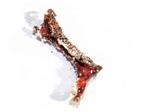
AEOLIAN | GLASS | 88 |
The next attempt with welding was executed with the use of carbon electrodes. Two carbon electrodes touching each other create the electrical arch which reaches necessary temperatures. Electrodes are not melting so fast as regular ones and therefore not mixing with the fused glass. Moreover, the welding happened in a much smooth controlled way. Eventually the fusion might continue without breaks. The first examples are small, approximately 2-3cm in length pure glass pieces.
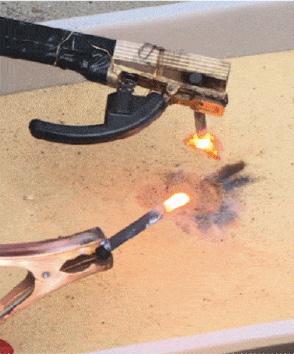

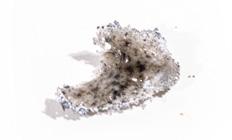
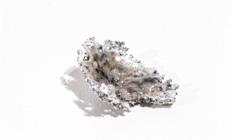
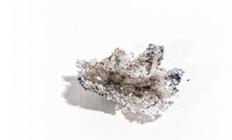
AEOLIAN | GLASS | 89 | WELDING 3.0
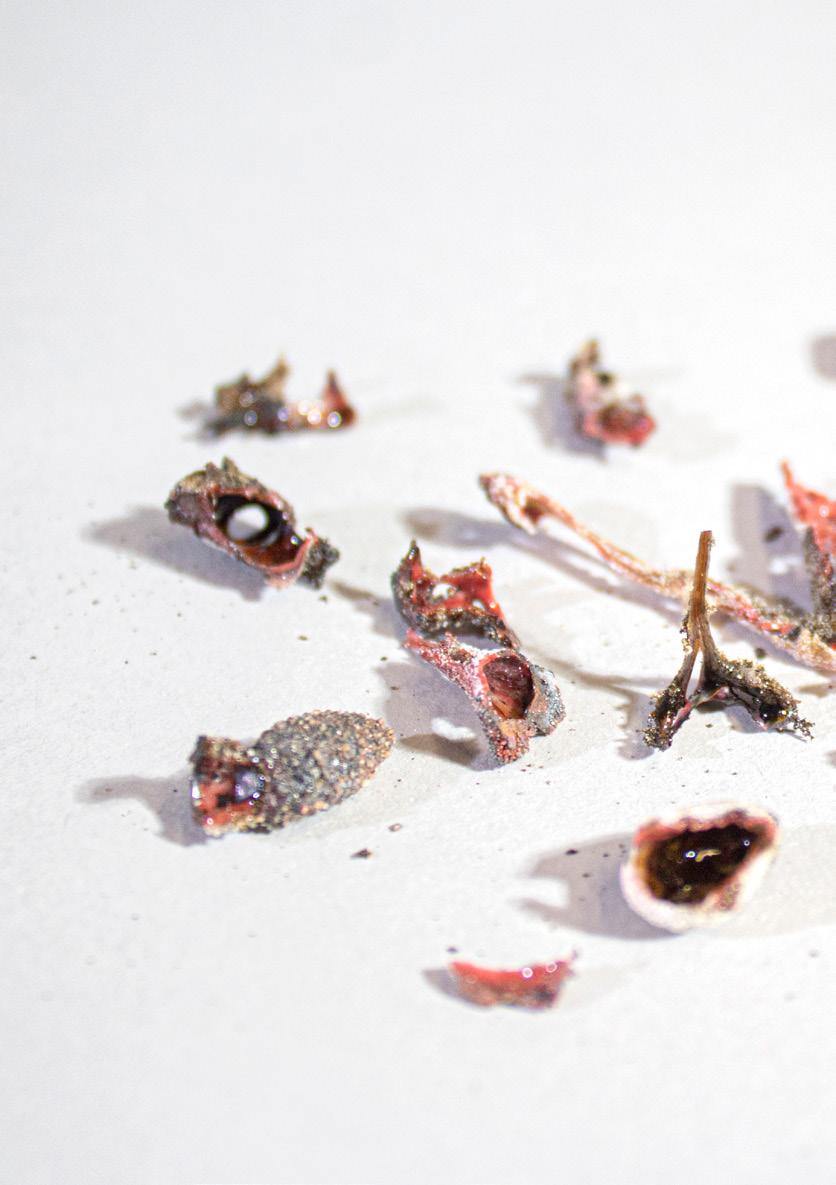
AEOLIAN | GLASS | 90 |

AEOLIAN | GLASS | 91 |
WELDING A WELDER TO FUSE SAND INTO GLASS
The welding process reaches necessary temperatures of 1800 degrees of Celsius to melt the sand. And therefore the range of experiments was executed with carbon electrodes further.

AEOLIAN | GLASS | 92 |
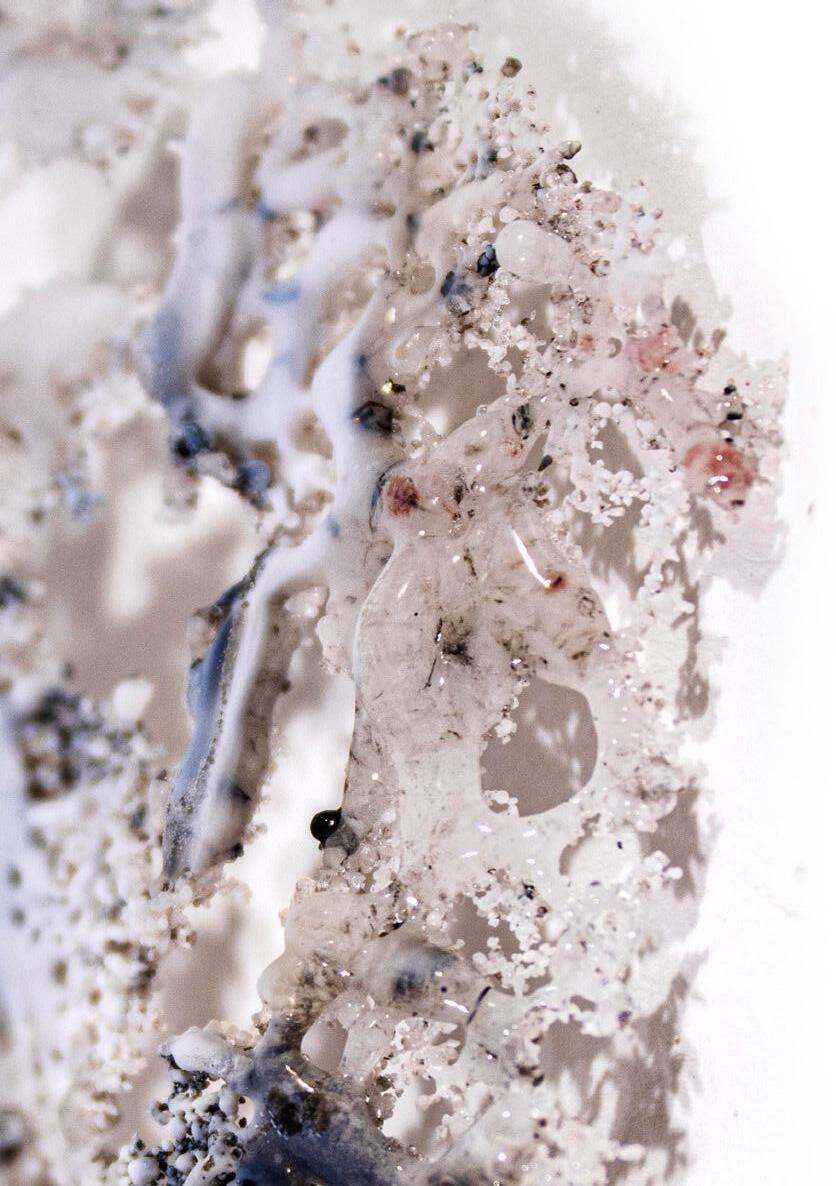
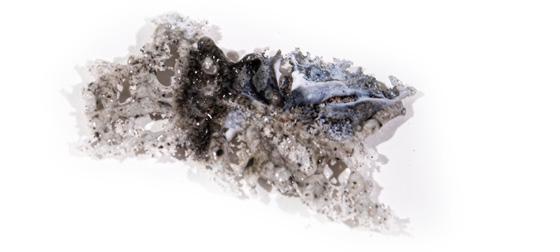
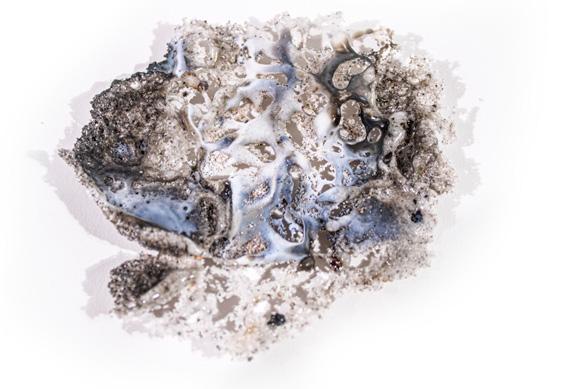

AEOLIAN | GLASS | 94 |
The fusion unfolds in uncontrolled patterns where particles from the outside of the electrode position are rolling towards the center, where the most high temperature is located. Pieces are frozen top layers of sand particles and therefore are flat in shape. For the time of the experiment the size of glass is limited by the size of the bounding box holding the sand.
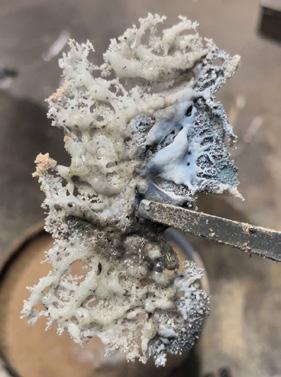
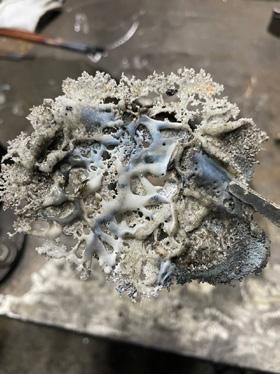


AEOLIAN | GLASS | 95 |
To optimise the process, the tool to hold both electrodes together was developed. It lets to keep it in one hand, which makes the welding process be more precise and controllable.
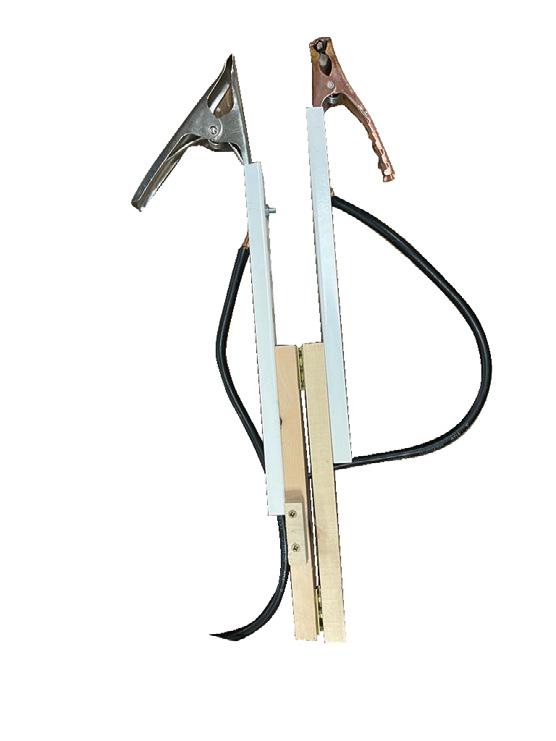
EXTENDER
WOODEN BRACKET SUPPORT
WIRE CONNECTION TO ELECTRICITY
WELDING
4.0
CROCODILE CLIPS
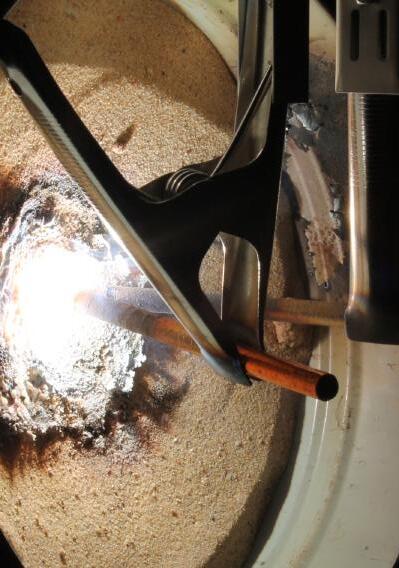

AEOLIAN | FABRICATION
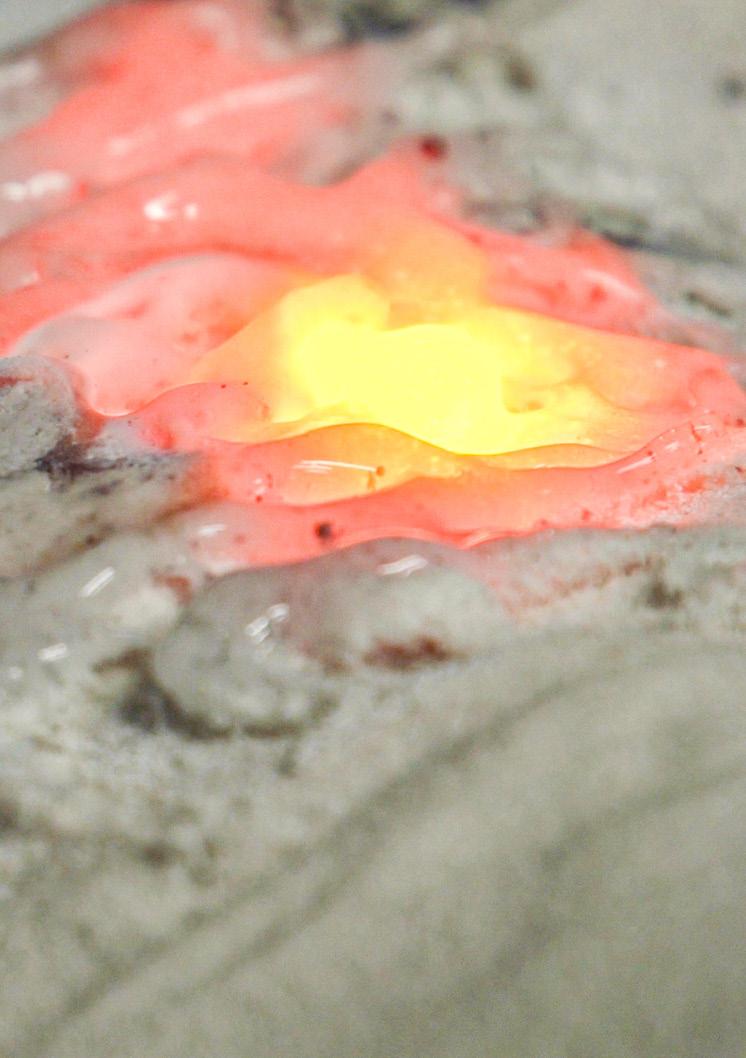
AEOLIAN | FABRICATION
After the development of the tool, the scale of the glass pieces increased. The tool might be used without any bounding box and therefore the fusing glass is not limited in size by the fabrication technique.
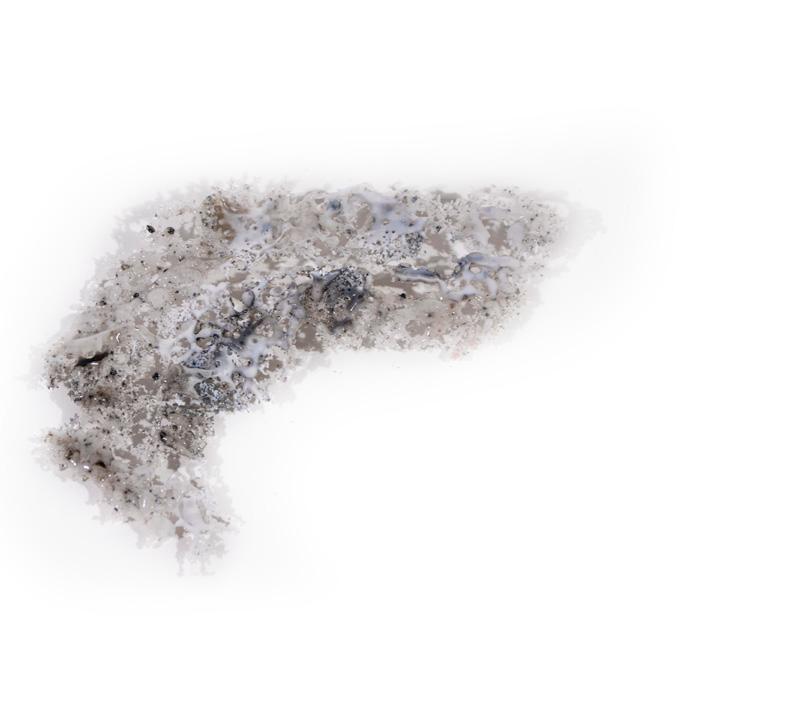
AEOLIAN | GLASS | 100 | WELDING 5.0

The experiment represents the ability of the approach to produce 3 dimensional objects. In this case it is displayed by layering. After finishing the layer of glass, the layer of sand was pured on top of it and then fused. Repeated several times with different thickness of the sand layer the process revealed the spacious glass object with porous of different size.



AEOLIAN | GLASS | 102 | WELDING 6.0
The experiment was focused on fabrication more geometrical variation, the straight line in this case. It was produced fusing 5 layers of sand together one by one. The piece with thin layers of sand is solid and is stronger than one with thick layers of sand, what made it to be porous and fragile.
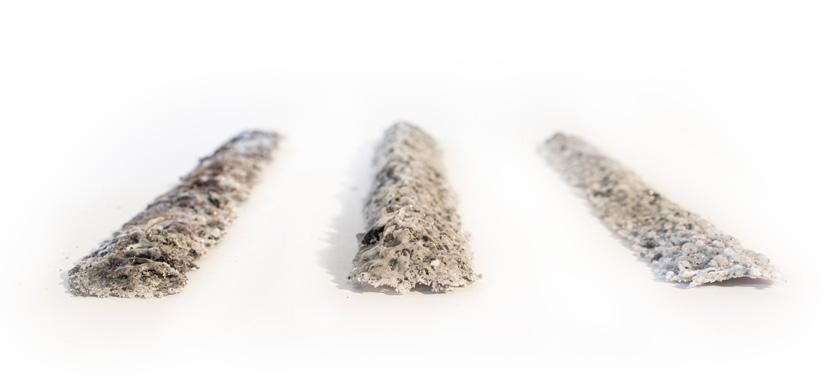
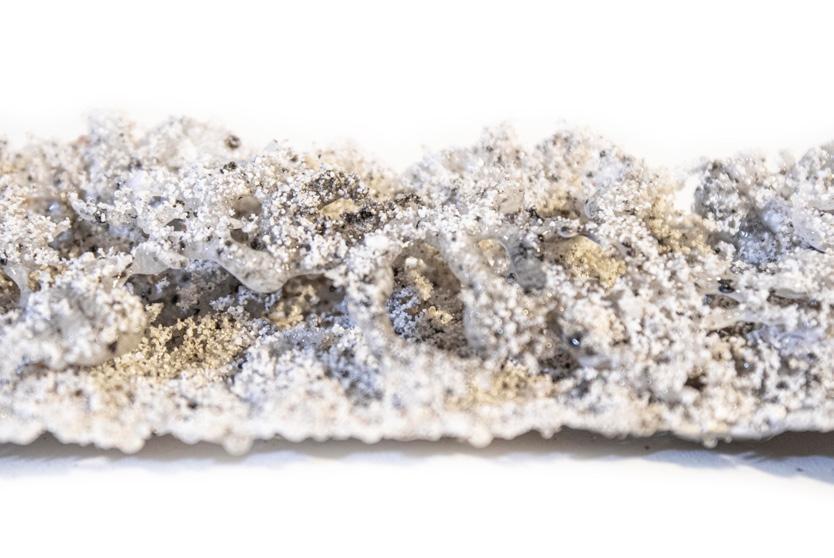
AEOLIAN | GLASS WELDING
7.0
5 THIN LAYERS CARBON
5 THICK LAYERS CARBON WELDING 5 THIN LAYERS
CARBON-COOPER
WELDING
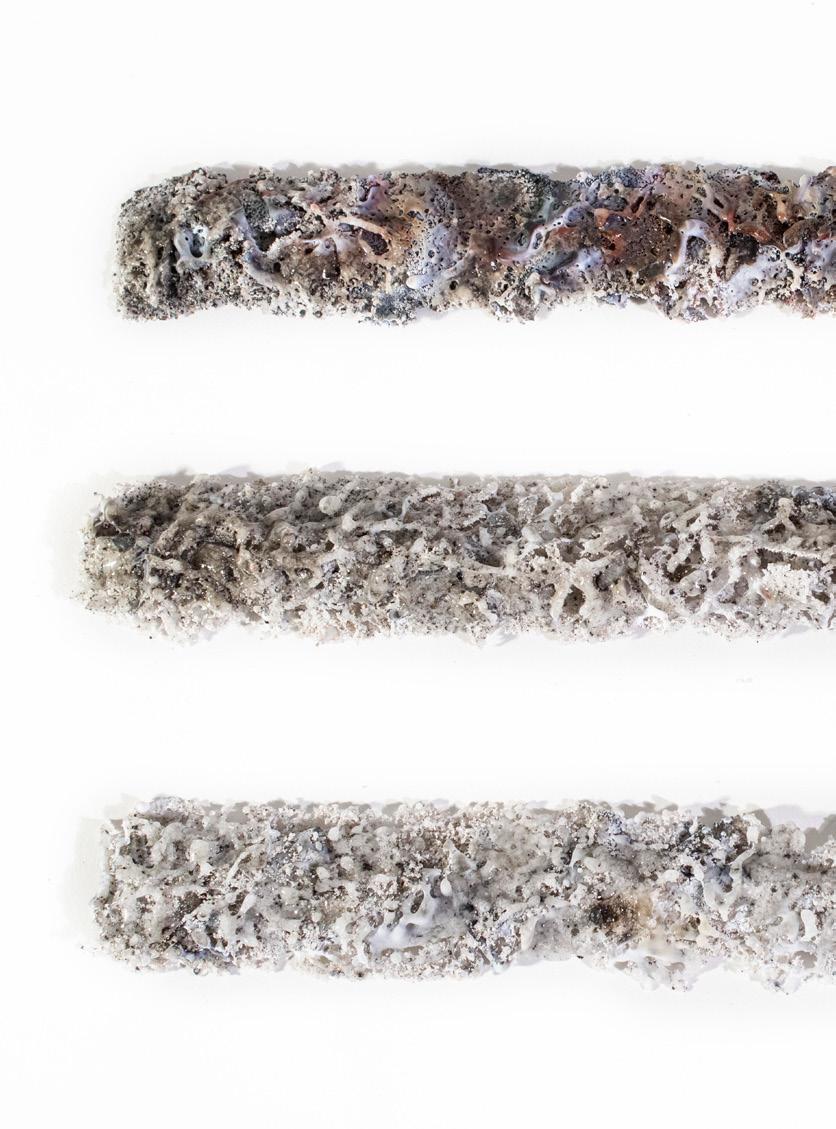
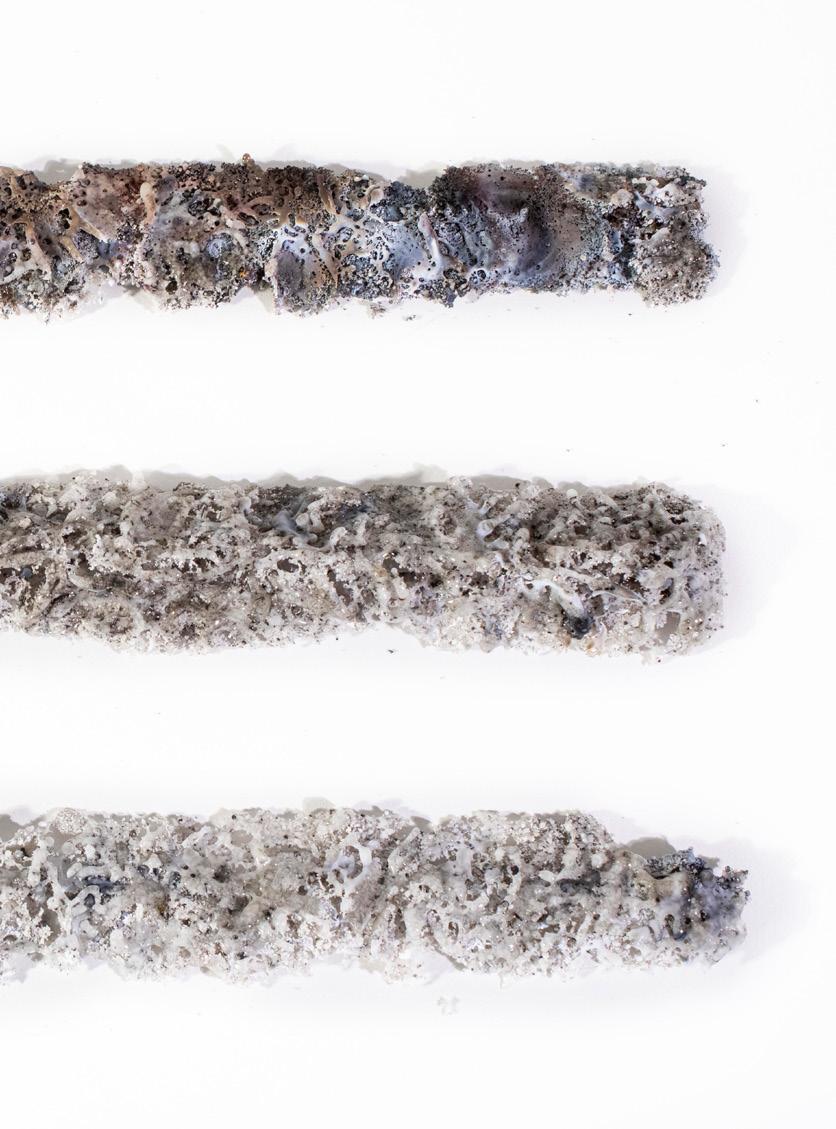
WELDING 8.0
Soda or sodium bicarbonate is used in glass manufacture to reduce the melting point of sand. In the experiment, the soda was added to the mix of sand with a ratio of 30%. As a result, glass pieces are more glass-looking, the sand melts faster and the glass layer is thicker. The model is partially transparent.
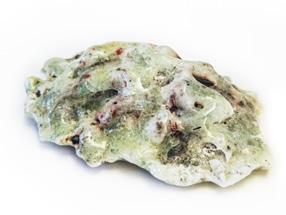
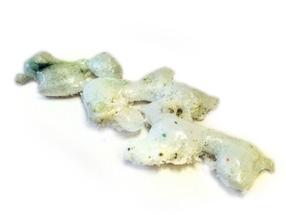
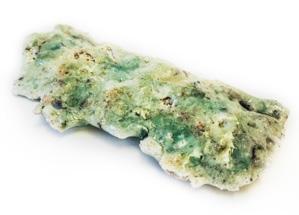

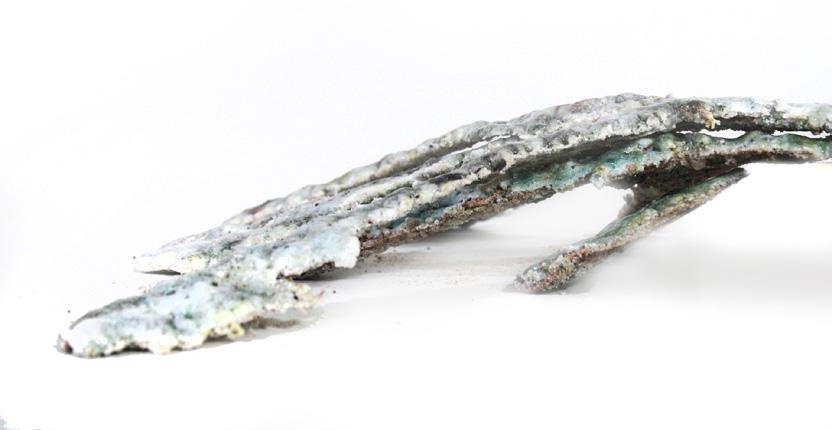
However with this technique the glass experiences more radical temperature differences. During the cooling time, the model is covered by lots of inner cracks, which directly influences its structural property.
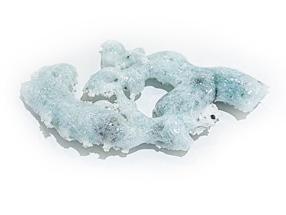


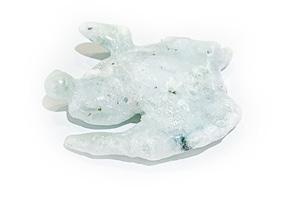
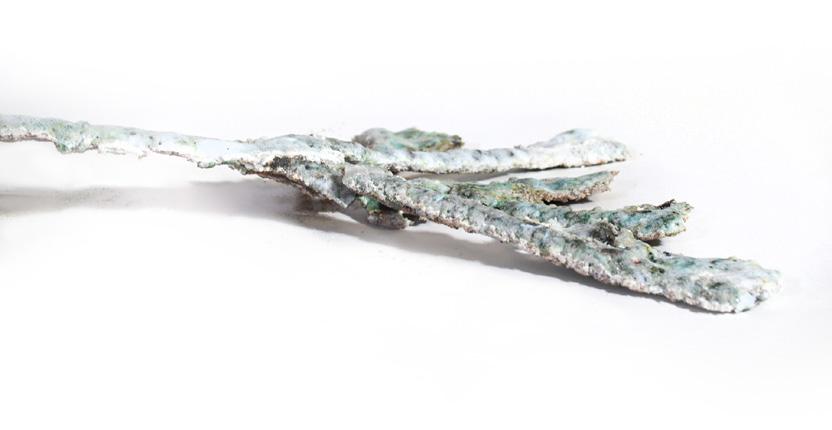
AEOLIAN | GLASS
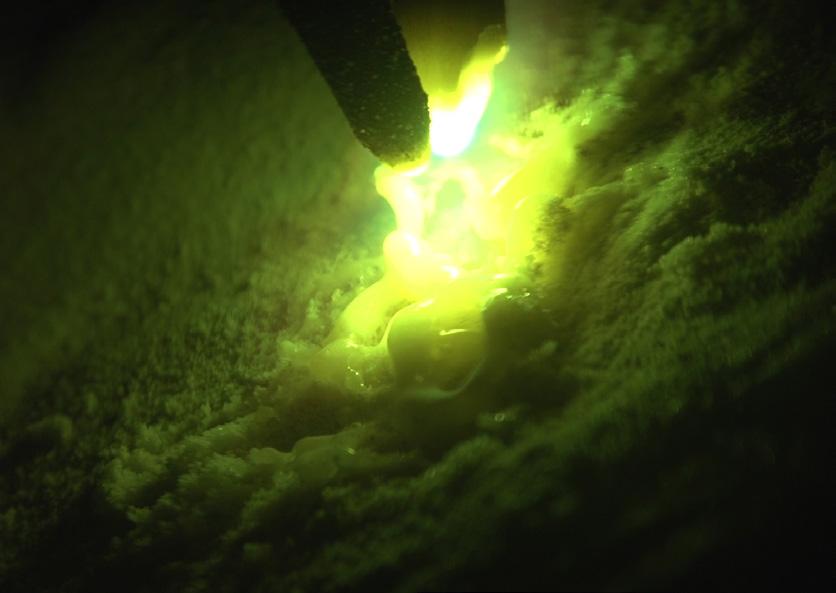

AEOLIAN | FABRICATION
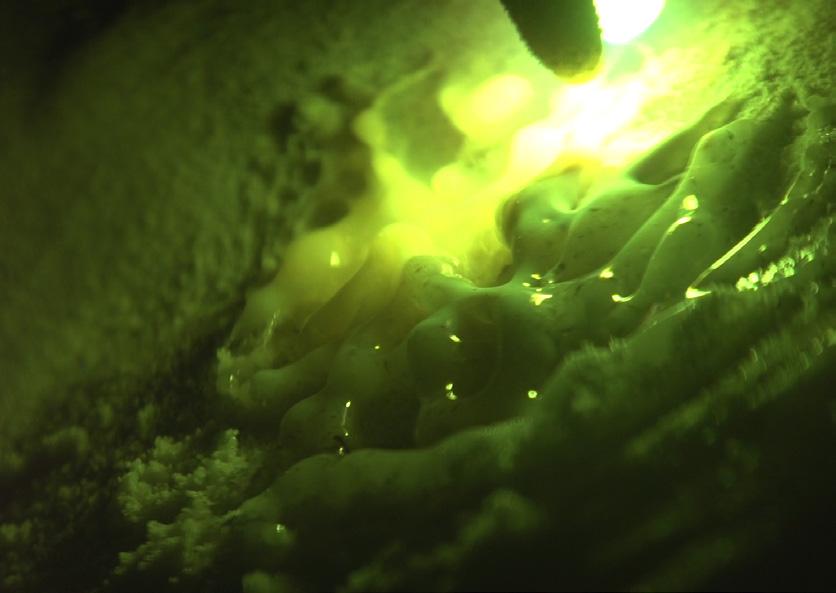
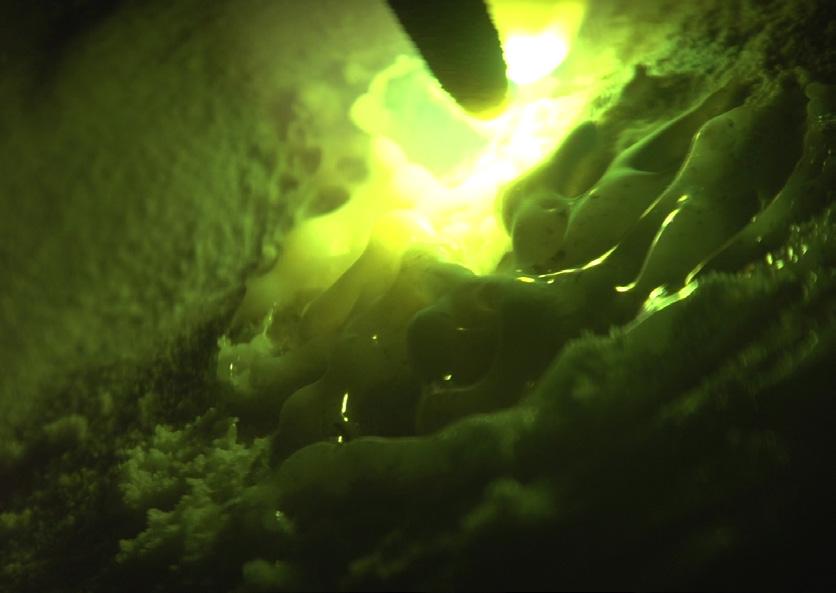
AEOLIAN | FABRICATION

AEOLIAN | GLASS | 110 | 1.0 METAL WELDING 2.0 COOPER WELDING 3.0 CARBON + COOPER 3.1 CARBON + COOPER 4.0 CARBON + COOPER 5.0 CARBON + COOPER 3.2 CARBON WELDING 4.1 CARBON WELDING 3.3 CARBON WELDING
CATALOGUE
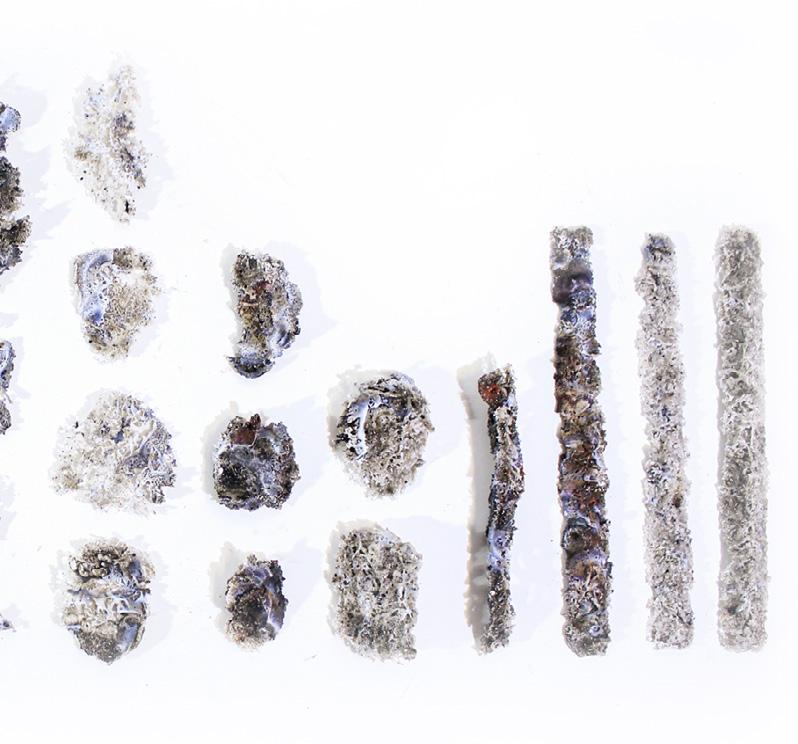
AEOLIAN | GLASS | 111 |
6.0 CARBON + COOPER LAYERED
6.2
CARBON + COOPER LAYERED 7.0 CARBON + COOPER LAYERED 6.1 CARBON WELDING LAYERED 7.1 CARBON WELDING THIN LAYERS
7.2
CARBON WELDING THICK LAYERS 5.1 CARBON WELDING
The next step was to enlarge the resulting objects and check the ability to produce surfaces. Two square panels of 40cm side were produced, one flat and another in an anticlastic shape. The continuous pattern made by fusion made it to be solid. The glass panel has characteristics of regular glass, it is semi translucent and glossy. It required around 6 hours to produce one panel.
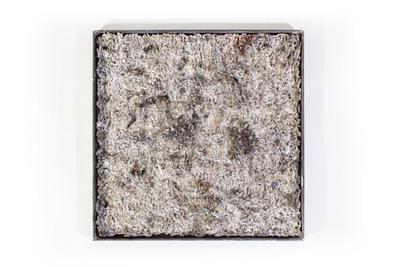
AEOLIAN | GLASS | 112 | WELDING 8.0
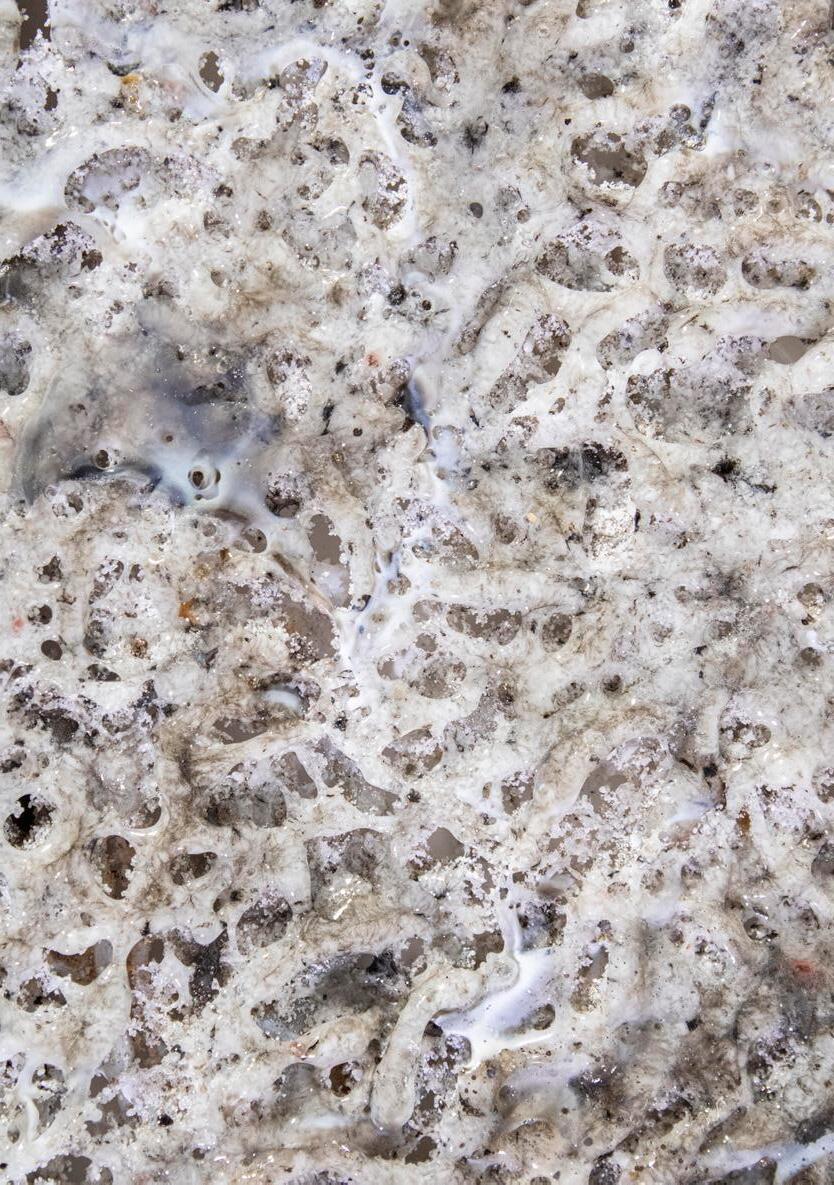
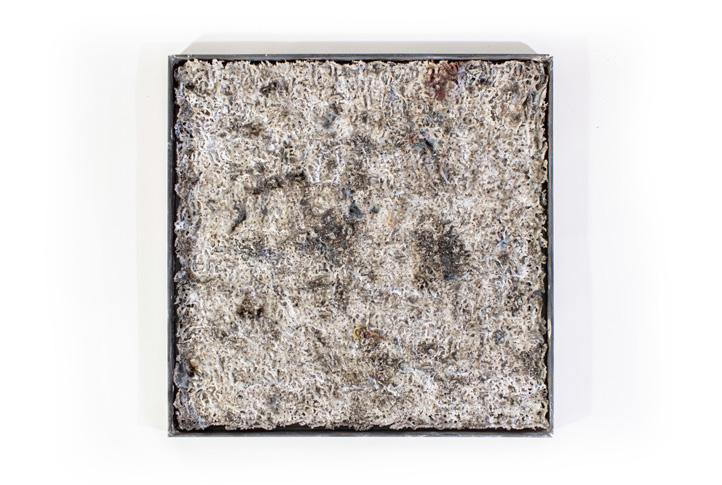
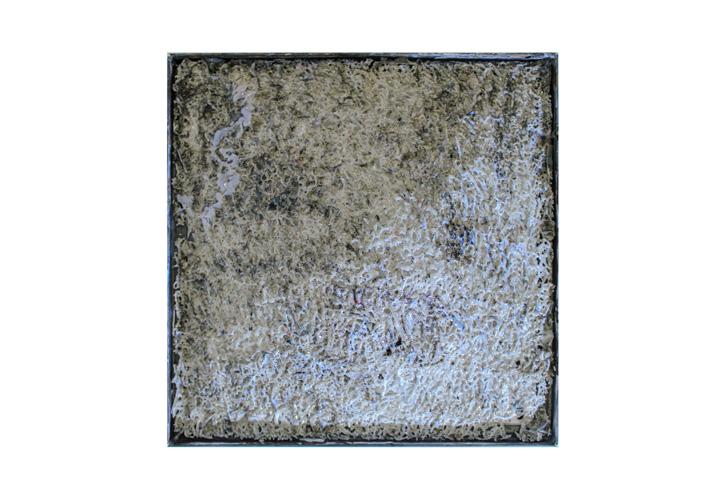
AEOLIAN | GLASS | 114 |
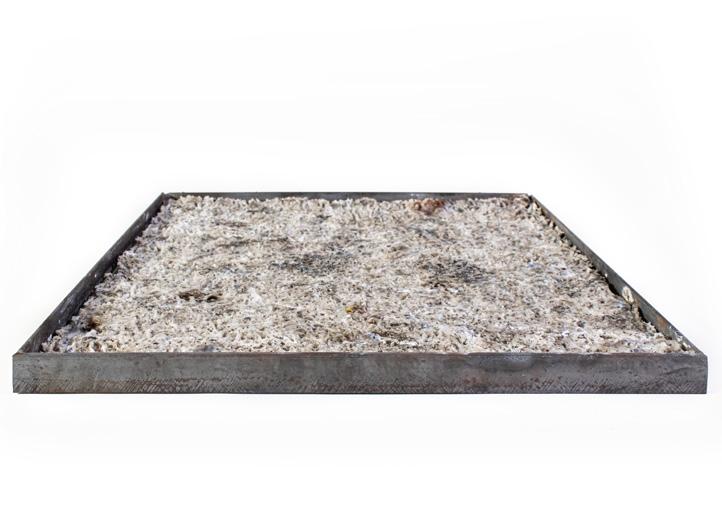
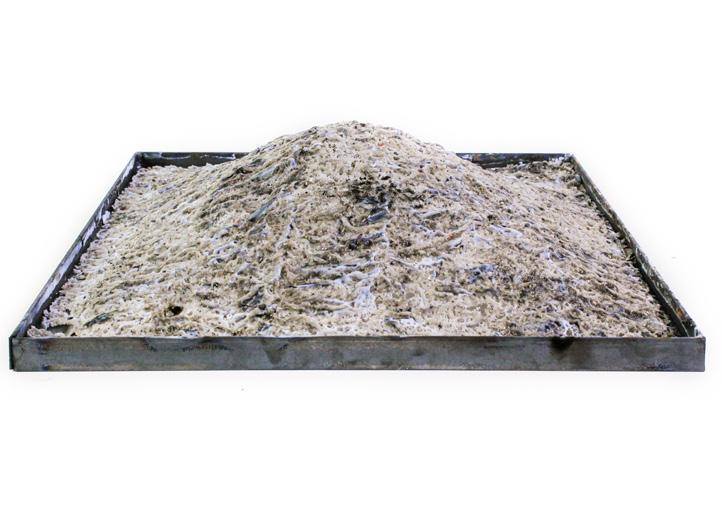
AEOLIAN | GLASS | 115 |
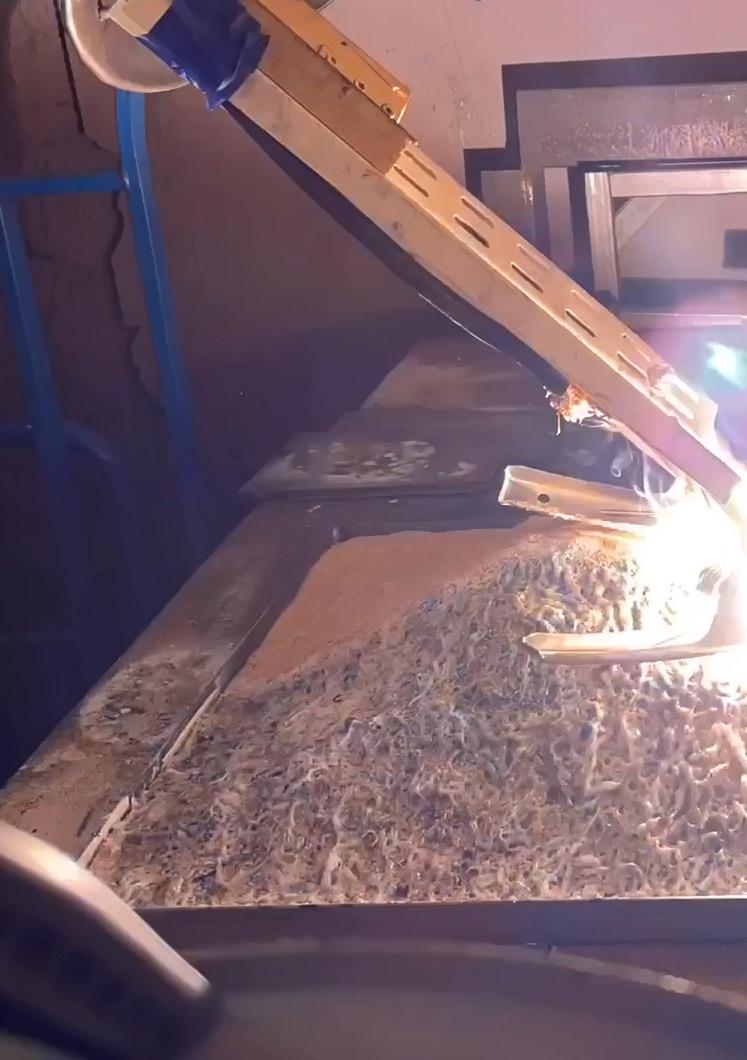
AEOLIAN | FABRICATION
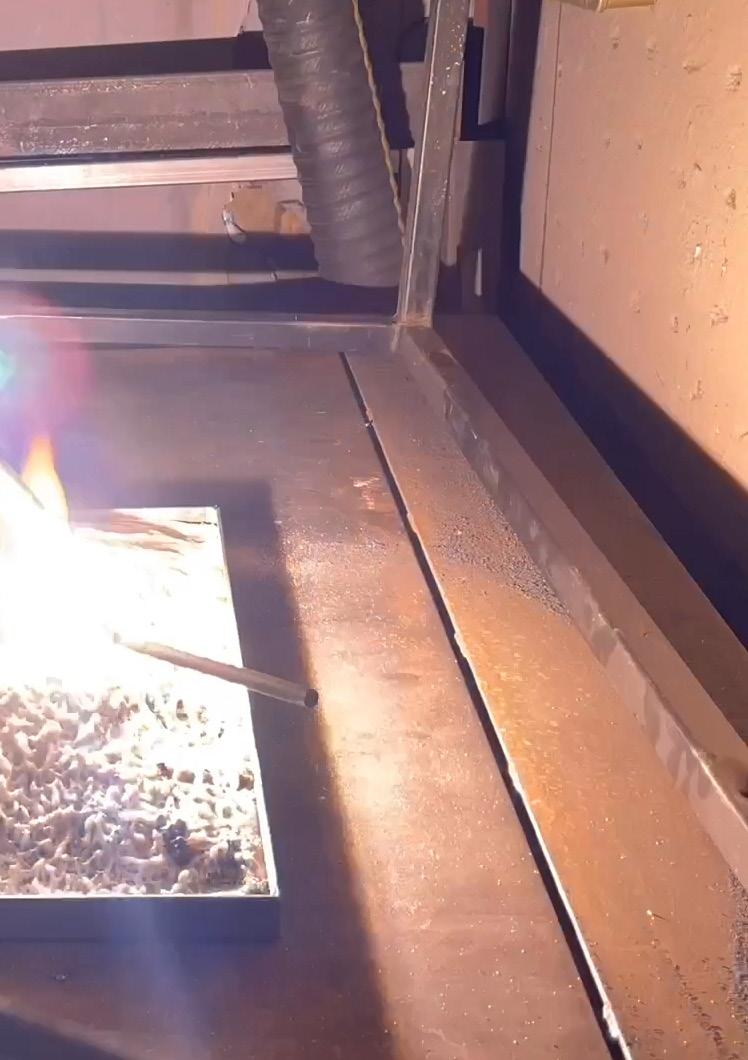
AEOLIAN | FABRICATION
Then there was a search for the different variations in form and its structural characteristics to understand the material limits. Thus a range of cantilevering surfaces was fabricated.


AEOLIAN | GLASS | 118 | WELDING 9.0



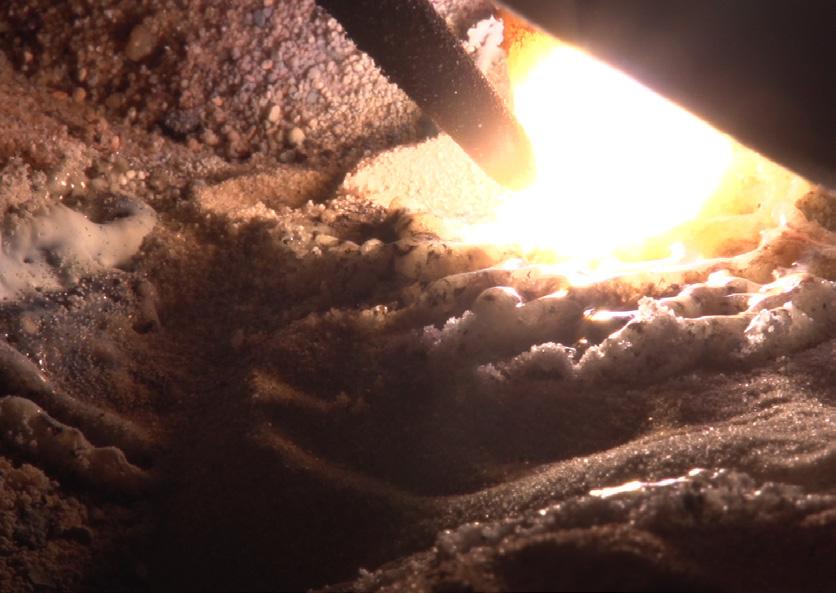
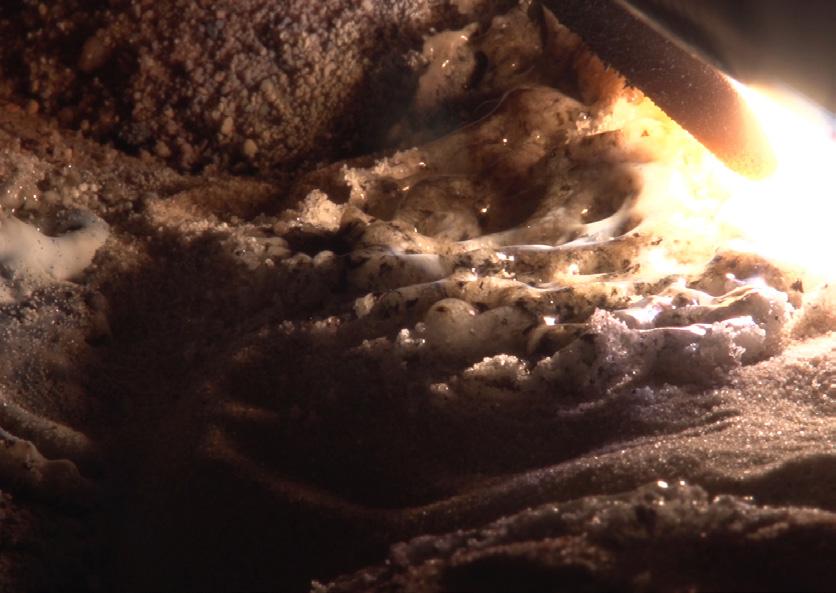
AEOLIAN | FABRICATION


AEOLIAN | GLASS | 122 |
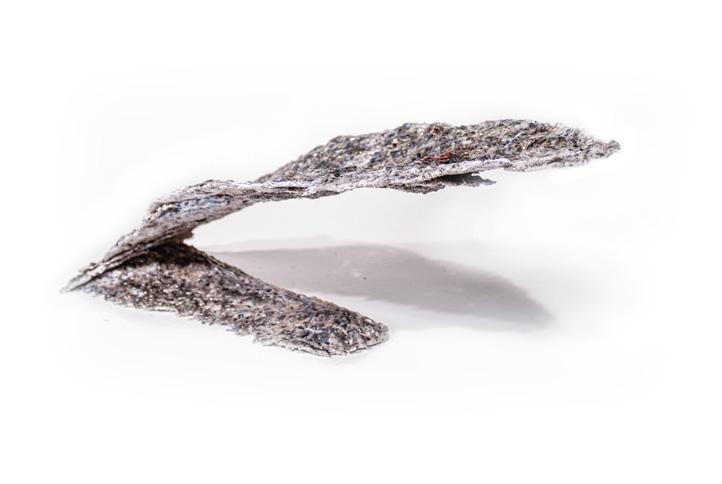

AEOLIAN | GLASS | 123 |
VERTICAL GROWTH
For the project the morphology would be more surface-like. However, there was an attempt in the search for vertical growth. The the model’s column is produced by fusing together layers of sand. Depending on the thickness of the sand the fusion was not happening throughout the whole surface, therefore the edges of layers are obvious. More than that, covered with sand, the previous glass layer is not visible therefore layers of glass are shifted from each other and the column is not vertical throughout the whole height.
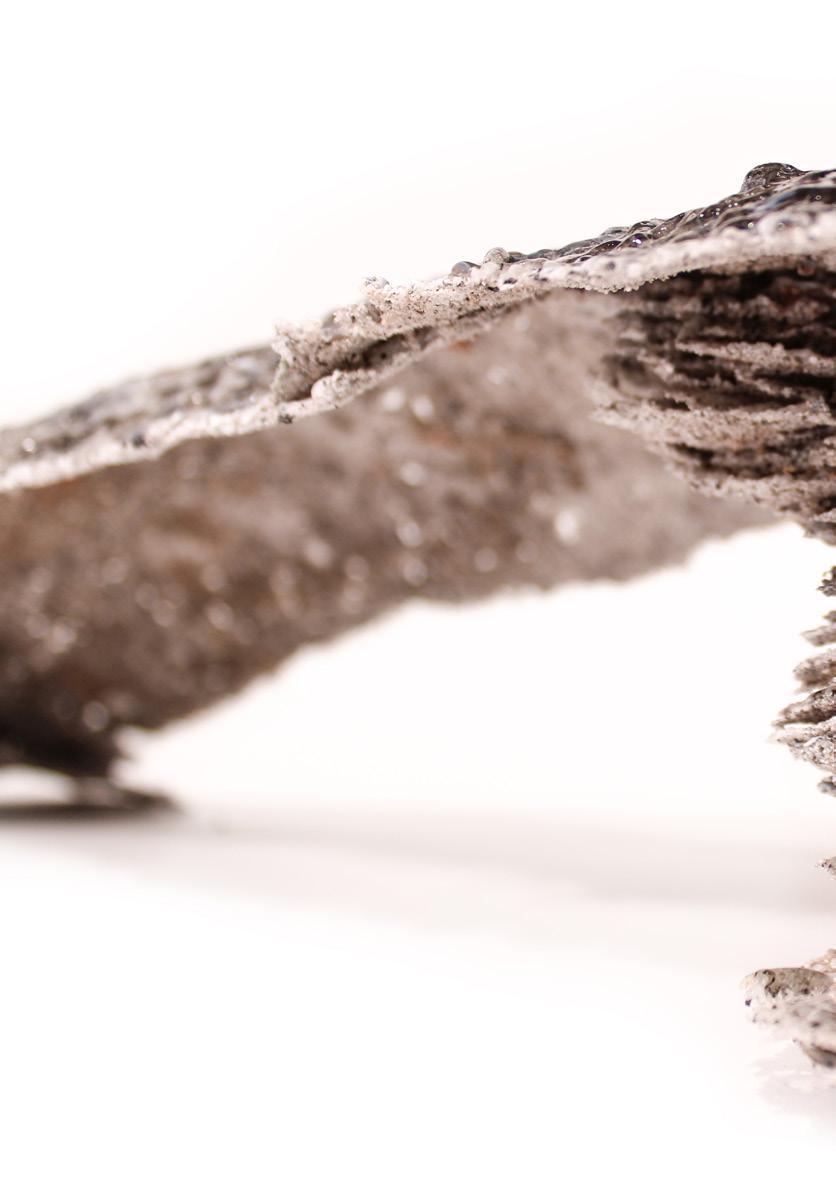
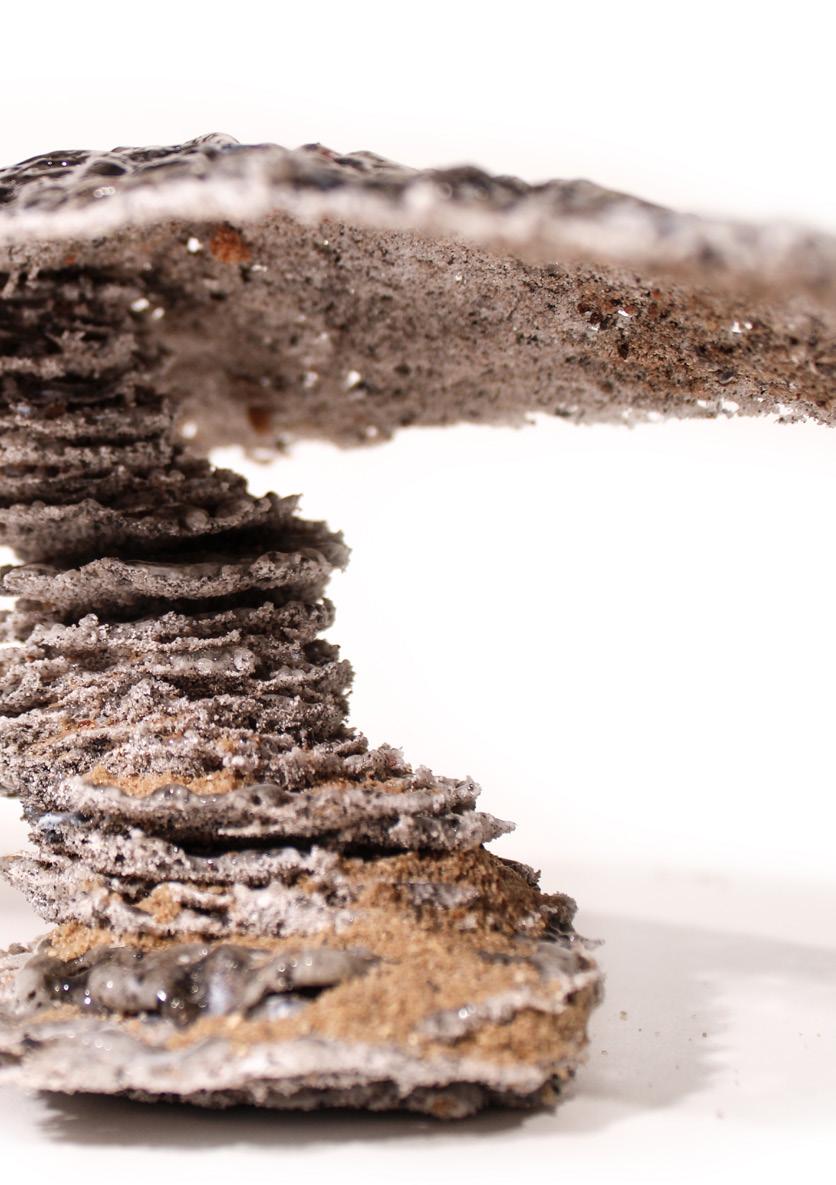
REFUSION
Glass models are solid but fragile, removing sand as a mould from the just made model may reveal cantileverings which would result in cracks or even damage of the model. The benefit of the process lets the possibility of ease in repairment or refusion without loose of its structural properties as the glass pieces would be refused together to form a solid piece.
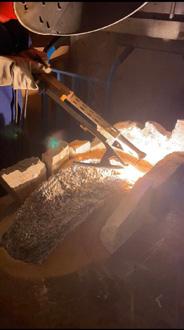
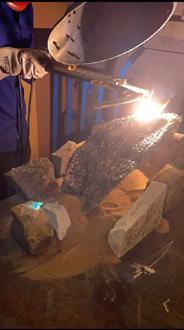

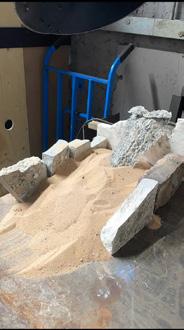


AEOLIAN | GLASS | 126 |


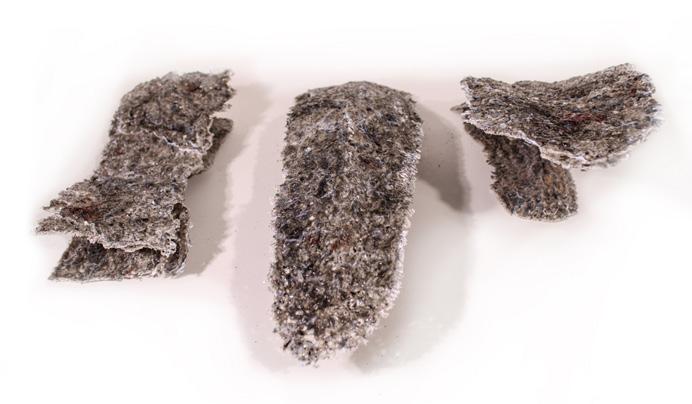
AEOLIAN | GLASS | 127 |

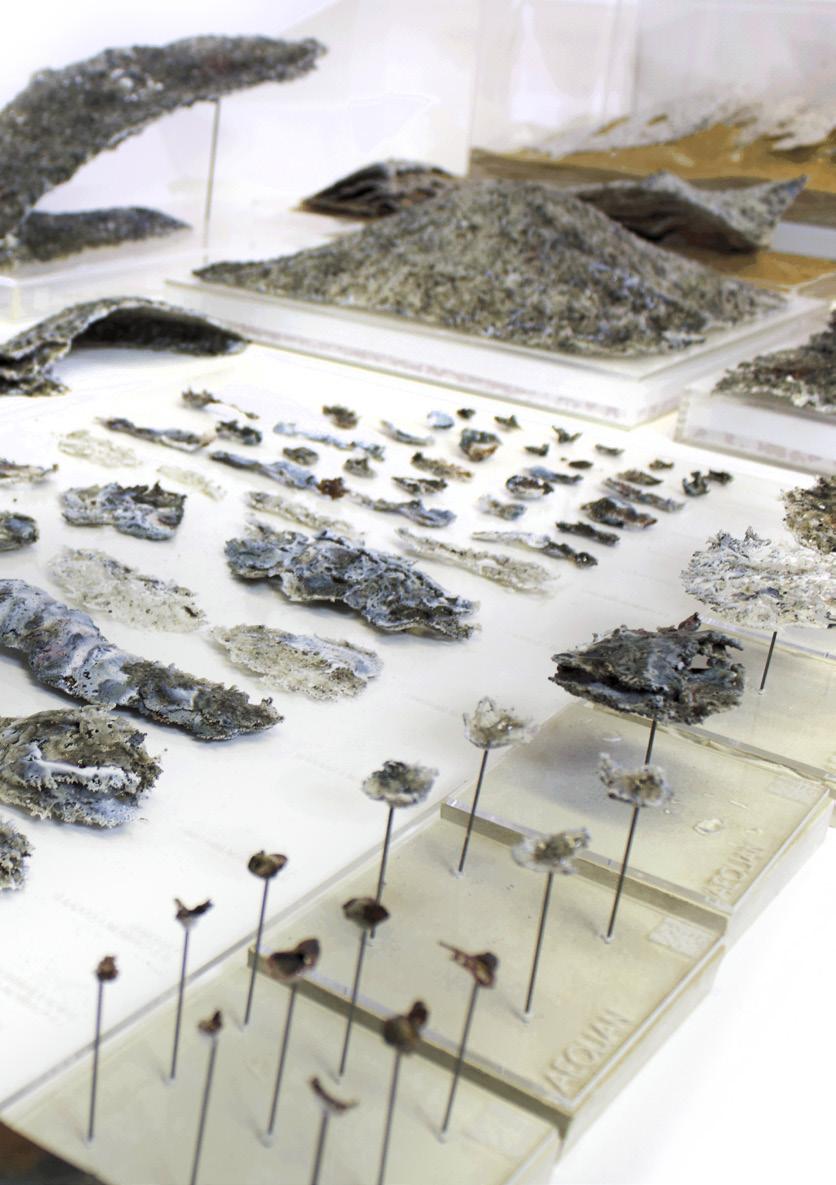
SAND AS A STRUCTURE
The model was done in the search of the possibility to employ sand to be structural material. Cantilevering layers of glass are held on the sand. The first layer of sand is closed with glass to keep it in place and others are open holding the glass. Captured sand works as structural material keeping glass loads and passing it below.



AEOLIAN | GLASS
SAND
SAND
GLASS OPEN
CLOSED
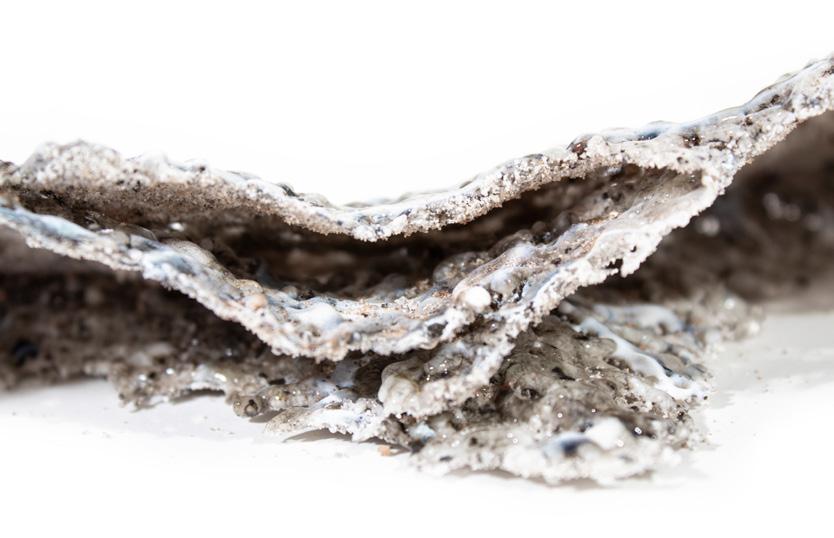

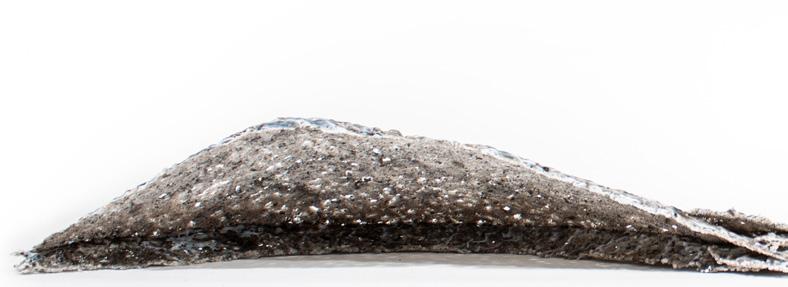
AEOLIAN | GLASS | 132 |
The same way as in the previous model, the sand is working structurally here. It is closed inside the glass layers to hold the structure.

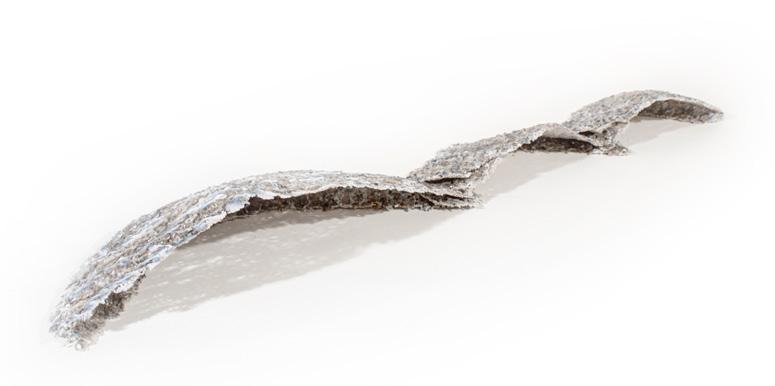

AEOLIAN | GLASS | 133 | GLASS
SAND
CLOSED
SAND AS A STRUCTURE
The sectional model was done with layers of sand and glass. It is revealing the process of accumulation of sand between two dunes and its subsequent fusion. The sand is trapped between layers and is forced to take compression forces. After the dunes are blown away with the sand, the glass structure is revealing cantilevering sides.
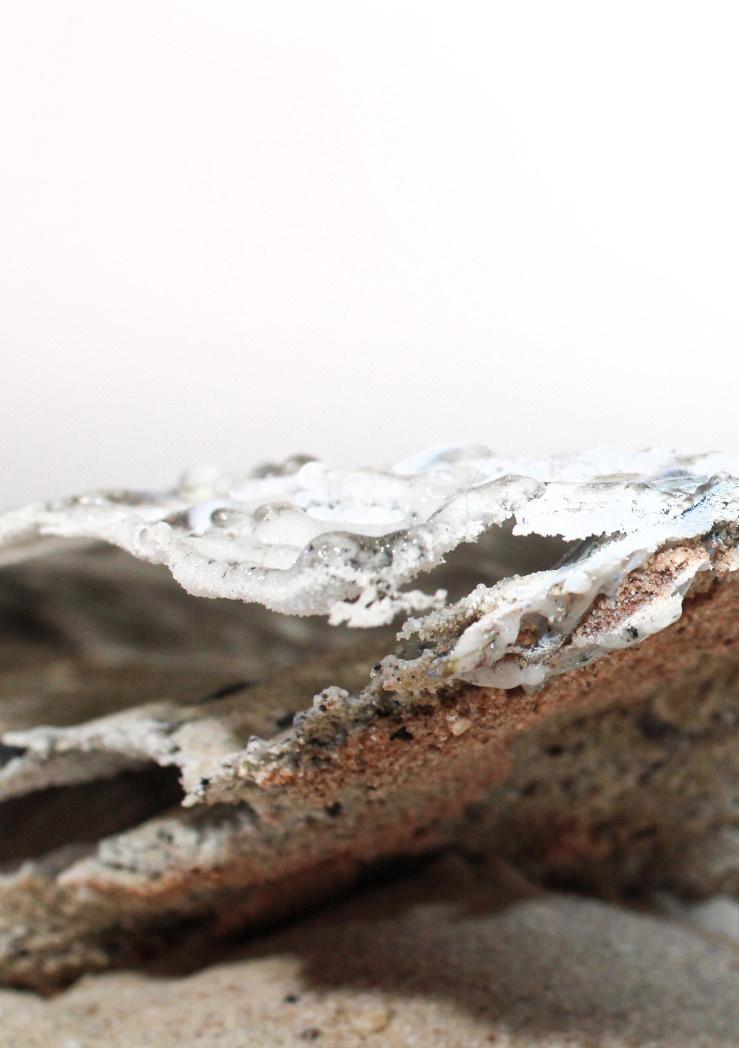

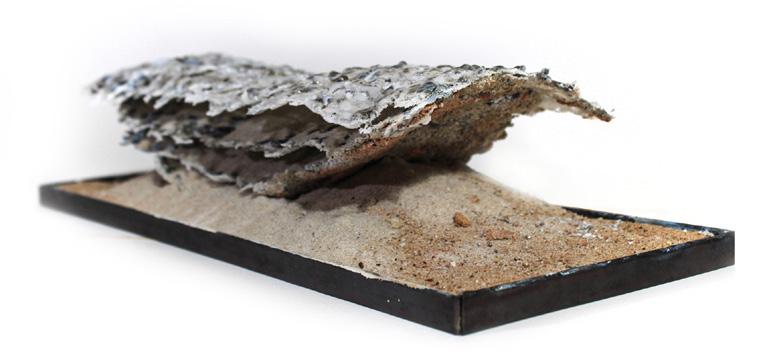
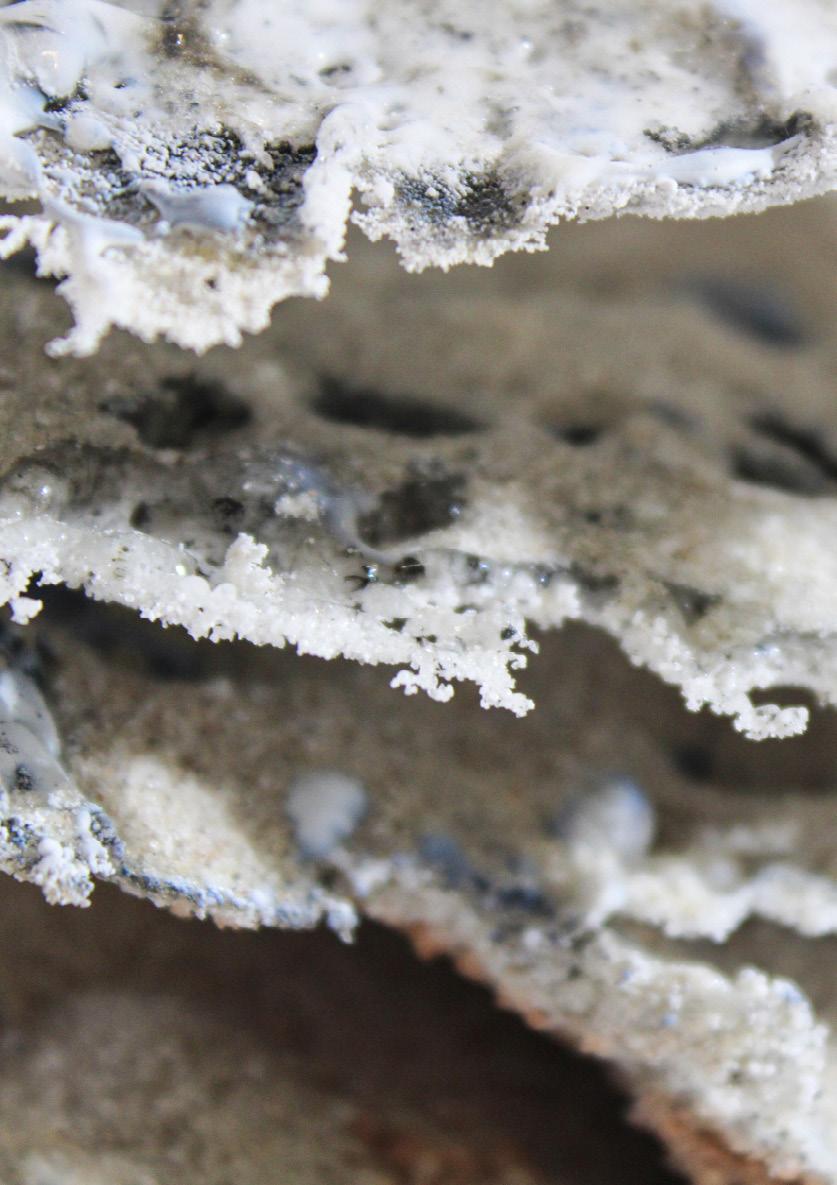
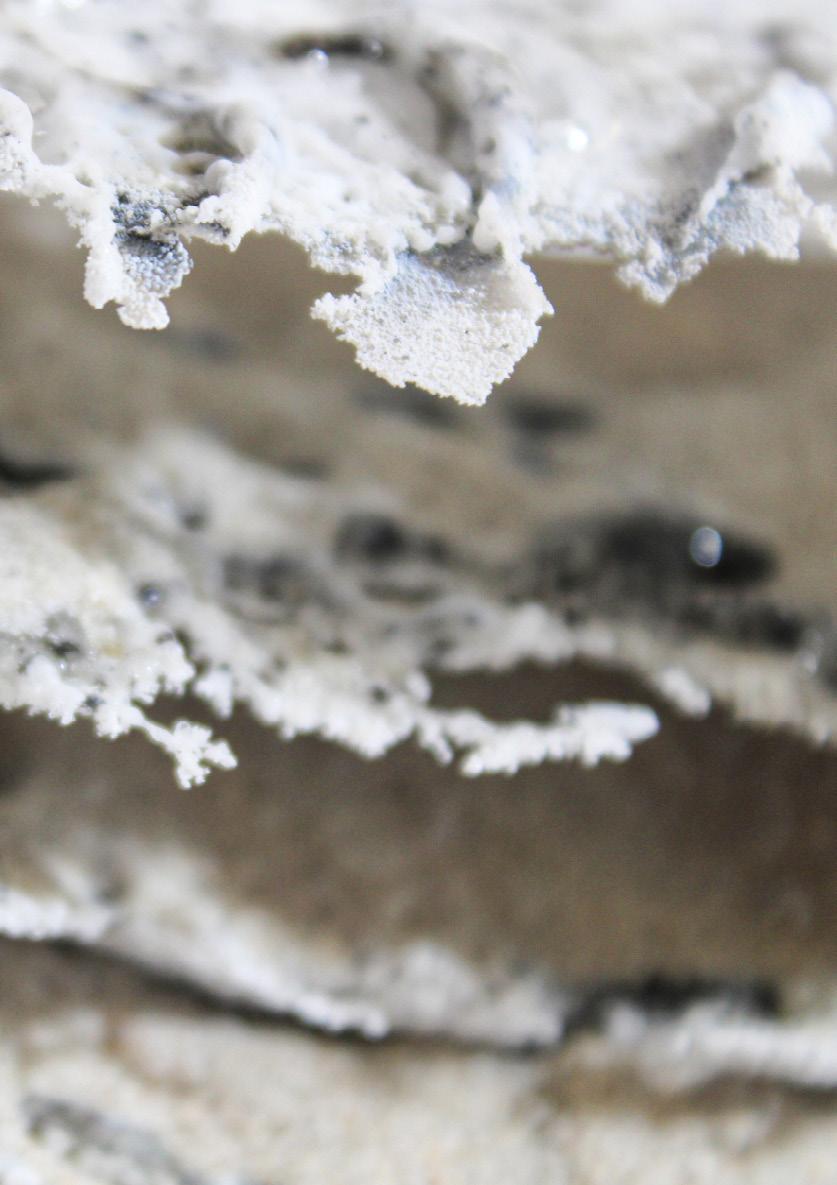
SAND AS A STRUCTURE
The model was executed with the same approach as the previous one, but here sand was accumulating and fusing in layers between four dunes, revealing more spacious structure.
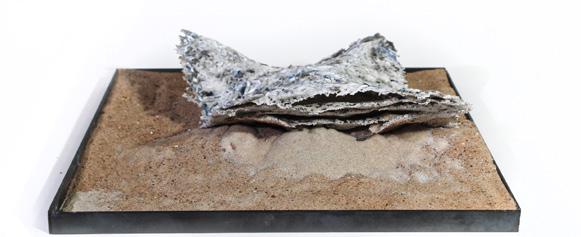

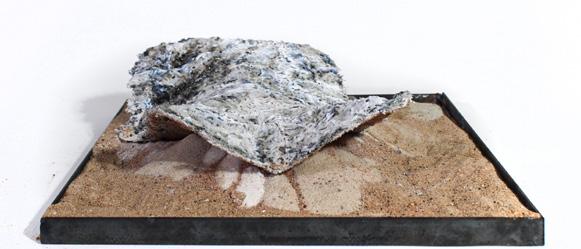
AEOLIAN | GLASS | 138 |
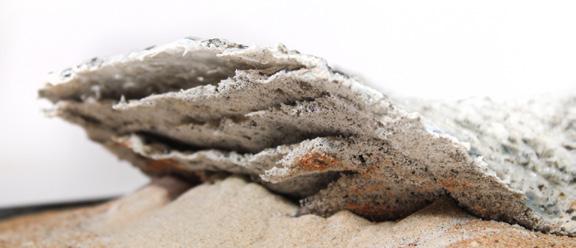
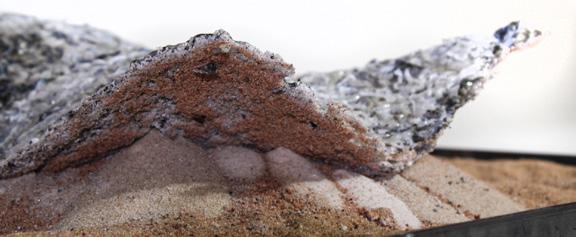

AEOLIAN | GLASS | 139 |
SAND AS A STRUCTURE
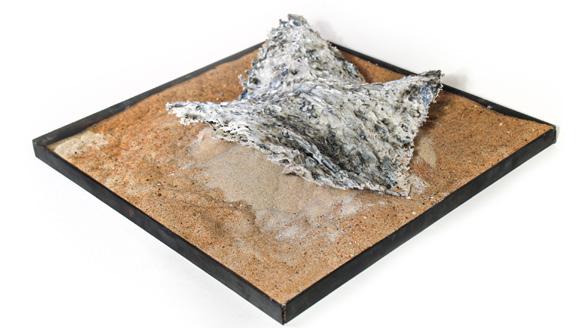


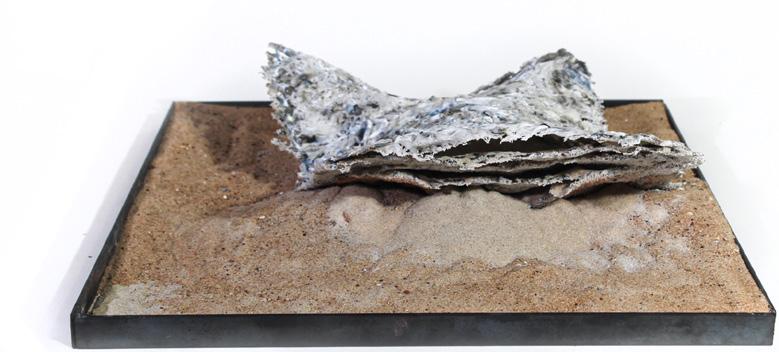
AEOLIAN | GLASS
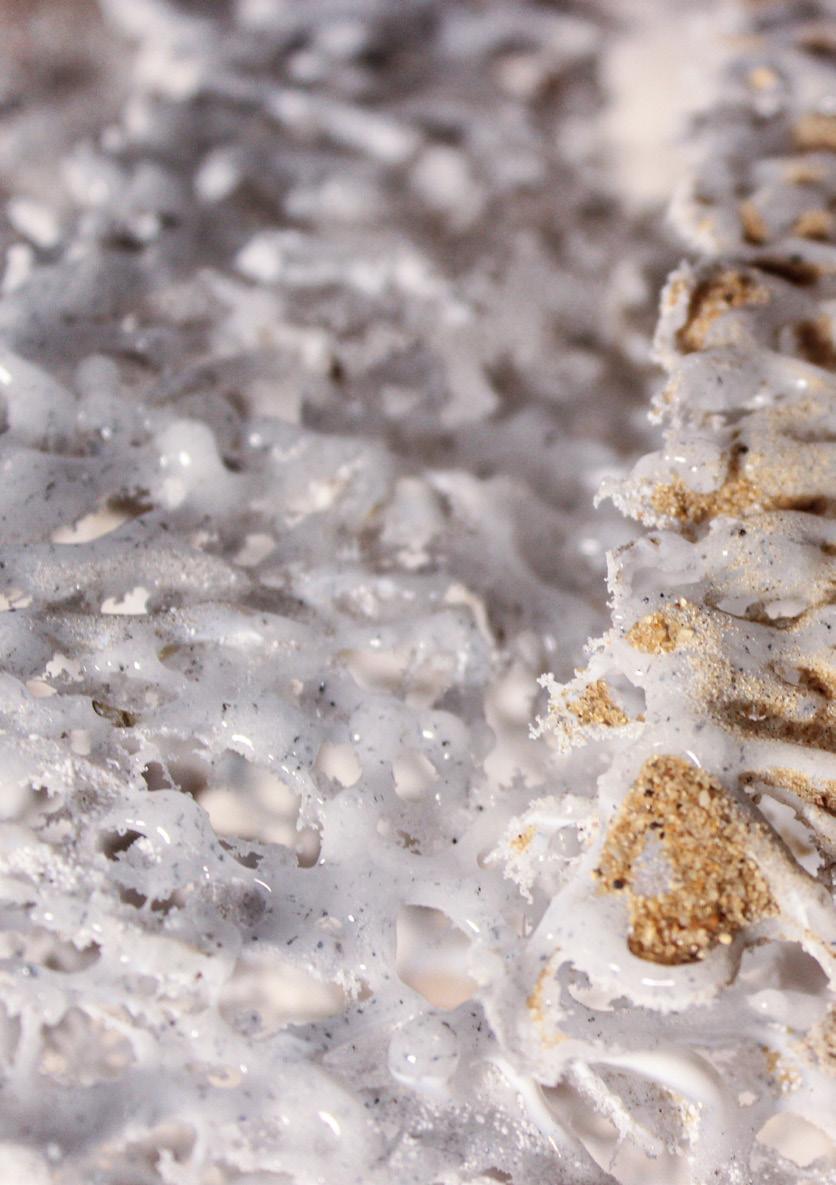

SAND AS A STRUCTURE
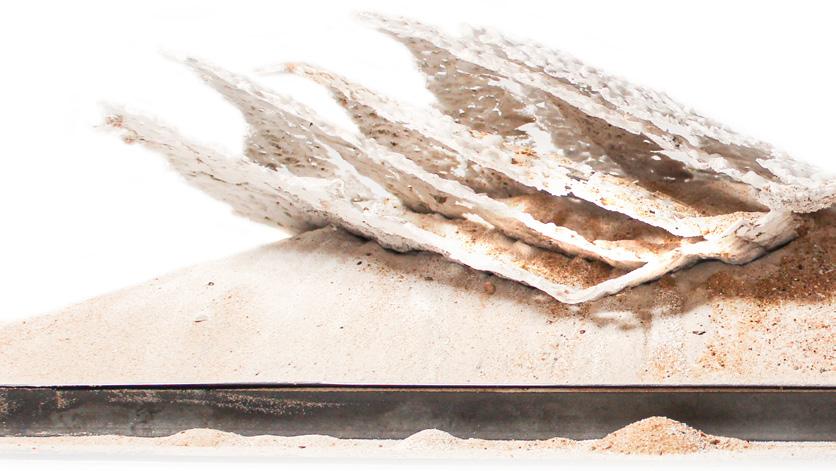
For the bigger models the glass is partially covered with sand. It was executed following the logic of actual process in the desert. The first layer of glass was done on a specific slope, then the portion of sand was blown on top of the model from a specific angle and the next layer of glass was fused. The repetition of the process resulted in a form, structurally integrated with the sand.
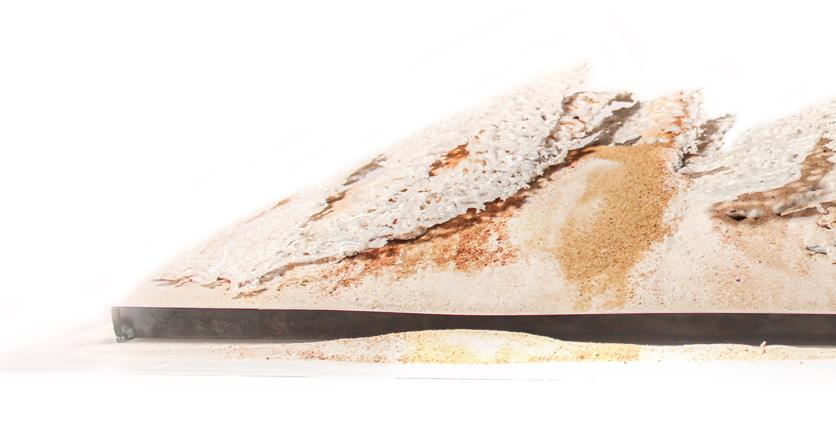


AEOLIAN | GLASS
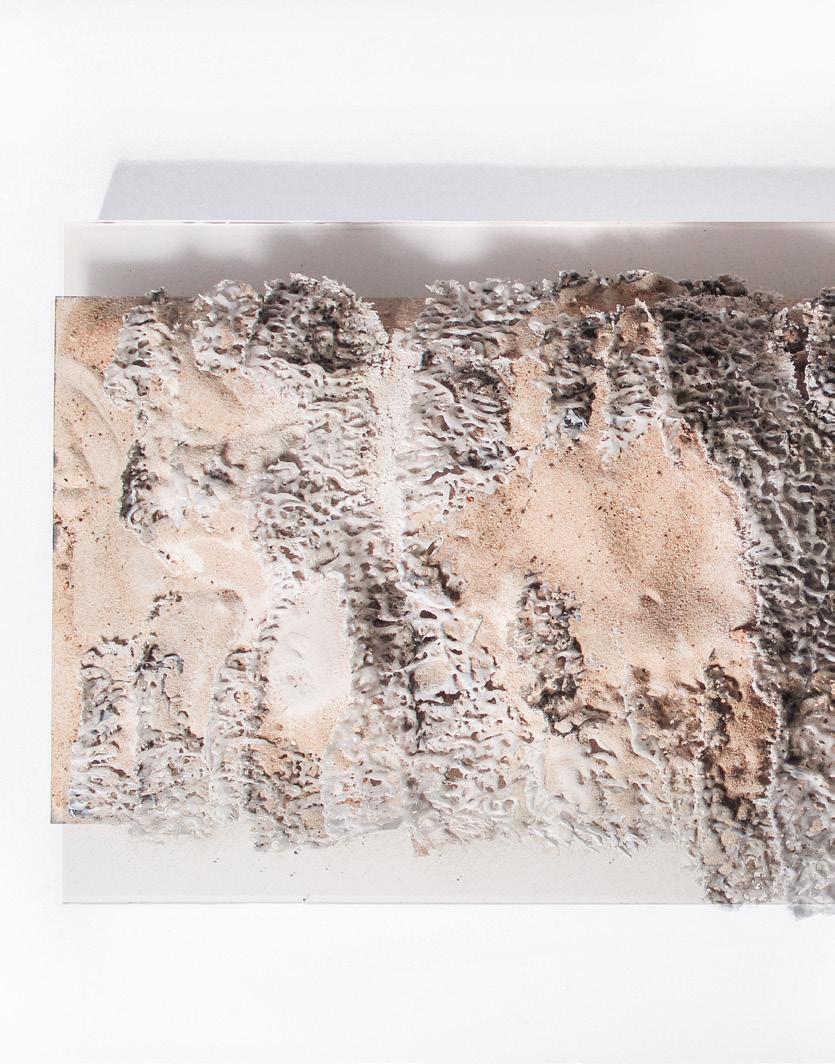
AEOLIAN | GLASS | 146 |

| 147 |
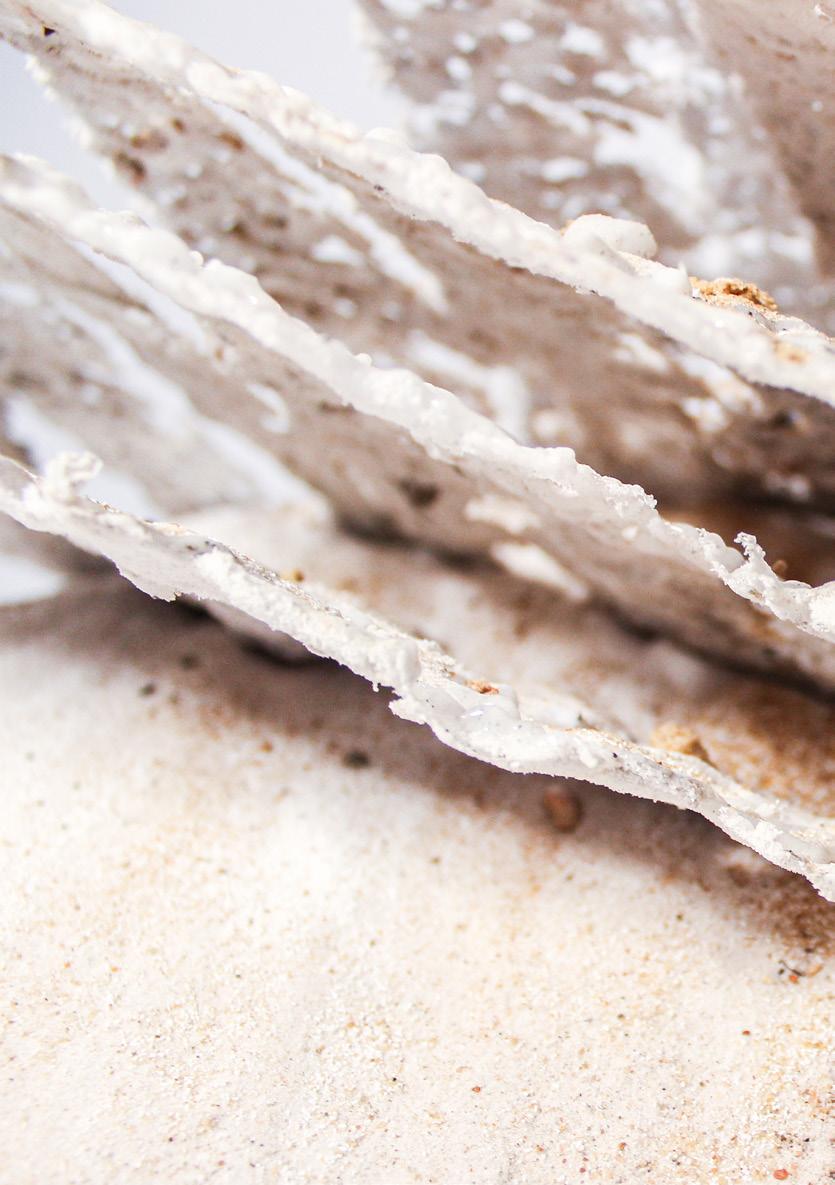
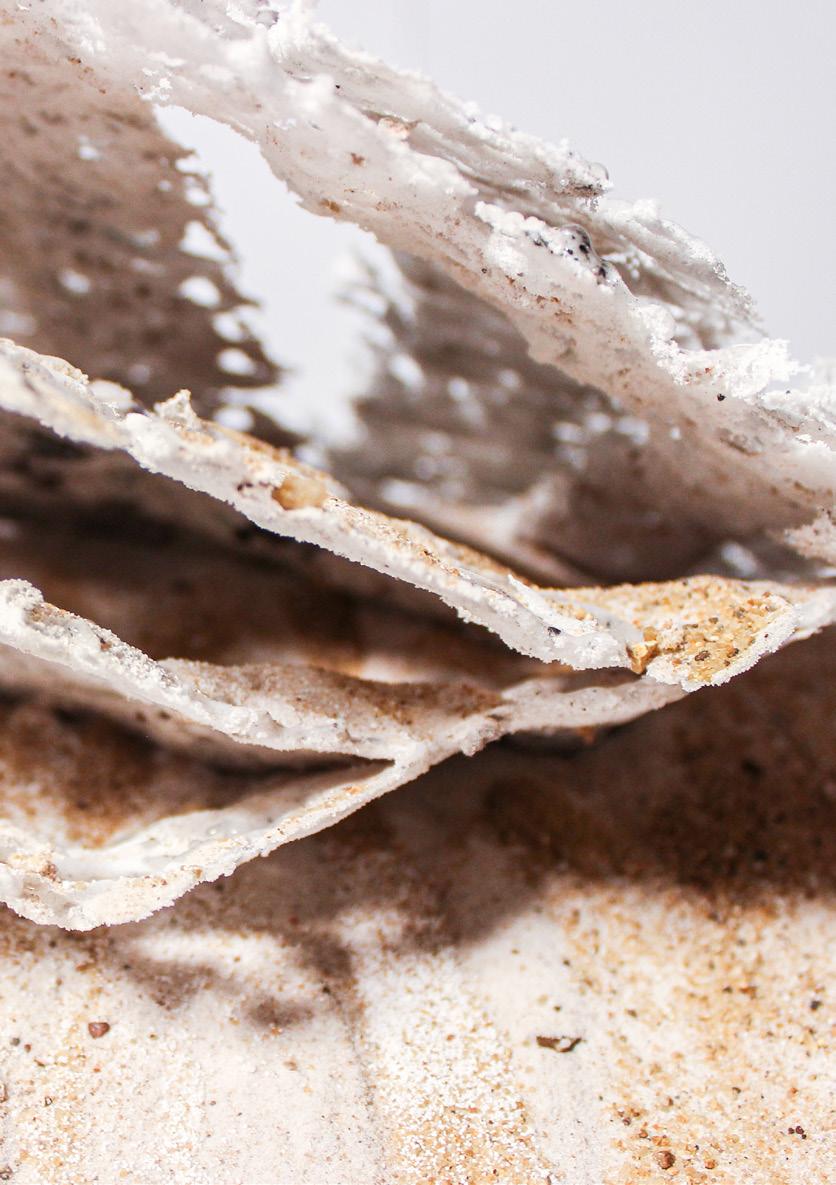
Iteration 1
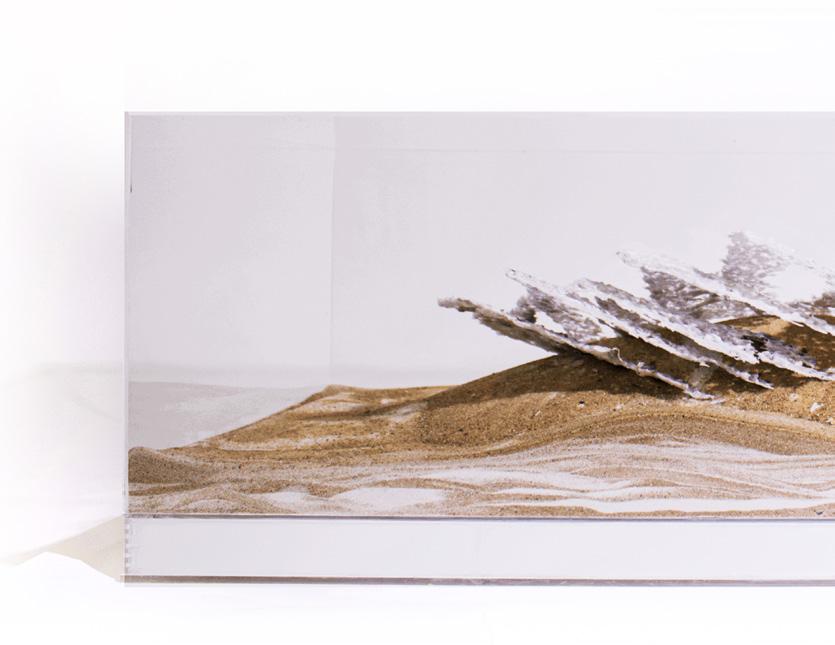
AEOLIAN | GLASS | 150 |
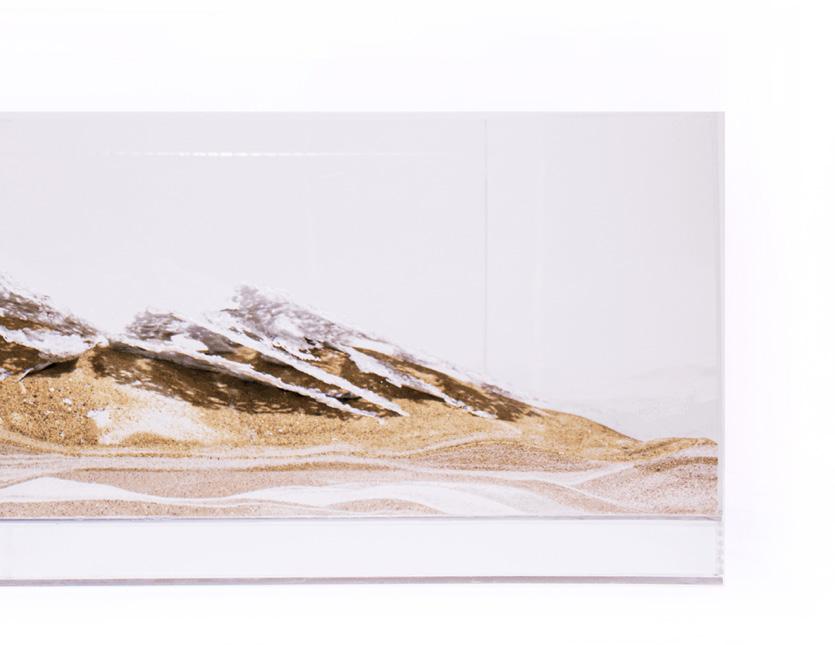
AEOLIAN | GLASS | 151 |

AEOLIAN | GLASS | 152 |
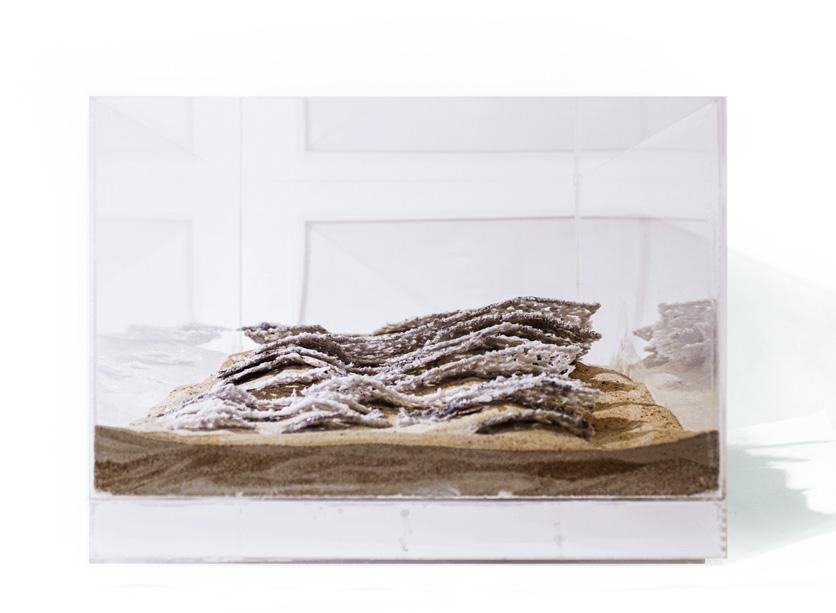
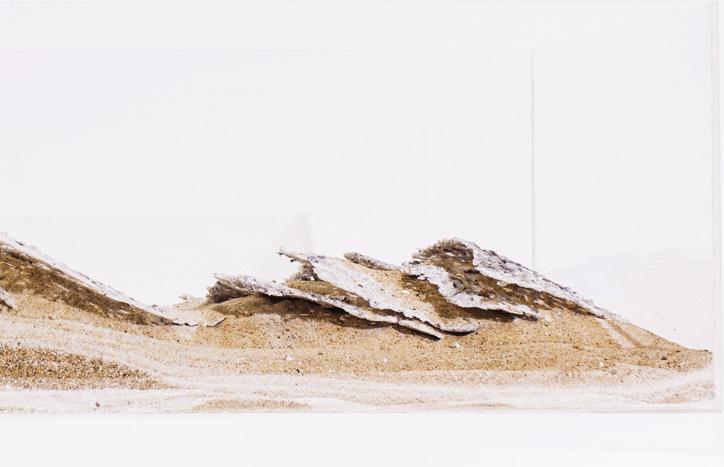
| 153 |
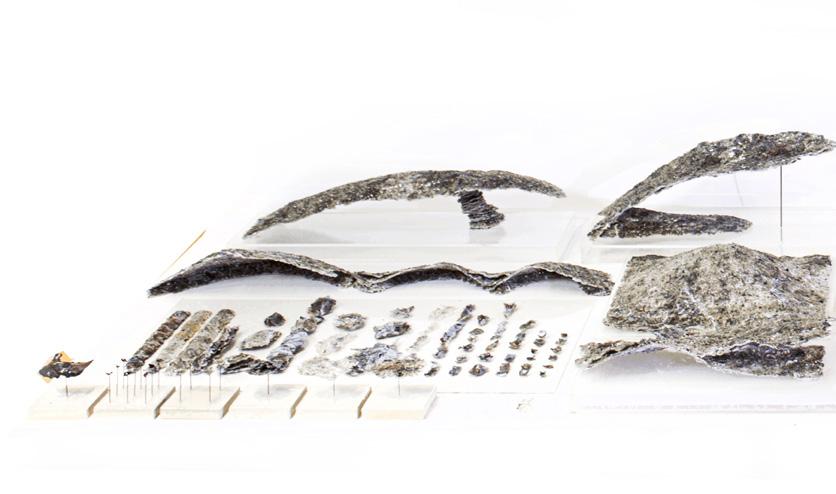
AEOLIAN | GLASS | 154 |
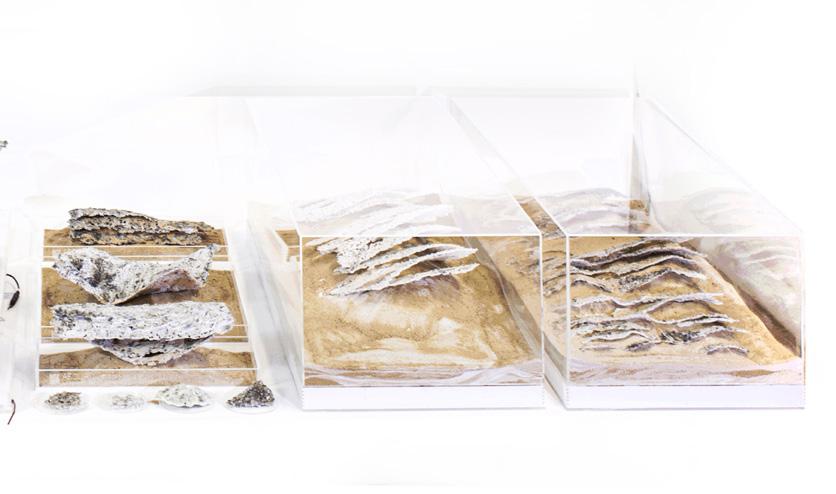
AEOLIAN | GLASS | 155 |
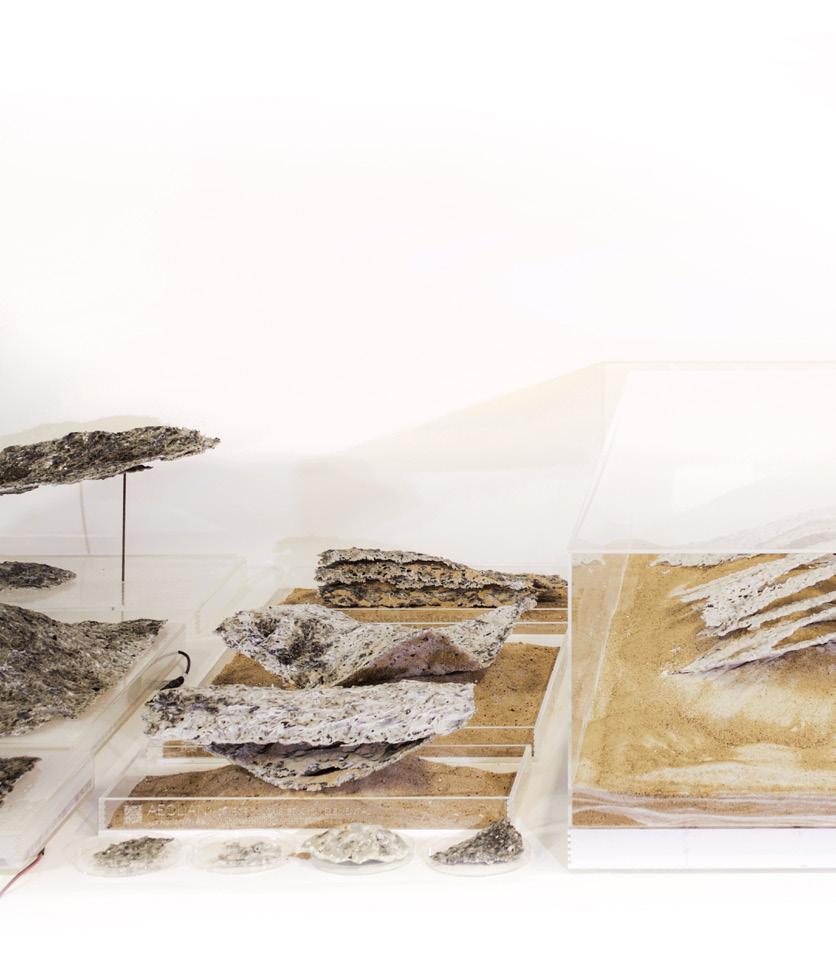

AEOLIAN | GLASS
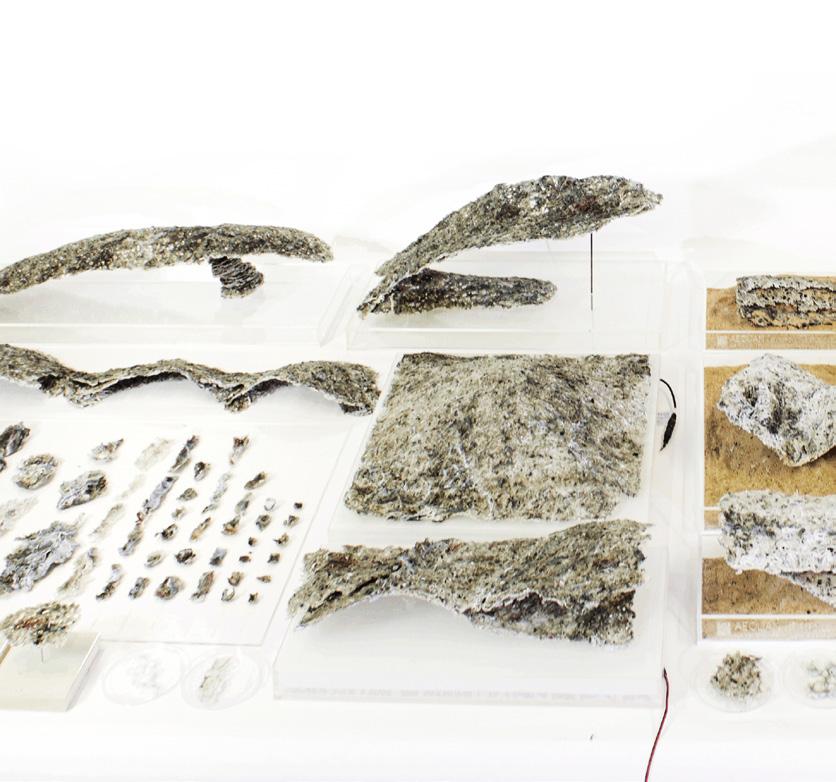

AEOLIAN | GLASS
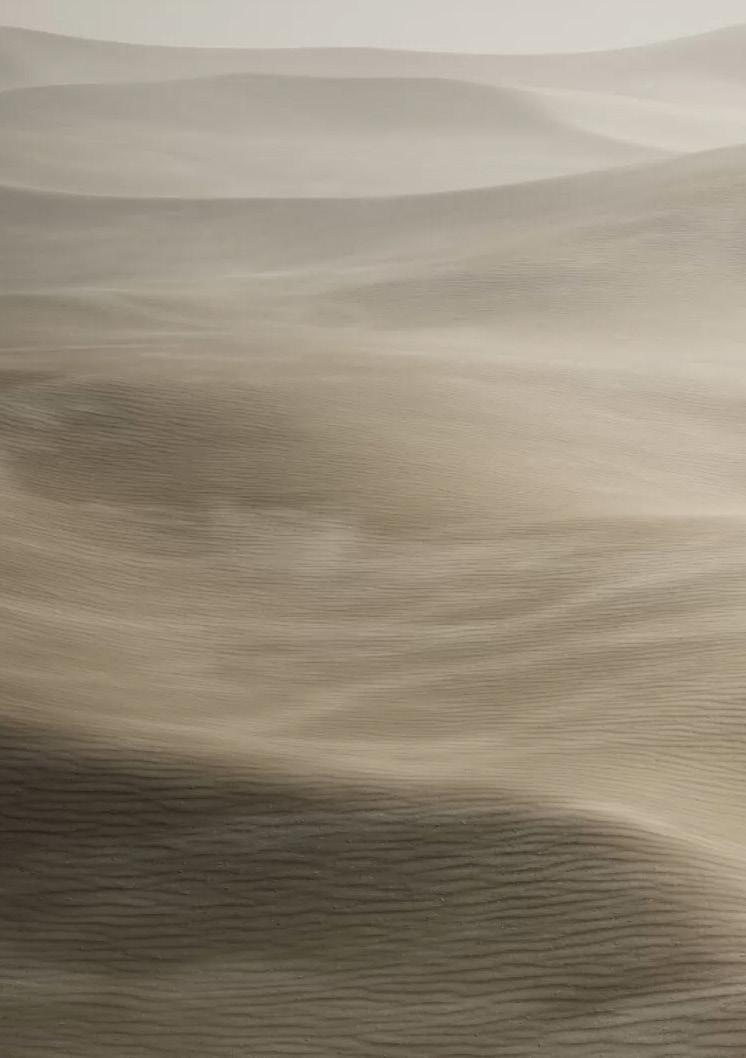

STRATEGY DUNE SLOPES
SOFT BOUNDARIES REDIRECTION INTUITION
A simple set of digital experiments was devised to extract principles and develop an intuition for how different geometries can affect the collision of sand particles with a wind force moving straight towards it. Three entities are required for this experiment: sand particles, barrier geometry, and the area to prevent sand particles from penetrating. From the series of experiments conducted, it became clear that geometry located with an angle to the wind direction was performing better.
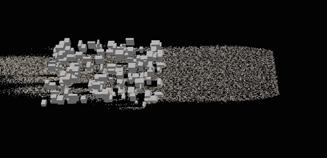
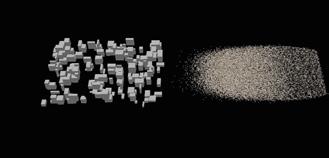
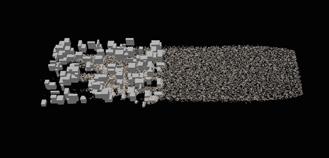

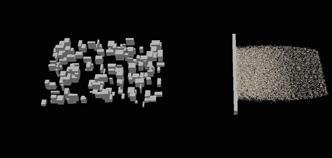
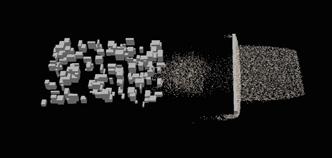
AEOLIAN | STRATEGY | 162 |
Simulation Middle Simulation Beginning Simulation End
II) Straight Edge I) No Edge
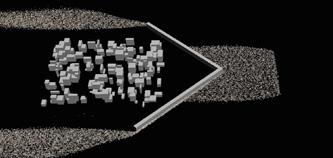
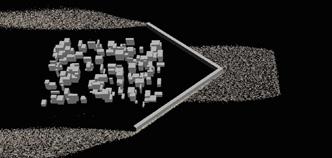

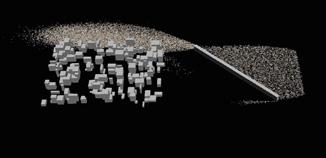

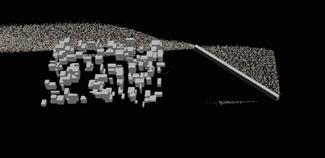
AEOLIAN | STRATEGY | 163 |
IV) Triangular Edge III) Angular Edge
SOFT BOUNDARIES BARRIER INTUITION

As the triangular geometry proved to be better performing, the experiments were expanded upon to test how different configurations of the triangular geometry could influence the global system. In addition, the ratio between volume of geometry and the number of particles penetrating the barrier also gives a better understanding to furthermore optimize the process.
After multiple examples and iterations, it became clear that certain geometries and strategies provided better results. For example, the single triangular edges from experiment [ I ] would get overwhelmed quickly from the rush of sand particles, whereas having multiple layers such as those displayed in experiment [ II ] of them proved to create better results. Experiment [ III ] attempted to show how the having certain densities of the multiple triangular edges would respond. The final and segmented study proved to be the best out of all attempted experimentations; utilizing a maximum performance with minimal resources. Going forward, the team use lessons learned in this chapter in the agent based system.
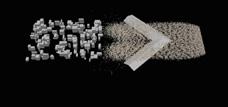
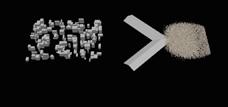
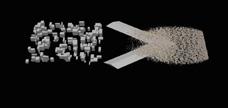


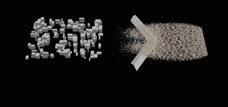
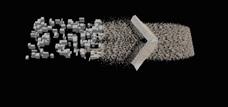
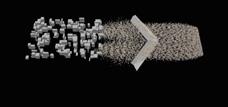
AEOLIAN | STRATEGY | 164 |
Experiment [ I ] Single Triangular Edge Beginning Middle End Regular Edge Large Edge Small Edge
Experiment [ II ] Multiple Triangular Edge


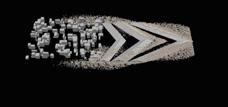
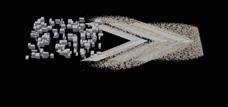
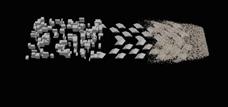
Regular Edges
Large Edge

Small Edge
Beginning
Middle End
Experiment [ III ] Multiple Triangular Edge
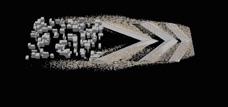

Regular Edge
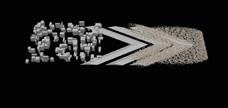
Large Edges
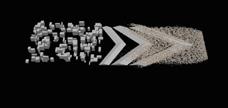

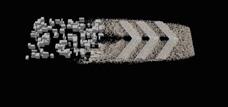

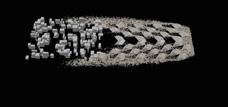
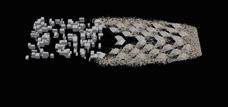
Small Edges

Beginning Middle End
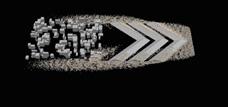

AEOLIAN | STRATEGY | 165 |
FACE SELECTION
SUITABLE STRUCTURE SIDE ON DUNES
Strategies were developed to find the most optimal way to fuse terrain in dune landscapes. By analysing the direction of wind, specific faces were identified: wind-facing faces, leeward faces, and a blend between the two, creating a side-face. These faces were tested in a real-time simulative environment to determine which was most effective at redirecting sand particles.





Time Step: 0:00:00
Time Step: 0:00:02
Time Step: 0:00:04
Time Step: 0:00:06
Time Step: 0:00:08



AEOLIAN | STRATEGY | 166 |
FACE SELECTION FRONT FACE Front Face Back Face Joining Face Section
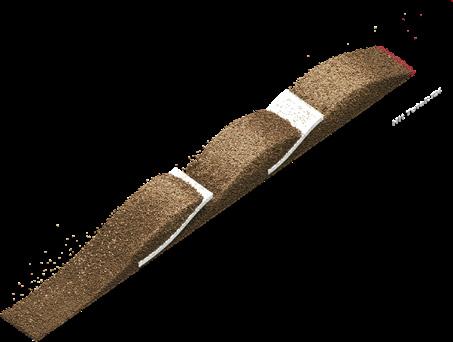
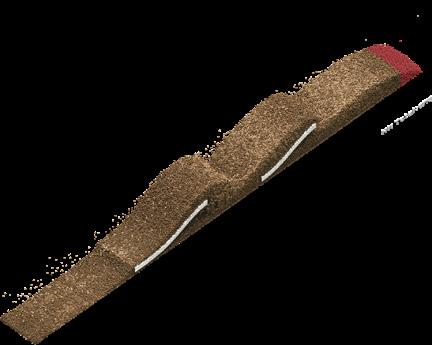
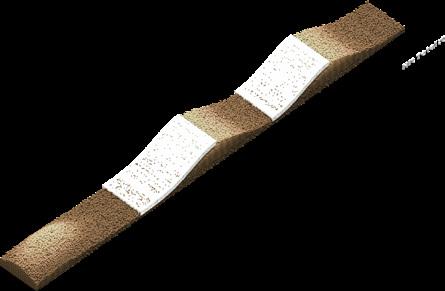
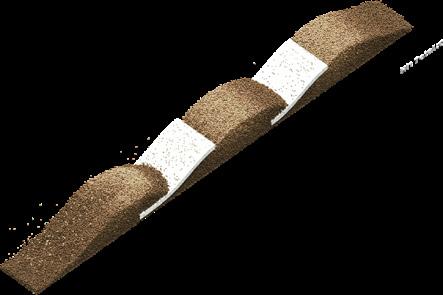

AEOLIAN | STRATEGY | 167 | Time Step: 0:00:00 Time Step: 0:00:02 Time Step: 0:00:04 Time Step: 0:00:06 Time Step: 0:00:08 Isometric
FACE SELECTION JOIN FACE





AEOLIAN | STRATEGY | 168 |
Time Step: 0:00:06 Time Step: 0:00:08 Time Step: 0:00:04 Time Step: 0:00:02 Time Step: 0:00:00 High Low Wind Dynamic Section

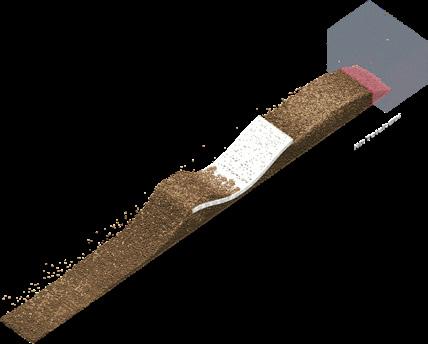
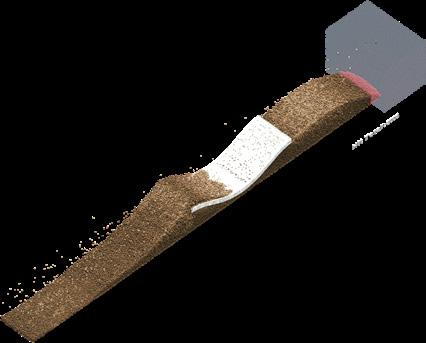

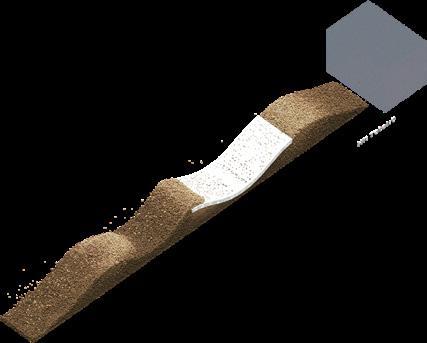
AEOLIAN | STRATEGY | 169 | Time Step: 0:00:00 Time Step: 0:00:02 Time Step: 0:00:04 Time Step: 0:00:06 Time Step: 0:00:08 Isometric
FACE SELECTION BACK





AEOLIAN | STRATEGY | 170 | Time Step: 0:00:06 Time Step: 0:00:08 Time Step: 0:00:04 Time Step: 0:00:02 Time Step: 0:00:00
FACE High Low Wind Dynamic Section
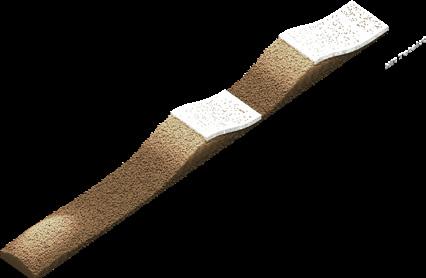
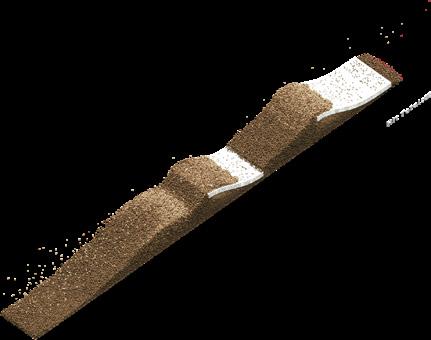
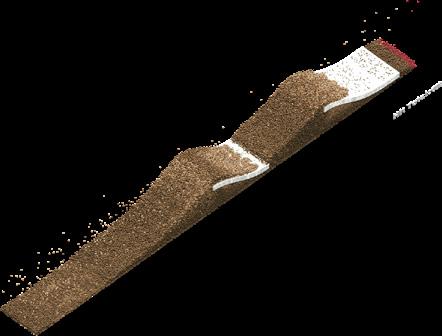

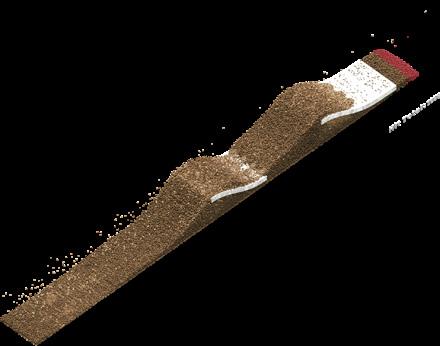
AEOLIAN | STRATEGY | 171 | Time Step: 0:00:00 Time Step: 0:00:02 Time Step: 0:00:04 Time Step: 0:00:06 Time Step: 0:00:08 Isometric
After running the simulations, the back face structure has the best performance in protecting the area from the sand. As a result, the rear face is chosen to be a significant side for agents to consider for structural creation.



AEOLIAN | STRATEGY | 172 |

AEOLIAN | STRATEGY | 173 |
LAYER QUANTITY
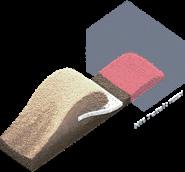


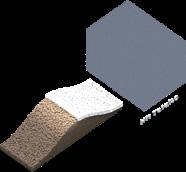
NUMBER OF LAYERING
The addition of layers improves the structure’s effectiveness at redirecting sand particles, as demonstrated by our simulations. As the number of layers increases, the structure’s morphology blends with the desert, becoming partially buried yet still fully interactive with the terrain.

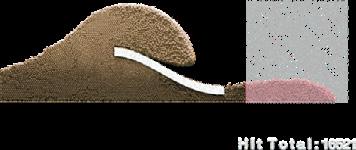
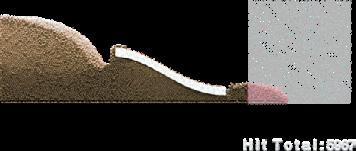
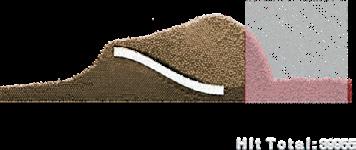
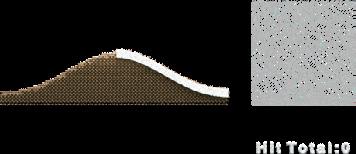
AEOLIAN | STRATEGY | 174 |
Time Step: 0:00:00 Time Step: 0:00:01 Time Step: 0:00:02 Time Step: 0:00:03 High Low Wind Dynamic Isometric 1 Layer Section
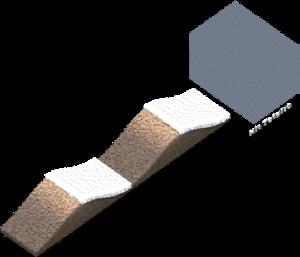
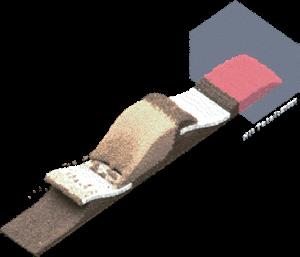







AEOLIAN | STRATEGY | 175 | Time Step: 0:00:00 Time Step: 0:00:02 Time Step: 0:00:06 Time Step: 0:00:04 High Low Wind Dynamic Isometric 2 Layers Section



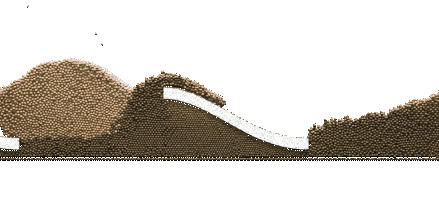


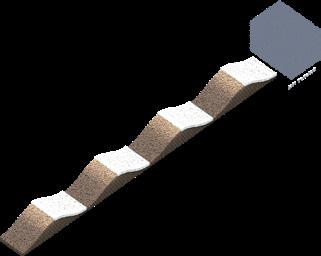
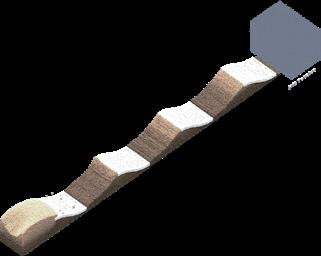


AEOLIAN | STRATEGY | 176 | Time Step: 0:00:00 Time Step: 0:00:02 Time Step: 0:00:04 Time Step: 0:00:06 Isometric 4 Layers Section High Low Wind Dynamic
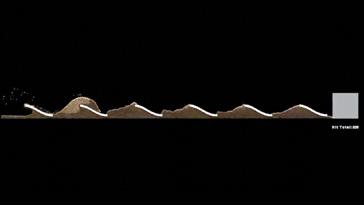
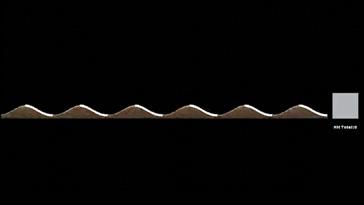
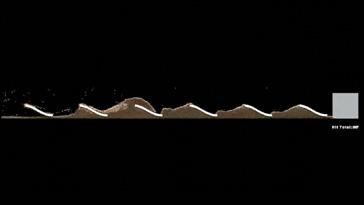


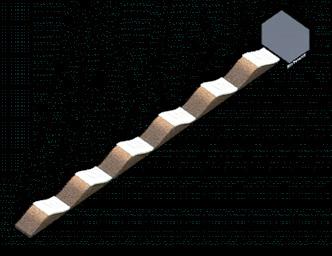
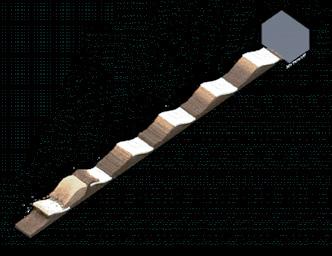
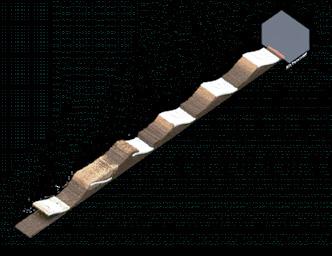
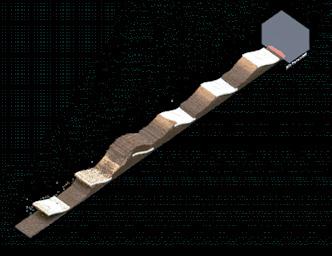
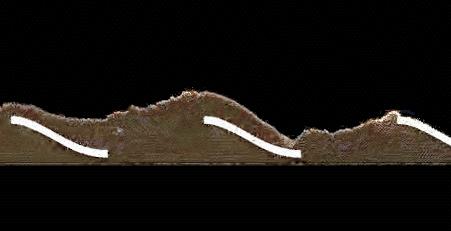
AEOLIAN | STRATEGY | 177 | Time Step: 0:00:00 Time Step: 0:00:02 Time Step: 0:00:04 Time Step: 0:00:06 High Low Wind Dynamic Isometric 6 Layers Section
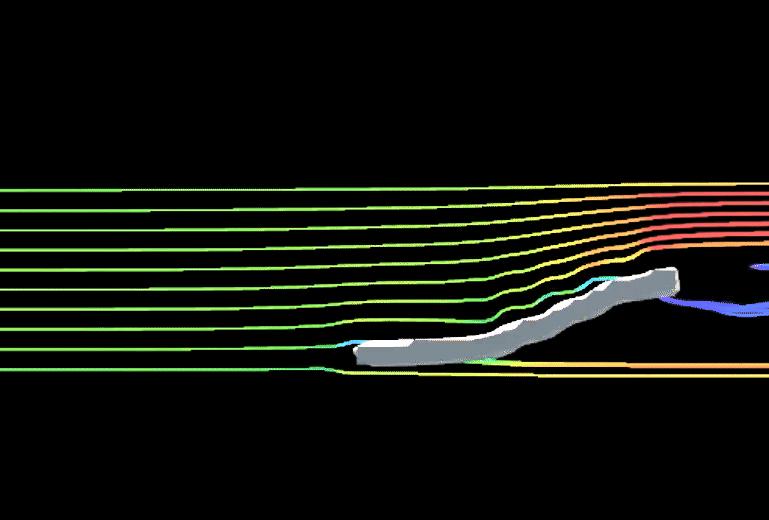

AEOLIAN | STRATEGY | 178 |
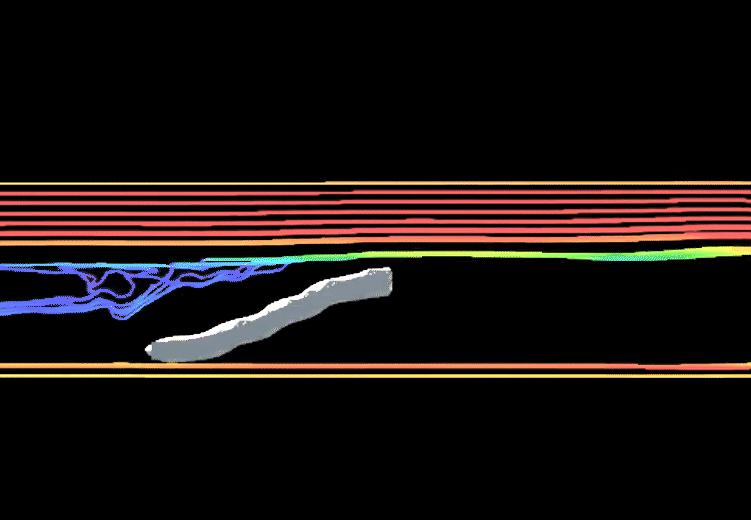
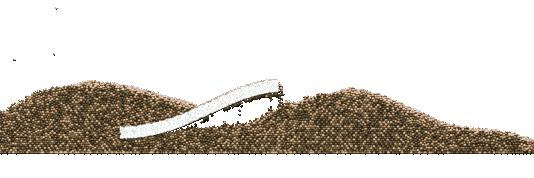
AEOLIAN | STRATEGY | 179 |
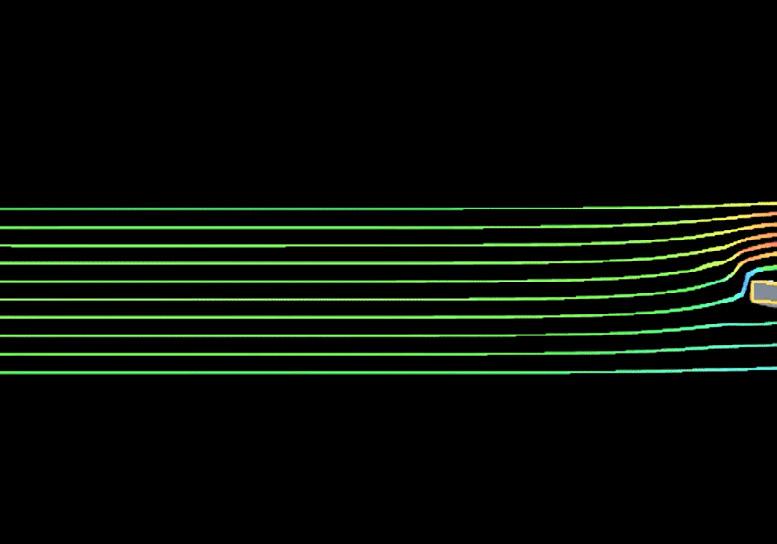
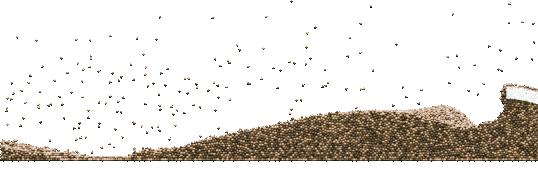
AEOLIAN | STRATEGY | 180 |
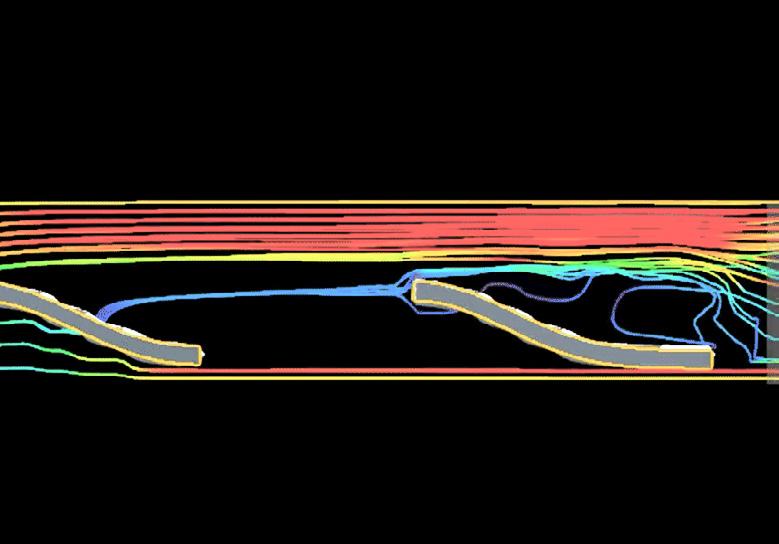
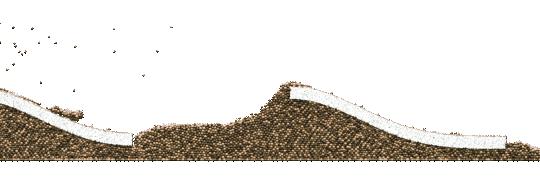
AEOLIAN | STRATEGY | 181 |

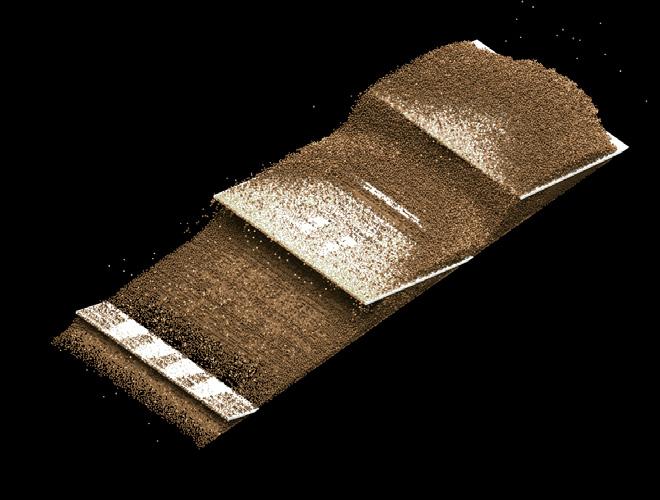
AEOLIAN | STRATEGY | 182 |
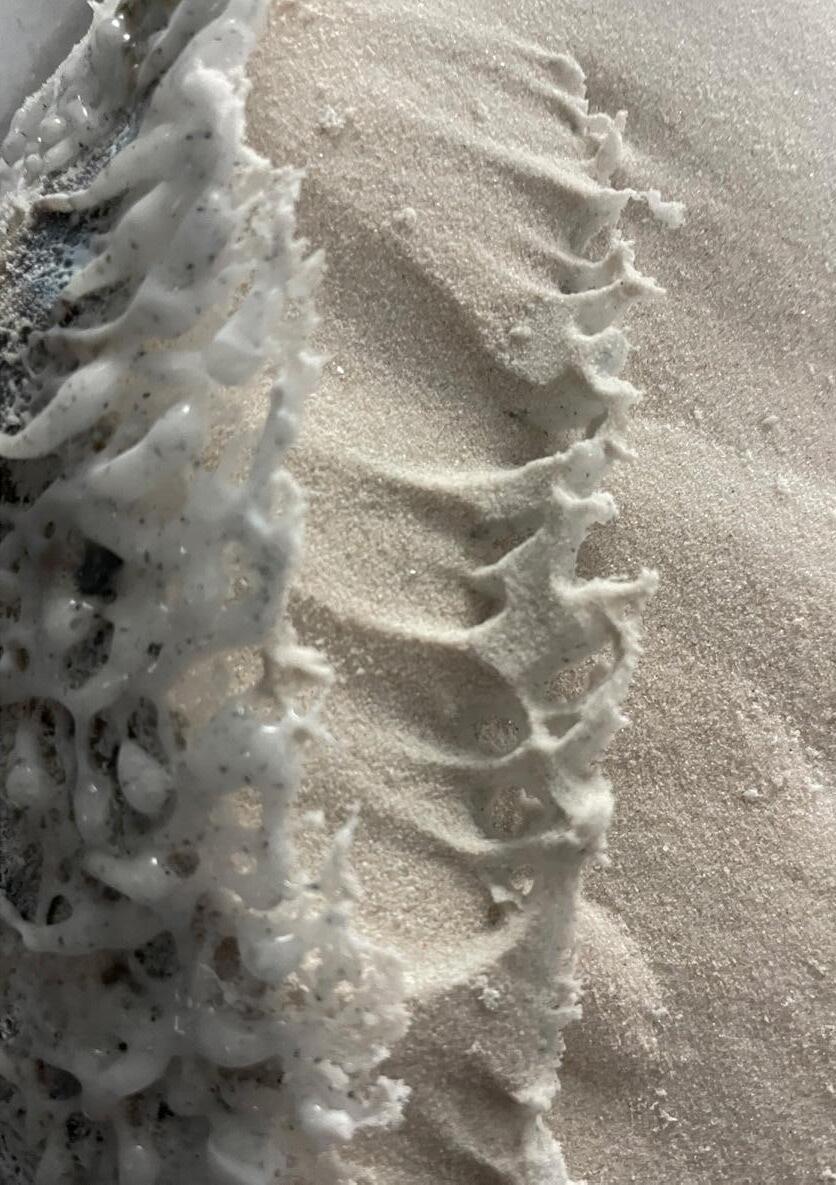
SAND BLOWING EXPERIMENTS
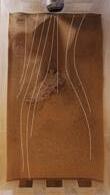
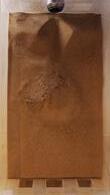
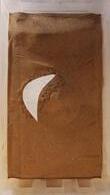
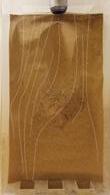

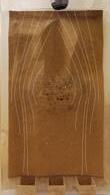
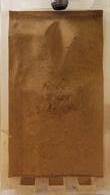
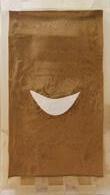
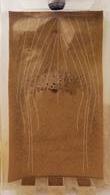
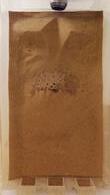
The aim of the experiment was to evaluate the effect of various angle configurations of the structure on dune on the diversion of sand particles using a sand physical model. Four different angle settings were tested in conjunction with three collection boxes and a pre-determined weight of sand. The results of this study will provide insights into the effectiveness of the structure in redirecting sand flow.

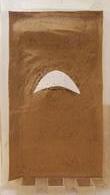
Iteration 1-1
Time: 2mins
Layers: 1
InitialDune: 2000g
WindType: FixedPoint
SandCollecting: 38% / 29%/ 33%
Iteration 1-2
Time: 2mins
Layers: 1
InitialDune: 2000g
WindType: FixedPoint
SandCollecting: 38% / 29%/ 33%
Iteration 1-3
Time: 2mins
Layers: 1
InitialDune: 2000g
WindType: FixedPoint
SandCollecting: 44% / 29%/ 27%
Iteration 1-4
Time: 2mins
Layers: 1
InitialDune: 2000g
WindType: FixedPoint







SandCollecting: 31% / 30%/ 39%
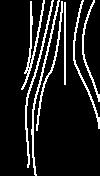
AEOLIAN | STRATEGY | 184 |
SAND BLOWING EXPERIMENTS
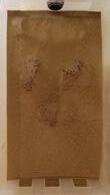
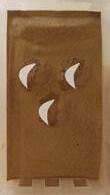

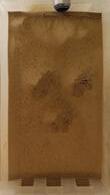
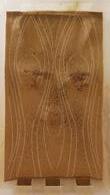
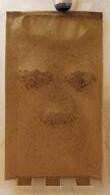
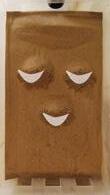
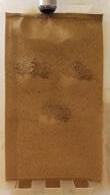
The experimental results indicate that when the structure is oriented towards the front of the dune, the majority of sand particles will pass over the structure. However, when the structure is placed at the rear of the dune, it is more effective in redirecting sand flow. Furthermore, when the structure is angled diagonally towards the dune, a higher percentage of sand particles will be directed towards the corner.

Iteration 2-1
Time: 2mins
Layers: 1
InitialDune: 2000g
WindType: Sliding
SandCollecting: 36% / 34%/ 30%
Iteration 2-2
Time: 2mins
Layers: 1
InitialDune: 2000g
WindType: Sliding
SandCollecting: 38% / 30%/ 32%
Iteration 2-3
Time: 2mins
Layers: 1
InitialDune: 2000g
WindType: Sliding
SandCollecting: 42% / 30%/ 28%
Iteration 2-4

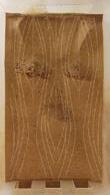
Time: 2mins
Layers: 1
InitialDune: 2000g





WindType: Sliding


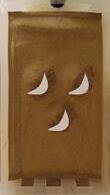
SandCollecting: 38% / 31%/ 31%

AEOLIAN | STRATEGY | 185 |
Iteration 1
SAND BLOWING EXPERIMENTS

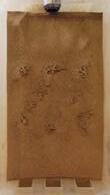
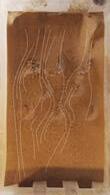
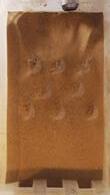
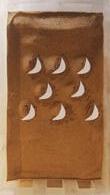
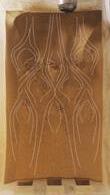
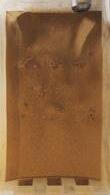


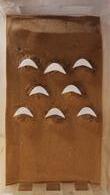
Iteration 3-1
Time: 4mins
Layers: 2
InitialDune: 4000g
WindType: Sliding
SandCollecting: 37% / 32%/ 31%
Iteration 3-2
Time: 4mins
Layers: 2
InitialDune: 4000g
WindType: Sliding
SandCollecting: 38% / 32%/ 30%
Iteration 3-3

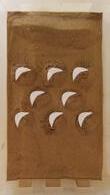
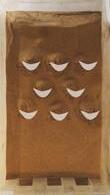
Time: 4mins
Layers: 2
InitialDune: 4000g
WindType: Sliding
SandCollecting: 40% / 32%/ 28%
Iteration 3-4
Time: 4mins
Layers: 2

InitialDune: 4000g

WindType: Sliding




SandCollecting: 38% / 33%/ 29%

AEOLIAN | STRATEGY | 186 |



AEOLIAN | STRATEGY

COLLECTIVE
AGENT BASED SYSTEM
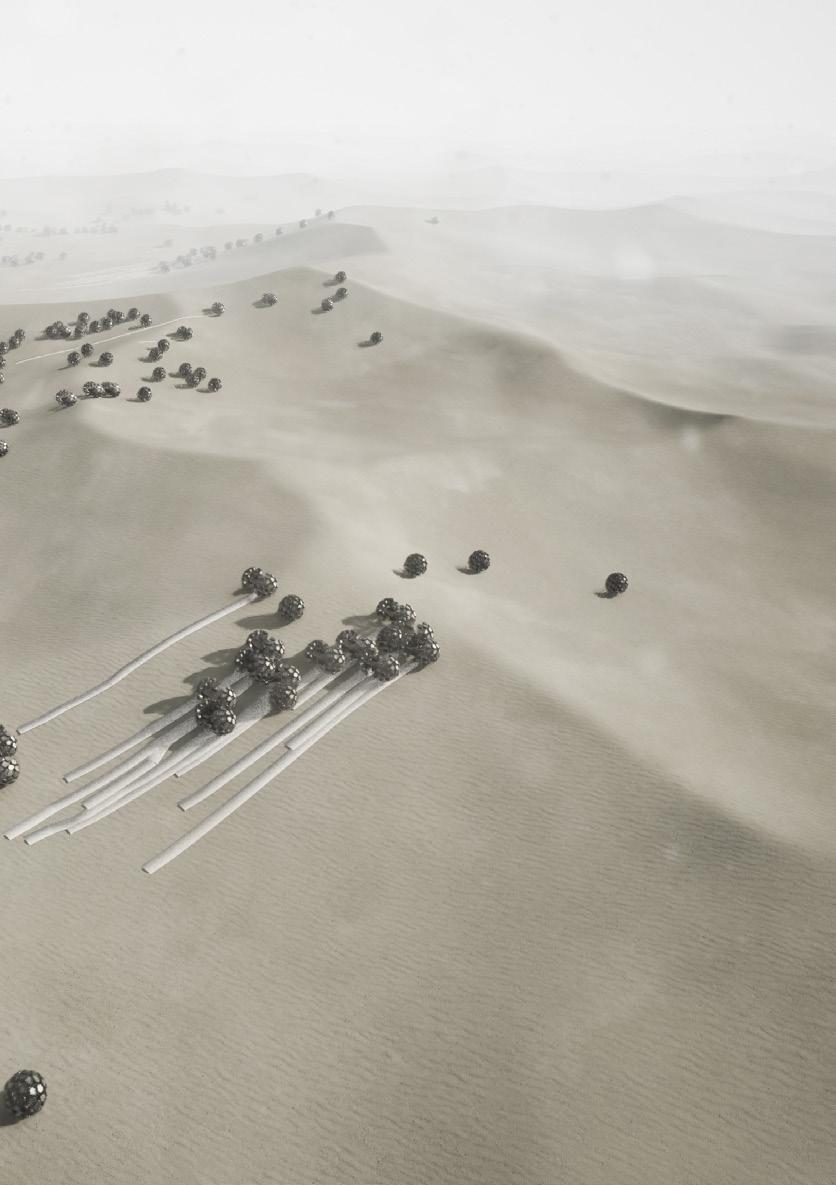
COLLECTIVE BEHAVIOUR
AGENT-BASED SYSTEM
The proposal looks at a high population of agents that can be deployed on-site and whose agency whose agency will be to replicate the physical experimentations of fusing sand and changing it’s material properties to that of glass. Several behaviours were explored to solve for various optimization challenges in the system.
Flocking
The self organization of agents flocking generates a collective motion rather than an individualistic motion. Allowing for a bottom-up emergent behaviour in the agent based system.
Stigmergy - Path Following
Certain aspects of stigmergic were taken to create a mechanism of co-ordination through the environment. This is enabled using the pheromone function, which gives agents the ability to read the generated structure. This is utilized for stray agent to find their way back by following the structure.
Path Finding - Shortest Path

The pathfinding algorithm was used to allow the agents to navigate through the dunes using the shortest of all possible paths to reduced the amount of energy used in traveling.

AEOLIAN | COLLECTIVE | 192 |
FLOCKING SELF-ORGANIZATION BEHAVIOURS
Agents utilize the boids algorithm to create a self-organizing, self-regulating, and emergent system. This allows the derivation of the structure to become a product of a bottomup generative approach.
Separation
Parameters include separation radius and separation force, the radius dictates an area for which this function will take action whilst the force applies a level of strength to how far must agents separate from one another if within the radius.

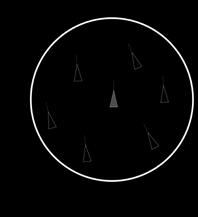

Alignment
The alignment function controls the steering behaviour of the overall herds or flocks and the neighbours. Parameters include alignment radius the radius dictates an area for which agents will be visible to one another to form an aligned group.
Cohesion
The cohesion function controls how agents come together to form a single flock or herd. Parameters include cohesion radius and cohesion force. The radius dictates an area for which this function will take action whilst the force applies a level of strength to how fast should agents steer and move towards each other.
AEOLIAN | COLLECTIVE | 193 |
PATHFOLLOWING
PHEROMONE TRAILS
The stigmergy behaviour aspects were employed on the next simulations. Agents will release pheromone trails along the path as traces in the landscape. These trails are for communication of the agents. Pheromone trails will attract other agents to track the path and continue in the direction as a group to fuse the material. The pheromone trails will vanish after time, defining the path that has already finished construction. This simulation is divided into two sections, low population and high population, to identify the shape, density, and speed of construction.
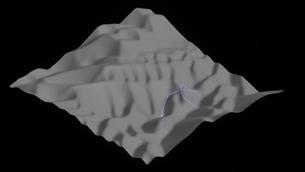

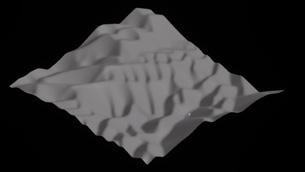
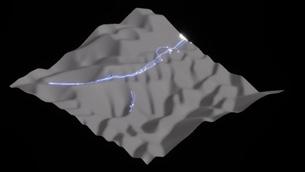
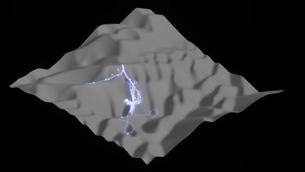
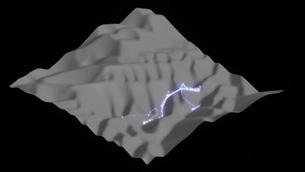
Low Population
Population: 1
Agents Speed: 20 Pheromones Time: 12
High Population
Population: 100
Agents Speed: 20
Pheromones Time: 14
AEOLIAN | COLLECTIVE | 194 | T2 T3 T4
T2 T3 T4
































AEOLIAN | COLLECTIVE | 195 | HIGH POPULATION LOW POPULATION Population: 200 Agents Speed: 20 Pheromones Time: 3 Population: 50 Agents Speed: 20 Pheromones Time: 2 Population: 10 Agents Speed: 20 Pheromones Time: 3 Population: 500 Agents Speed: 20 Pheromones Time: 2 Population: 200 Agents Speed: 20 Pheromones Time: 10 Population: 50 Agents Speed: 20 Pheromones Time: 6 Population: 12 Agents Speed: 20 Pheromones Time: 4 Population: 500 Agents Speed: 20 Pheromones Time: 12 T1 T1 T3 T3 T2 T2 T4 T4 T1 T1 T3 T3 T2 T2 T4 T4 T1 T1 T3 T3 T2 T2 T4 T4 T1 T1 T3 T3 T2 T2 T4 T4
PATHFINDING & SHORTEST PATH
DERIVING A NETWORK OF OPTIMAL PATHS & MOBILITY
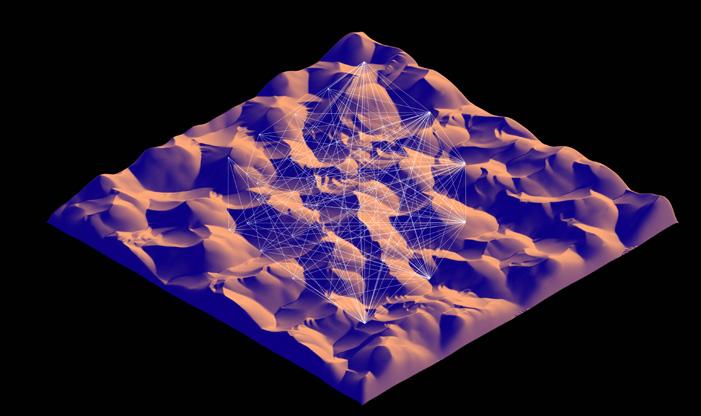
To generate an optimal network of paths for the robotic agents to move and fuse sand to glass in a process of constructing a barrier-like structure, a shortest path algorithm was developed due to its generative approach to build a network of possible pathways towards certain points in a terrain, calculating all possible path iterations until it problem solves the shortest possible path. To solve for the shortest path, the team devised a lexicographic order algorithm to pass through each point in the system. Lexicographic order is a mathematical generalization used for sorting items in a way that uses an algorithm based on alphabetical order. For example, a lexicographic order with 3 points would be the following :
3! = 6
4! = 24
5! = 120
6! = 720
7! = 5,040
8! = 40,320
9! = 362,880
10! = 3,628,800
11! = 39,916,800
12! = 479,001,600
13! = 6,227,020,800
14! = 87,178,291,200
However, this methodology proved to be too slow to calculate when there are 10 points or higher. This is due to the fact that each the number of permutations needed to be calculated is equals to the number of points factorial, therefore the higher the number of points, the longer the computation requirements. Especially since the computer program runs at around 50-100 per second. A number too small when it comes to 10 points or higher. The diagram on the right illustrates the number of permutations per number of points.
AEOLIAN | COLLECTIVE | 196 |
0 - 1 - 2 / 0 - 2 - 1 / 1 - 0 - 2 / 1 - 2 - 0 / 2 - 0 - 1 / 2 - 1 - 0
Therefore, to further optimize the computation, the team shifted from a lexicographical order towards a genetic algorithm or G.A. This process is inspired by the process of natural selection from evolutionary algorithms. How it works, is that the system randomly populates with possible connections between points. Each connection is then given a fitness score. The system with the highest fitness score continues on the evolution tree whilst those with lesser scores die out of the system. The shorter the path, the higher the fitness score.
STEP 1
Each frame, a random order would be generate to connect all the points. In the example below, 2 frames are generated in 0.001 seconds of computation. As there are 3! = 6, possible permutations. Therefore must be 6 frames overall to calculate all possibilities.



STEP 2



Calculate the fitness score by equalizing it with the distance travelled and then normalize it to create a score between zero and one.
STEP 3
Create a genetic pool where the best few permutations engage into what is called Crossover in evolutionary algorithms. The items, chosen to be part of a genetic pool are based on the fitness score, the higher the fitness score, the more likely they will be chosen to engage in a crossover. When two items crossover, 50% of both DNA in a pool or extracted and placed into a new item which is called a child. For optimization purposes, it is important to make sure that the DNA extracted from one item is different from the other.
AEOLIAN | COLLECTIVE | 197 |
ORDER FITNESS SCORE 0 - 1 - 2 0.33 ORDER FITNESS SCORE 2- 0 - 1 0.66 1st Permutation 2nd Permutation ORDER FITNESS SCORE 1- 2 - 0 1.00 Crossover & Best Result 1st Random Permutation 2nd Random Permutation Crossover & Best Result
COLLECTIVE BEHAVIOUR
CONSTRUCTING A HIGH POPULATION CYBERNETIC SYSTEM
The collective behaviour of these agents is defined by its mediums of communications with the landscape from a more global overview and understanding, towards a local bottom-up intelligence. A cybernetic system is generated as the process relies on an continuous dialogue between machine and the dynamic landscape, creating a nonlinear feedback loop between both entities. The following diagram represents the behaviours of these agents in relation and in dialogue with the desert terrain.
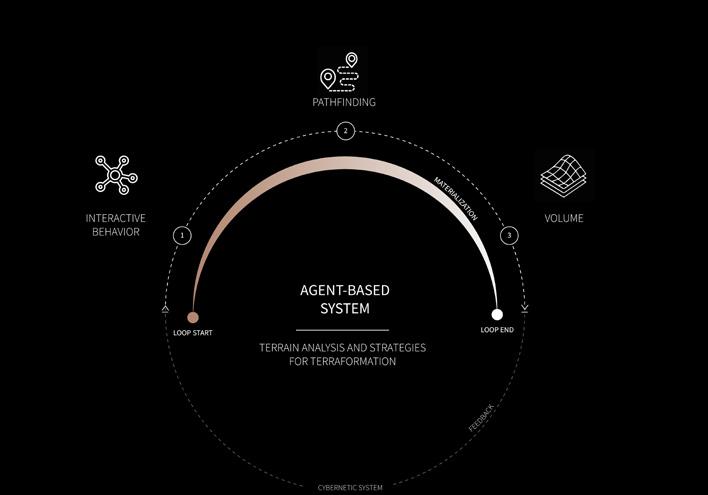
AEOLIAN | COLLECTIVE | 198 |
Each level of data sensing would be captured from different scales of observation. For macroscale sensing, global weather networking stations are utilized to generate data on natural phenomena such as temperature, lighting, and wind ...etc. To create strategies based on the dynamism of the terrain and its time-based states, satellite imaging becomes an essential tool to develop this understanding. Finally, on a more microscale sensing, the agents include data imaging components allowing them to read the conditions of their neighbouring agent and the fused glass.
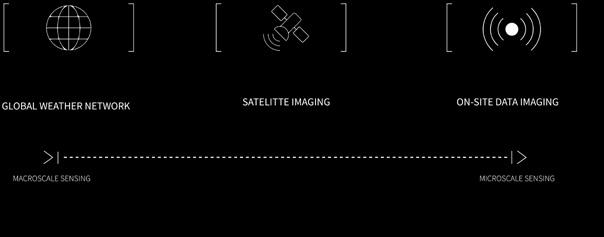
AEOLIAN | COLLECTIVE | 199 |
PATHFINDING GENERATIVE STRATEGIES FOR MOBILITY IN THE DESERT

The agents movement behaviour is produced generatively by producing flow fields with different datasets for different states. In this case, the agents have two separate states, the first, non-fusion mode is for when agents are not fusing sand to glass, therefore, they simply move from point to point using the simplest path possible between dunes. The second state, fusion mode is for when agents are fusing to glass, therefore, the agents attempt to move on the slopes of dunes, terraforming the landscapes.

AEOLIAN | COLLECTIVE | 200 |
NON-FUSING MODE - FLOW FIELD DATA
In non-fusion mode, the agents attempt to travel using the easiest path of traveling between the sloped terrain. In this case, they move on the lower parts of the landscape, between dunes.
FUSING MODE - FLOW FIELD DATA
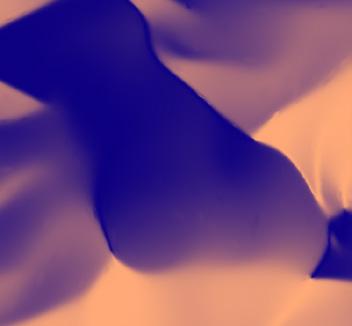
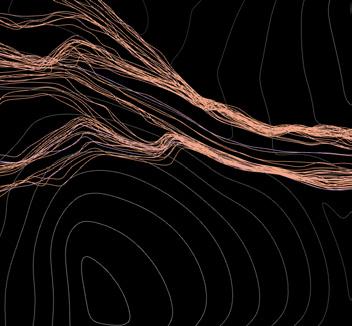

During fusion mode, the agents spread out and attempt to travel on the slopes of the dune in order to fuse a larger area of the slope together. Their path of travel is generated by vector-fields that flow along the back faces of the dunes.
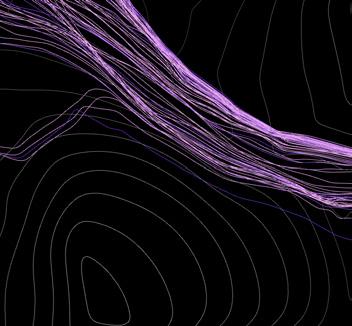
AEOLIAN | COLLECTIVE | 201 |
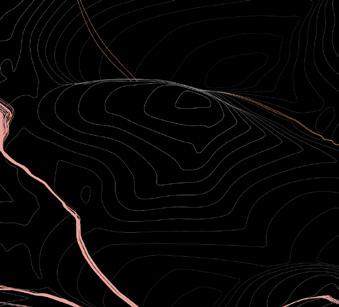

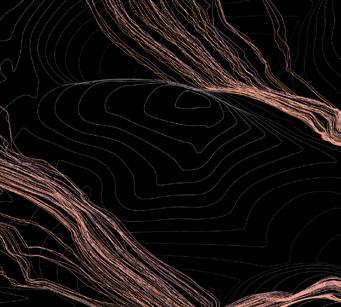
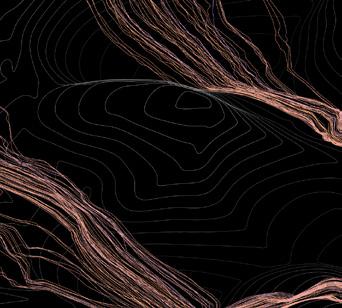
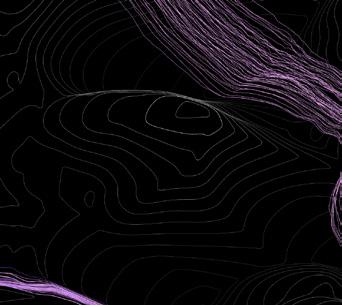
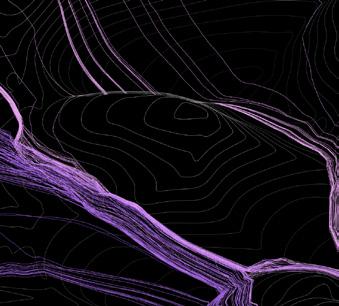
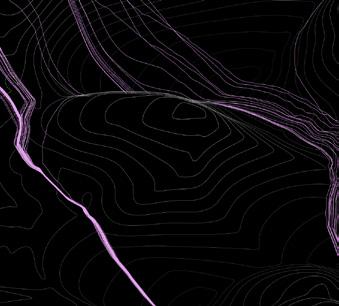
AEOLIAN | COLLECTIVE | 202 | NON-FUSION MODE COHESION 10 NON-FUSION MODE COHESION 10 NON-FUSION MODE COHESION 10 FUSION MODE COHESION 10 FUSION MODE COHESION 10 FUSION MODE COHESION 10
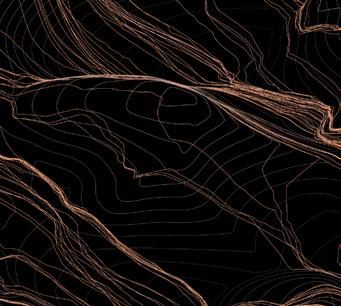
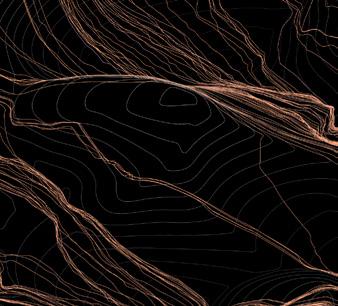
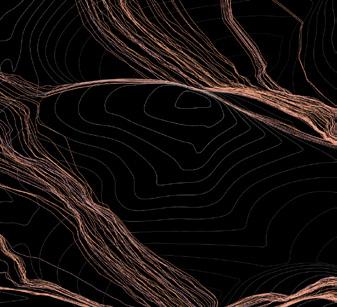

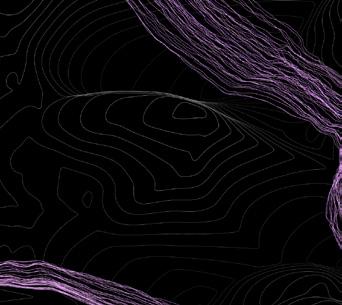

AEOLIAN | COLLECTIVE | 203 | NON-FUSION MODE SEPARATION 2 NON-FUSION MODE SEPARATION 4 NON-FUSION MODE SEPARATION 6 FUSION MODE COHESION 10 FUSION MODE COHESION 10 FUSION MODE COHESION 10
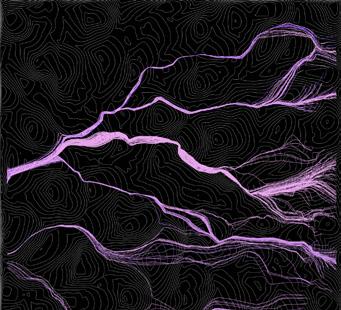
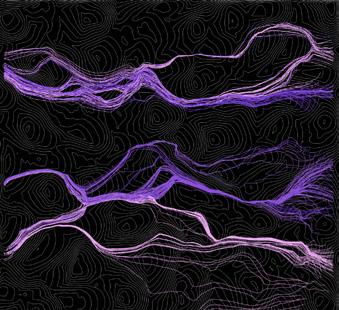
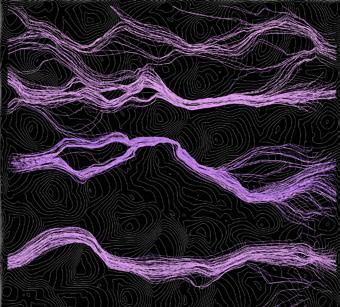

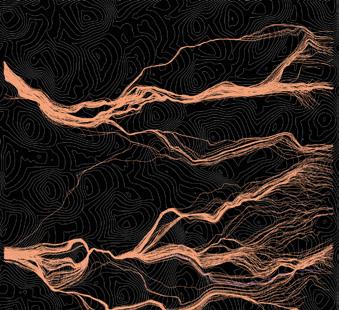
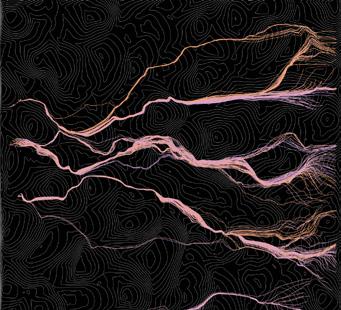
AEOLIAN | COLLECTIVE | 204 | NON-FUSION MODE COHESION 10 NON-FUSION MODE COHESION 10 NON-FUSION MODE COHESION 10 FUSION MODE COHESION 10 FUSION MODE COHESION 10 FUSION MODE COHESION 10
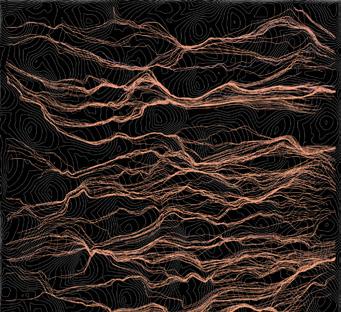
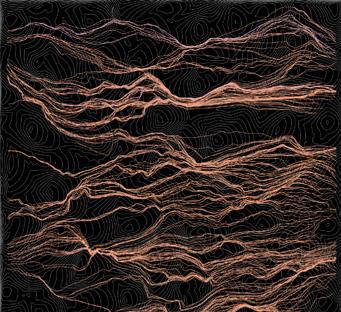
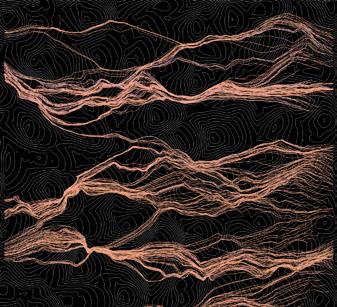
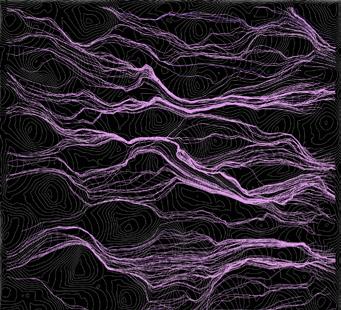

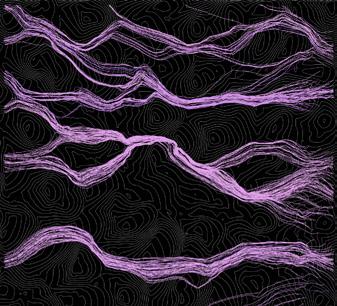
AEOLIAN | COLLECTIVE | 205 | NON-FUSION MODE SEPARATION 2 NON-FUSION MODE SEPARATION 4 NON-FUSION MODE SEPARATION 6 FUSION MODE COHESION 10 FUSION MODE COHESION 10 FUSION MODE COHESION 10
MOTION MODE VECTOR FIELD

FUSING MODE VECTOR FIELD
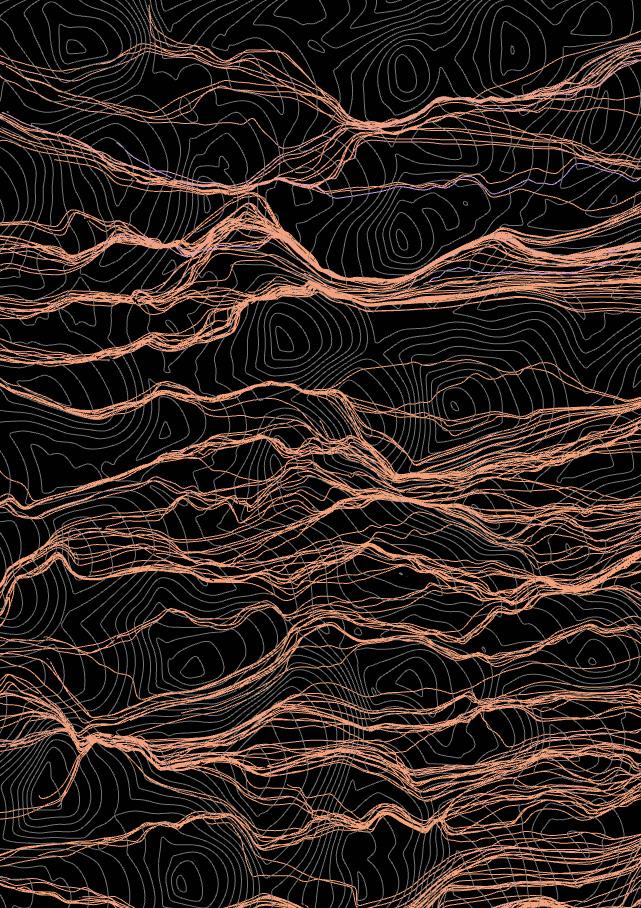
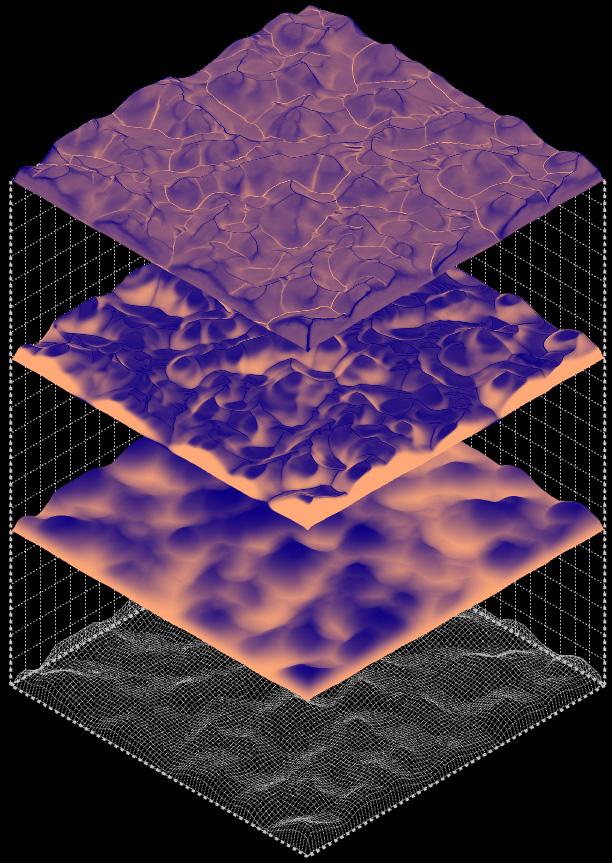
AEOLIAN | COLLECTIVE | 208 |
MAPPING LOCAL DATA MIN MAX
INTERACTIVE BEHAVIOR
The curvature of the landscape allows for the agent based system to interpolate on the relationship between the printed structure and terrain’s form.
The change in the angle of the slope allows for a differentiation between the dunes and their heights.
The height map influences the agent based system’s collective behaviour using cohesion forces as they travel higher and repulsion forces as they travel lower.
The terrain is analysed to gather key data points that will enable the agent-based system to make autonomous, real-time decisions. These values are translated into a colour map to provide a visualization of how the agents will perform in different areas. Orange areas have lower values and are characterized by stronger agent cohesion behaviour while blue areas have higher values and are characterized by stronger separation behaviour. This helps to optimize and improve the performance of the generated structure. For example, orange areas are denser than blue areas, providing a thicker, more rigid foundation to support the structure.
AEOLIAN | COLLECTIVE | 209 | HEIGHT MAP CURVATURE MAP SLOPE MAP
PARTICLE SYSTEM

AGENT HERD BEHAVIOUR
Density = Height + Curvature
To control how dense the agents couple with one another to form groups and clusters, the data received by layering the height map and the curvature map is utilized, creating a new map that builds a relationship between the agent’s vertical position and the curvature of the area they are traveling on.
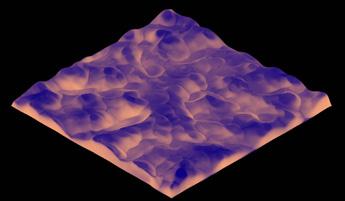

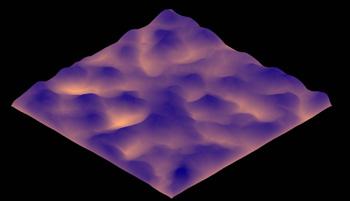
Thickness = Slope + Curvature
By layering the slope map and the curvature, the agents are able to decide the thickness of the structure that needs to be fused.
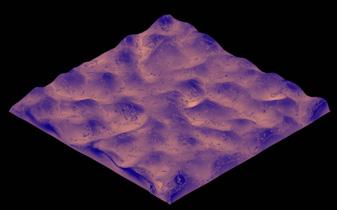

AEOLIAN | COLLECTIVE | 210 |
Height Slope Curvature Curvature Density Thickness
Particle Simulations Utilizing Individual Maps

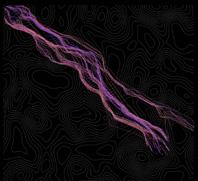


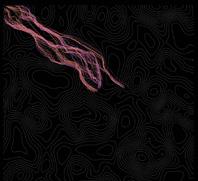
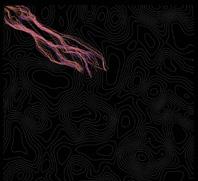
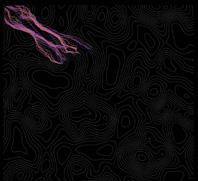

To generate an understanding of how each mapped data influences the agent-based system, the team conducted three simulations using the data from only one map. The frame-by-frame diagrams in this page and the following two pages illustrates these simulations. With the height map, the agents cohesion force decreases as they climb a dune and increases to form a single pack as they descend a dune. With the slope map, the agents are split into smaller groups as they intersect with opposing slopes. And lastly, with the curvature map, the form of the dune and its curvature influences the size and alignment of the herd.

I) Height Map
AEOLIAN | COLLECTIVE | 211 |
0:00:01 0:00:02 0:00:03 0:00:04 0:00:05 0:00:06 0:00:07 0:00:08 0:00:09
SWARM BEHAVIOUR

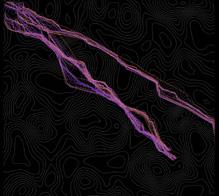
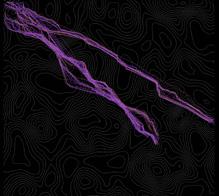
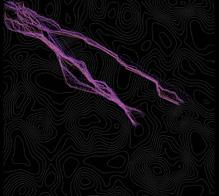
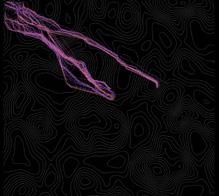


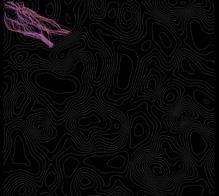
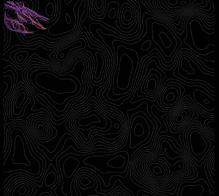
AEOLIAN | COLLECTIVE | 212 | II) Slope Map 0:00:01 0:00:02 0:00:03 0:00:04 0:00:05 0:00:06 0:00:07 0:00:08 0:00:09
BEHAVIOURS OF INDIVIDUAL DATASETS
III) Curvature Map

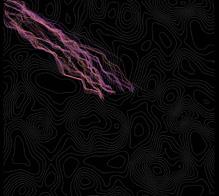
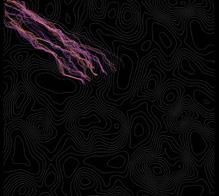
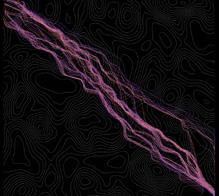

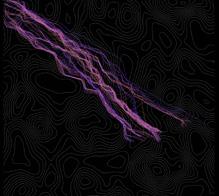

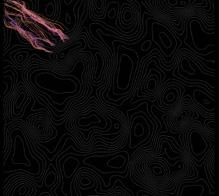

AEOLIAN | COLLECTIVE | 213 |
0:00:01 0:00:02 0:00:03 0:00:04 0:00:05 0:00:06 0:00:07 0:00:08 0:00:09
SWARM BEHAVIOUR COMBINING DATASETS
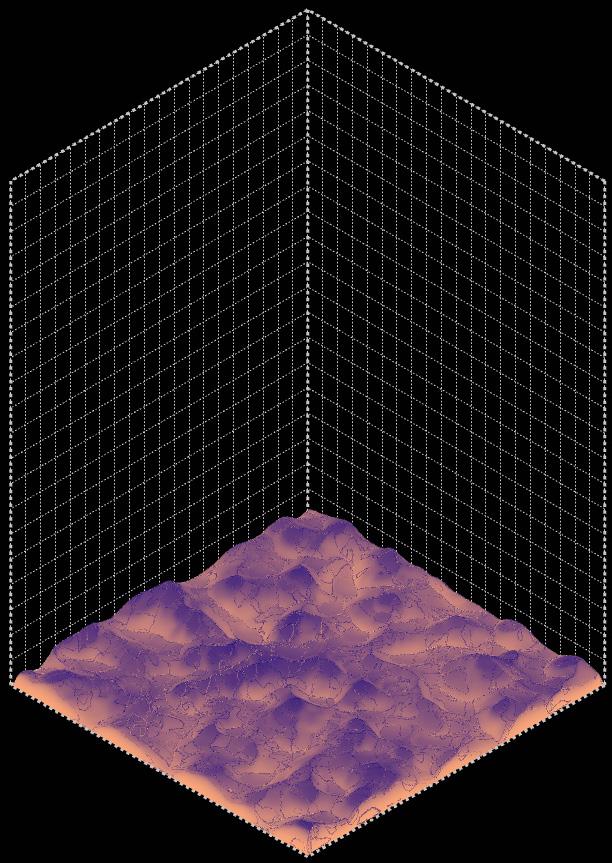
AEOLIAN | COLLECTIVE | 214 |
MIN MAX
Particle Simulations Utilizing the Combination of All Maps
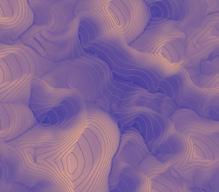





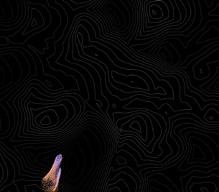
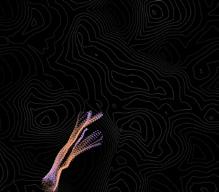
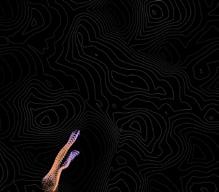
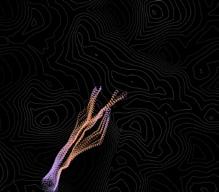
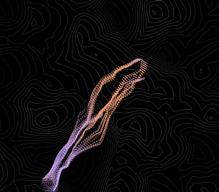
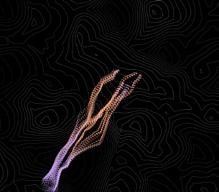



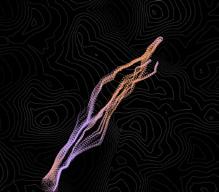
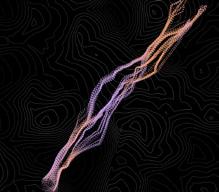
Finally, the combination of the height map, slope map, and curvature adjusts all parameters according to vital properties of dune landscapes. The frame-by-frame simulations illustrates how the agents respond to the landscape as they move across dunes.
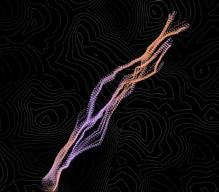
AEOLIAN | COLLECTIVE | 215 |
FRAME 20
FRAME 140
FRAME 40
FRAME 60
FRAME 80
FRAME 100
FRAME 120
FRAME 160
FRAME 180
TIME ASPECT
MORPHOLOGY GENERATION AND THE DURATION OF THE GENERATION PROCESS
Terraforming the environment requires careful consideration of time, as the landscape is constantly changing due to the movement of sand particles and the formation of new dunes. For example, star-shaped dunes can migrate up to 100m per year. In order to accurately simulate this dynamic process, the following simulations utilize a swarm of agents to terraform a distance of 1km (500m forward and 500m backward) over a period of 25 days. As time passes, it becomes clear how the particle behaviour begins to change. The analysis of the terrain highlights this, showing the formation of new dunes as they interact with the generated morphology. This creates a machine ecology where a cybernetic relationship exists between the agent population and the desert.



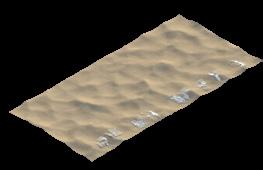
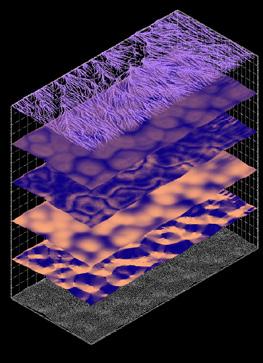
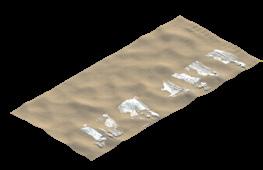
AEOLIAN | COLLECTIVE Iteration - 2 DAY 0 DAY 5 DAY 10 DAY 15 DAY 20 DAY 25 Iteration - 1 DAY 0 DAY 5 DAY 10 DAY 15 DAY 20 DAY 25
- 6

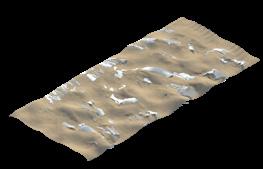
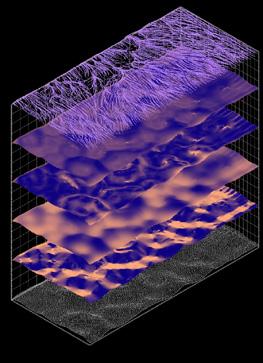
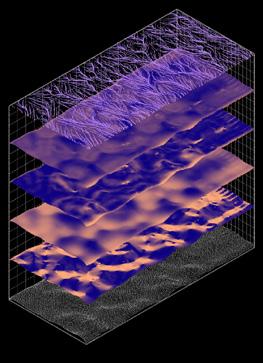
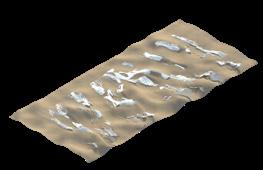
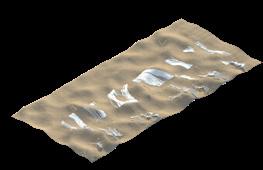

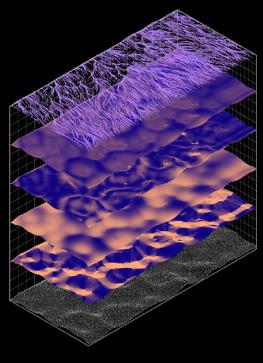
AEOLIAN | COLLECTIVE | 218 | Iteration -
DAY 0 DAY 5 DAY 10 DAY 15 DAY 20 DAY 25 Iteration - 3 DAY 0 DAY 5 DAY 10 DAY 15 DAY 20 DAY 25
Iteration -
DAY 0 DAY 5 DAY 10 DAY 15 DAY 20 DAY 25 DAY 0 DAY 5 DAY 10 DAY 15 DAY 20 DAY 25
4
Iteration
5
9
Iteration - 10

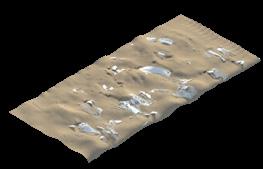



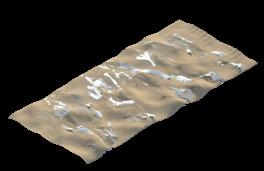

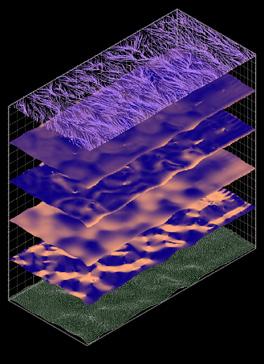
AEOLIAN | COLLECTIVE | 219 | Iteration
DAY 0 DAY 5 DAY 10 DAY 15 DAY 20 DAY 25 Iteration -
DAY 0 DAY 5 DAY 10 DAY 15 DAY 20 DAY 25
DAY 0 DAY 5 DAY 10 DAY 15 DAY 20 DAY 25 DAY 0 DAY 5 DAY 10 DAY 15 DAY 20 DAY 25
- 8
7
Iteration -
MORPHOLOGY AGENT FLOCKING BEHAVIOUR
Implementation
The system used a range of behaviours in order to construct the structure for deflecting sand particles. This included a global overview, in which the system examined the area to be surrounded by the structure and created a boundary from it; an intermediary overview, in which it used data on the dynamic properties of the landscape; and a local overview, in which the agents responded to analyses of the physical state of the dunes, such as their height, curvature, and slope. These studies were then layered to develop strategies for the density and thickness of the structure. The frame-by-frame diagrams below show how particles are responding to the implemented strategies in real-time.
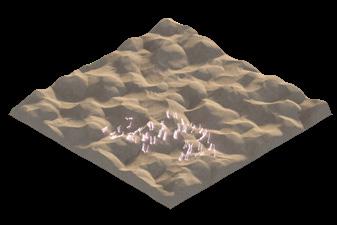
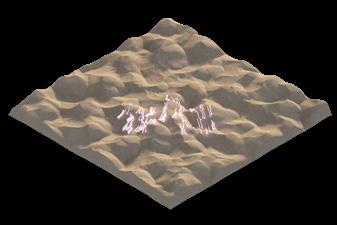
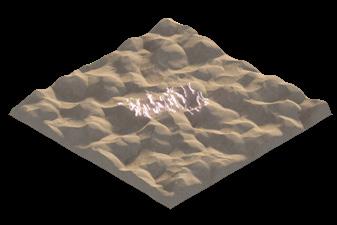
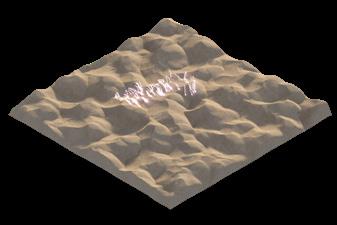
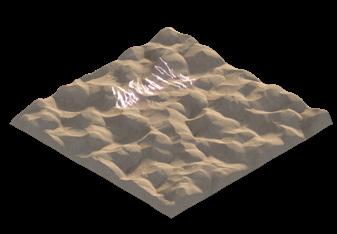
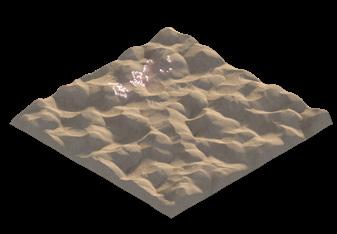
AEOLIAN | COLLECTIVE | 220 |
Frame 0
Frame 20
Frame 40
Frame 60
Frame 80
Frame 100
Path Travelled
Paths Fused
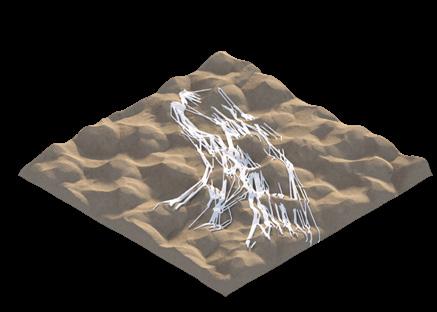
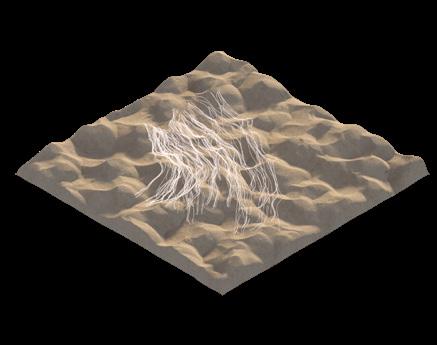
Fused Fused structure

AEOLIAN | COLLECTIVE | 221 |
PRE SAND PILING
FIRST ITERATION
PARTICLE SIMULATION - 01


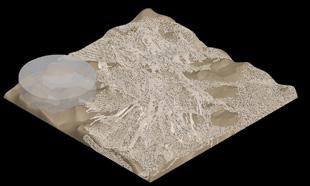
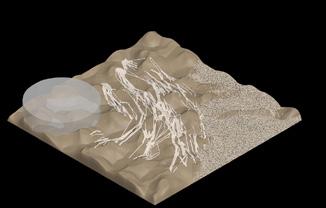
PARTICLE SIMULATION - 02
PARTICLE SIMULATION - 03
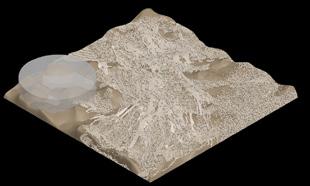
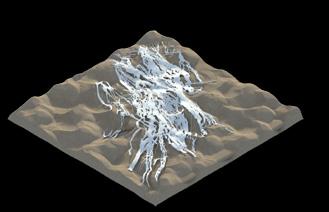
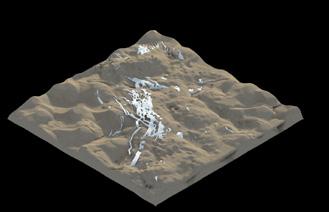
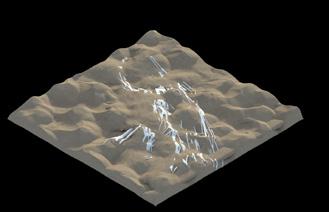
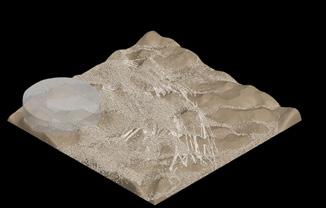
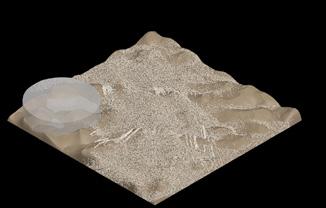
SECOND ITERATION
POST SAND PILING
AEOLIAN | COLLECTIVE | 222 |

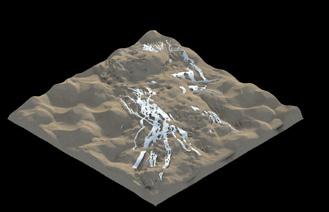
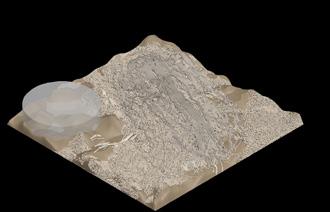
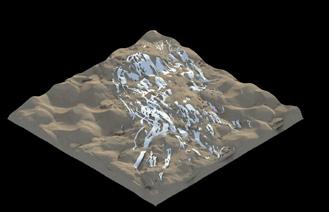
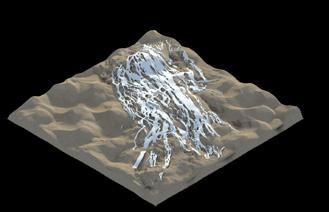
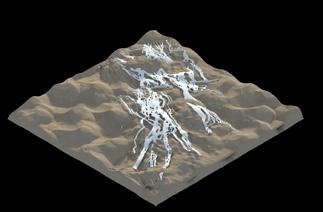


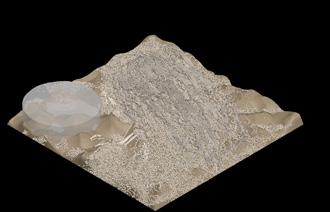

AEOLIAN | COLLECTIVE | 223 | THIRD ITERATION FOURTH ITERATION
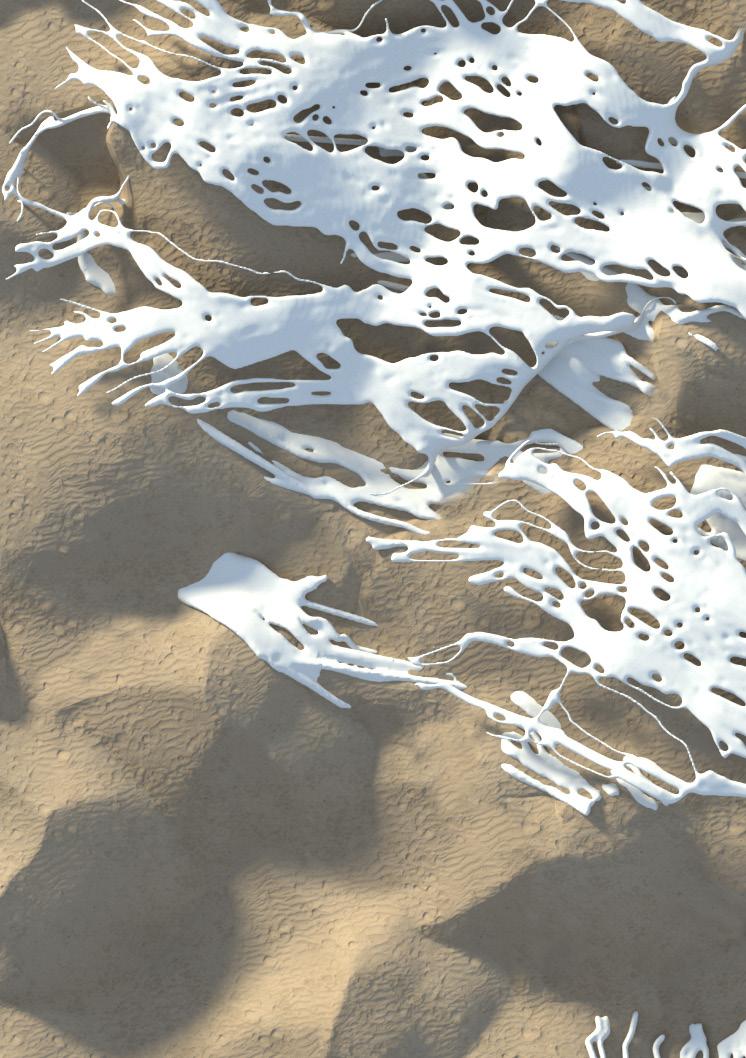

MORPHOLOGY AGENT FLOCKING BEHAVIOUR
Results
During each iteration, the agent-based system undergoes a cybernetic process in which the landscape is analysed at three different levels (global, intermediary, and local). Based on this analysis, the agents use cohesion and repulsion values that are influenced by mapped data to make decisions about where to deposit sand and where not to. The resulting structure is then tested by subjecting it to sand particles over time. If the structure is not able to fully repel the sand particles, the process is repeated until it is able to do so.
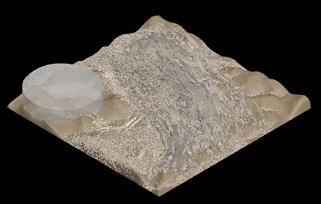

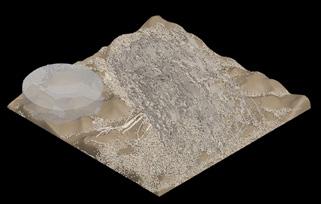
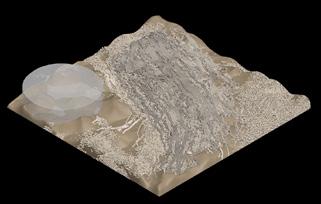
The simulations presented in the previous pages illustrate this cybernetic process as iteration after iteration the overall system reacts to changes in the environment. The structure gets larger and multilayered after the simulations are repeated. The more iterations are conducted, the more efficient the structure becomes in re-directing sand particles away from the designated site, creating a proof-ofconcept for the hypothesis of this research.
PARTICLE SIMULATION - 01
PARTICLE SIMULATION - 02
PARTICLE SIMULATION - 03
PARTICLE SIMULATION - 04
AEOLIAN | COLLECTIVE | 226 |
PRE-SAND PILING
POST-SAND PILING
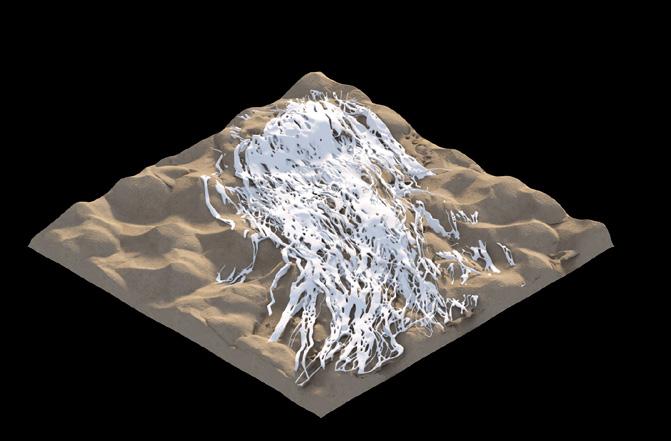
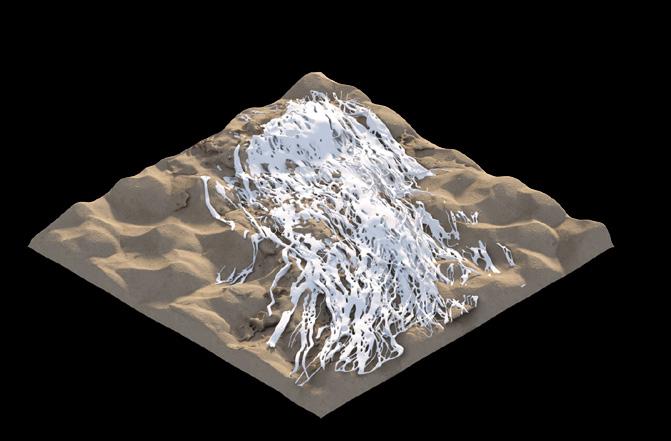
AEOLIAN | COLLECTIVE | 227 |


SAND ACCUMULATION
ITERATIONS + SITE SELECTION
Once agents fuse sand onto the existing landscape, the structures act as interactive obstacles. Rather than trapping, the morphology redirects sand particles away from areas at risk of wind erosion and desertification. In the first round of simulations, the terrain was covered with a single layer, and then four areas were selected for further study of sand accumulation behaviour.
As the number of layers increases over time, the complexity and performance of the structure improves. Our simulations simulate realistic desert behaviours allowing sand particles to interact with the structure’s morphology. This data is captured to evaluate the structure’s performance.

AEOLIAN | COLLECTIVE | 230 |
AREA 01 AREA 02 AREA 03 AREA 04
AREA 01 - LEANS WITH WIND



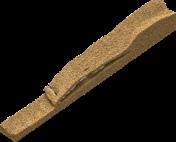
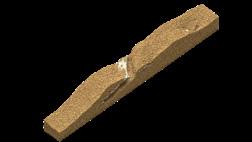

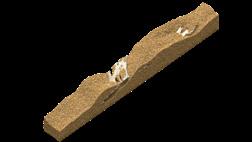

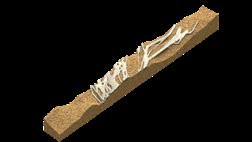



AEOLIAN | COLLECTIVE | 231 | 1st
ITERATION
LOW SPEED Wind Speed 16 KM / Hr Friction 3 Particle Population 420,000 T1 T2 T3 T1 T2 T3 T1 T2 T3 T1 T2 T3 HIGH SPEED Wind Speed 29 KM / Hr Friction 3 Particle Population 420,000
AREA 02 - MULTIPLE THREADS




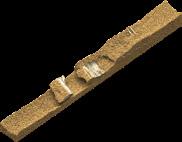
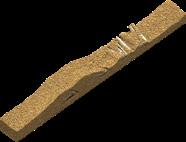


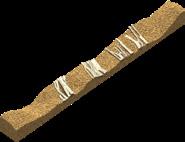


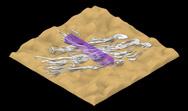
AEOLIAN | COLLECTIVE | 232 | 1st ITERATION
LOW SPEED Wind Speed 10 KM / Hr Friction 3 Particle Population 360,000 HIGH SPEED Wind Speed 31 KM / Hr Friction 3 Particle Population 360,000 T1 T2 T3 T1 T2 T3 T1 T2 T3 T1 T2 T3
AREA 03 - SURFACE PATTERN
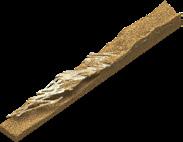
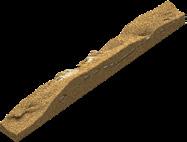

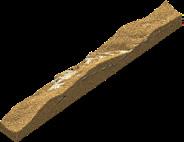

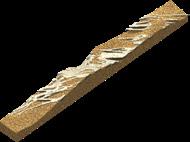

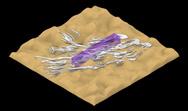
AEOLIAN | COLLECTIVE | 233 | 1st
ITERATION
LOW SPEED Wind Speed 14 KM / Hr Friction 8 Particle Population 400,000 HIGH SPEED Wind Speed 24 KM / Hr Friction 7 Particle Population 400,000 T1 T2 T3 T1 T2 T3 T1 T2 T3 T1 T2 T3
AREA 04 - LEAN AGAINST WIND DIRECTION








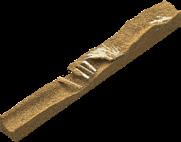


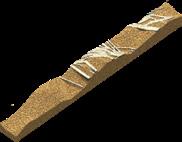

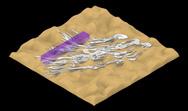
AEOLIAN | COLLECTIVE | 234 | 1st ITERATION
LOW SPEED Wind Speed 18 KM / Hr Friction 3 Particle Population 450,000 HIGH SPEED Wind Speed 27 KM / Hr Friction 3 Particle Population 450,000 T1 T2 T3 T1 T2 T3 T1 T2 T3 T1 T2 T3








AEOLIAN | COLLECTIVE | 235 |
ADDITION SUBTRACTION AREA 02 AREA 04 AREA 01 AREA 03 T1 T2 T3 T1 T2 T3 T1 T2 T3 T1 T2 T3
ITERATION 01 SAND ACCUMULATION ANALYSIS
ONE LAYER SECTIONAL PERFORMANCE

AEOLIAN | COLLECTIVE | 236 |




AEOLIAN | COLLECTIVE | 237 |
ITERATION 02 / 03 / 04
























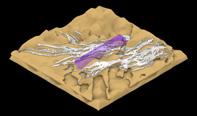

AEOLIAN | COLLECTIVE | 238 | 2nd ITERATION
AREA 03 LOW SPEED Wind Speed 14 KM / Hr Friction 2 Particle Population 660,000 AREA 03 HIGH SPEED Wind Speed 19 KM / Hr Friction 2 Particle Population 660,000 AREA 01 LOW SPEED Wind Speed 16 KM / Hr Friction 3 Particle Population 610,000 AREA 01 HIGH SPEED Wind Speed 21 KM / Hr Friction 3 Particle Population 610,000 T1 T2 T3 T1 T2 T3 T1 T2 T3 T1 T2 T3 T1 T2 T3 T1 T2 T3 T1 T2 T3 T1 T2 T3
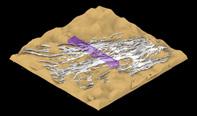
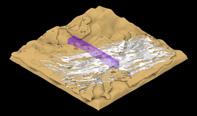
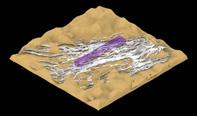
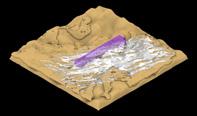
























AEOLIAN | COLLECTIVE | 239 |
3rd ITERATION 4th ITERATION AREA 01 Wind Speed 16 KM / Hr Friction 6 Particle Population 860,000 AREA 01
Wind Speed 13 KM / Hr Friction 4 Particle Population 770,000 AREA 03
Friction
Particle
T1 T2 T3 T1 T2 T3 T1 T2 T3 T1 T2 T3 T1 T2 T3 T1 T2 T3 T1 T2 T3 T1 T2 T3
Wind Speed 19 KM / Hr Friction 6 Particle Population 890,000 AREA 03 Wind Speed 14 KM / Hr
3
Population 750,000
AREA 01 ITERATION 05
In the fifth iteration, the structured network and sand accumulation are becoming more complex, leading to various effects of sand movement and space between the dunes and structures, with a higher number of particles.






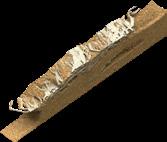

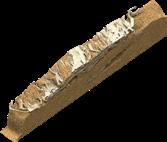



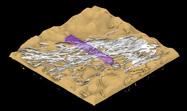
AEOLIAN | COLLECTIVE | 240 | 5th ITERATION
LOW SPEED Wind Speed 16 KM / Hr Friction 7 Particle Population 1,200,000 HIGH SPEED Wind Speed 20 KM / Hr Friction 7 Particle Population 1,200,000 T1 T2 T3 T1 T2 T3 T1 T2 T3 T1 T2 T3
This is the final iteration where the structure becomes more barriers to prevent sand from penetrating through the structure network.







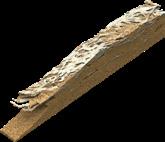
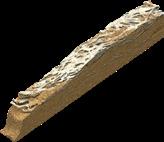

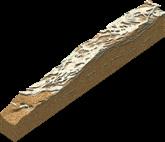
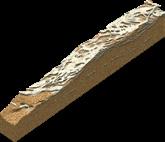

AEOLIAN | COLLECTIVE | 241 | LOW SPEED Wind Speed 18 KM / Hr Friction 6 Particle Population 1,120,000 HIGH SPEED Wind Speed 22 KM / Hr Friction 6 Particle Population 1,120,000 5th
AREA 02 T1 T2 T3 T1 T2 T3 T1 T2 T3 T1 T2 T3
ITERATION
The performance of the structure is influenced by two main factors: its length and the number of layers it has. In order to assess the structure’s ability to redirect sand particles away from a specific site (in this case, a circular object representing a city), the team conducted simulations in which sand was blown over three different morphologies with varying sizes: 300 meters, 600 meters, and 1,000 meters. During the first set of simulations, the 1,000-meter structure was most effective at redirecting sand, with only 0.08% of particles able to pass



AEOLIAN | COLLECTIVE | 242 |
through it. For the second round of simulations, an additional layer was added to the smaller structures, which were partially or completely buried at this point. As a result, both sizes performed much better than they had initially. The process was repeated for a third time, with the 300-meter structure performing as well as the 1,000-meter structure in the final simulation.



AEOLIAN | COLLECTIVE | 243 |
AGENT TO TOPOGRAPHY RATIO
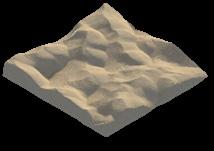
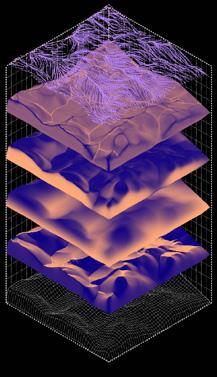

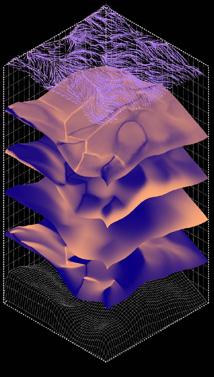

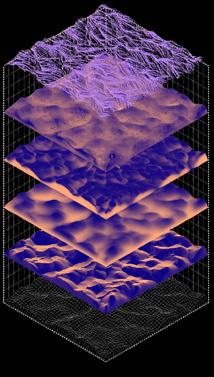
PROPORTIONALITY BETWEEN POPULATION AND THE SITE
The density of the morphology is determined by the number of agents in the population. A larger population results in a denser structure, which can be more effective in a shorter amount of time. An important part of the research was to determine the optimal number of agents to use in order to create the most effective structure with the least number of agents. To do this, the team conducted simulations with two main variables: the number of agents and the size of the terrain.
AEOLIAN | COLLECTIVE | 244 |
Dune Size Area 500m x 500m 250,000 sqm
Dune Size Area 250m x 250m 62,500 sqm Dune Size Area 250m x 500m 15,625 sqm Ratio Population Terrain Size Population Terrain Size 1 : 2 250 500m x 500m 500m x 500m Ratio Population Terrain Size Population Terrain Size 1 : 2 250 500m x 500m 500m x 500m Ratio Population Terrain Size Population Terrain Size 1 : 2 250 500m x 500m 500m x 500m MIN MAX MIN MAX MIN MAX

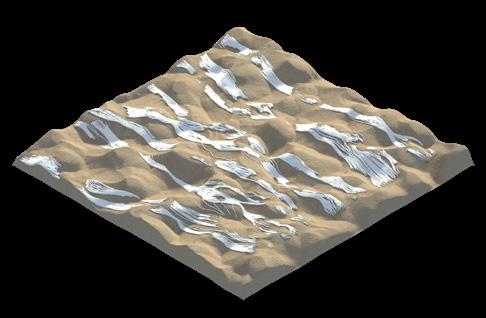

AEOLIAN | COLLECTIVE | 245 | Ratio Population Terrain Size 3 : 2 750 500m x 500m Ratio Population Terrain Size 1 : 1 500 500m x 500m Ratio Population Terrain Size 1 : 2 250 500m x 500m

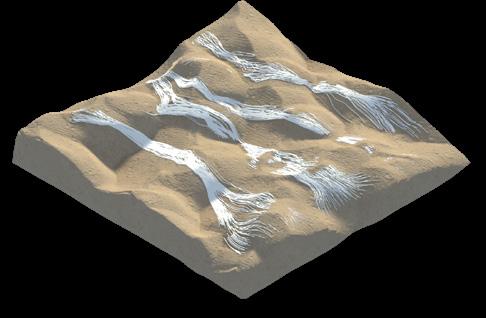
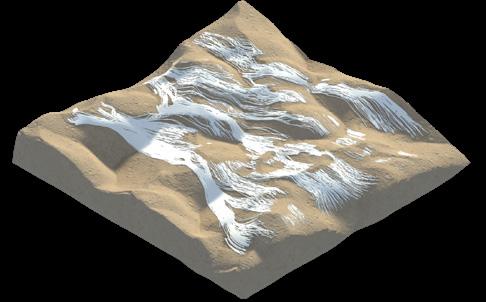
AEOLIAN | COLLECTIVE | 246 | Ratio Population Terrain Size 1 : 2 250 250m x 250m Ratio Population Terrain Size 1 : 1 500 250m x 250m Ratio Population Terrain Size 3 : 2 500 250m x 250m

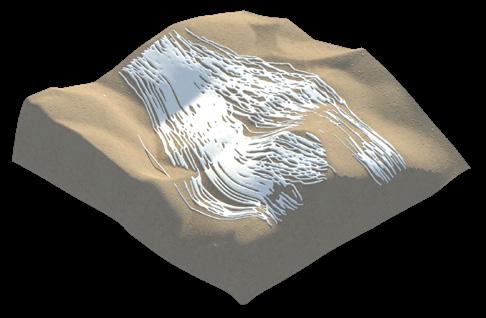
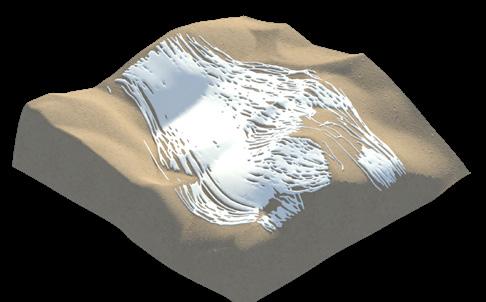
AEOLIAN | COLLECTIVE | 247 | Ratio Population Terrain Size 3 : 2 500 125m x 125m Ratio Population Terrain Size 1 : 1 250 125m x 125m Ratio Population Terrain Size 1 : 2 125 125m x 125m
LENGTH AND LAYERS PERFORMATIVITY TESTS
The performance of the structure is influenced by two main factors: its length and the number of layers it has. In order to assess the structure’s ability to redirect sand particles away from a specific site (in this case, a circular object representing a city), the team conducted simulations in which sand was blown over three different morphologies with varying sizes: 300 meters, 600 meters, and 1,000 meters. During the first set of simulations, the 1,000-meter structure was most effective at redirecting sand, with only 0.08% of particles able to pass through it. For the second round of simulations, an additional layer was added to the smaller structures, which were partially or completely buried at this point. As a result, both sizes performed much better than they had initially. The process was repeated for a third time, with the 300-meter structure performing as well as the 1,000-meter structure in the final simulation.
AEOLIAN | COLLECTIVE | 248 |
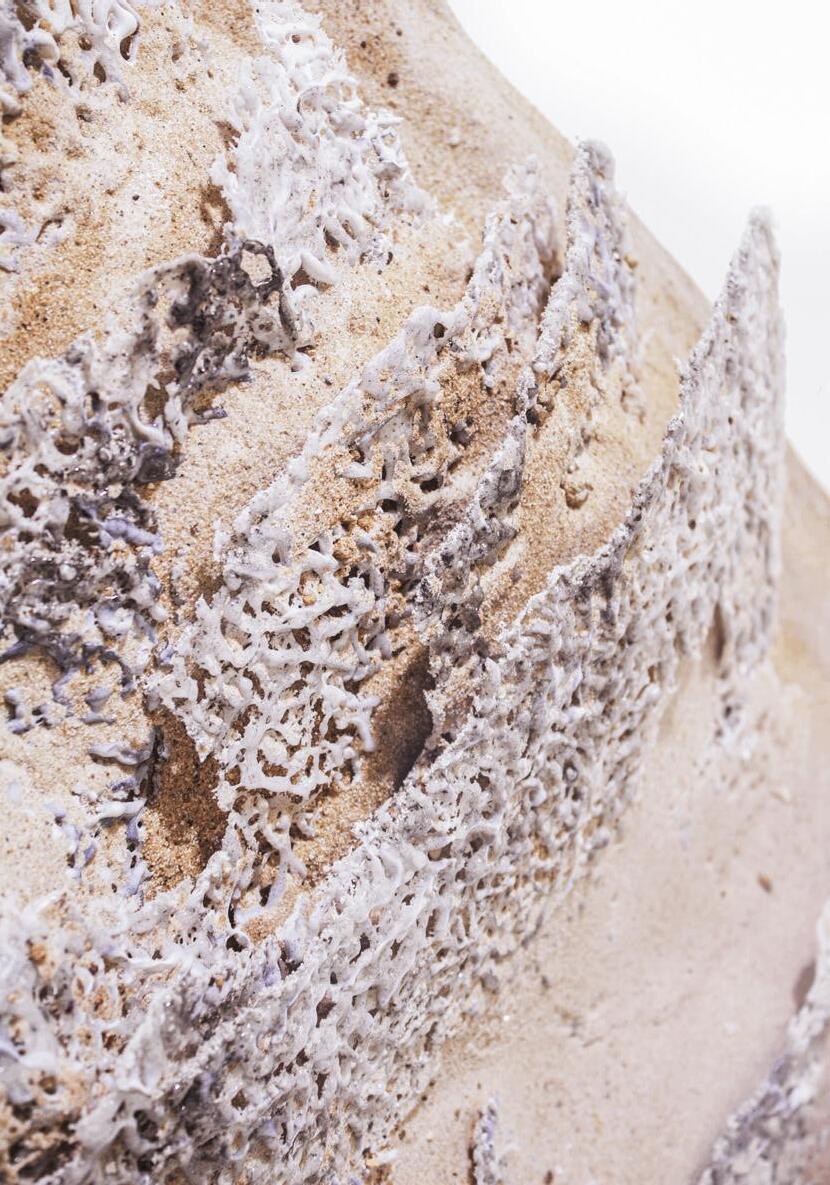
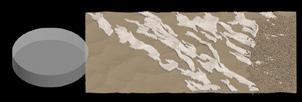
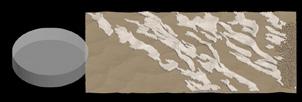
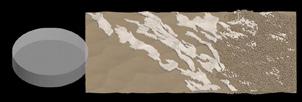
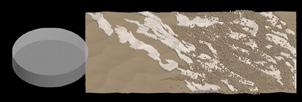
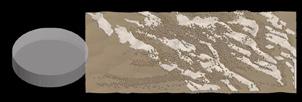

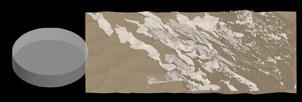
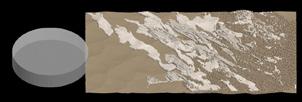
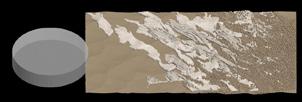
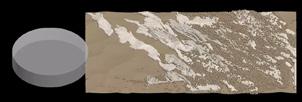
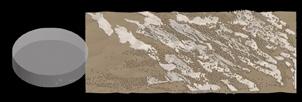
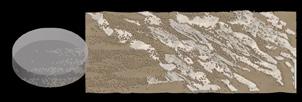
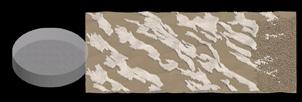


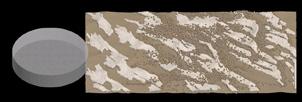
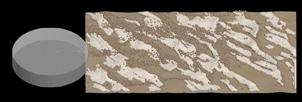
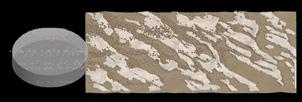
AEOLIAN | COLLECTIVE | 250 | Instance - 1 Instance - 2 Instance - 3 Instance - 4 Instance - 5 Instance - 6 Instance - 1 Instance - 2 Instance - 3 Instance - 4 Instance - 5 Instance - 6 Instance - 2 Instance - 4 Instance - 6 Instance - 1 Instance - 3 Instance - 5
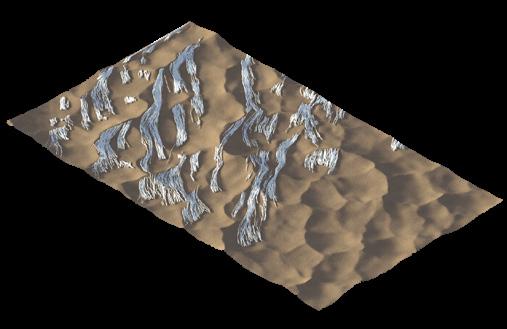
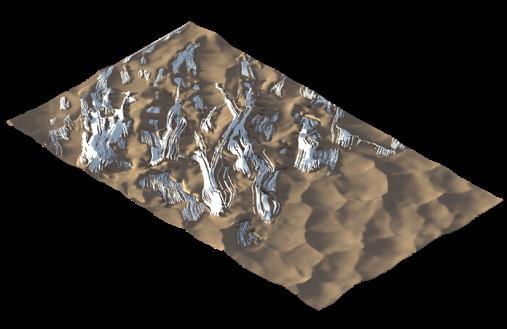

AEOLIAN | COLLECTIVE | 251 | 300m 1 4.2% 600m 2 0.08% Size Layers Penetration Size Layers Penetration 1000m 1 0.04% Size Layers Penetration


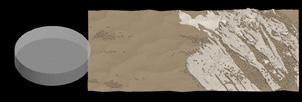
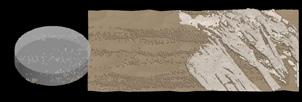
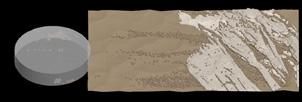
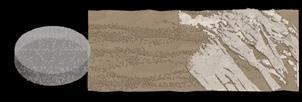
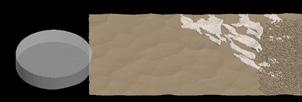
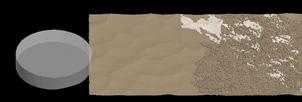
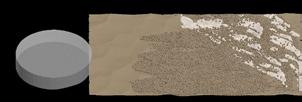


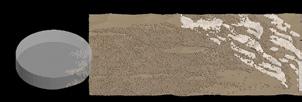
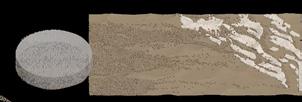





AEOLIAN | COLLECTIVE | 252 | Instance - 1 Instance - 2 Instance - 3 Instance - 4 Instance - 1 Instance - 2 Instance - 3 Instance - 4 Instance - 5 Instance - 6 Instance - 1 Instance - 2 Instance - 3 Instance - 4 Instance - 5 Instance - 6

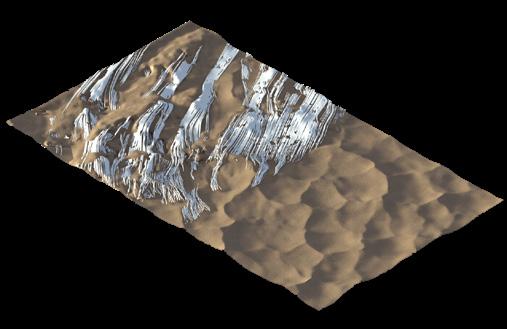
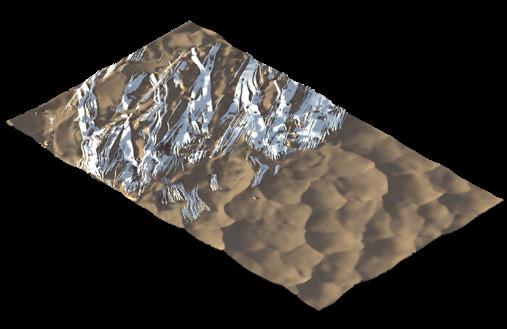
AEOLIAN | COLLECTIVE | 253 | 300m 1 7.9% 300m 2 3.2% Size Layers Penetration 300m 3 0.08% Size Layers Penetration Size Layers Penetration
PROOF OF CONCEPT
BRIDGING THE DIGITAL AND PHYSICAL ENVIRONMENTS
he project team aimed to integrate simulation into their research by creating a bridge between the digital and physical environments. To achieve this, they employed 3D scanners to capture the geometries of real-world dune typologies, which were created through manual manipulation of sand aggregations. This generated realworld data that could then be incorporated into a digital framework for simulation purposes allowing for further analysis and parametrization of the terrain, simulation the agent based system using a host of agents to self-organize in the real-world hand-crafted landscape. Creating a point map enables the creation of a 3D mesh model that closely resembles real-world terrain. Additionally, the dune’s texture can also be remapped, allowing for a more realistic digital environment by bridging the gap between the digital and physical worlds. Moving forward, the generated dune typology will be used to simulate and generate the sand-to-glass morphology.

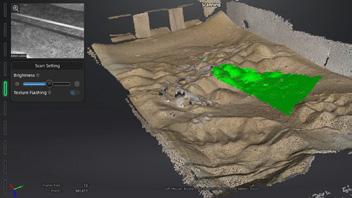
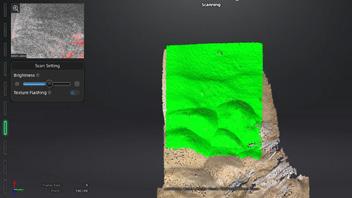
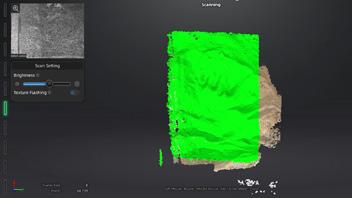
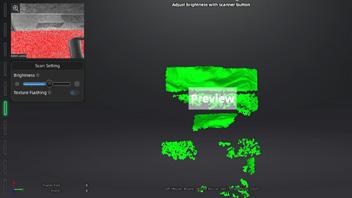
Scan Time Step 00:00:00
Scan Time Step 00:00:15
Scan Time Step 00:00:030
Scan Time Step 00:00:60
AEOLIAN | COLLECTIVE | 254 |
Hand-Crafted Dune Typology
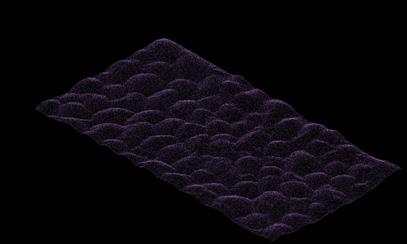
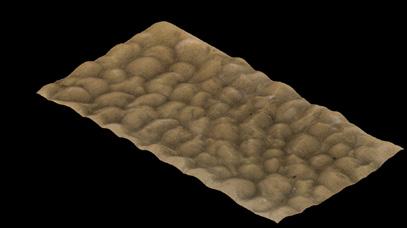
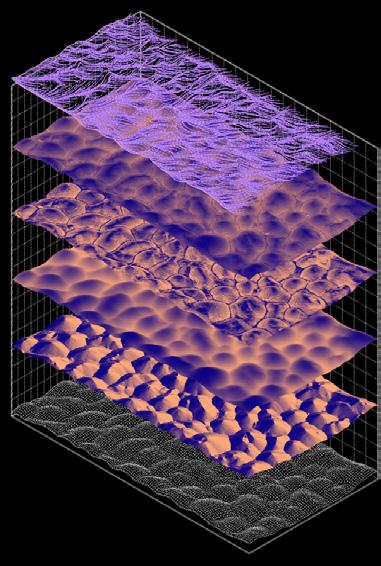
AEOLIAN | COLLECTIVE | 255 |
MAP
FIELD SLOPE MAP
MAP
MAP POINT CLOUD
TEXTURE
HEIGHT
FLOW
ORIENTATION
CURVATURE
SCANNED
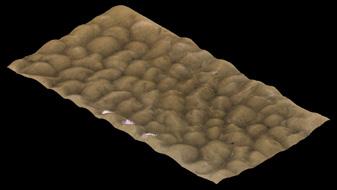
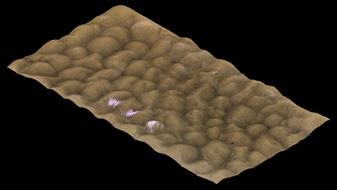

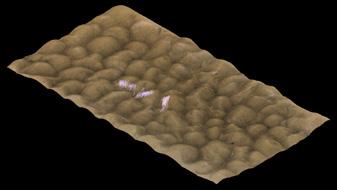


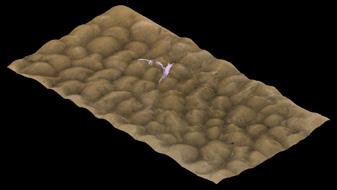

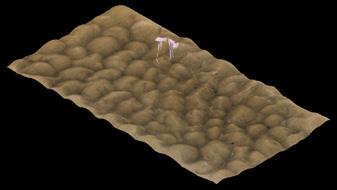
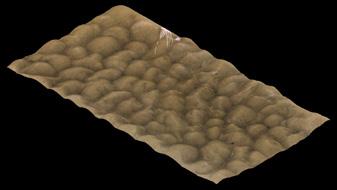
AEOLIAN | COLLECTIVE | 256 |
Frame 0
Frame 20
Frame 40
Frame 60
Frame 80
Frame 100
Frame 120
Frame 140
Frame 160
Frame 180
Once the structure is generated, a sand blowing experiment is conducted to test the performance terraformation of the landscape. Three different containers were attached to the back of the sand box to test the directionality of the sand particle flow.

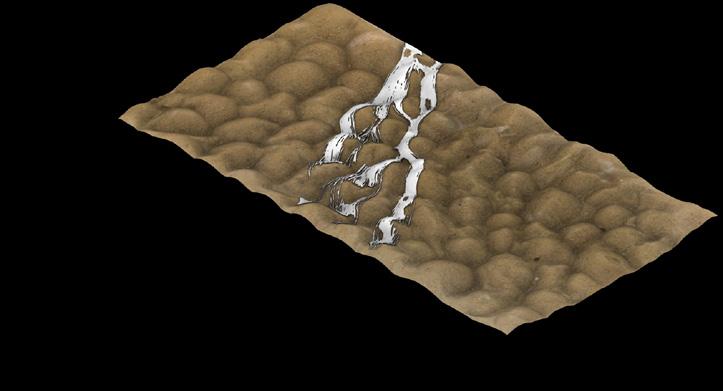

AEOLIAN | COLLECTIVE | 257 |
Before After Time Elapsed Iteration Layers 4 min 1st Iteration 1 Layer Redirection (Right) Redirection (Middle) Redirection (Left) 29.1% 32.7% 38.2%
2ND & 3RD ITERATIONS
Point Cloud
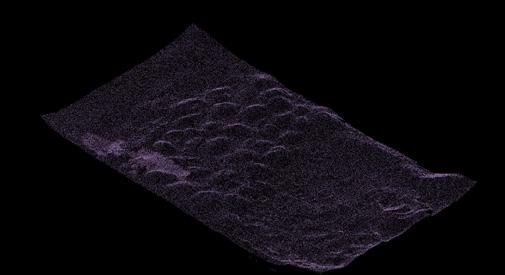
Scanned Texture Map
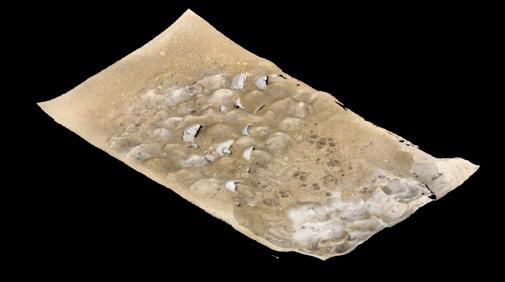
2nd Layer
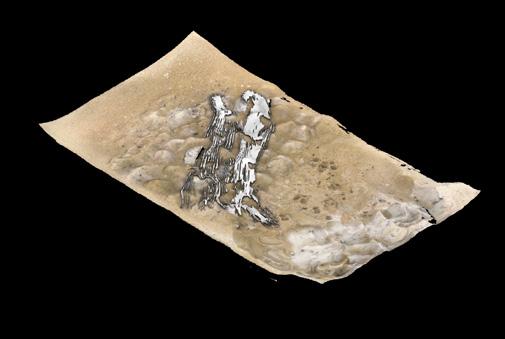
AEOLIAN | COLLECTIVE | 258 |
LAYERING
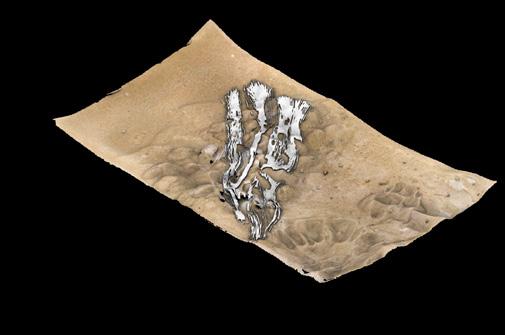
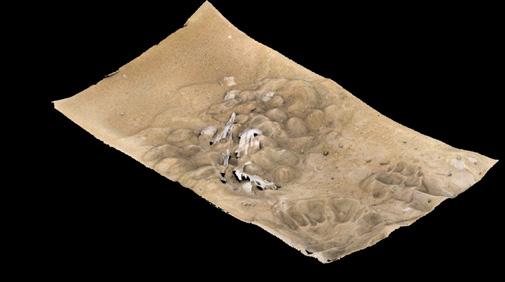

AEOLIAN | COLLECTIVE | 259 |
Point Cloud
Scanned Texture Map
3rd Layer
LAYERING FINAL RESULT
After three iterations of sand blowing, the generated morphology was able to redirect sand particles away from the area it surrounds. In addition, layering the structure after three iterations showed remarkable results in the experiments performance. Hence, proving the strategies deployed in the simulative environment successfully work when experimented in the real-world environment.
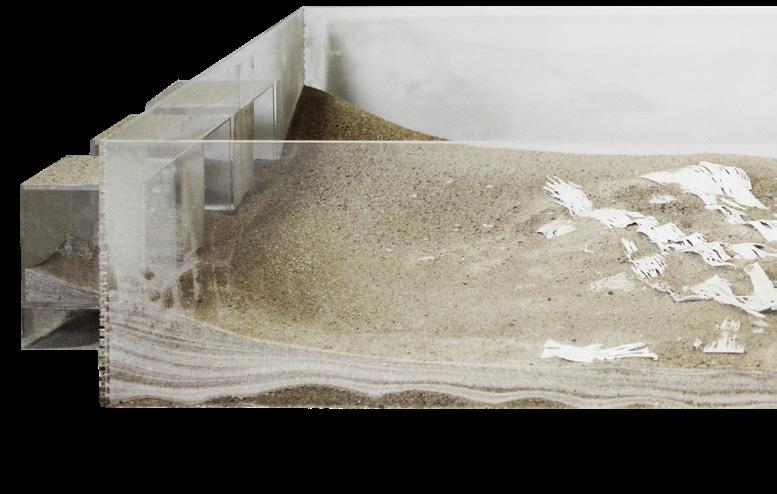
AEOLIAN | COLLECTIVE | 260 |
Time Elapsed Iteration Layers 4 min 3rd Iteration 3 Layer Redirection (Right) Redirection (Middle) Redirection (Left) 25.0% 29.7% 45.3%

AEOLIAN | COLLECTIVE | 261 |

SCENARIO STRATEGY
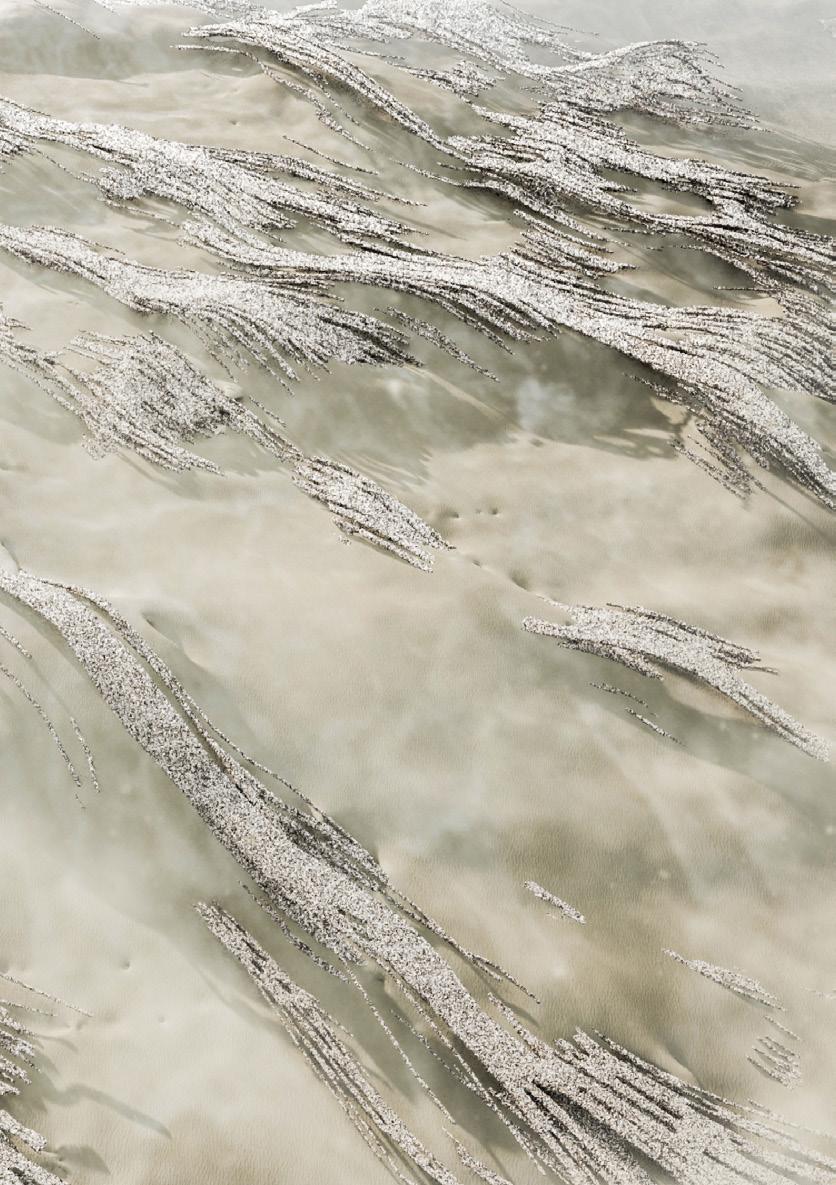

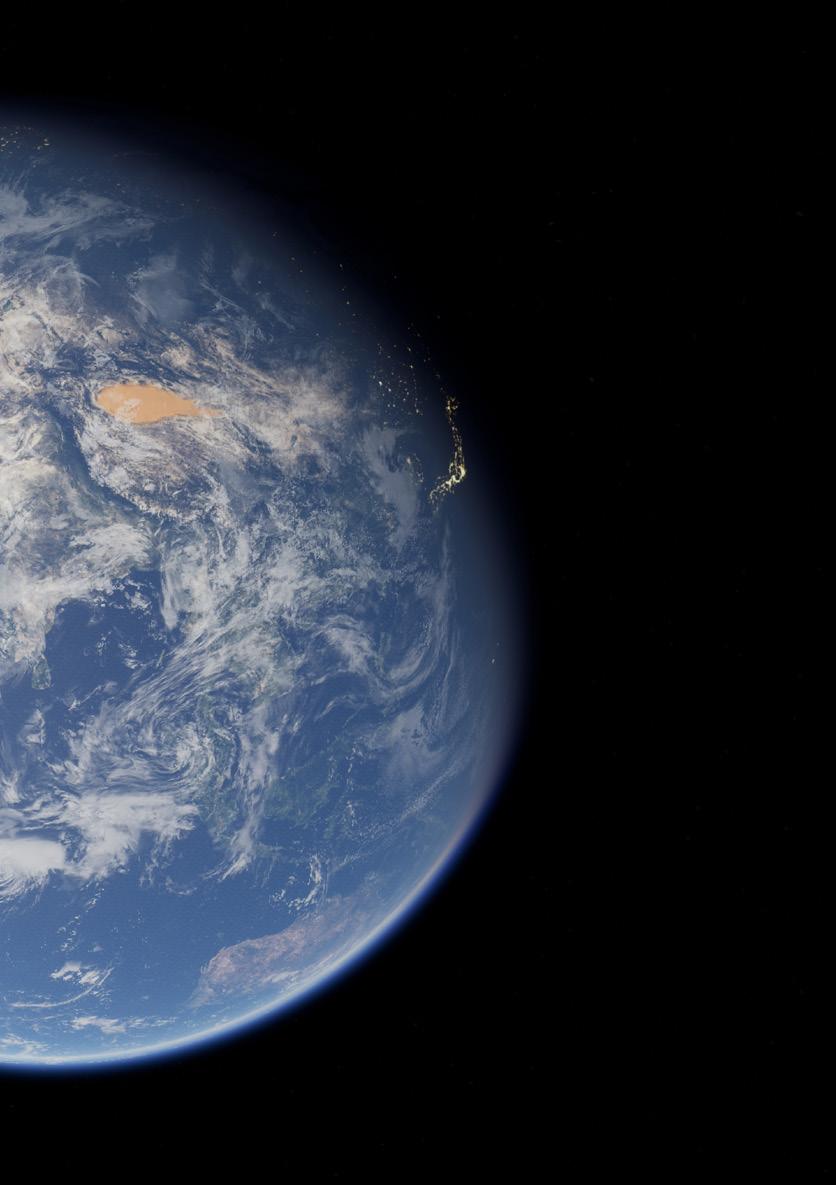
TAKLA MAKAN DESERT AREA = 337.000 KM2 380 54’ 0’’N, 820 12’ 0’’ E
HOTAN
AREA = 46.584 KM2
POPULATION = 409.894


SITE TAKLA MAKAN DESERT
In order to evaluate the effectiveness of the strategy and comprehend its behaviour on a large scale, a specific location was selected for implementation. The chosen site was the Takla Makan Desert in Asia, which encompasses 337,000 square kilometres and is characterized by sandy terrain. The desert is situated in close proximity to the large city of Hotan with population 409,894. The major wind blows toward the city expanding the desert and covering it with sand.
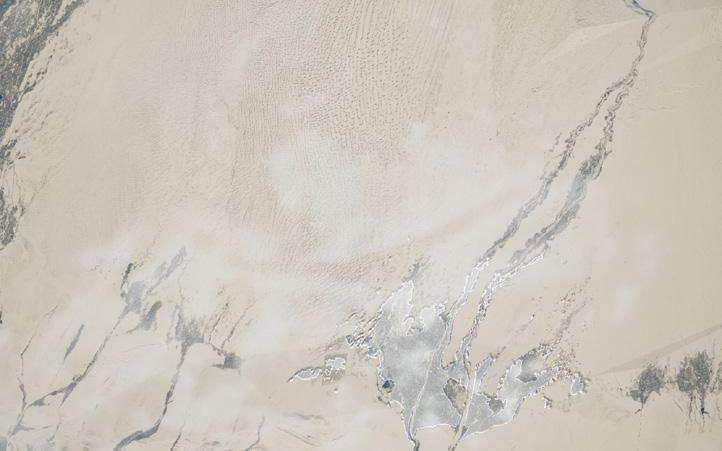
AEOLIAN | SCENARIO | 268 |
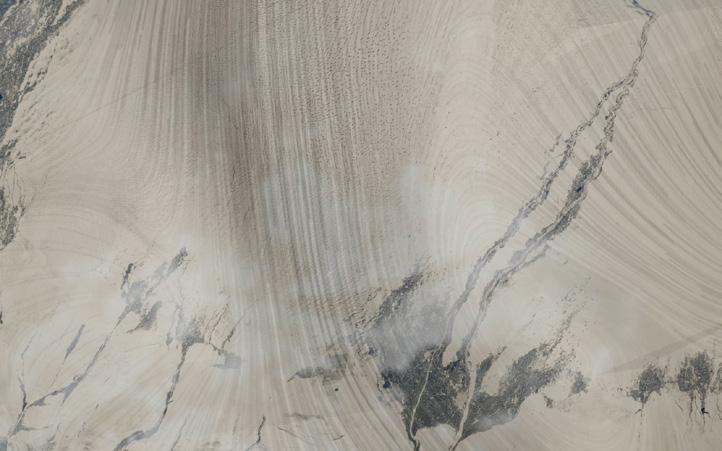
AEOLIAN | SCENARIO | 269 |
1KM2 - DEPLOYMENT TERRAFORMATION ON A 1KM2 LENSE
The focus was on the simulation environment on a 1km2 area of the 80km site, creating a machine ecology in which the agents used data from the landscape to strategize and self-organize. The simulations were repeated multiple times until the generated morphology was able to effectively redirect sand particles. Through this process, the agents were able to strategically fuse parts of the terrain and terraform the environment.
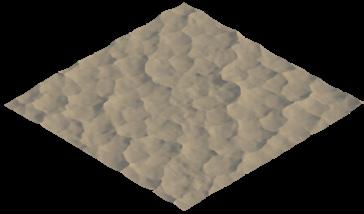
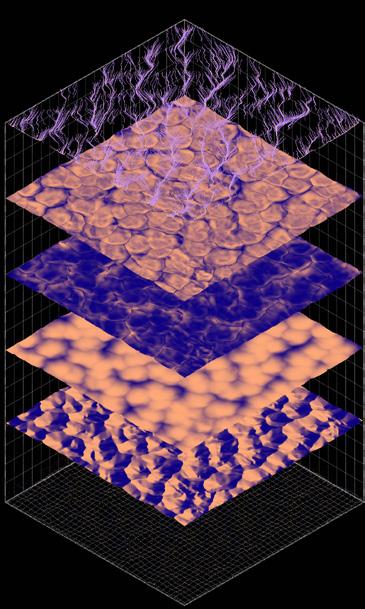
AEOLIAN | SCENARIO | 270 |
MIN MAX FLOW FIELD CURVATURE MAP SLOPE MAP HEIGHT MAP WIND ORIENTATION MAP
1km2 Terrain
Terrain Analysis
With each iteration, a simulation is run to visualize the flow of sand particles across a simulated landscape, highlighting the interaction of the sand with glass infrastructure. In the initial simulation, with no layers present, the sand particles move freely and are not redirected. As more layers are added to the structure, the sand particles are increasingly deflected to the left. The more layers that are incorporated into the structure, the more efficient it becomes at redirecting the flow of sand.
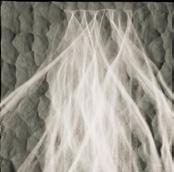

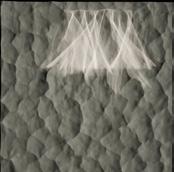
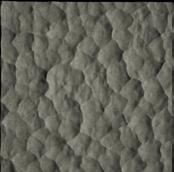



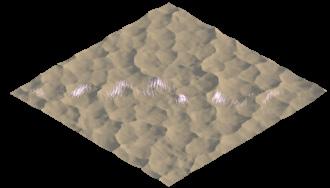
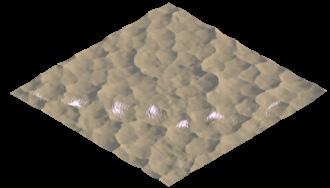

AEOLIAN | SCENARIO | 271 |
FRAME - 200
FRAME - 160
FRAME - 120
FRAME - 80
FRAME - 40
FRAME - 40
FRAME - 0
FRAME - 40
FRAME - 80
FRAME - 120
1ST LAYER TERRAFORMING DUNESCAPES

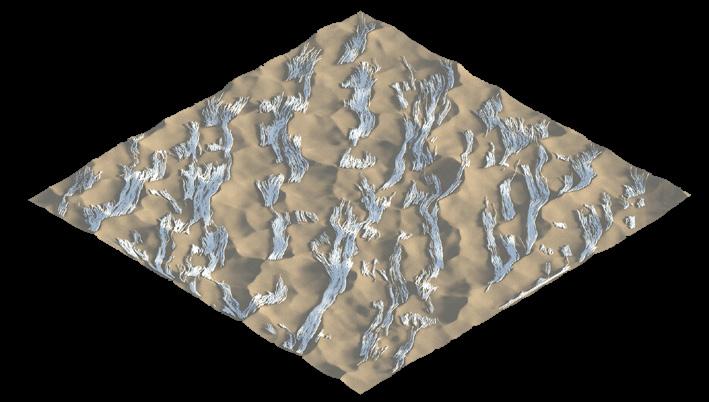
AEOLIAN | SCENARIO | 272 |
1 - LAYERS
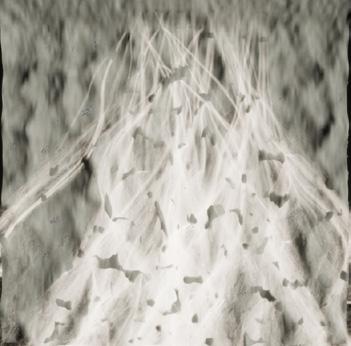
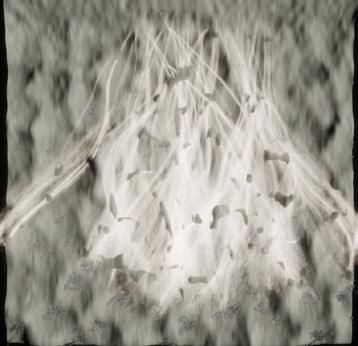
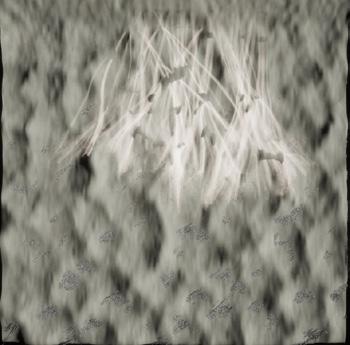
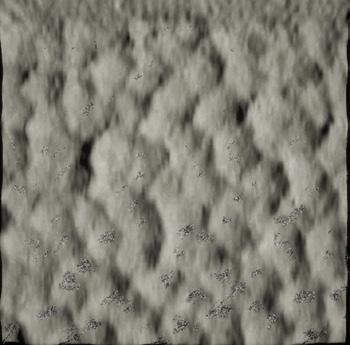
AEOLIAN | SCENARIO | 273 |
FRAME - 0
FRAME - 40
FRAME - 80
FRAME - 120
1ST LAYER TERRAFORMING DUNESCAPES
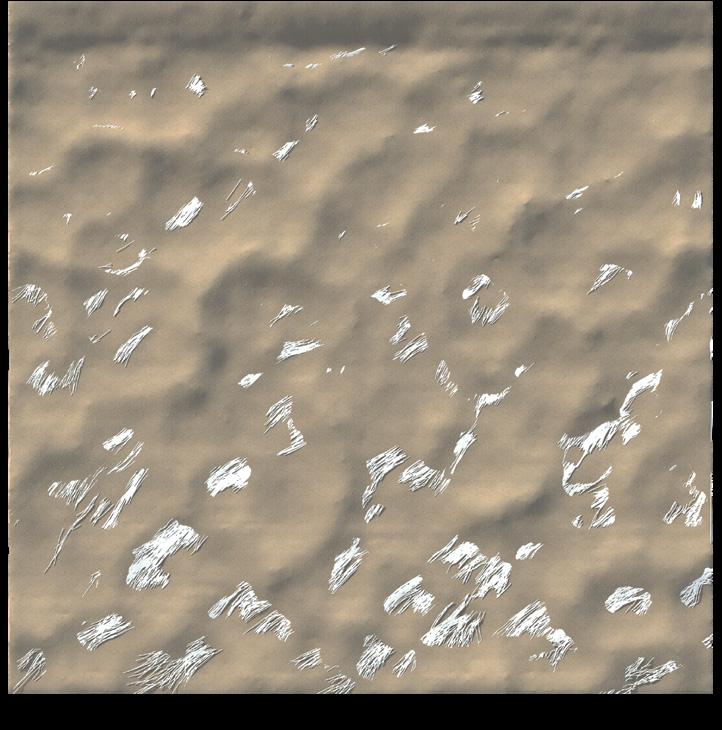
AEOLIAN | SCENARIO | 274 |
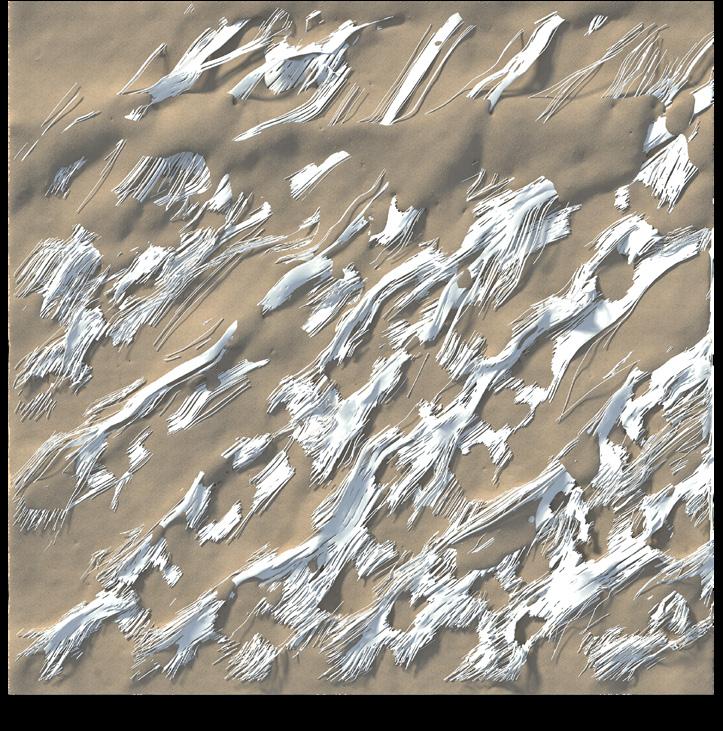
AEOLIAN | SCENARIO | 275 |
1ST LAYER - SAND ACCUMULATION ITERATIONS + SITE SELECTION
After sand is being fused onto the existing landscape by agents; the structures behave as barriers to prevent the sand from penetrating through and also capture sand grains. This procedure deepens the dune surface for agents to fuse additional structural layers.


Accumulation of sand particles also higher increases quantity of sand gathered by the structure. The impact between structure and sand flow causes the number of sand particles to rise and expand for a deeper landscape in the second to fourth iterations. Around the area, they are generating increasingly complex movements.



1st Layer
Time Step: 0:00:00
Time Step: 0:00:02
Time Step: 0:00:04
Time Step: 0:00:06
Time Step: 0:00:08

AEOLIAN | SCENARIO | 276 |
High Low Wind Dynamic
Section
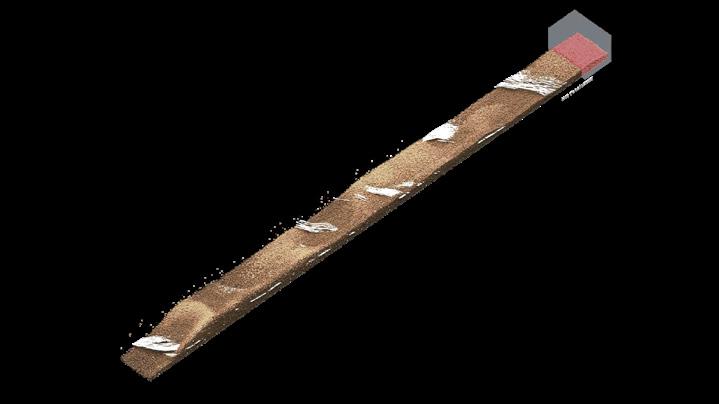
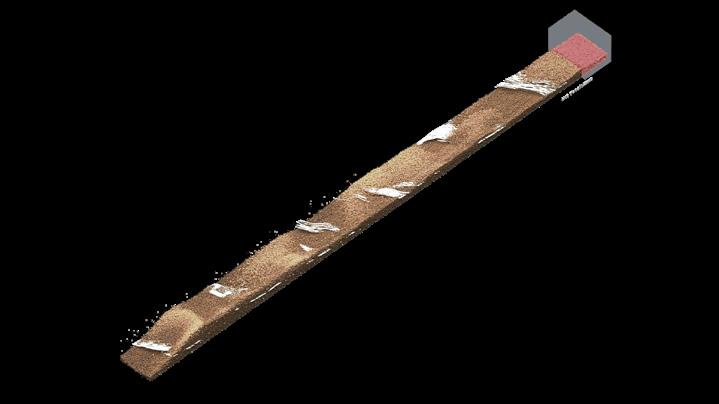
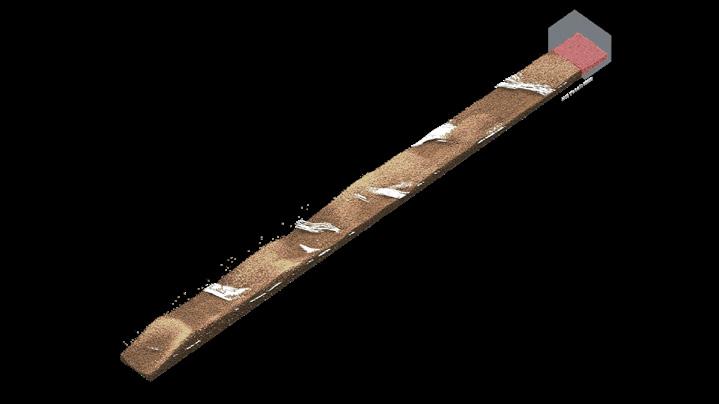

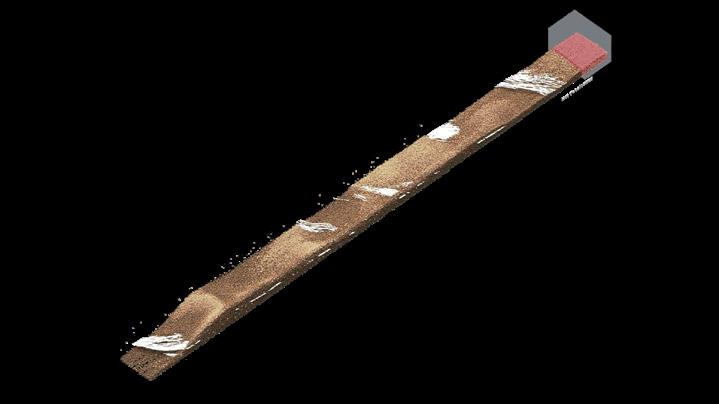
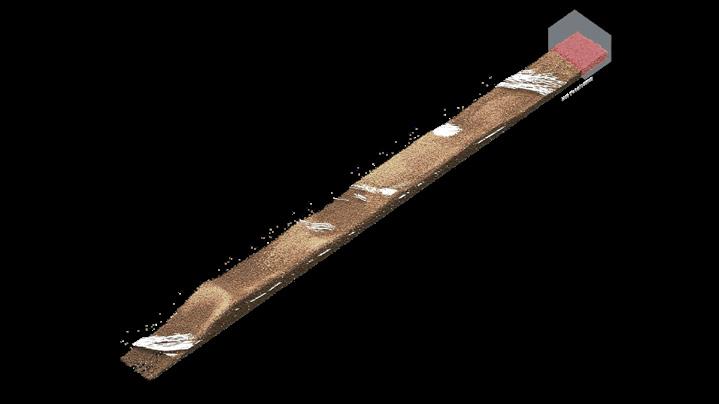
AEOLIAN | SCENARIO | 277 | Time Step: 0:00:00 Time Step: 0:00:02 Time Step: 0:00:04 Time Step: 0:00:06 Time Step: 0:00:08 1 Layer Windspeed Friction Particle Population 20 KM / Hr 6 560,000 Isometric
2ND LAYER
TERRAFORMING DUNESCAPES
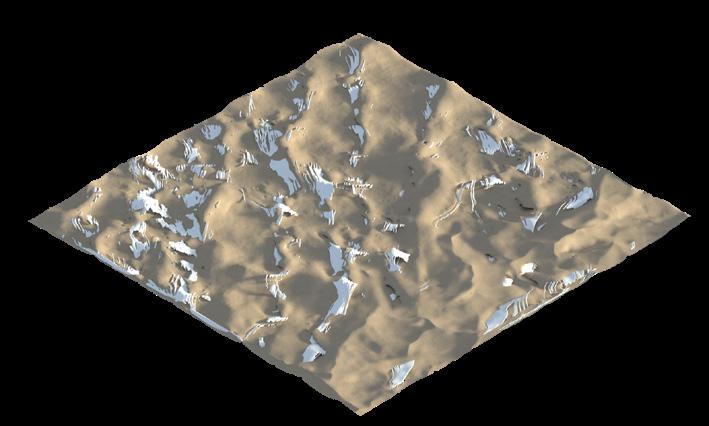

AEOLIAN | SCENARIO | 278 |
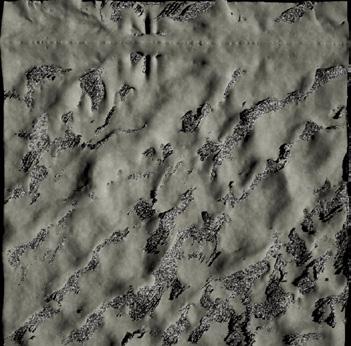


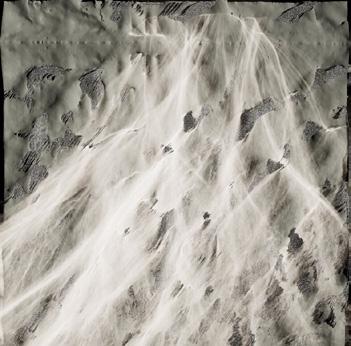
AEOLIAN | SCENARIO | 279 |
FRAME - 0
FRAME - 40
FRAME - 80
FRAME - 120
2 Layers


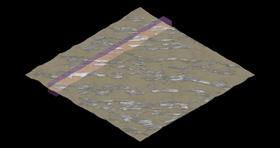

AEOLIAN | SCENARIO | 280 |
Windspeed Friction Particle Population 20 KM / Hr 6 740,000
Section High Low Wind Dynamic Time Step: 0:00:00 Time Step: 0:00:02 Time Step: 0:00:04 Time Step: 0:00:06 Time Step: 0:00:08
2nd Layer
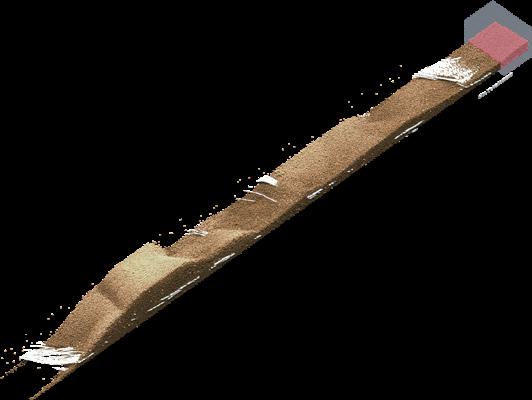




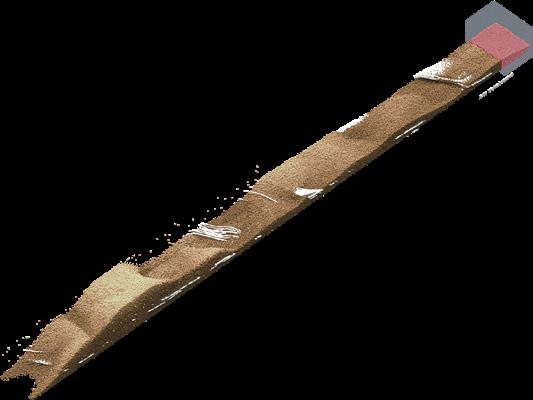
AEOLIAN | SCENARIO | 281 |
Isometric
Time Step: 0:00:00 Time Step: 0:00:02 Time Step: 0:00:04 Time Step: 0:00:06 Time Step: 0:00:08
3RD LAYER TERRAFORMING DUNESCAPES
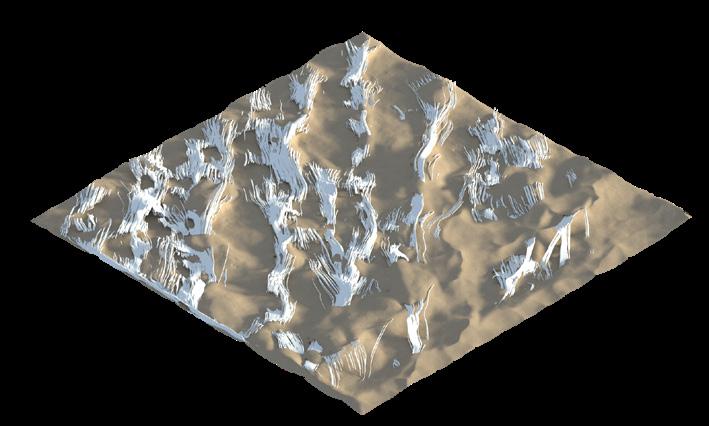
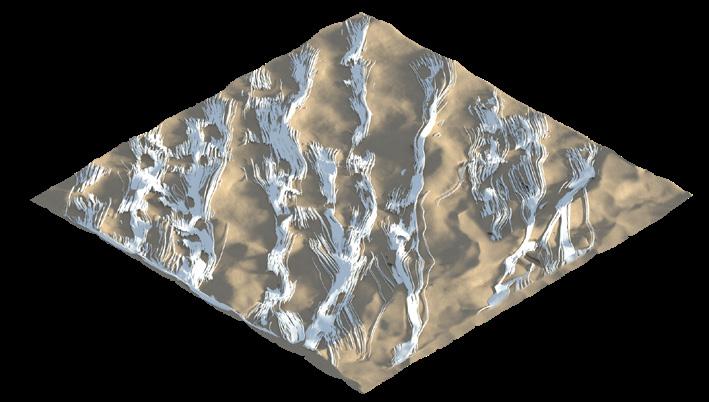
AEOLIAN | SCENARIO | 282 |
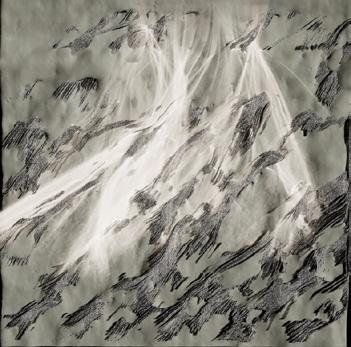
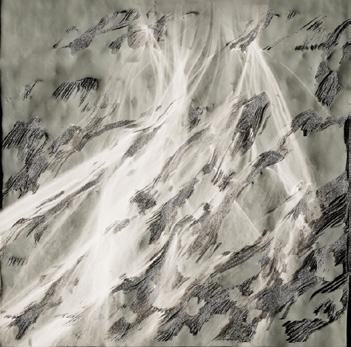

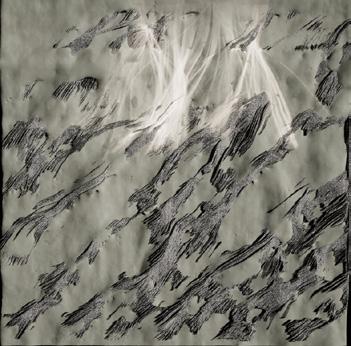
AEOLIAN | SCENARIO | 283 |
FRAME - 0
FRAME - 40
FRAME - 80
FRAME - 120
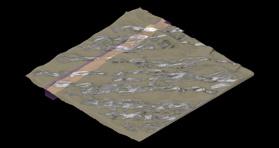

AEOLIAN | SCENARIO | 284 | Isometric 3rd Iteration Section High Low Wind Dynamic Time Step: 0:00:00 Time Step: 0:00:02 Time Step: 0:00:04 Time Step: 0:00:06 Time Step: 0:00:08
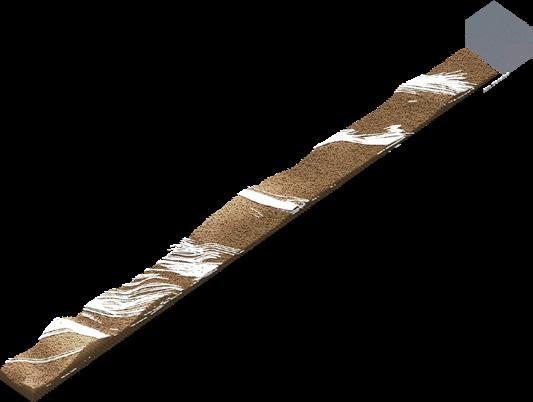
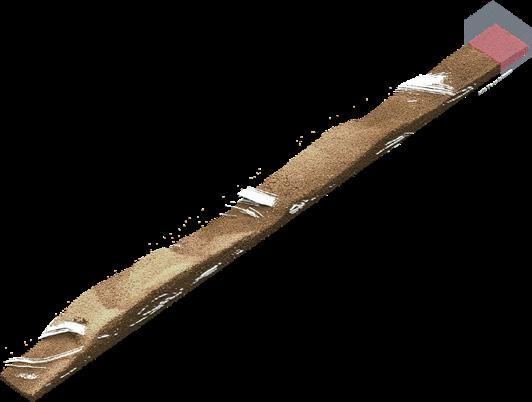
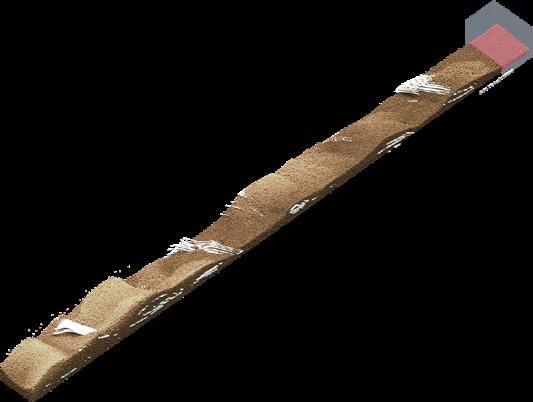
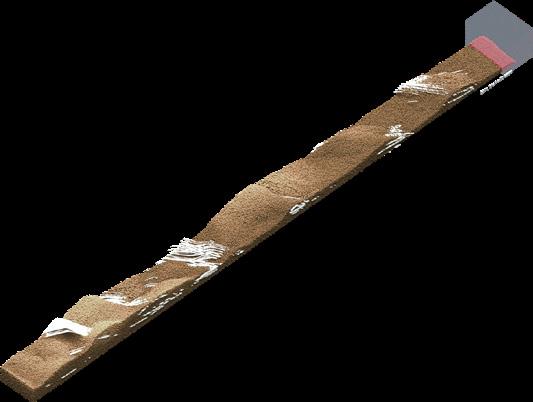


AEOLIAN | SCENARIO | 285 |
Isometric
Time Step: 0:00:00 Time Step: 0:00:02 Time Step: 0:00:04 Time Step: 0:00:06 Time Step: 0:00:08
PERFORMANCE
SHIFTING PARTICLE FLOW

As shown in the comparison, the number of layers of the structure has a significant impact on the effectiveness of redirecting particles on a dune landscape. As the number of layers increases, there is a robust improvement in the performance of redirecting particles.
0 - LAYERS
AEOLIAN | SCENARIO | 286 |
3 - LAYERS

AEOLIAN | SCENARIO | 287 |
4TH LAYER
TERRAFORMING DUNESCAPES
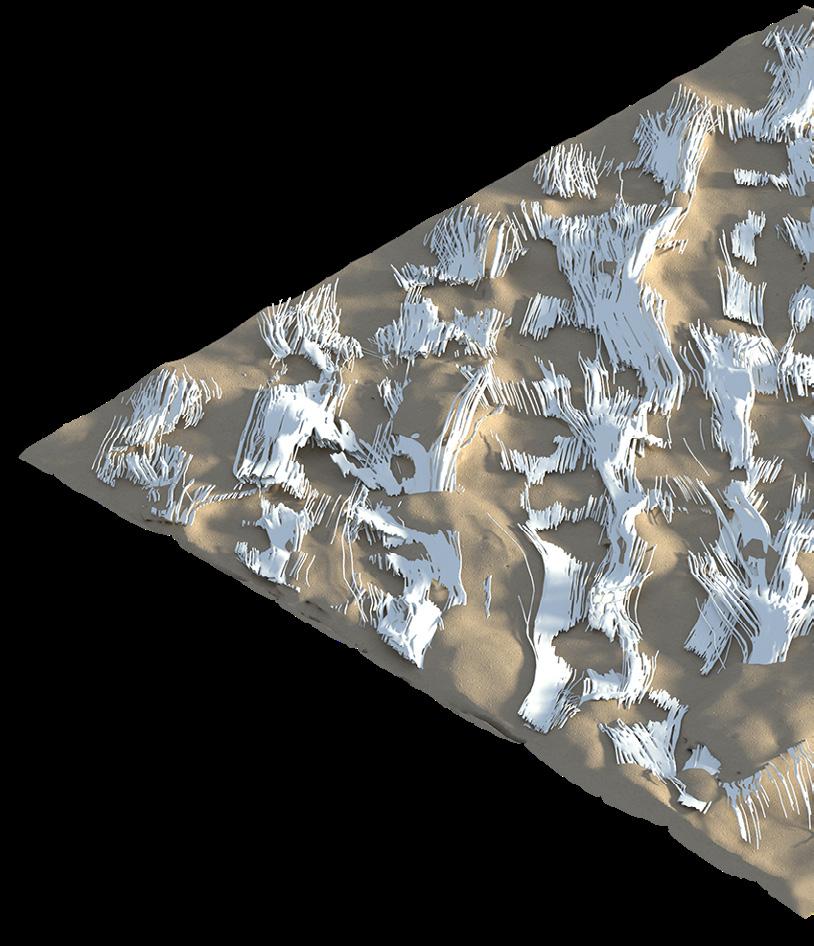
AEOLIAN | SCENARIO | 288 |

AEOLIAN | SCENARIO | 289 |
PARTICLE SYSTEM




AGENT HERD BEHAVIOUR
Density = Height + Curvature
To control how dense the agents couple with one another to form groups and clusters, the data received by layering the height map and the curvature map is utilized, creating a new map that builds a relationship between the agent’s vertical position and the curvature of the area they are traveling on.
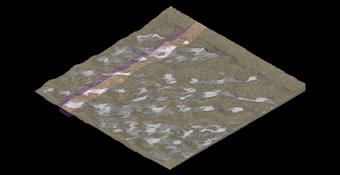
Time Step: 0:00:00
Time Step: 0:00:03
Time Step: 0:00:06
Time Step: 0:00:09
AEOLIAN | SCENARIO | 290 |
Section



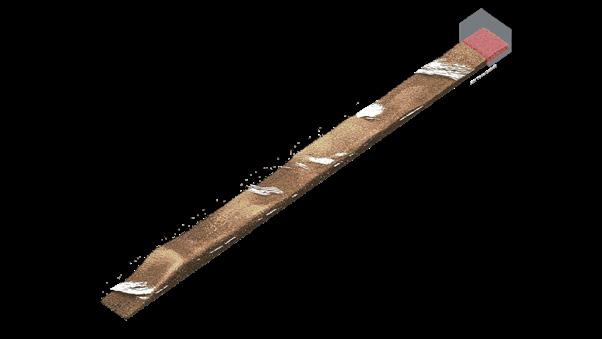
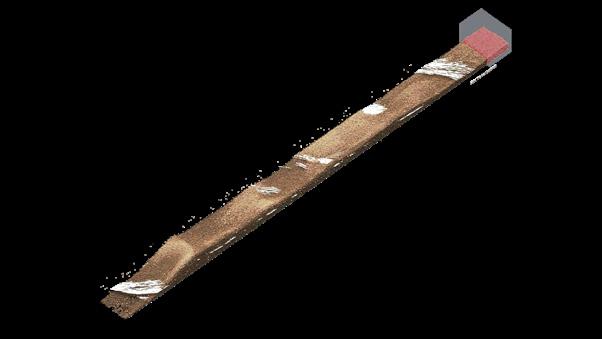
AEOLIAN | SCENARIO | 291 | Time Step: 0:00:00 Time Step: 0:00:03 Time Step: 0:00:06 Time Step: 0:00:09 Isometric Wind Dynamic 1 Layer Windspeed Friction Particle Population 20 KM / Hr 6 560,000 High Low

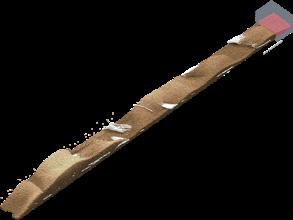
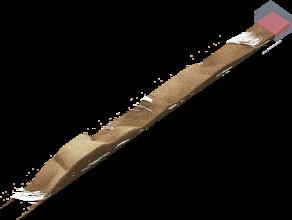




AEOLIAN | SCENARIO | 292 |
AGENT HERD BEHAVIOUR Section Isometric Time Step: 0:00:00 Time Step: 0:00:03 Time Step: 0:00:06 Time Step: 0:00:09 Wind Dynamic High Low 2 Layers Windspeed Friction Particle Population 20 KM / Hr 6 740,000
PARTICLE SYSTEM

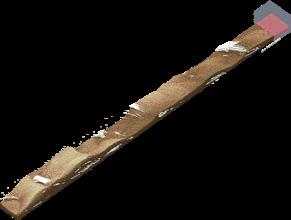
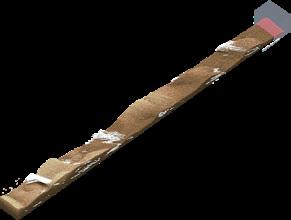
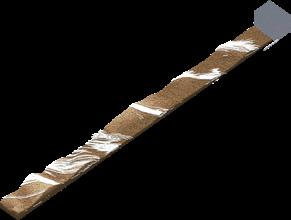

AEOLIAN | SCENARIO | 293 | Section Isometric Time Step: 0:00:00 Time Step: 0:00:03 Time Step: 0:00:06 Wind Dynamic High Low Time Step: 0:00:09 3 Layers Windspeed Friction Particle Population 20 KM / Hr 6 920,000
PARTICLE SYSTEM




AEOLIAN | SCENARIO | 294 |
AGENT HERD BEHAVIOUR




AEOLIAN | SCENARIO | 295 |
STRUCTURE INFLUENCE
CHANGING OF DUNES SCENARIO
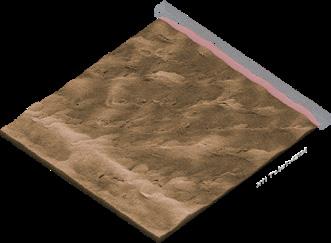

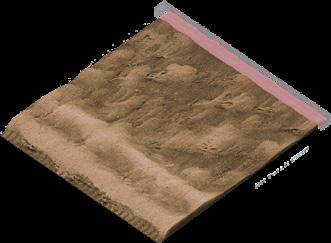
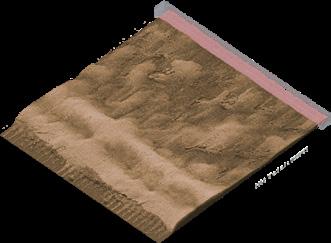
The following simulations evaluate the environment in two distinct states. The first being the dune landscape in its natural form, and the second, the terrain that has been altered by the generated morphology, which only exists within the context of a machine ecology
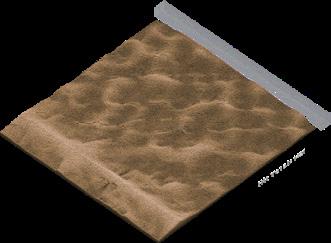
Frame: 1
Non-Structural Influence
Frame: 160
Frame: 80
Frame: 300
Frame: 240
AEOLIAN | COLLECTIVE | 296 |
Windspeed Friction Particle Population 25 KM / Hr 4 9,650,000
Frame: 1
3 Layers Structural Influence

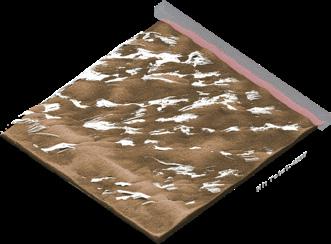
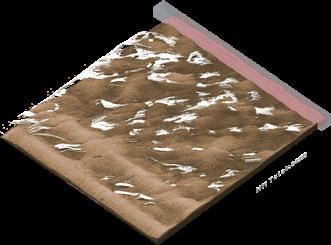


Frame: 160
Frame: 80
Frame: 300
Frame: 240
AEOLIAN | COLLECTIVE | 297 |
Windspeed Friction Particle Population 25 KM / Hr 4 9,650,000
Influence Comparison
Non-Structural Influence
Time: Frame 01
3 Layers Structural Influence
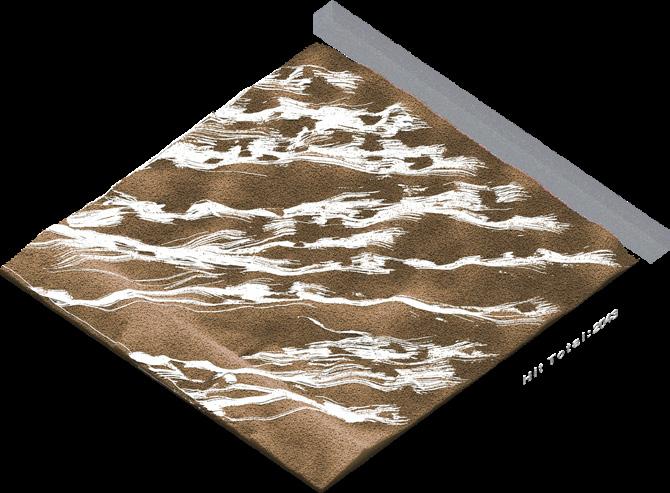
Time: Frame 01

AEOLIAN | COLLECTIVE | 298 |
1 km. 1 km. 1 km. 1 km.
Non-Structural Influence
Time: Frame 300
3 Layers Structural Influence
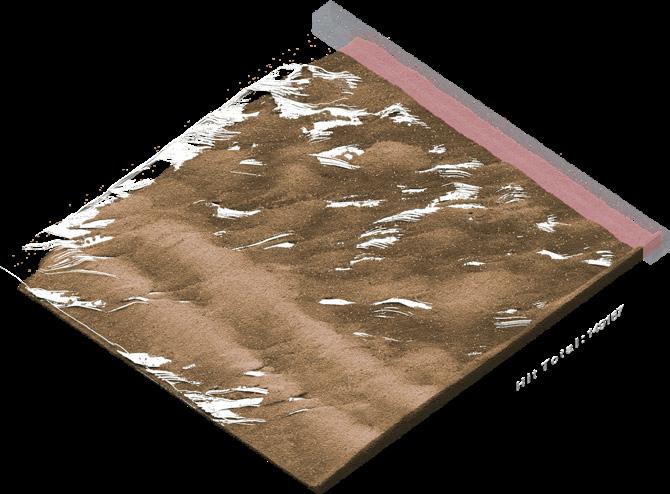
Time: Frame 300
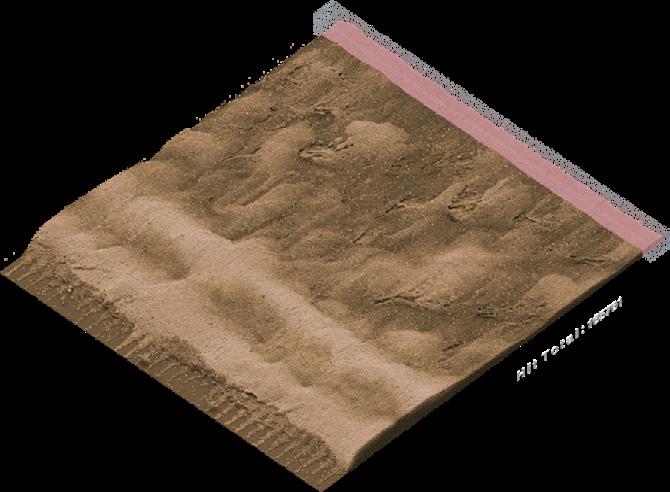
AEOLIAN | COLLECTIVE | 299 |
1 km. 1 km. 1 km. 1 km.
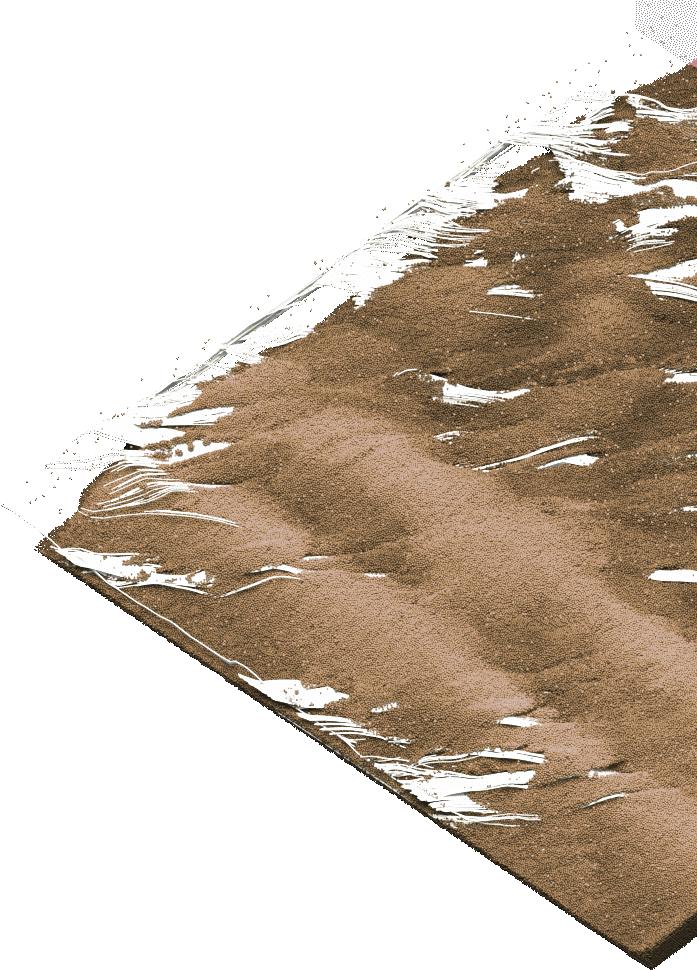
AEOLIAN | COLLECTIVE | 300 |
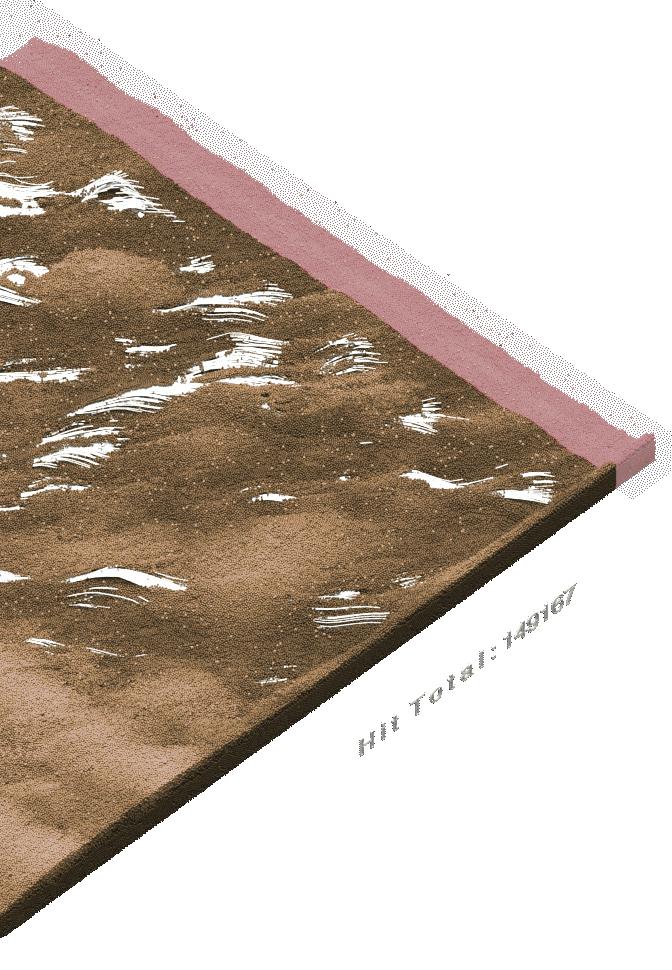
AEOLIAN | COLLECTIVE | 301 |
GLOBAL SCALE SLOPES ANALYSIS
One group of agents operates within a 1 square kilometre area. However, for the global scale, a height map of the landscape was utilized to perform a slope orientation analysis, with a focus on identifying back side slopes facing towards the wind. In this global scale approach, the structure would be segmented based on the landscape characteristics. As demonstrated in the example, with the use of 10000 agents, an area of 1500 km2 can be covered in a period of 16 years. This approach has resulted in the gradual redirecting of sand particles away from the city.
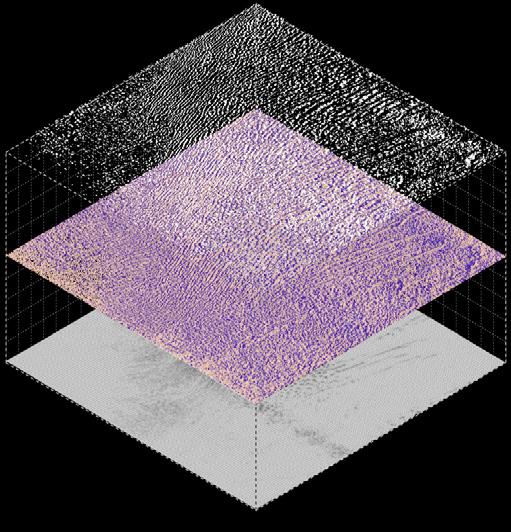
AEOLIAN | SCENARIO | 302 |
Back Front
Slopes orientation analysis
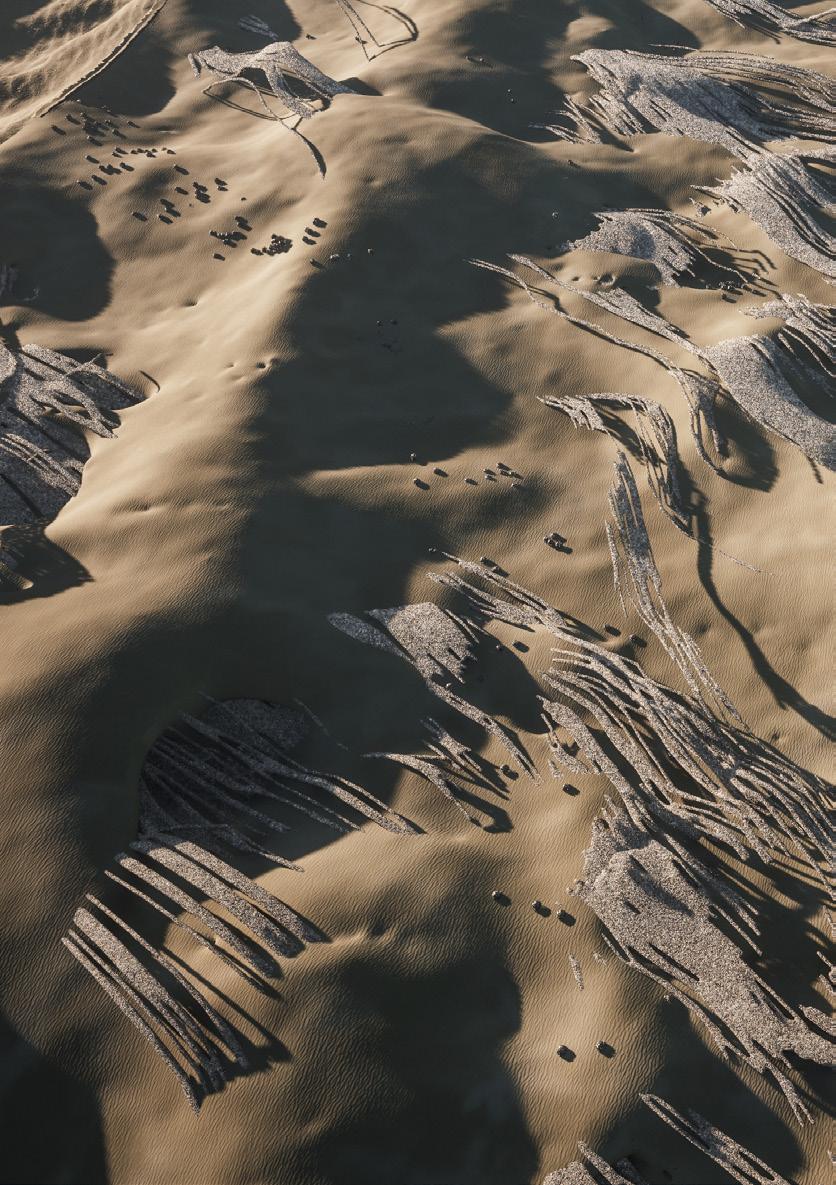
YEARS ELAPSED - 0
YEARS ELAPSED - 3
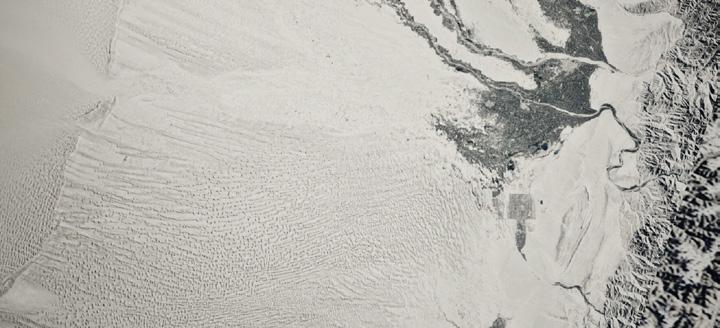
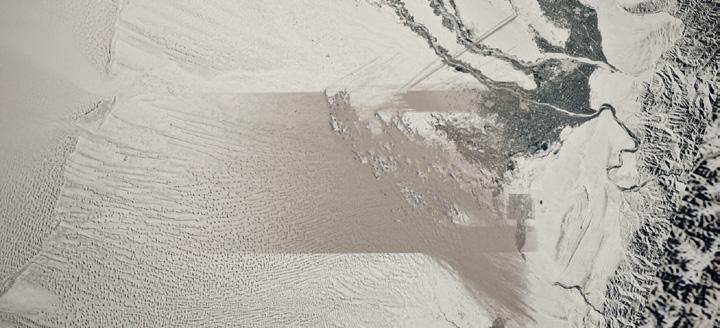
YEARS ELAPSED - 6
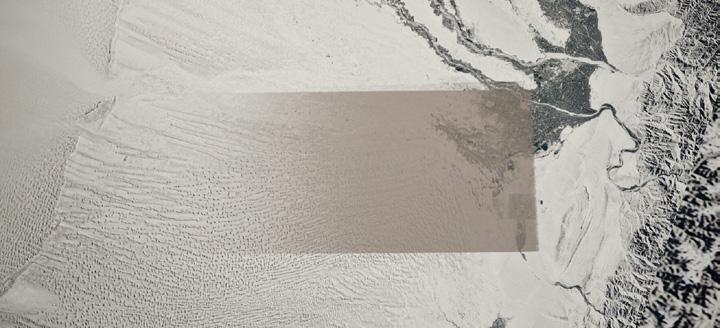
AEOLIAN | SCENARIO | 304 |
YEARS ELAPSED - 9
YEARS ELAPSED - 12
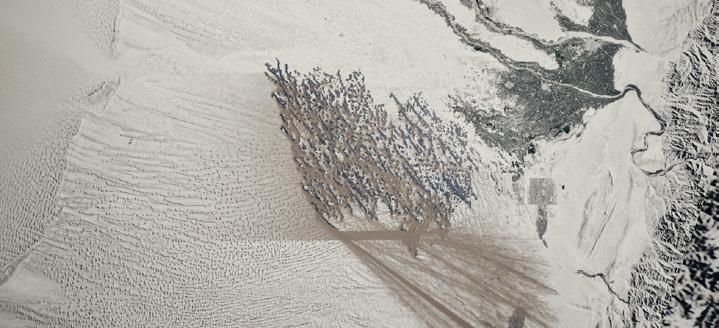
YEARS ELAPSED - 16
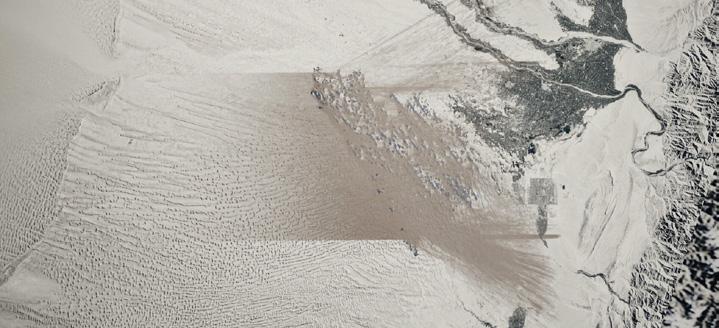
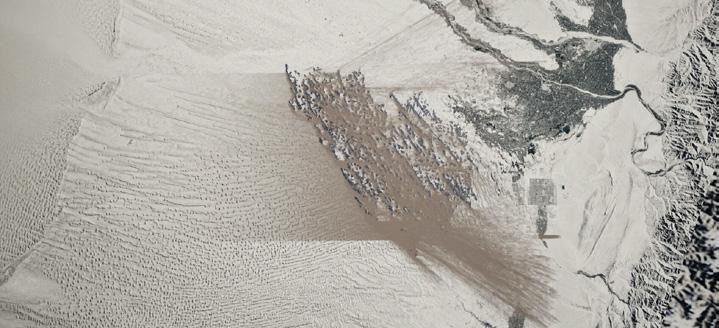
AEOLIAN | SCENARIO | 305 |
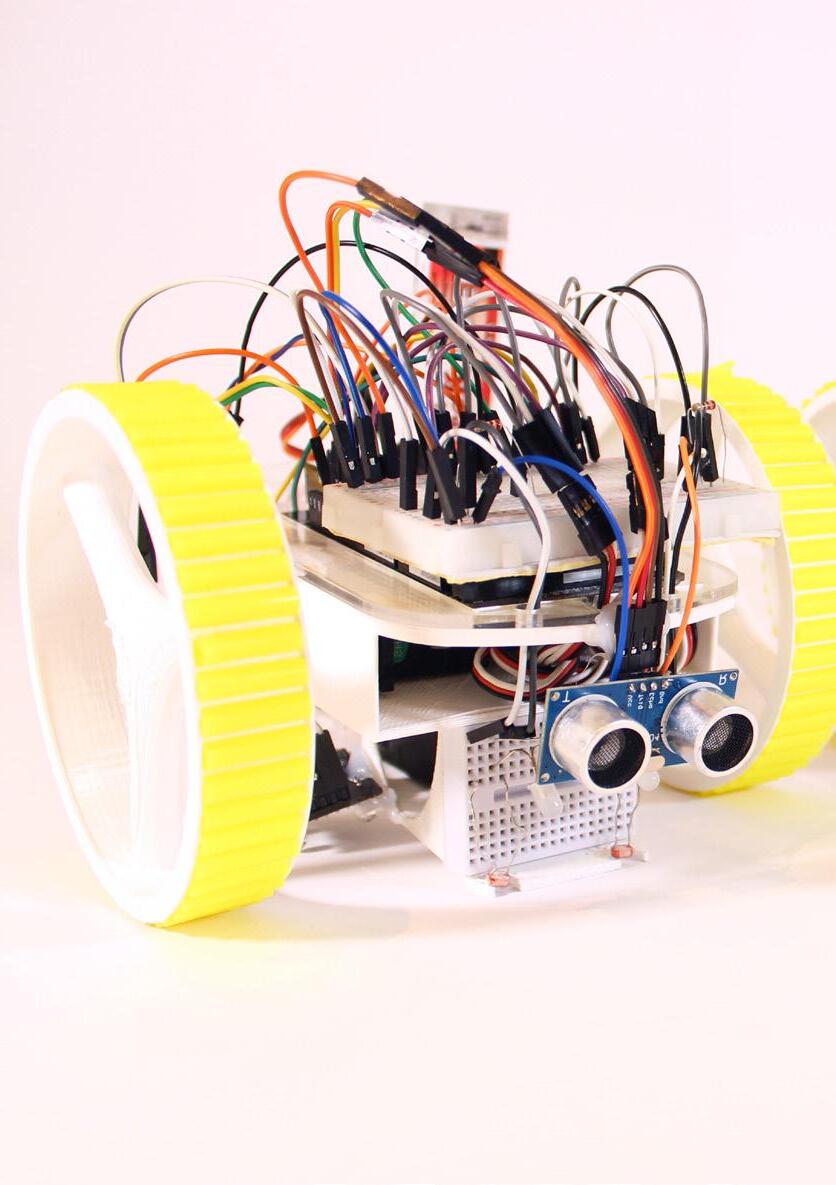
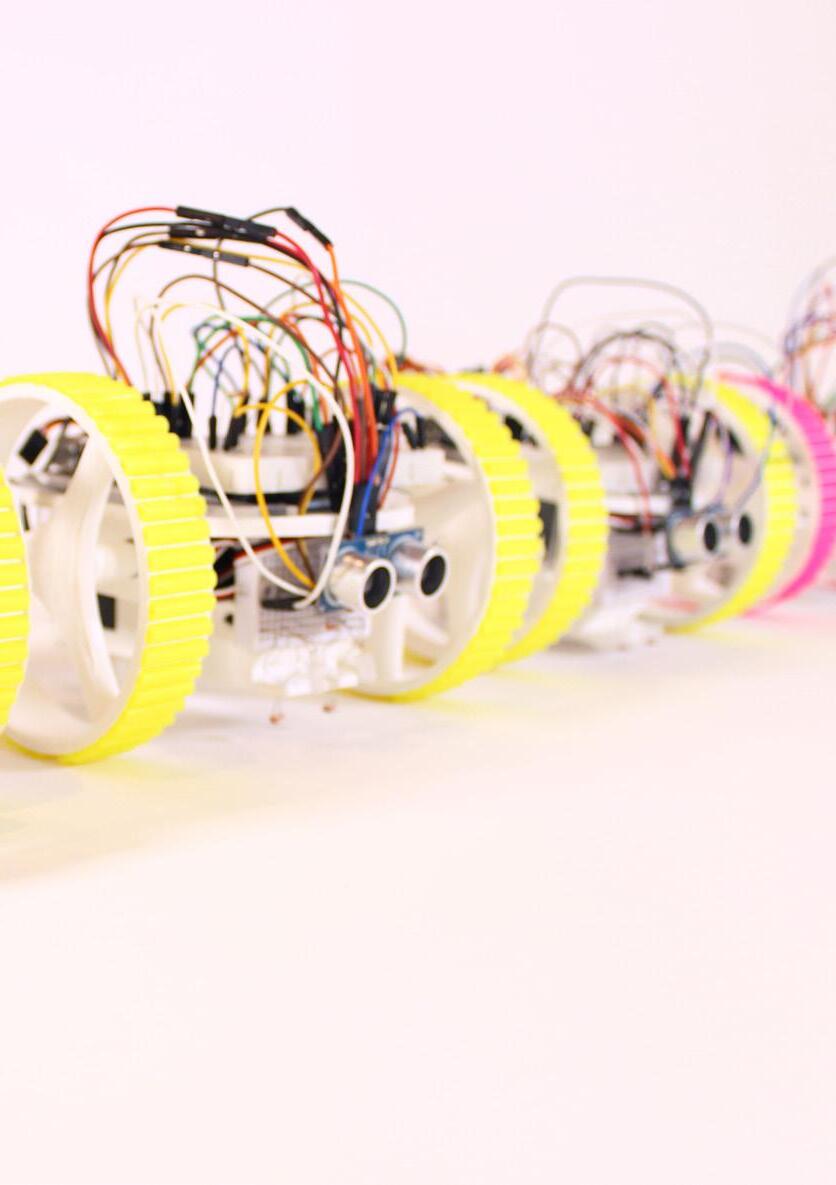
AGENT BEHAVIOURAL PROTOTYPE
AGENT BEHAVIOUR FUNCTIONS
Mobility
Printing
DRAWING
FOLLOWING
Sensing Communicating
ARDUINO
AGENT BEHAVIOURAL PROTOTYPE
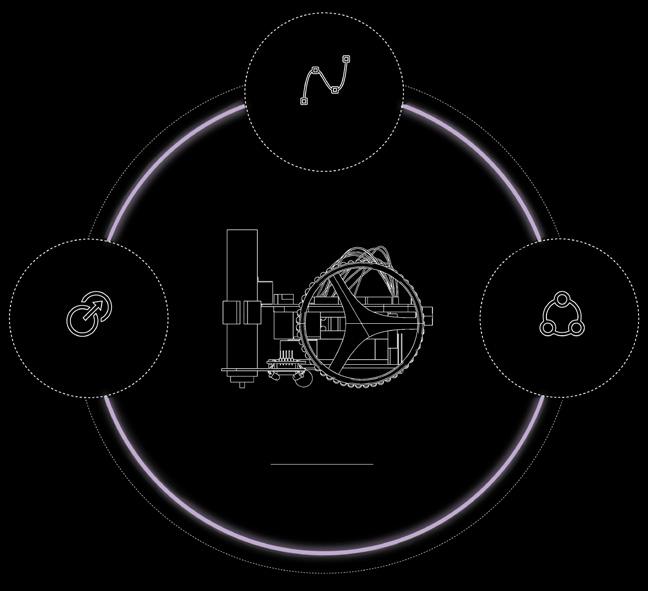
COLOUR DATA
Colour map analysis
AEOLIAN | AGENT | 308 |
DRAWING
The implemented sensing functions aid in determining the specific location where the structure (represented by a line) should be drawn. The agents make decisions regarding the length and location of the line based on the colour map, which is a visual representation of the previously conducted terrain analysis. The agents can also identify areas where the implementation of the structure is not required, as indicated by the colour map, and will not draw the line in those areas, in accordance with the strategy.
FOLLOWING
The agents are equipped with sensing functions that include two distinct behaviours. The first behaviour line sensing or following, enables the agents to recognize and move along lines left by other agents. The second behaviour colour analysis, enables the agents to interpret data from the environment and determine the area to be investigated.
The agents collaborate by following the lines left by the leading agents, which are marked by a black line. This enables the following agents to recognize and follow the route. In addition to the lines, the agents also communicate with ultrasonic sensors to avoid collisions with one another.
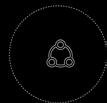

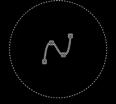
COLOUR DATA
The colour analysis help to define the investigation area, by reading the data from the environment. The implementation area is represented by red and green colours received from a previously conducted analysis of the landscape, while the green colour defines the area where the agent should not leave a new path.
AEOLIAN | AGENT | 309 |
MOBILITY MOVING ON THE DESERT
Research on the natural systems’ coping mechanisms for the harsh environment, as well as the mobility of the local species, were conducted in order to incorporate mobility into the agent behaviours.
Direction
Fig. 1 Tumbleweed
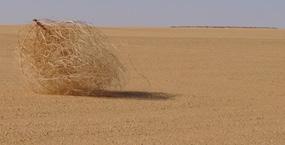
Fig. 2 Flic-Flac Spider

Fig. 3 Sidewinder Snake

Fig. 4 Namib Web-footed Geck
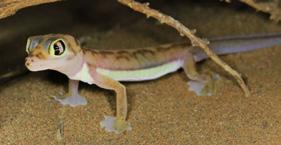
Direction
Direction
Direction
AEOLIAN | AGENT | 310 |
The mobility of the agents in the experiment was designed to evaluate various forms of movement on a dynamic particle system, such as sand. This was achieved by simulating the movement of wheels on sand using different geometric designs. The area of the site plays a crucial role in determining the friction with the ground and thus the feasibility of movement on the sand.






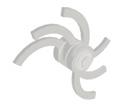
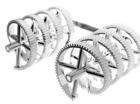


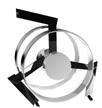

AEOLIAN | AGENT | 311 |
Geometry Landing Area
EXPERIMENTS WHEELS | 1



The welding nozzle should be always stable related to the landscape, that is why agent’s movement should be exhibited through rolling. Therefore, the experiment tests two types of wheels and their variations, regular spherical and spiral wheels in the sandbox.
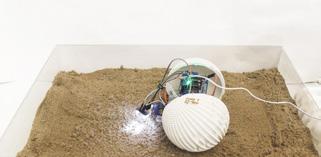

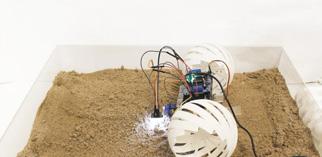
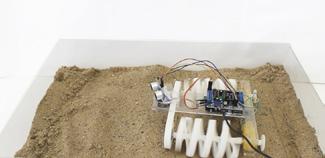

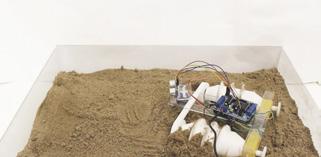

AEOLIAN | AGENT | 312 |
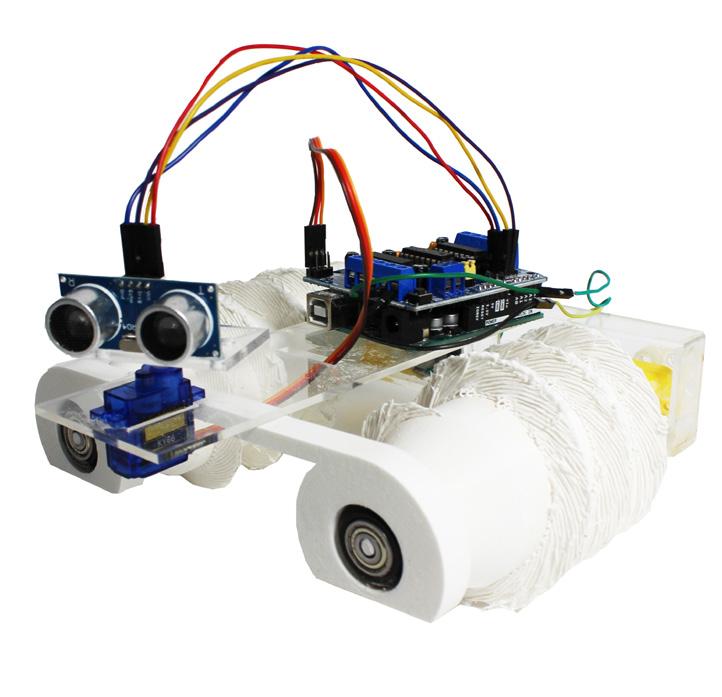
AEOLIAN | AGENT | 313 |
Screw Wheel Robot

AEOLIAN | AGENT | 314 |
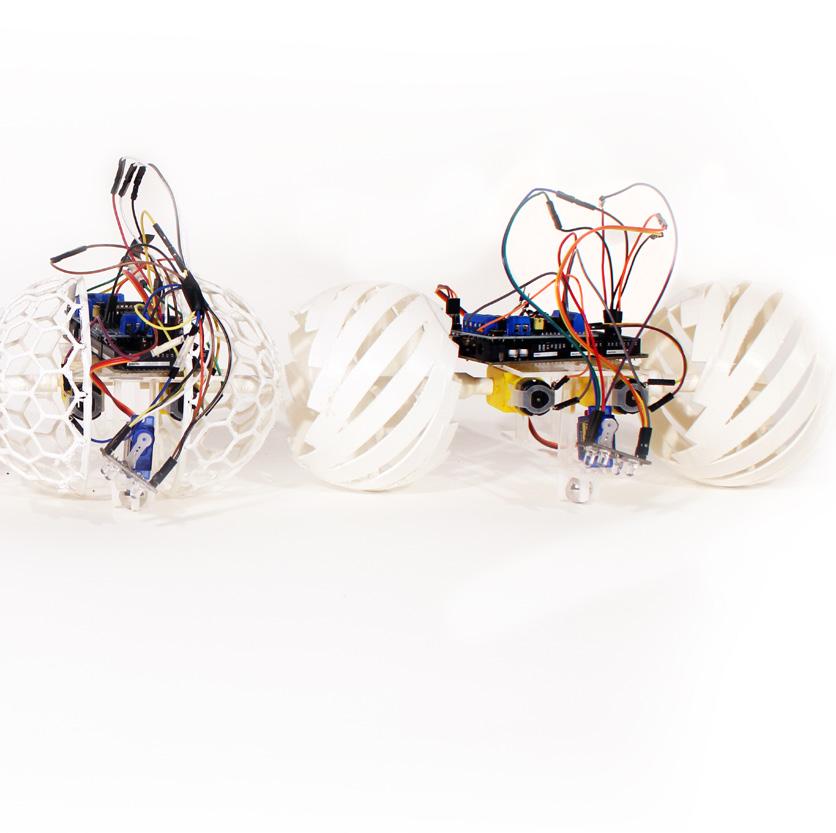
AEOLIAN | AGENT | 315 | Iteration 1
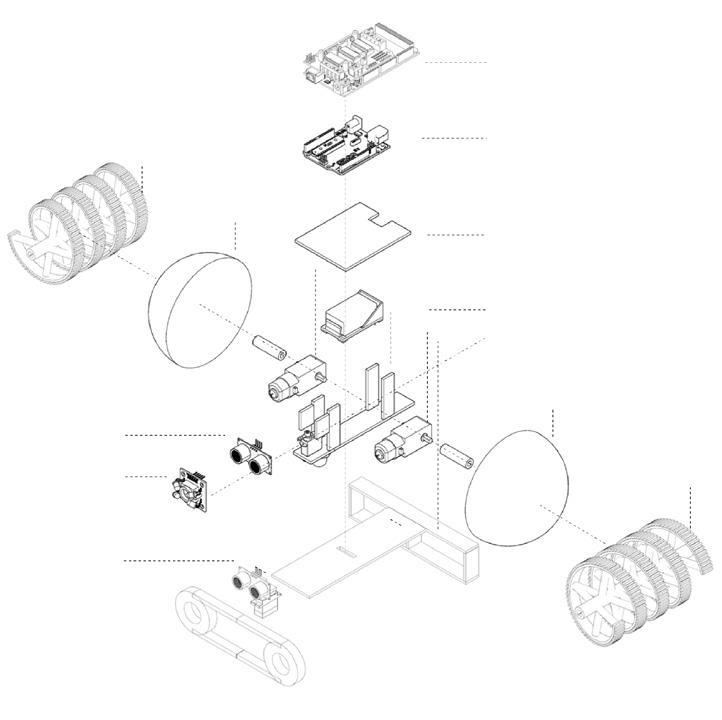
AEOLIAN | AGENT | 316 |
EXPLOSION DIAGRAM 1 2 3 4 5 5’ 5’’ 6’’ 6 7 7’’ 8 8 6 6’’
ITERATION 1
1 MOTOR SHIELD
2 ARDUINO
3 ACRYLIC PANEL
4 9V BATTERY *2
5 ULTRASONIC SENSOR
5’ COLOUR SENSOR
5 “ ULTRASONIC SENSOR
6 SPHERE WHEEL 6’’ DRILL WHEEL 7 CENTRE BODY 7” CENTRE BODY 8 DC MOTOR *2
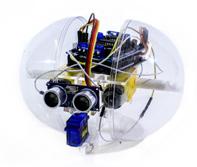
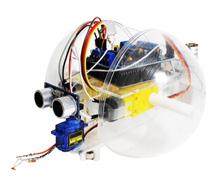
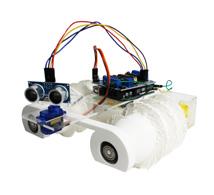


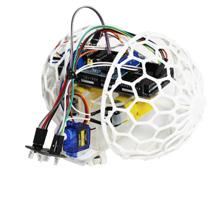

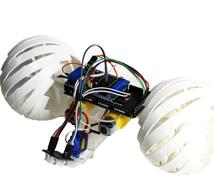
AEOLIAN | AGENT | 317 | 1st Generation 2nd Generation 3th Generation 3th Generation 1st Generation 2nd Generation 2rd Generation 2th Generation
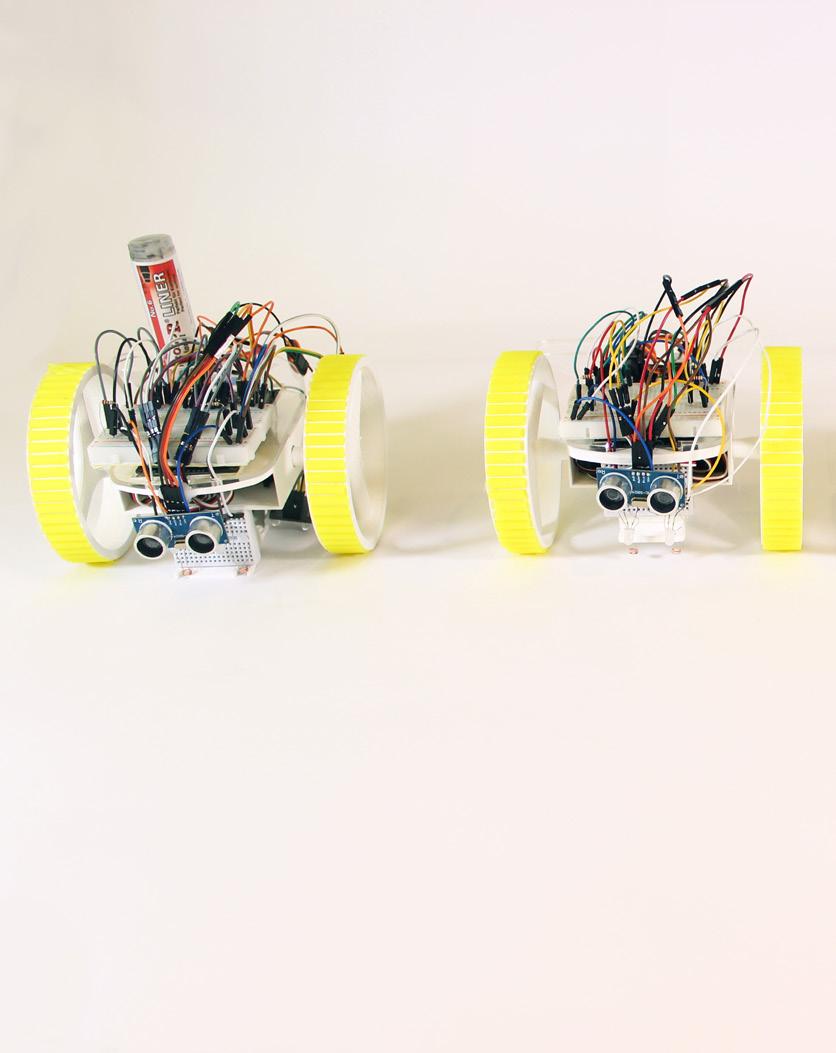



AEOLIAN | AGENT Interation 2
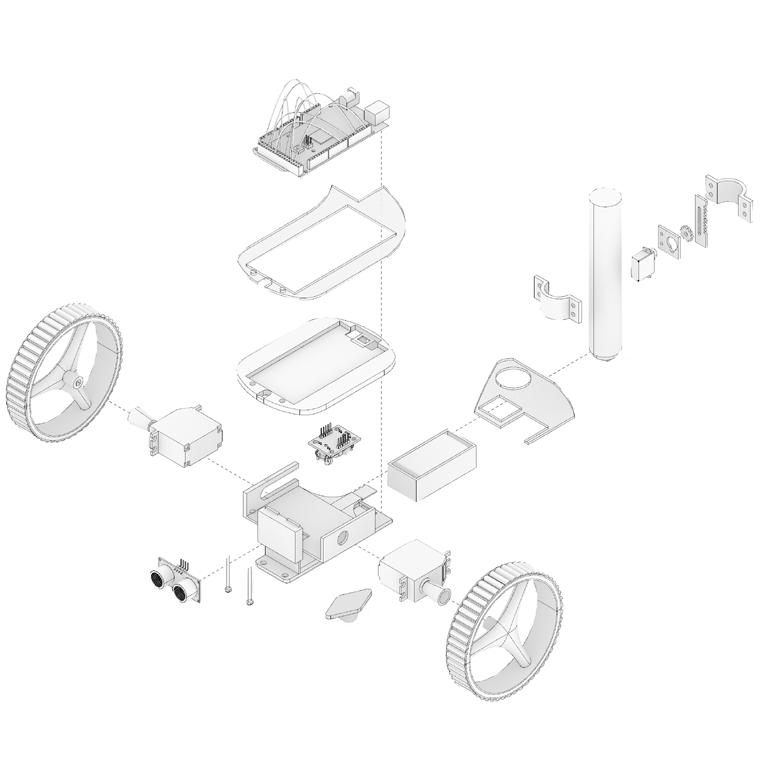
AEOLIAN | AGENT | 320 |
3
ITERATION 2 EXPLOSION DIAGRAM
1 RUBBER TUBES WHEEL
2 CONTINUOUS SERVO
3 ARDUINO
4 CENTRE BODY
5 9V BATTERIES
6 FRONT WHEEL
7 COLOUR SENSOR
8 PHOTORESISTOR
9 OBSTACLE SENSOR
10 INK PEN
11 SERVO
1 2 2 1 3 4 4 5 6 7 8 9 11 12 10
12 PEN HOLDER
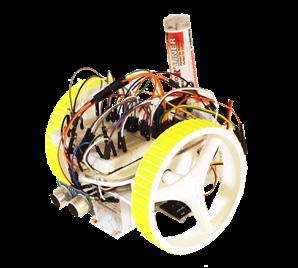
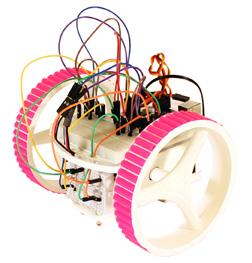
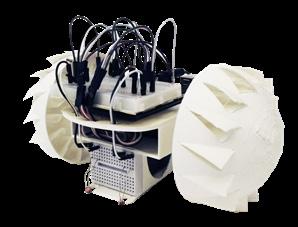
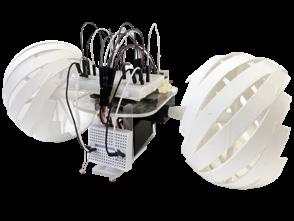
AEOLIAN | AGENT | 321 |
1st Generation
1st Generation
2nd Generation
2nd Generation
MATERIAL DIFFERENTIATION
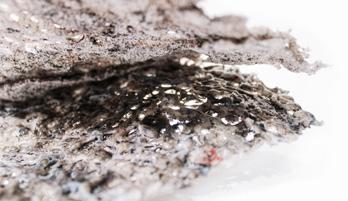

AGENT TO STRUCTURE
Agents have the ability to recognize the structure based on the difference in properties between sand and glass (fused sand). Three significant characteristics, colour, reflection, and temperature provide the information for agents to interact with the glass structure.

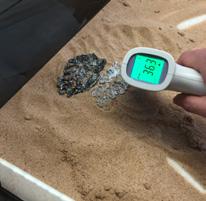
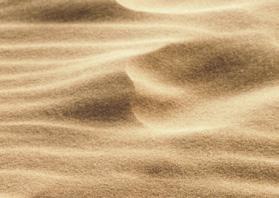
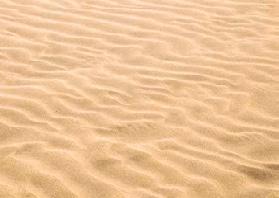
Colour
Reflection
Temperature

AEOLIAN | AGENT | 322 |
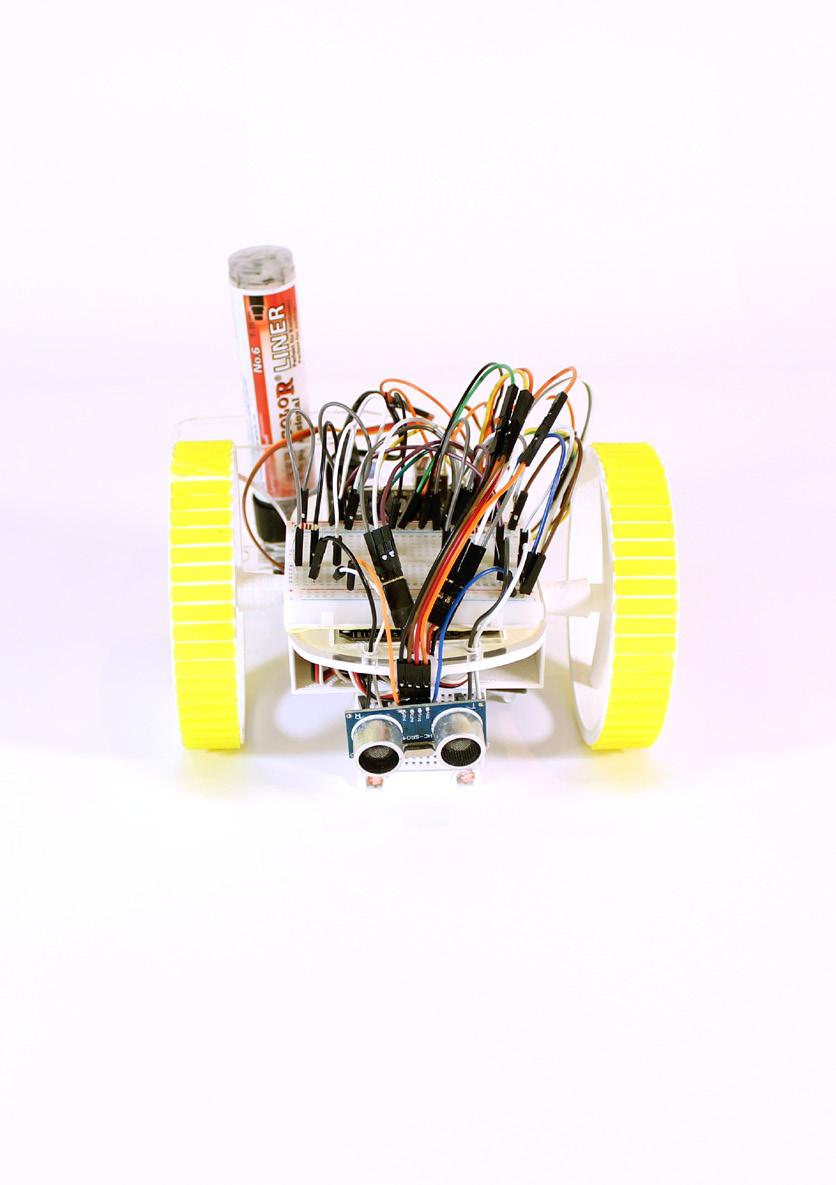
SENSING
FOLLOWING GLASS STRUCTURE
The better performance was archived with IR sensors by sensing the reflection of the surface. The agent can recognise and follow the glass structure by employing the ability to seance the difference in reflection between sand and the glass.
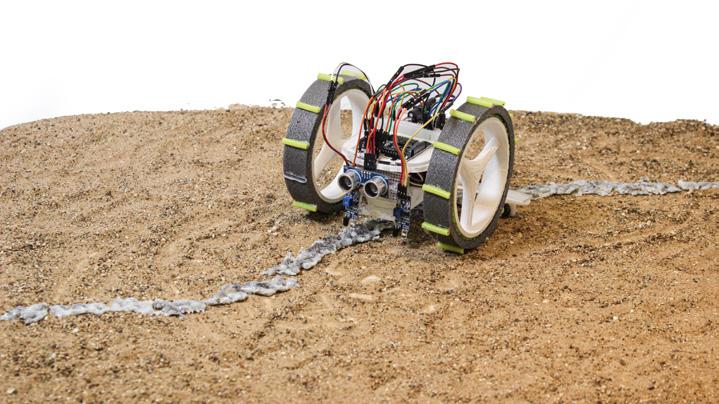
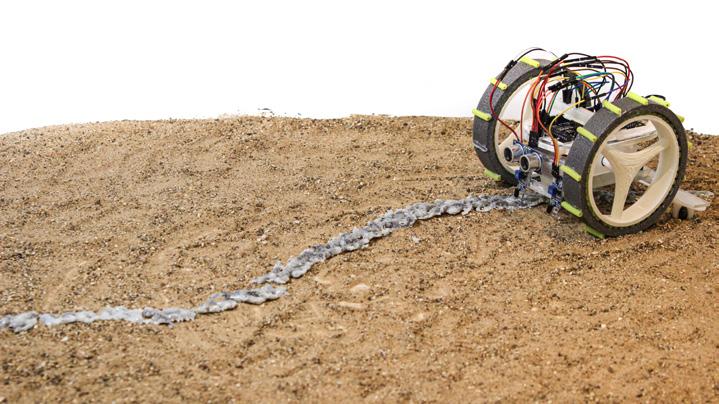
AEOLIAN | AGENT | 324 |

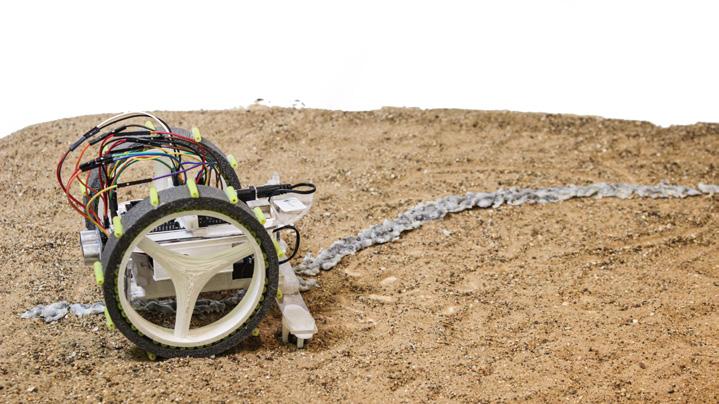
AEOLIAN | AGENT | 325 |
FOLLOWING
LINE FOLLOWING | ITERATION 1
The agent in the experiment has a photoresistor that detects the difference in light reflection between different materials. In the experiment, the robot was programmed to avoid crossing the black line by sensing the difference in the reflection between black and white paper.

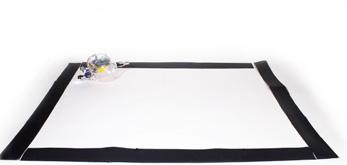
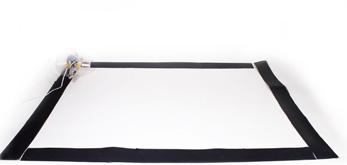

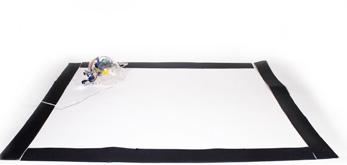
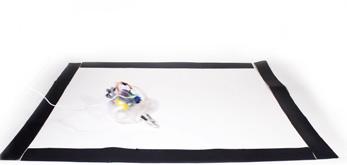

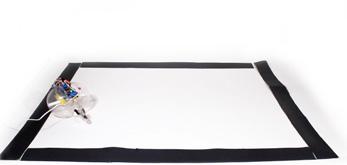
AEOLIAN | AGENT | 326 |
0:00:01 0:00:02 0:00:03 0:00:04 0:00:05 0:00:06 0:00:07 0:00:08
LINE FOLLOWING | ITERATION 2
The robot has two photoresistors in the front which allow it to follow the black line in between them. If both sensors sense the bright area, the robot moves forward. If one of the sensors senses dark, the robot turn left or right to adjust its path.
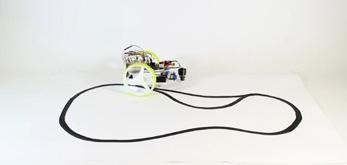
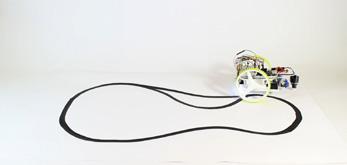

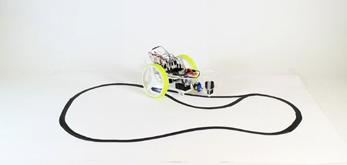
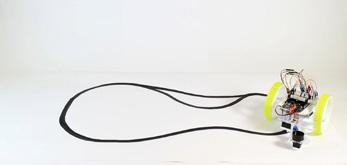
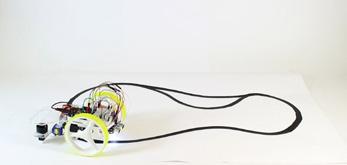
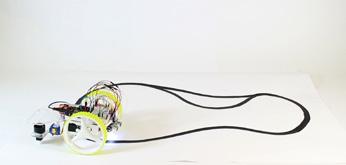

AEOLIAN | AGENT | 327 |
0:00:01 0:00:02 0:00:05 0:00:06 0:00:08 0:00:10 0:00:12 0:00:14
DRAWING PRINTING | ITERATION 1

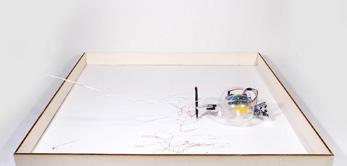
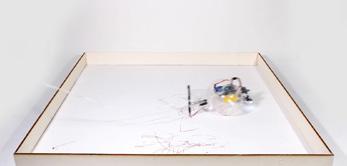

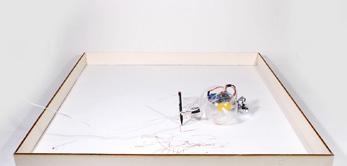

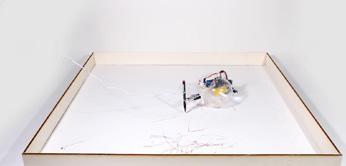
Leading agents leave a trace that others can recognize and follow. In the prototype, the agent holds the red marker, which leaves the trail. The trail pattern is influenced by the agent’s movement, avoiding obstacles.
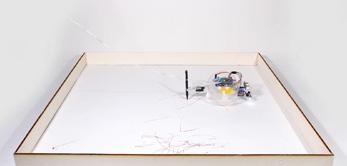
AEOLIAN | AGENT | 328 |
0:00:05 0:00:09 0:00:15 0:00:20 0:00:24 0:00:28 0:00:32 0:00:34
PRINTING | ITERATION 2
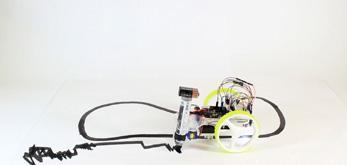

The second iteration of the drawing experiment aimed to combine two distinct behaviours, particularly linefollowing and line-drawing at the same time. The agent is able to recognise the line and offset it with a new line while moving.

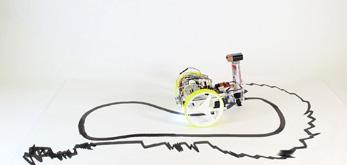
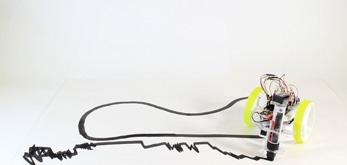

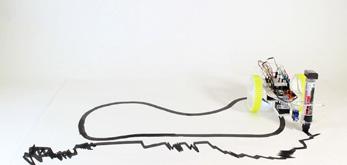
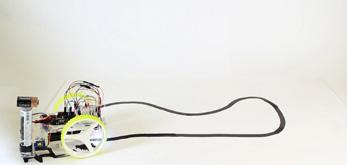
AEOLIAN | AGENT | 329 |
0:00:01 0:00:03 0:00:05 0:00:07 0:00:09 0:00:12 0:00:14 0:00:16
DRAWING COMMUNICATION | ITERATION 1

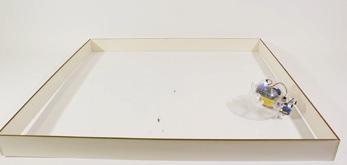

Agent communicate with each other through the structure (line) and distance sensor to avoid collision. The agent’s prototype has a distance sensor and a servo motor, which allow testing the distance and avoid hitting obstacles.


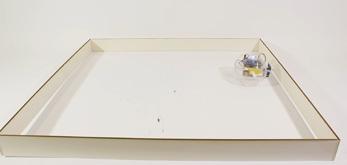
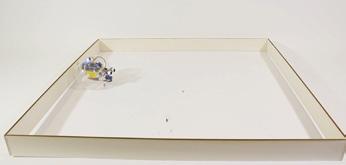
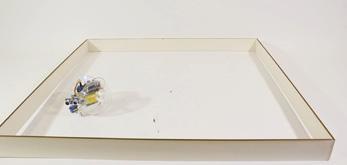
AEOLIAN | AGENT | 330 |
0:00:00 0:00:02 0:00:03 0:00:04 0:00:05 0:00:06 0:00:07 0:00:08
COMMUNICATION | ITERATION 2
The following experiment was conducted in order to develop strategies for interaction between robots. In the prototype, the agent senses another one with an obstacle sensor in the front. When one of them senses another, it stops moving without bumping it until it passes through.
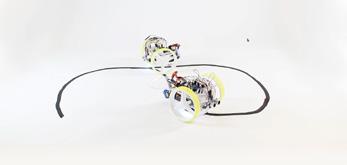
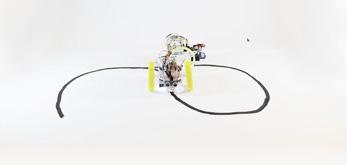

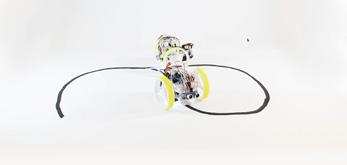
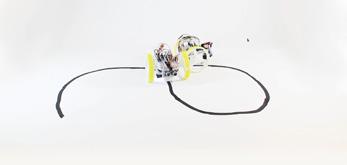
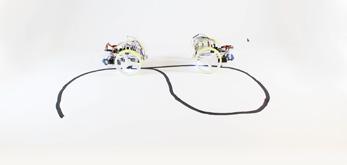
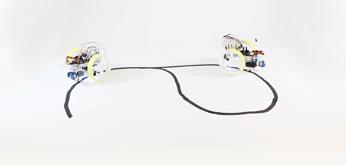
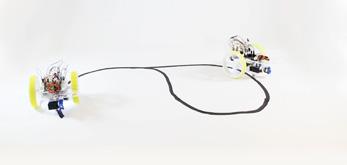
AEOLIAN | AGENT | 331 |
0:00:01 0:00:02 0:00:04 0:00:06 0:00:07 0:00:09 0:00:10 0:00:11
DRAWING COMMUNICATION | ITERATION 1

The leading agent in the centre draws a red-line trajectory for other agents to follow the path and simultaneously avoid the surrounding obstacles. Followers are supposed to move along the path. Implemented DC motors do not have enough power which caused unstable movement patterns.
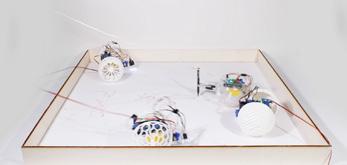

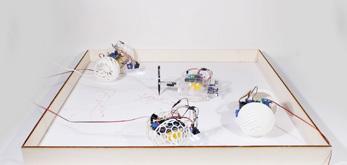


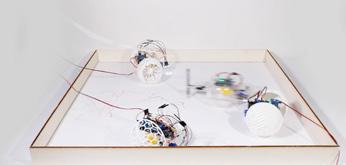
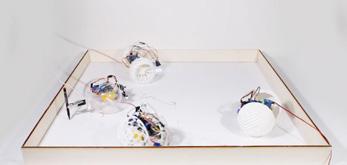
AEOLIAN | AGENT | 332 |
0:00:00 0:00:01 0:00:02 0:00:03 0:00:06 0:00:07 0:00:09 0:00:10
COMMUNICATION | ITERATION 2
Agents leave a trace or line, other agents should recognise and follow the line which represents the black line. Implemented system allows agents not only to sense and follow the trail from the leading agent but also to leave the new trail for other agents to follow, demonstrating the stigmergy behaviour among robots.
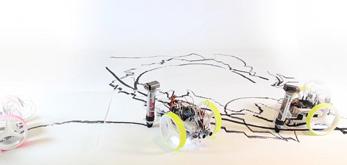
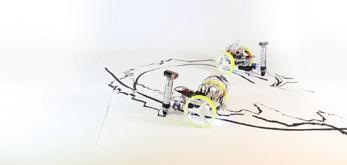

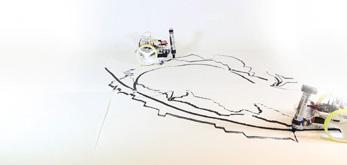

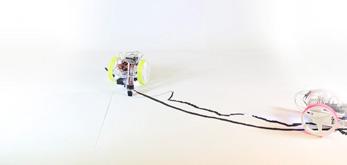
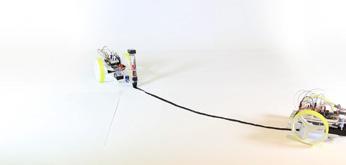

AEOLIAN | AGENT | 333 |
0:00:01 0:00:02 0:00:05 0:00:09 0:00:12 0:00:15 0:00:17 0:00:18
 Robots’ Drawing from Iteration 1
Robots’ Drawing from Iteration 1
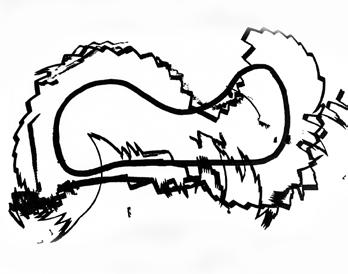
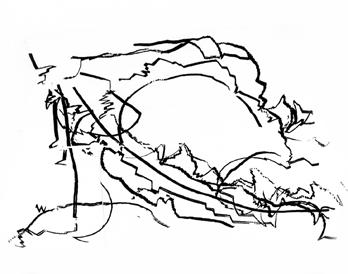
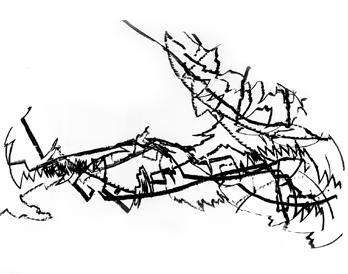

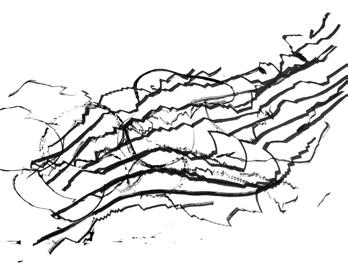
AEOLIAN | AGENT | 335 |
2
Robots’ Drawing from Iteration
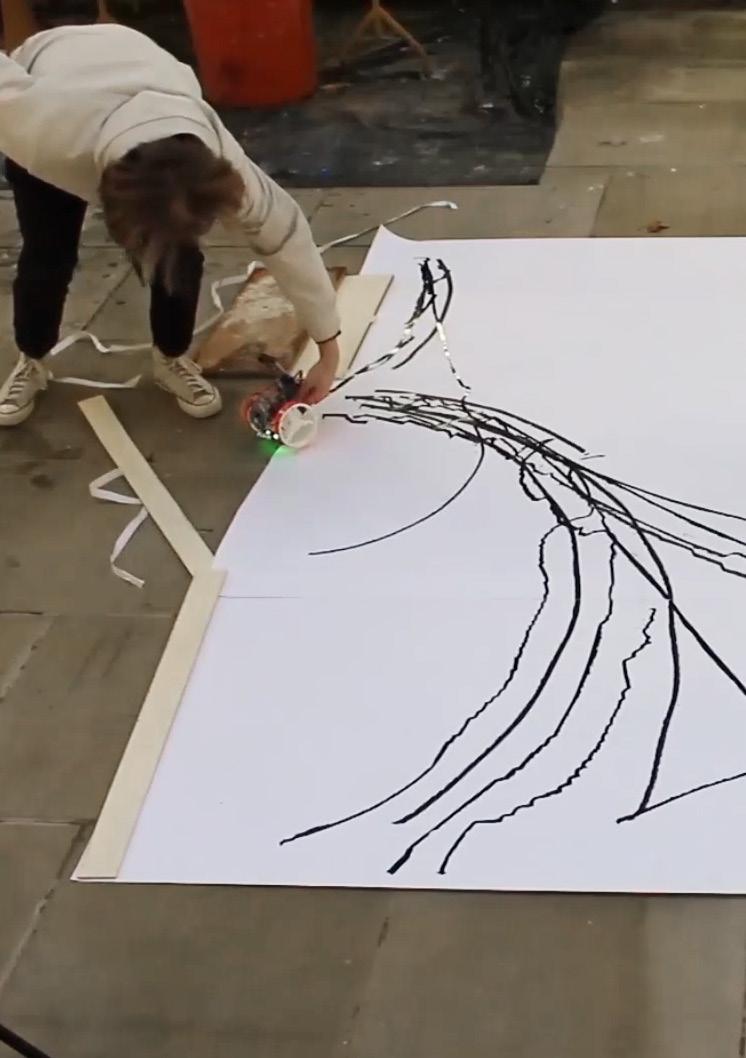
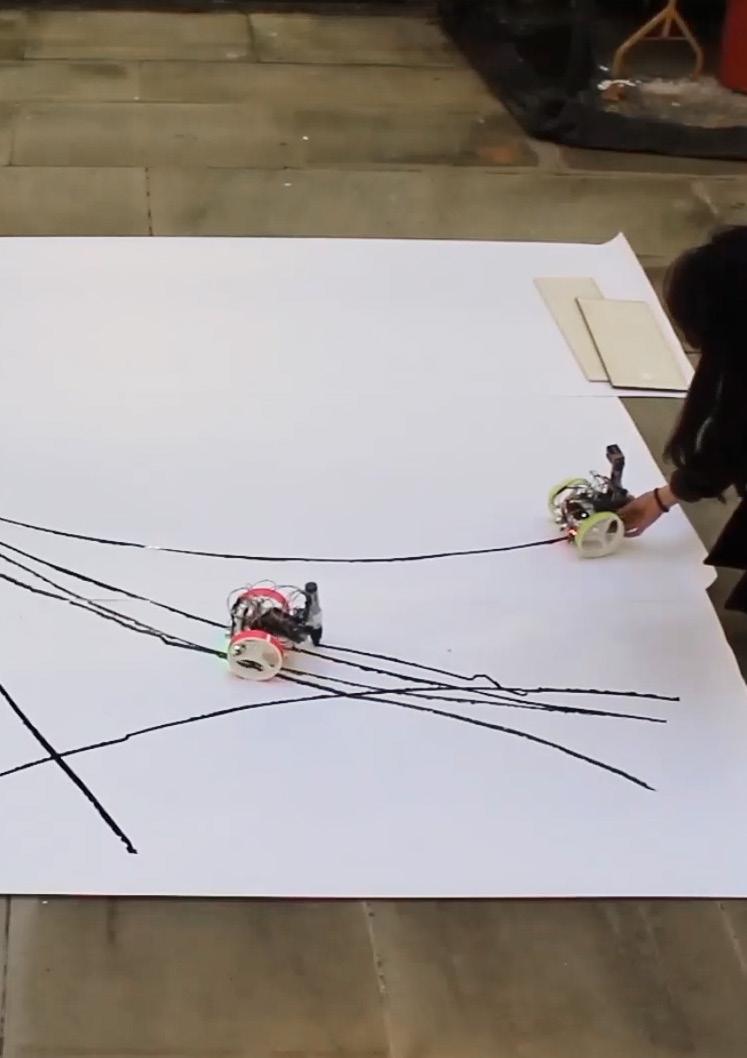
DRAWING COMMUNICATION | ITERATION 2 | LARGE SCALE
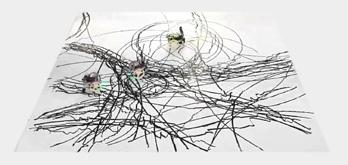


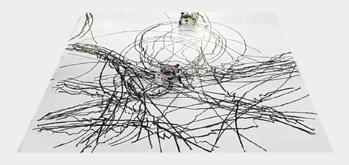
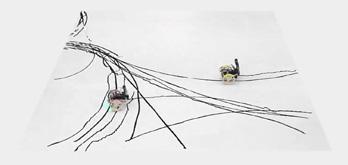
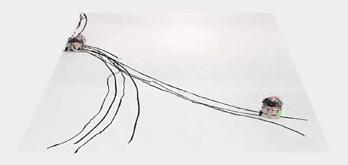

The robots collaboration test was conducted on a larger scale in an outdoor setting. The robots were launched from various locations to evaluate their behaviour and reactions to the lines drawn by other robots. This test serves as a demonstration of collective behaviour resulting in stigmergic pattens, in which the robots coordinate their actions through the modification of their environment.

AEOLIAN | AGENT | 338 | 0:00:00 0:00:40 0:01:25 0:02:10 0:02:50 0:03:40 0:04:43 0:05:25
 Robots’ Drawing from Large Scale
Robots’ Drawing from Large Scale
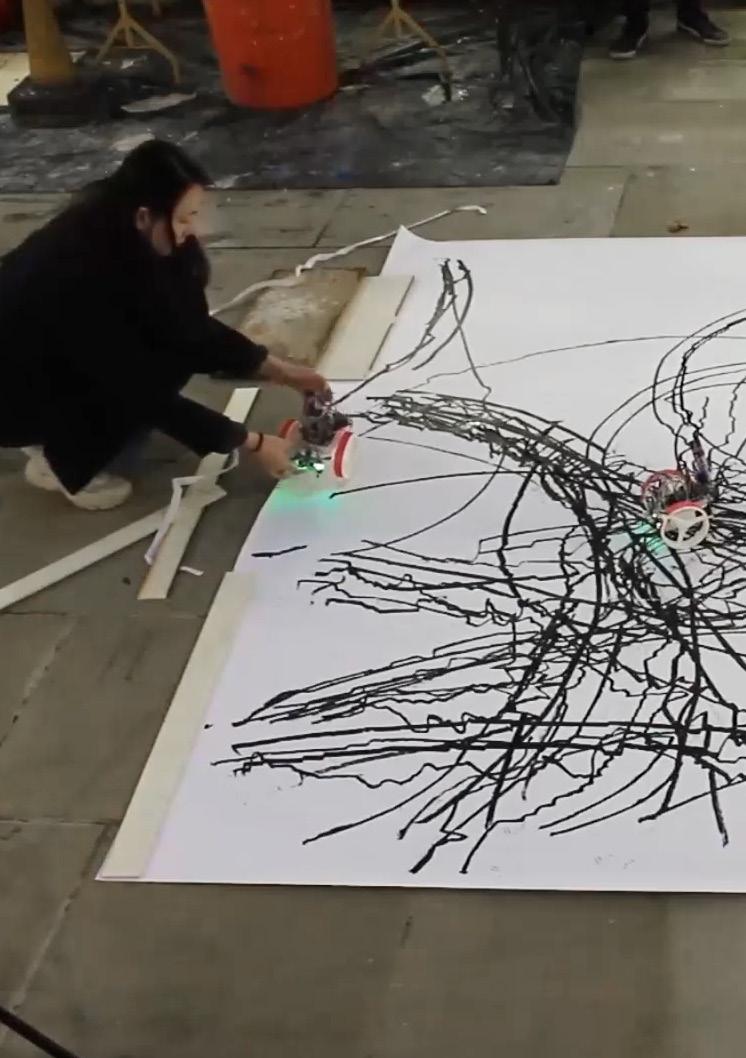

COLOUR DATA
COLOUR SENSING | ITERATION 1



During this experiment, the agent follows the blue light and turns in that direction by using the colour sensor located in front.

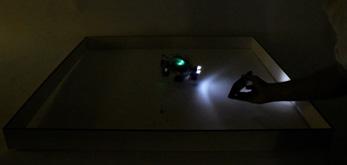
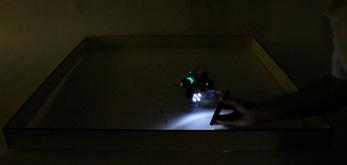
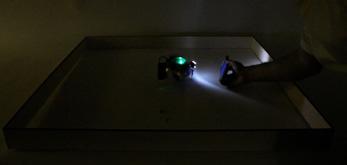

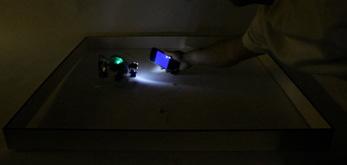
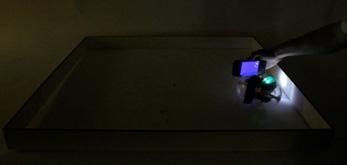
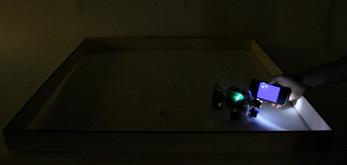
AEOLIAN | AGENT | 342 |
Sense React Look left / Look right Move foward to Blue light Check 0:00:00 0:00:01 0:00:02 0:00:03 0:00:04 0:00:05 0:00:06 0:00:07
COLOUR MAP ANALYSIS | ITERATION 2



The agent reacts to the colour map which represents the landscape. When the colour sensor senses blue or green, the robot shifts the maker down and draws the line. If it’s red, it lifts the marker and no line is drawn. The strategy lets the agents to decide where they need to draw a line based on the landscape analysis.
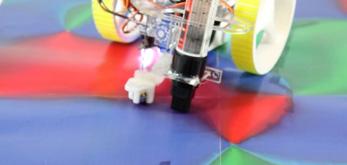


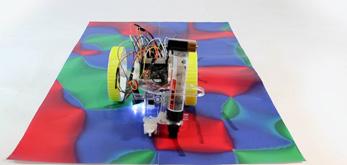

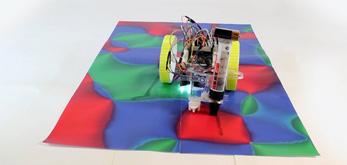
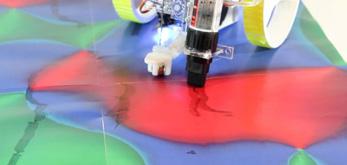
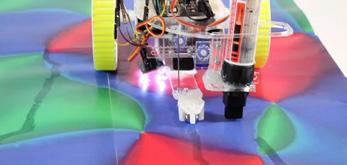
AEOLIAN | AGENT | 343 |
Sense React Drawing Check Not Drawing Blue Red 0:00:01 0:00:02 0:00:05 0:00:07 0:00:12 0:00:14 0:00:17 0:00:20
COLOUR DATA
COLOUR MAP ANALYSIS | ITERATION 2 | LARGE SCALE
The printing paper is a representation of the landscape. When the robot is moving on top of the red area, it draws the line. If it’s on a green colour, the robot elevates the marker and does not draw.
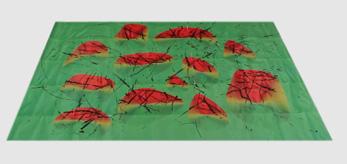
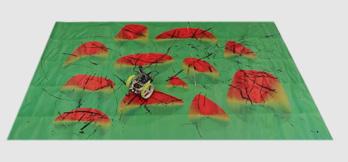
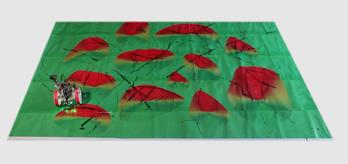
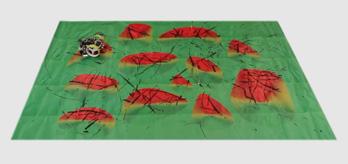
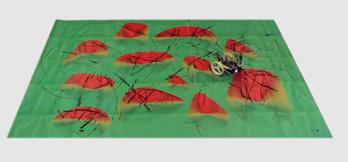
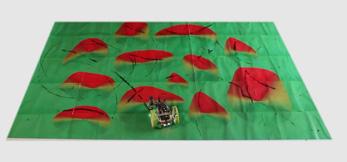
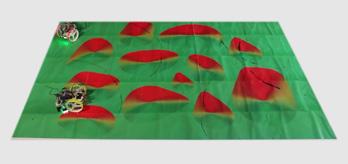

AEOLIAN | AGENT | 344 | 0:00:00 0:01:50 0:02:50 0:03:50 0:04:10 0:05:30 0:06:20 0:07:35

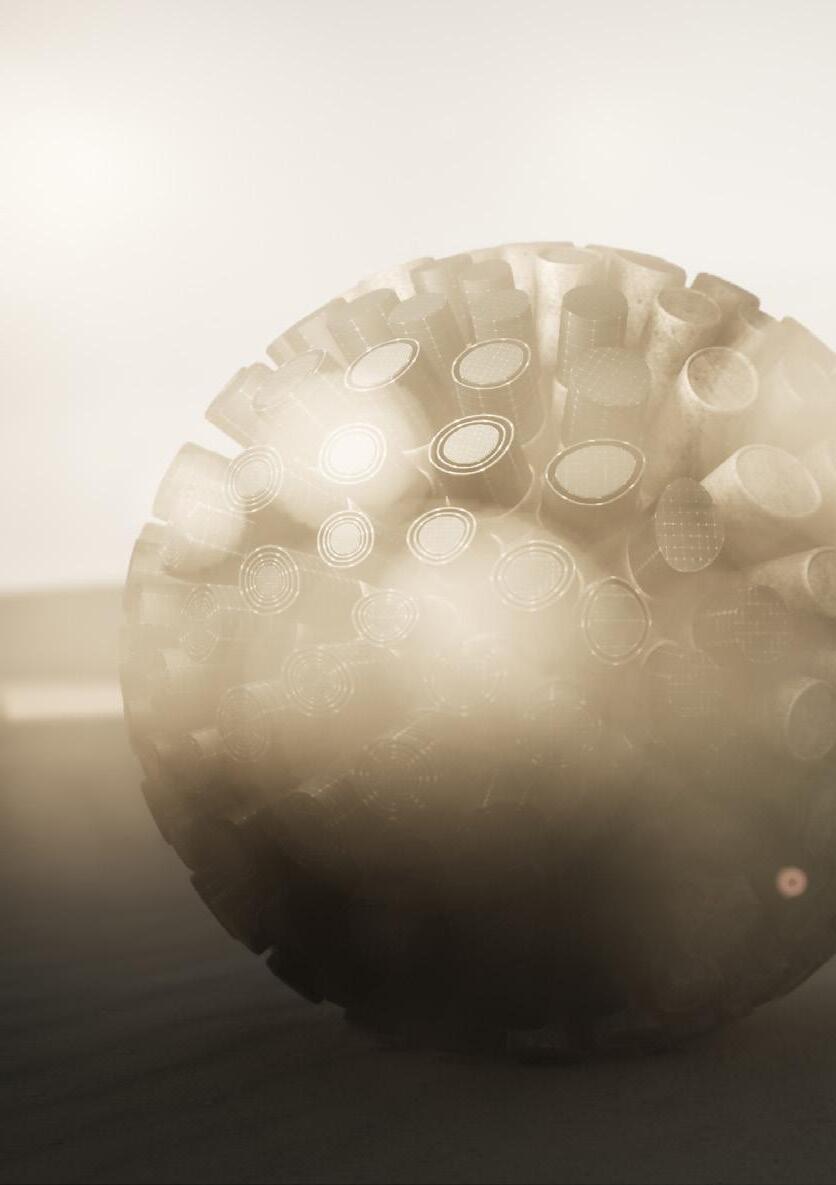

AGENT DIGITAL PROTOTYPE
AGENT BEHAVIOUR
The goal of the agent is to fuse sand into glass, fabricating the structure in the desert. The agent itself employs a range of behaviours, it needs to analyse locally the landscape, communicate with other agents, move on top of sand, fuse the sand and harness energy.

AEOLIAN | AGENT | 348 |
The agent has a primitive form of a sphere, which allows it to roll in all directions. It consists of nodes which make frequency for the movement. Different density of nodes are used for different environments.
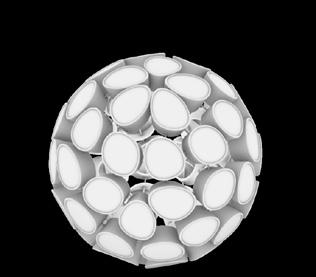
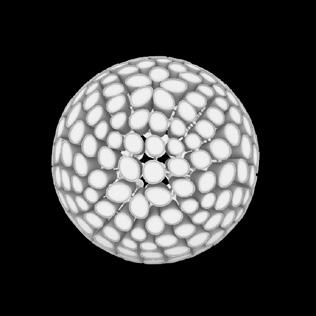
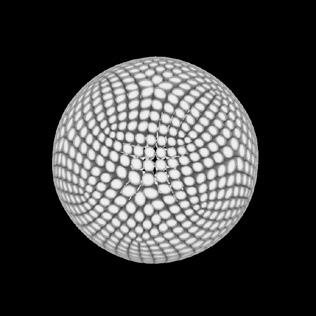
AEOLIAN | AGENT | 349 |
AGENT
MOTION FLEXIBILITY

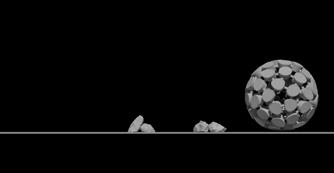
The agent consists of multiple nodes connected together with a spring system, which allows it to be flexible and deform according to obstacles.
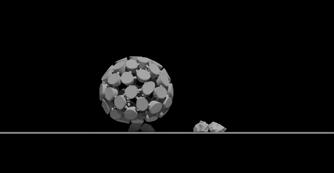

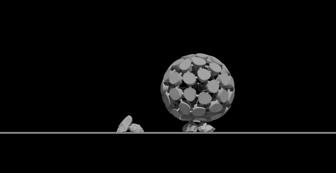
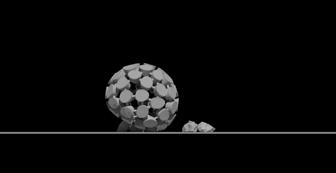
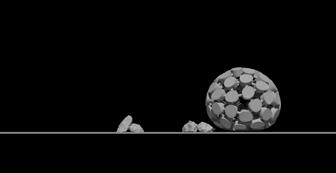
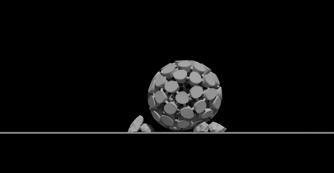
AEOLIAN | AGENT | 350 |
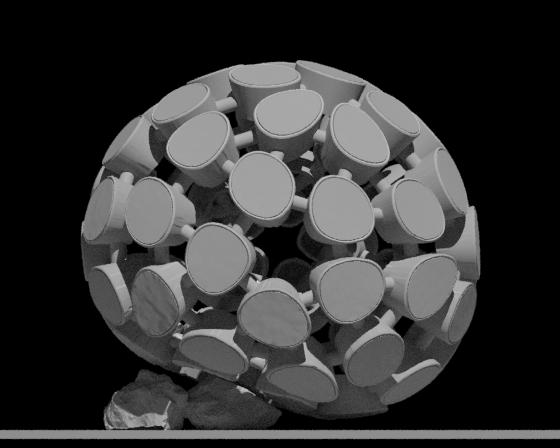
AEOLIAN | AGENT | 351 |
AGENT
MOTION FLEXIBILITY
The spring system allows the robot to overcome obstacles and act as a soft body.


AEOLIAN | AGENT | 352 |
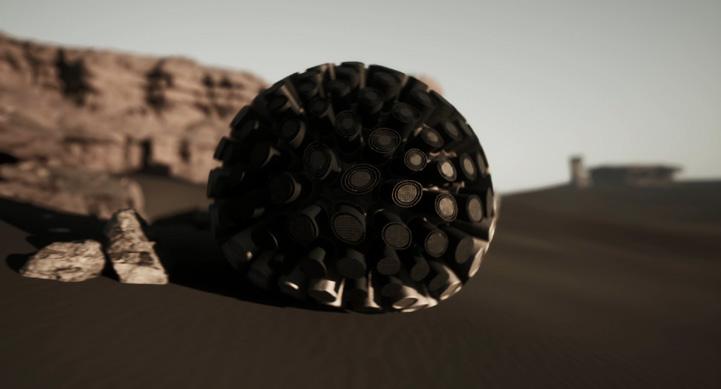
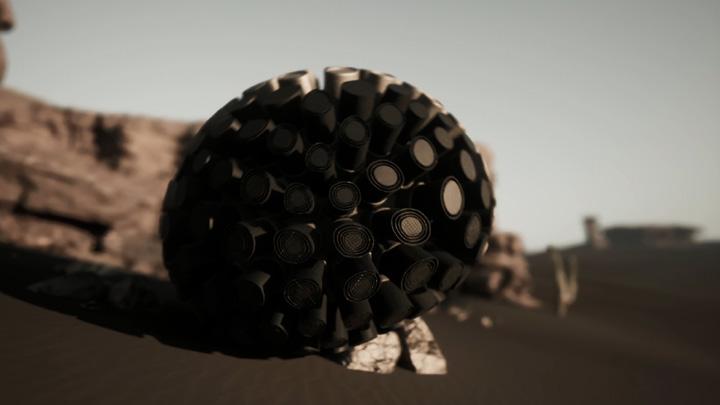
AEOLIAN | AGENT | 353 |
PROTOTYPE SPRING SYSTEM
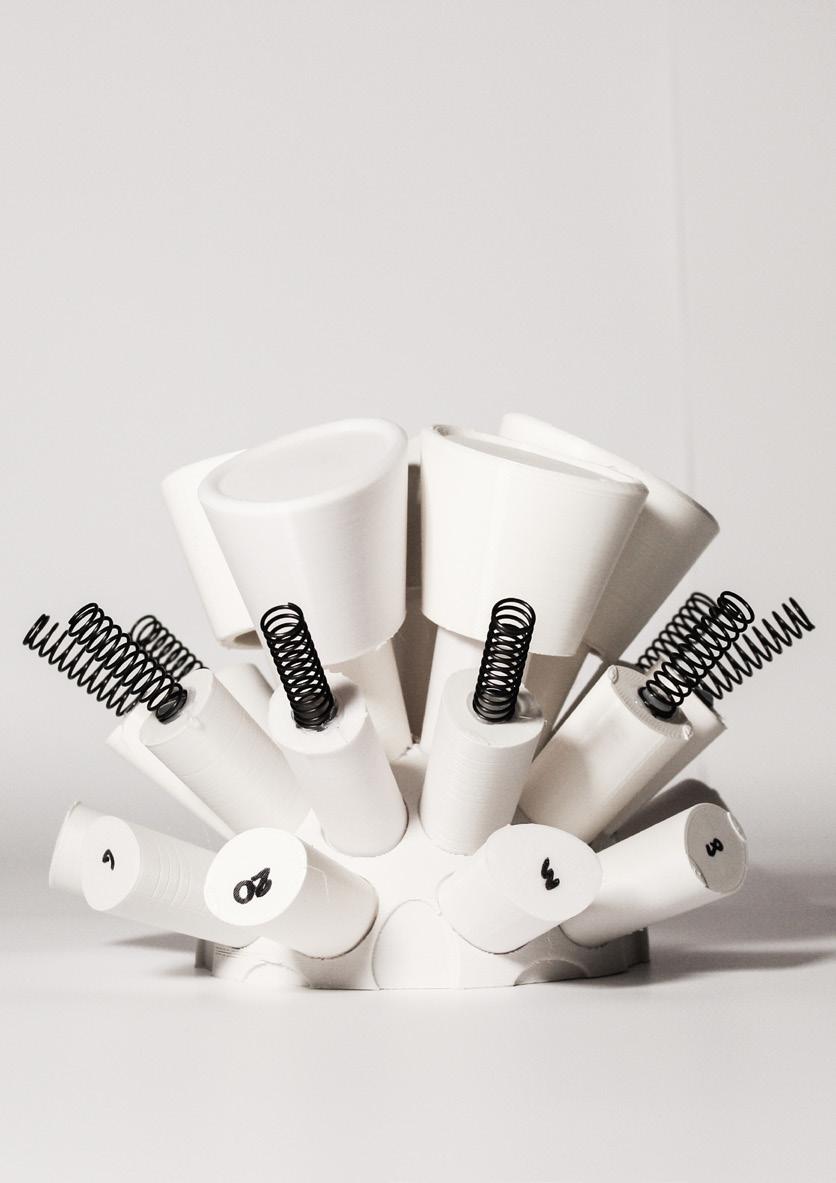
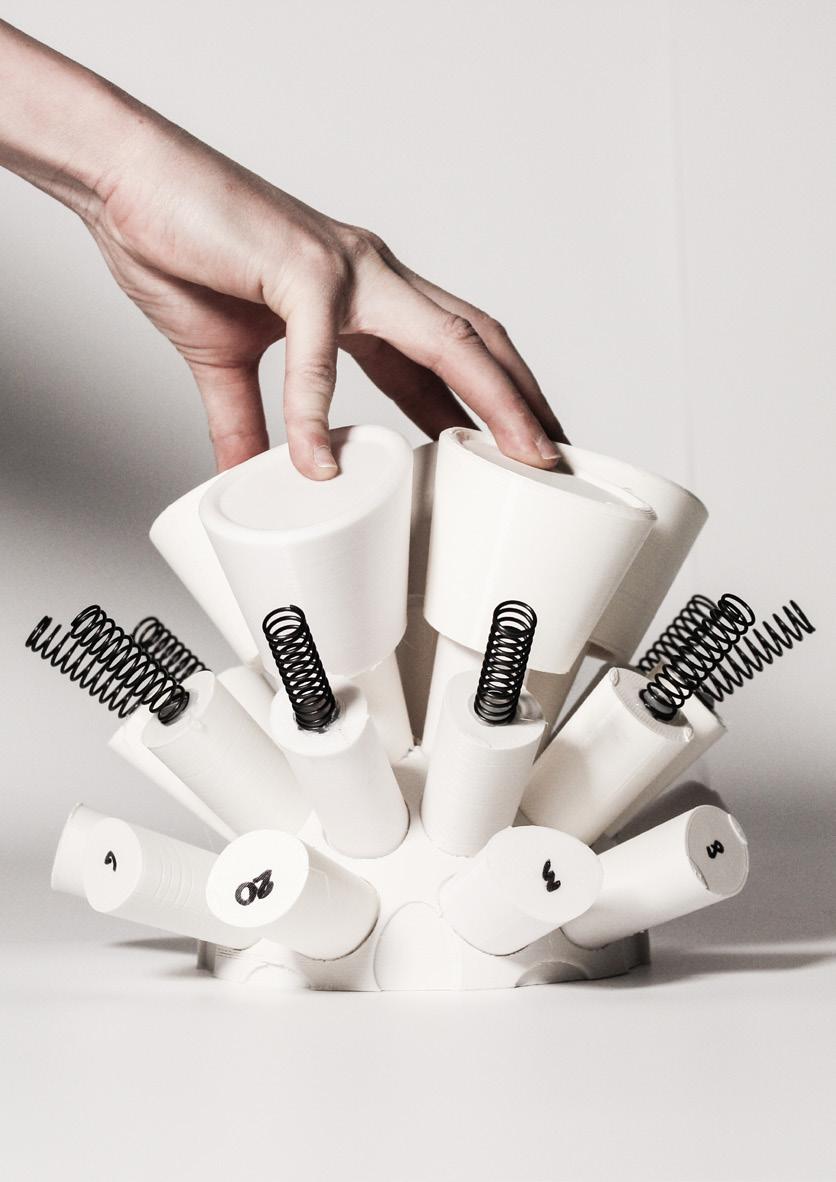
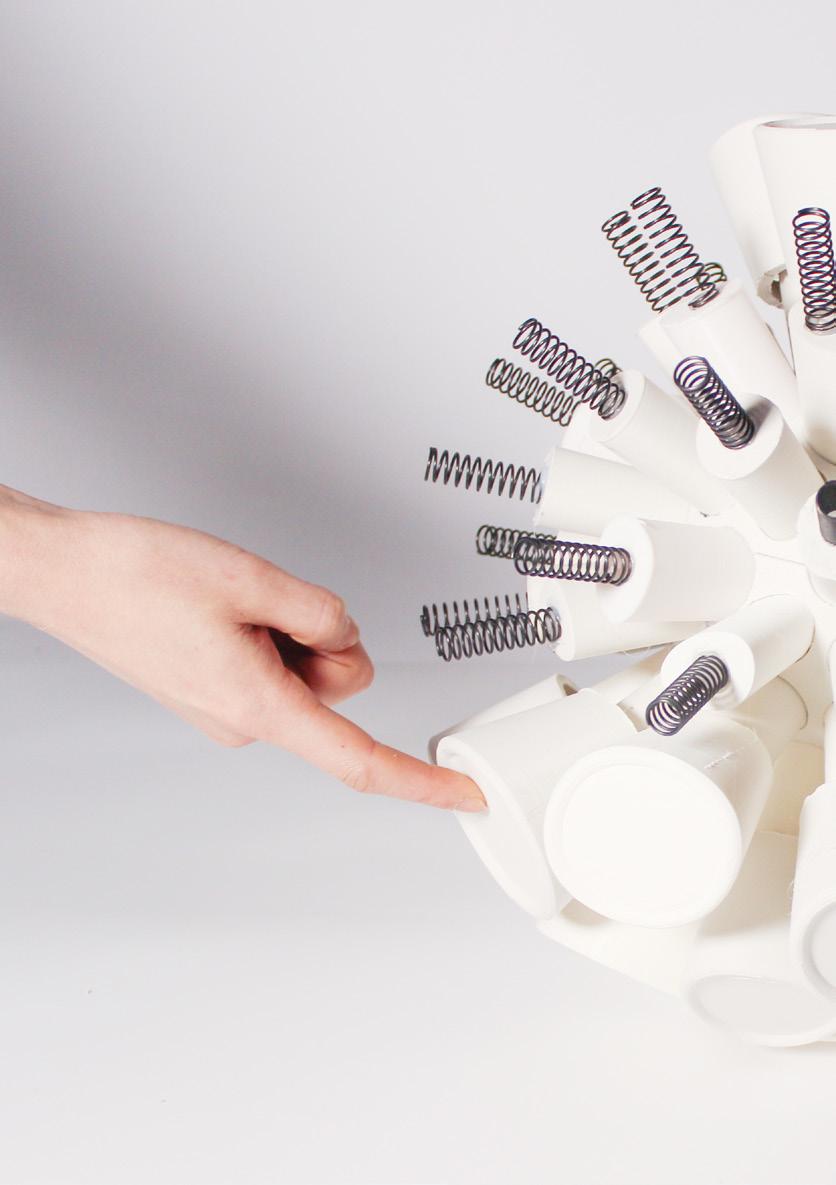

EXPLOSION DIAGRAM
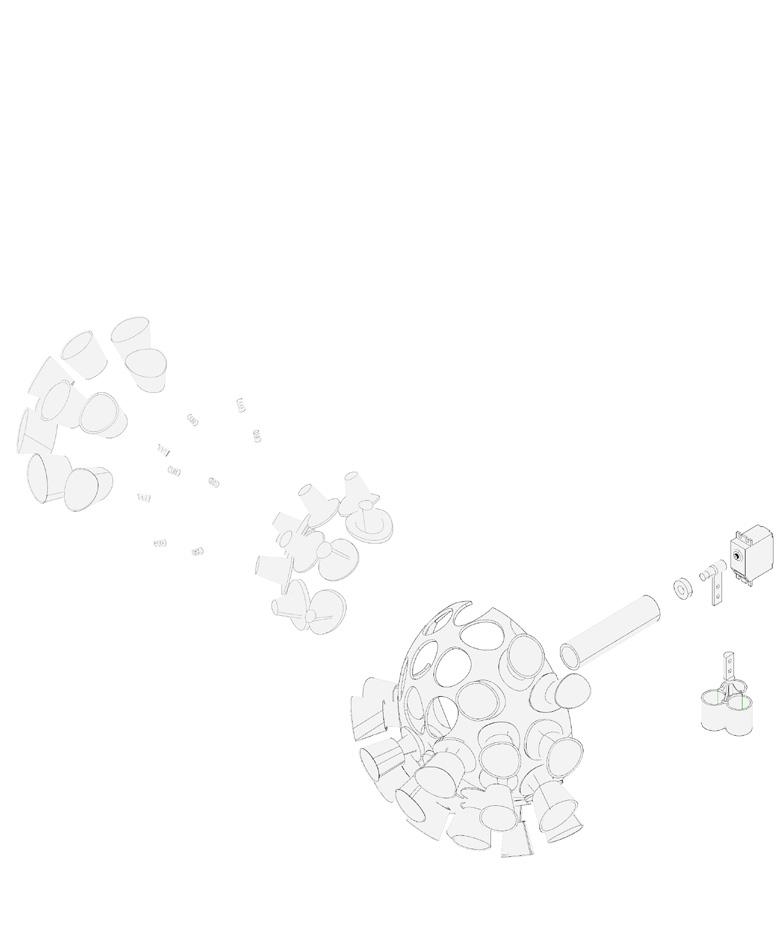
The physical model was designed to simulate the movement of the agents by adjusting the weight hanging from the centre. As the weight rotates around the centre the centre of mass changes, causing the entire sphere to roll. To further emulate the soft-body behaviour of the agents, bouncing components with spring attachments were added to the sphere.
1 SPHERE STRUCTURE
2 CONNECTOR
3 BALL BEARING
4 SERVO
5 9 V BATTERIES
6 ARDUINO
7 WEIGHT 200g
8 BASE STRUCTURE
9 SPRING
10 BOUNCING COMPONENT
AEOLIAN | AGENT | 358 |
4 3 2 7 1 8 9 10
BOUNCING COMPONENTS
Stable

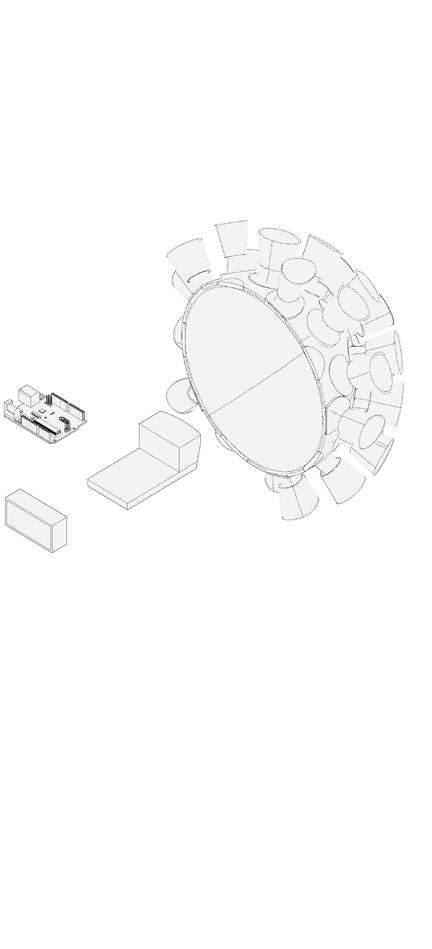
Changing Weight
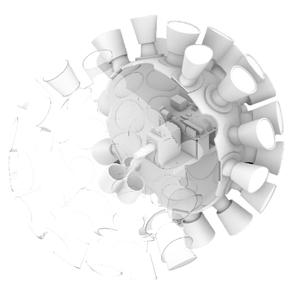
Moving forward

AEOLIAN | AGENT | 359 | 6 5 2
ROBOT PROTOTYPE PHYSICAL MODEL

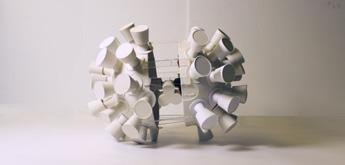

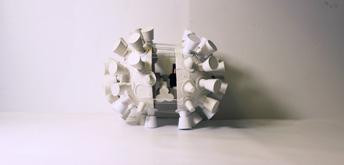

The robot employs arduino platform and servo to turn weight to force the whole object to roll.
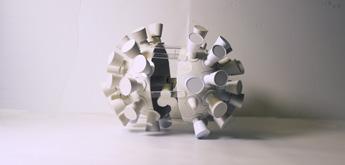


AEOLIAN | AGENT | 360 | 0:00:00 0:00:10 0:00:15 0:00:20 0:00:25 0:00:30 0:00:35 0:00:40

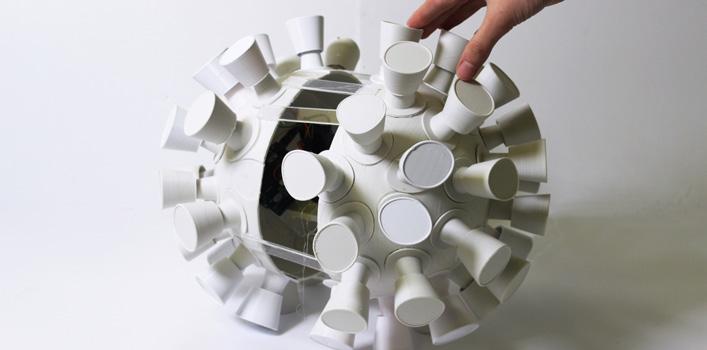
AEOLIAN | AGENT | 361 |
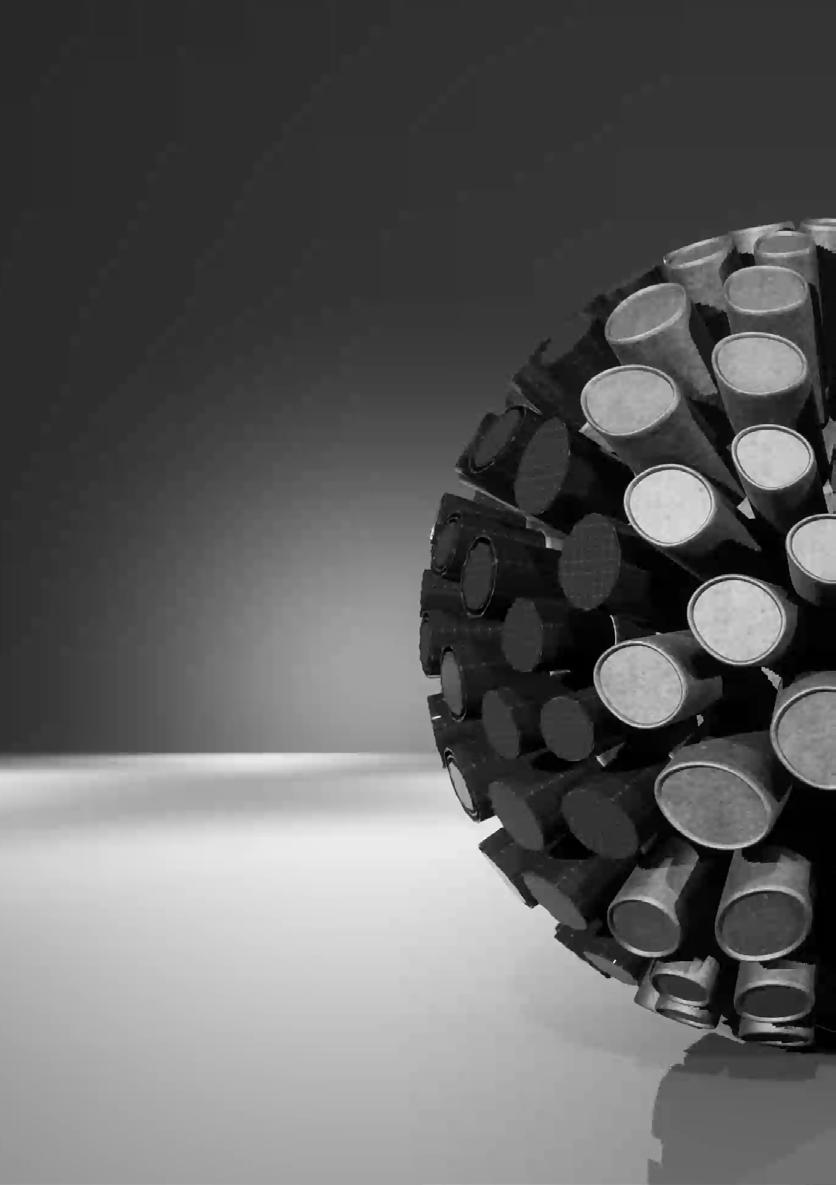

AGENT


BEHAVIOUR
The robot agent is a spherical device with a radius of 50cm. It can open to reveal its protective core, which houses the batteries, motors, and welding equipment. The robot also has sand collecting boxes that direct sand to the welding nozzle. Additionally, it has unfolding solar panels on top, and tubes on the sides that can expand, increasing the surface area for capturing photons. During the welding process, the nozzle moves along the x-axis, leaving a trace with a width of up to 60cm. Once the welding is completed, the robot can close itself and roll to the next welding location.

SAND COLLECTION BOX
BATTERIES
SENSORS

PROTECTION CORE


WELDING STATION
WELDING NOZZLE
AEOLIAN | AGENT
AGENT ENERGY


Desert’s environment provides constant access to solar energy, therefore the agent is autonomous harnessing it. The nodes on sides of the agent can expand, unfolding the tubes as a telescope, drastically increasing the surface area. The scale of the robot is generated based on the energy required to be harnessed. Together with unfolding solar panels, extending solar energy capturing tubes on sides reach area of 6.2m2. Which is enough for almost a non-stop welding process. The geometry of them is developed according to the ability of robot to have them employed while its moving. During the night or the sandstorm it can hide them back for protection
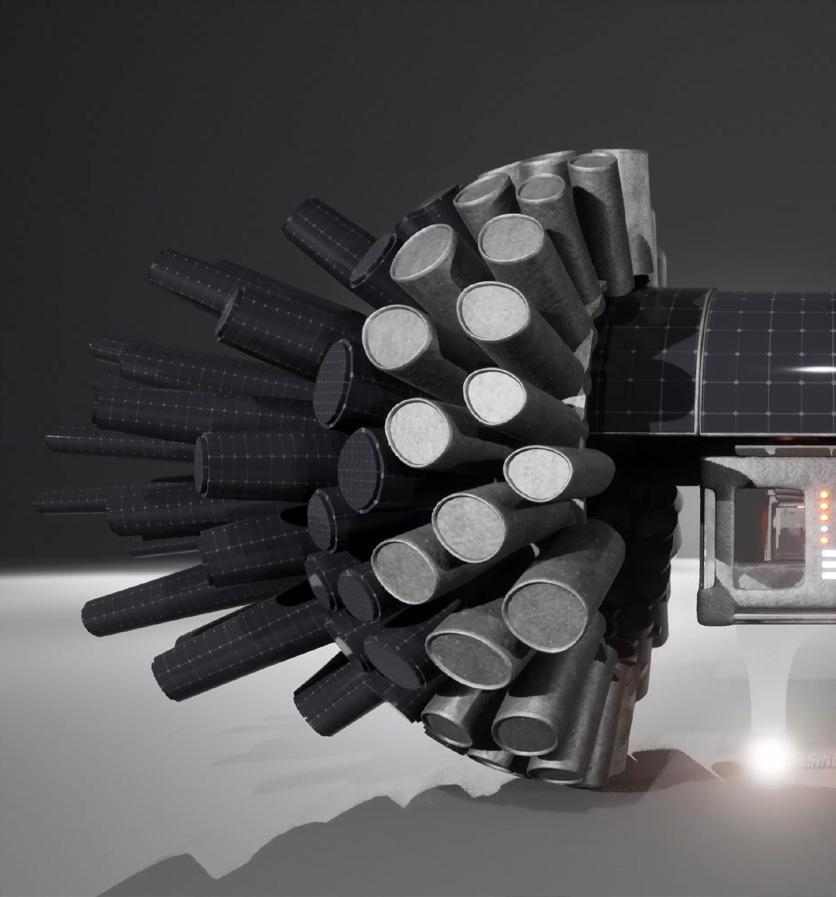
UNFOLDING SOLAR PANELS AREA = 0.42 M2
PNEUMATIC SOLAR PANELS AREA = 5.6 M2
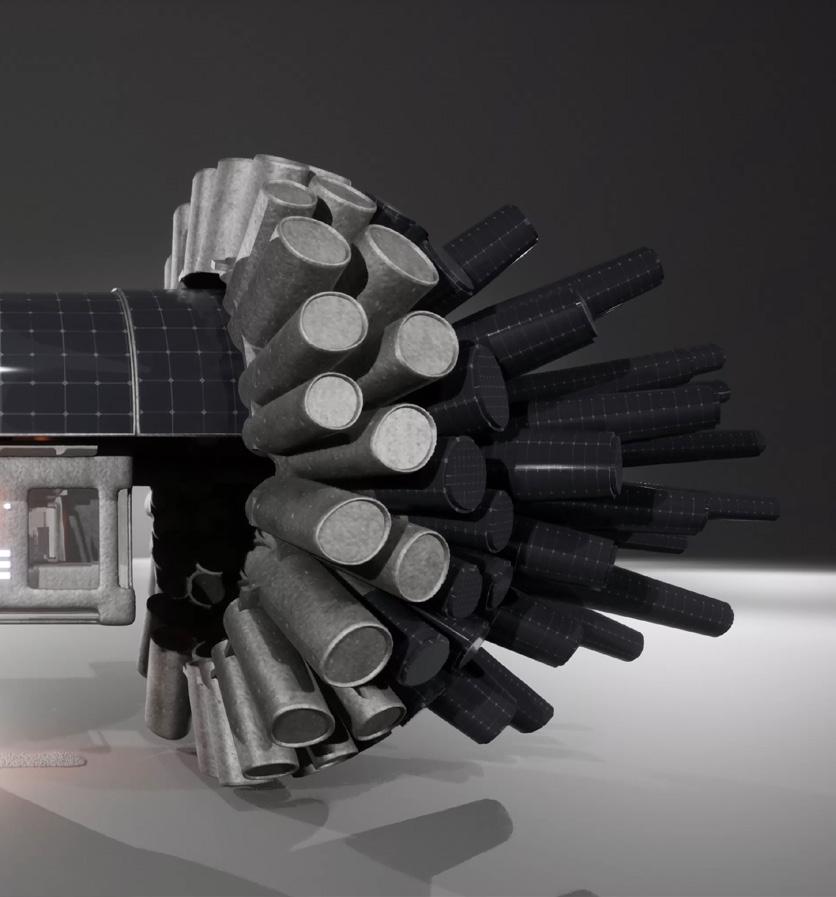
OVERALL SOLAR PANELS AREA = 6.2 M2


AEOLIAN | AGENT
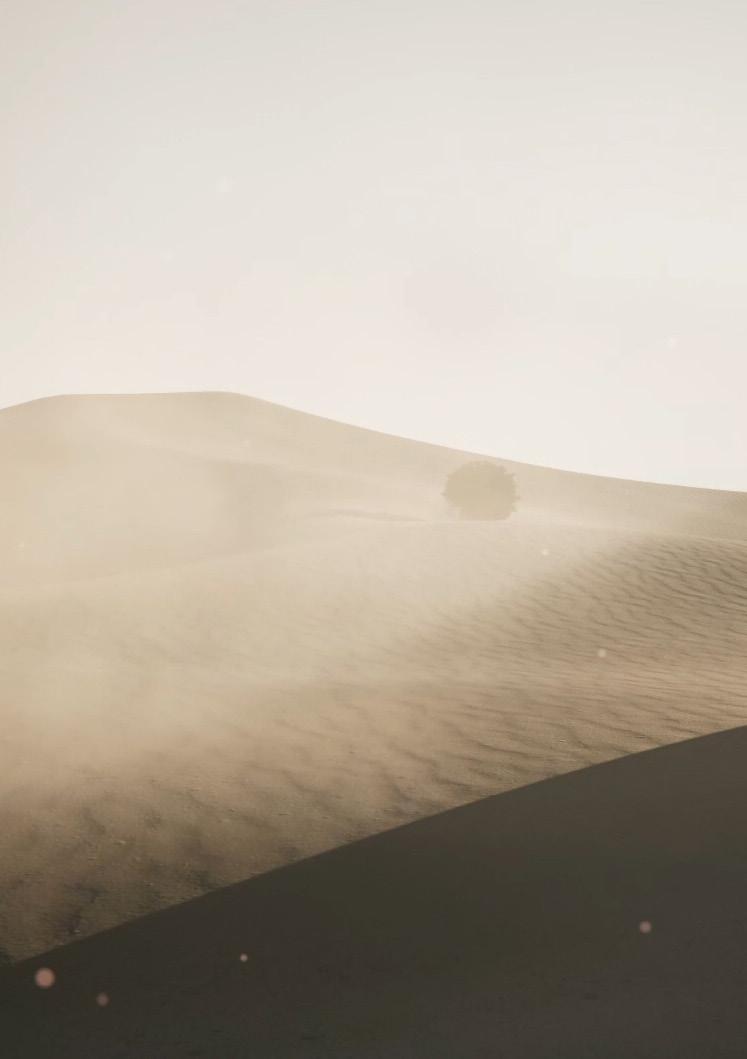
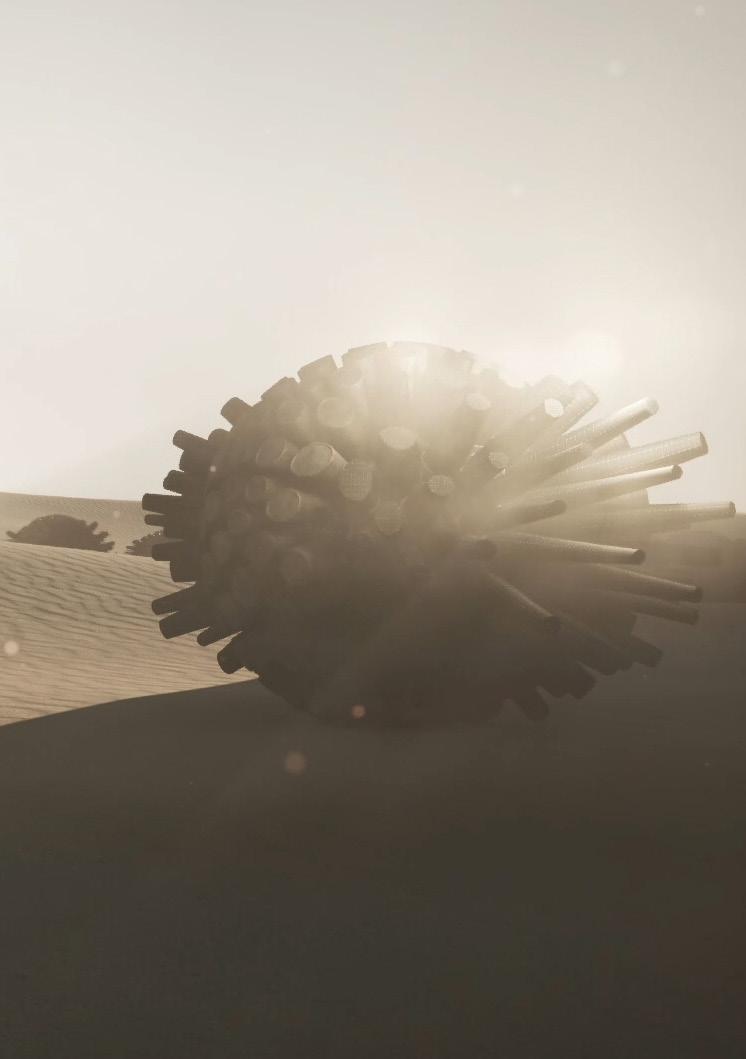
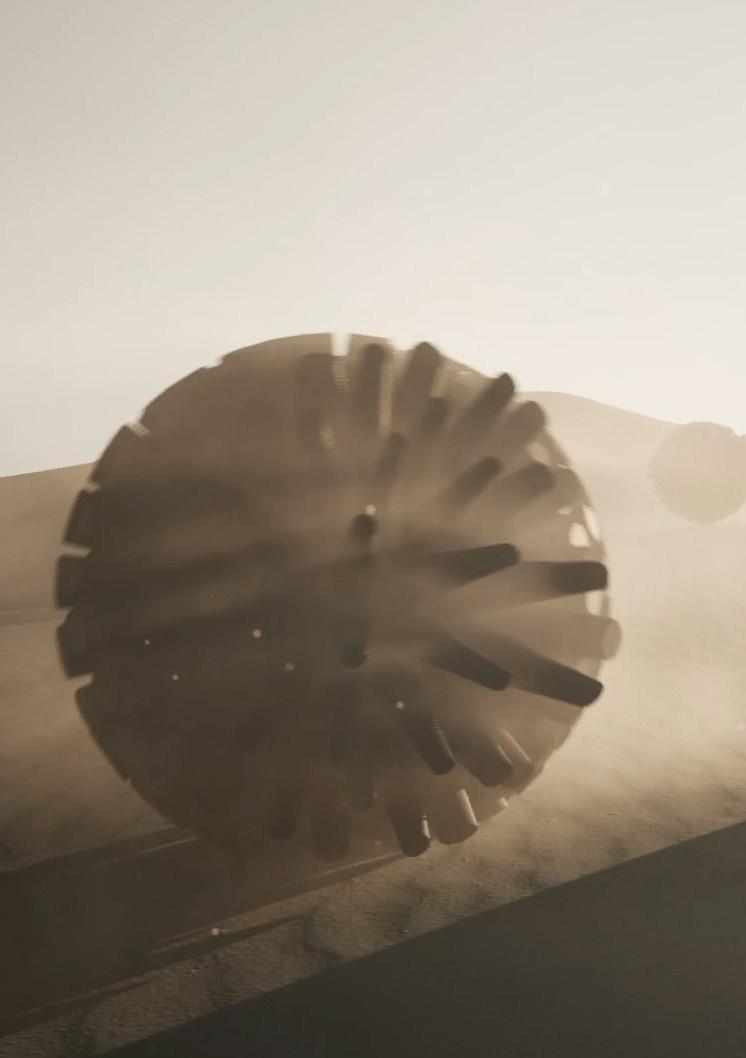

The robot has the ability to unfold nodes’ outer flat surface for digging function. Nodes located along the movement direction which touch the ground are turning their caps by 30 degrees to catch sand.


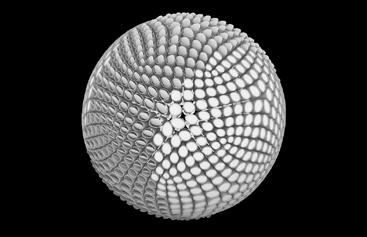
AEOLIAN | AGENT | 372 |
DIGGING
AGENT
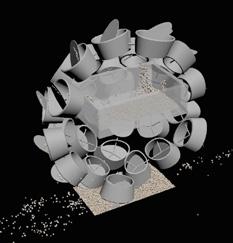
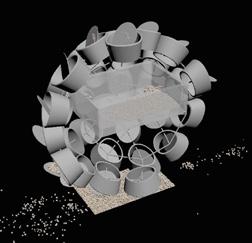
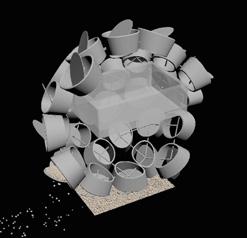

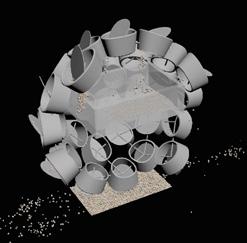

AEOLIAN | AGENT | 373 |
While rolling the agent catches sand with open blades and lifts it up. Located in the upper part, sand fall down by be gravity force. Purified sand is collected in containers to be used later.
AGENT DIGGING
While moving they collect sand particles and direct them into the sand collectors which in turn pure the sand close to the nozzle for welding on different from sand surfaces or for layering purposes.


AEOLIAN | AGENT | 374 |
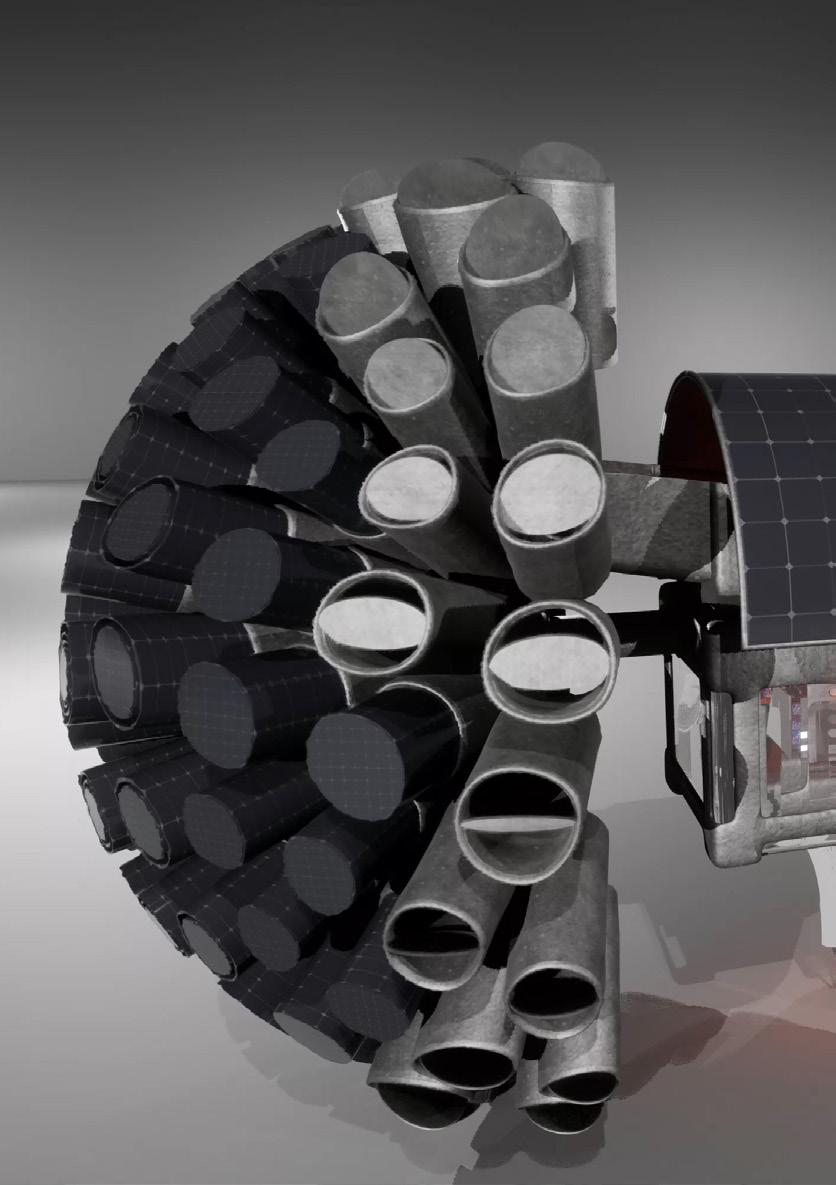
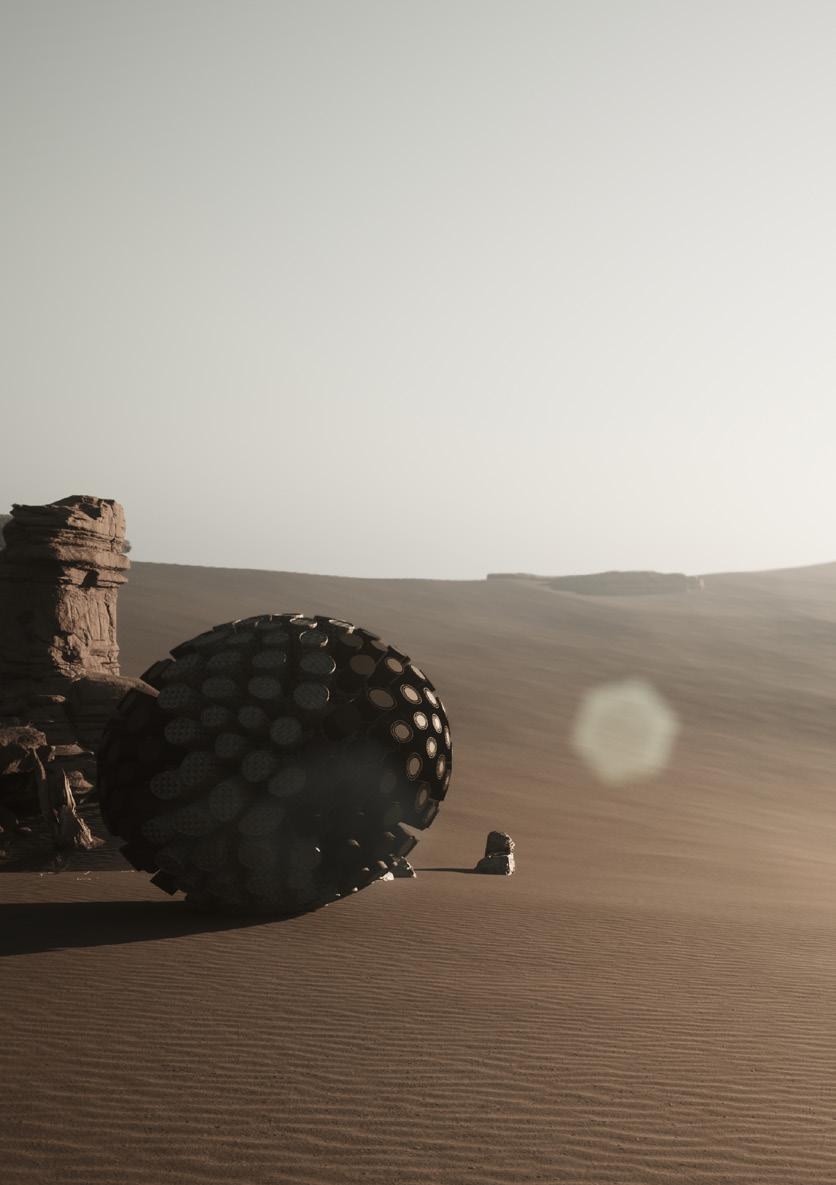

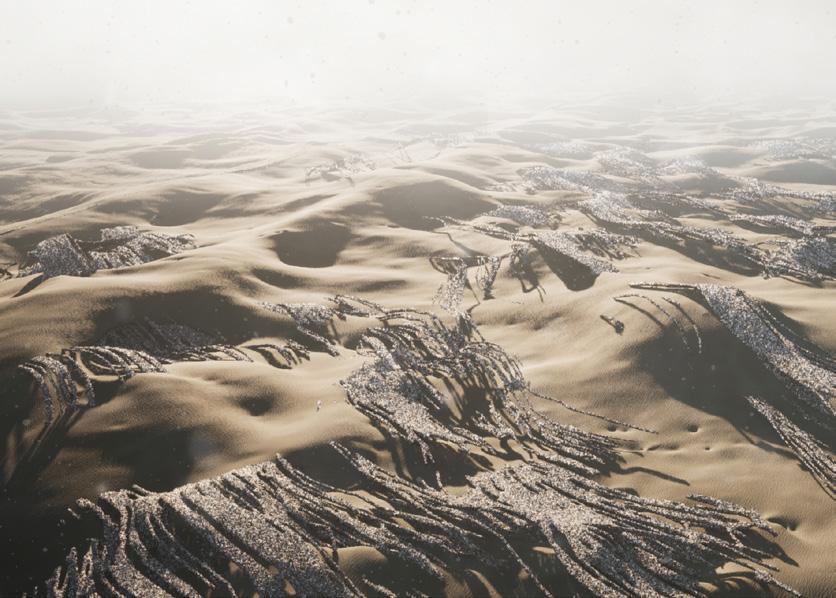
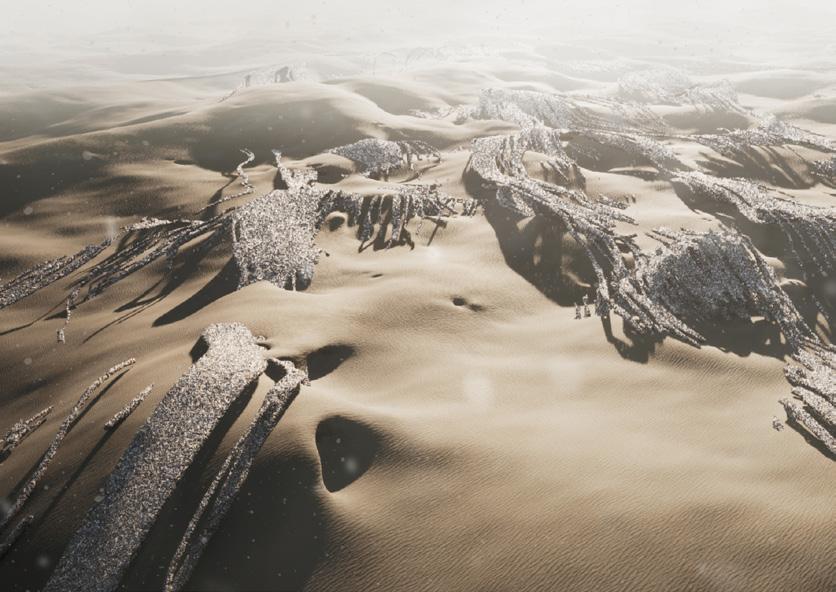
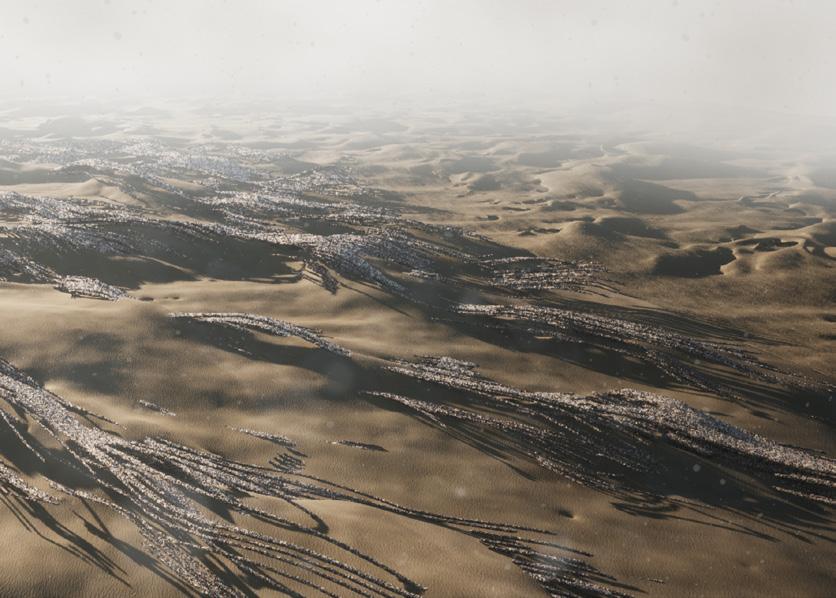


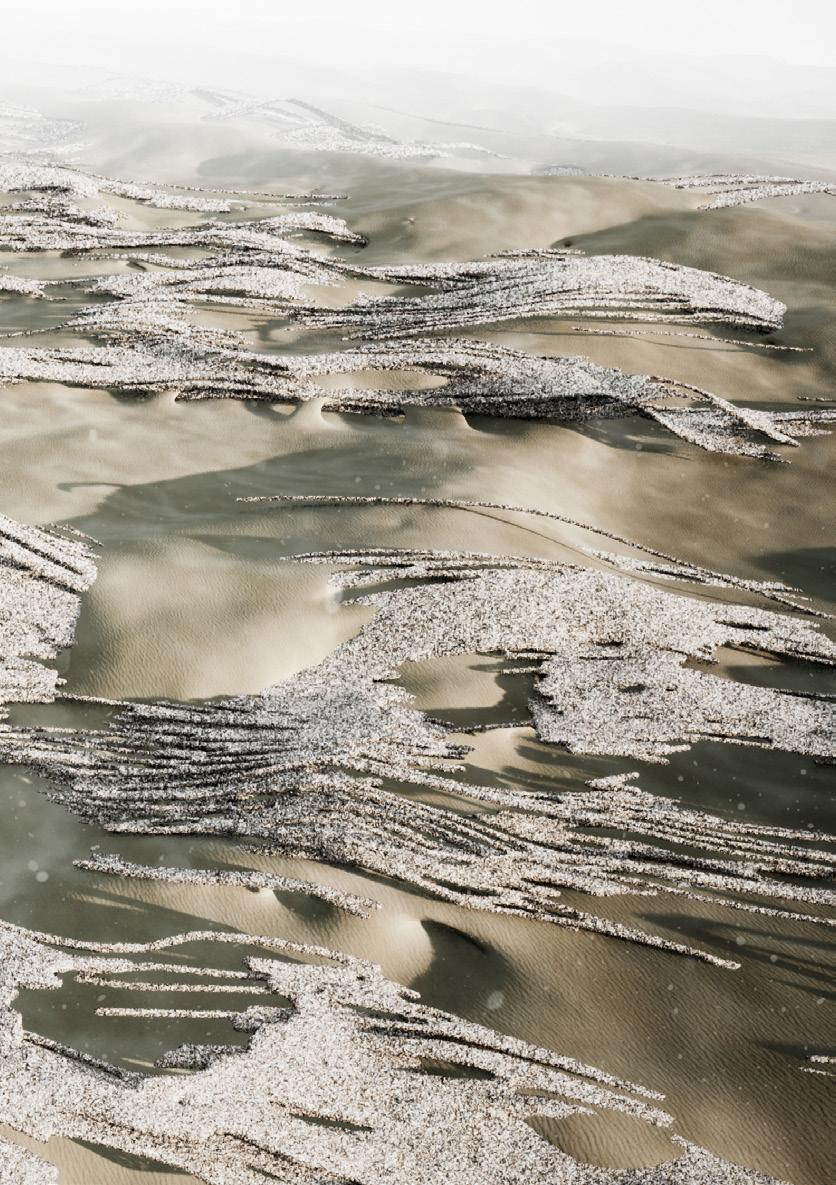
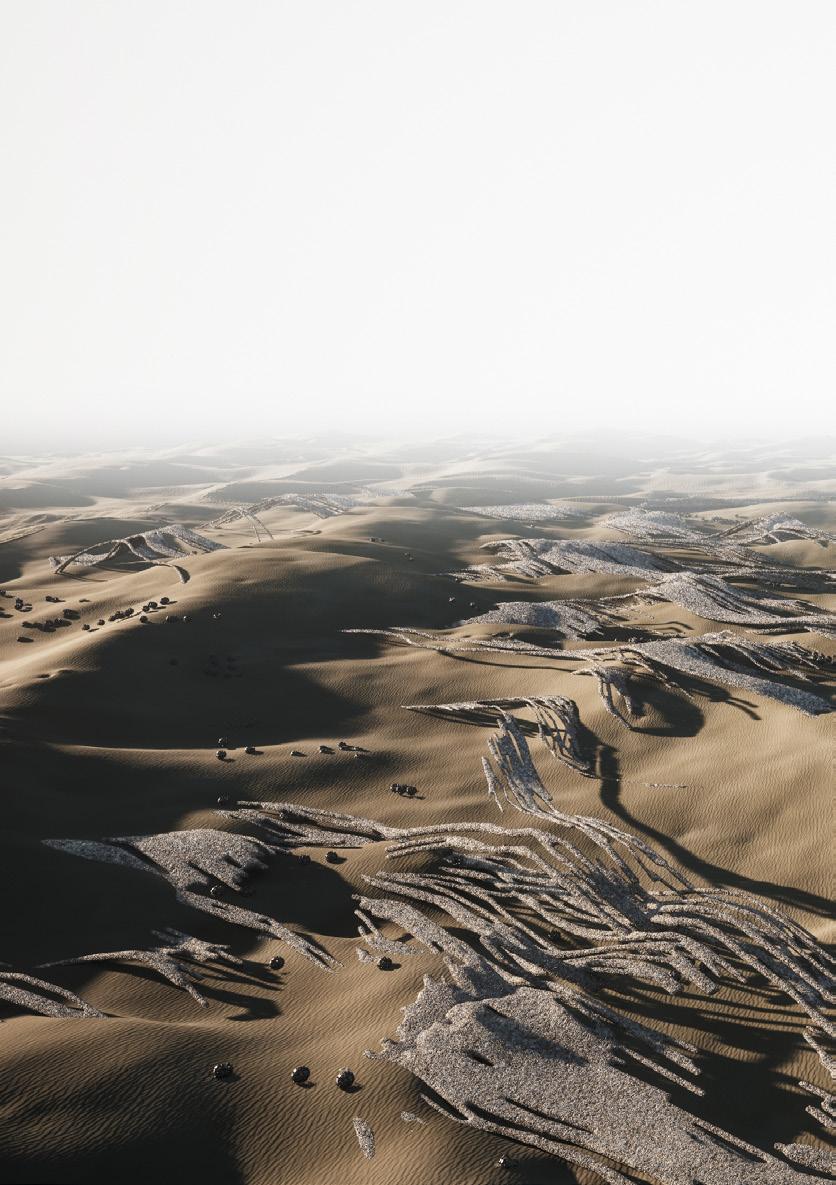
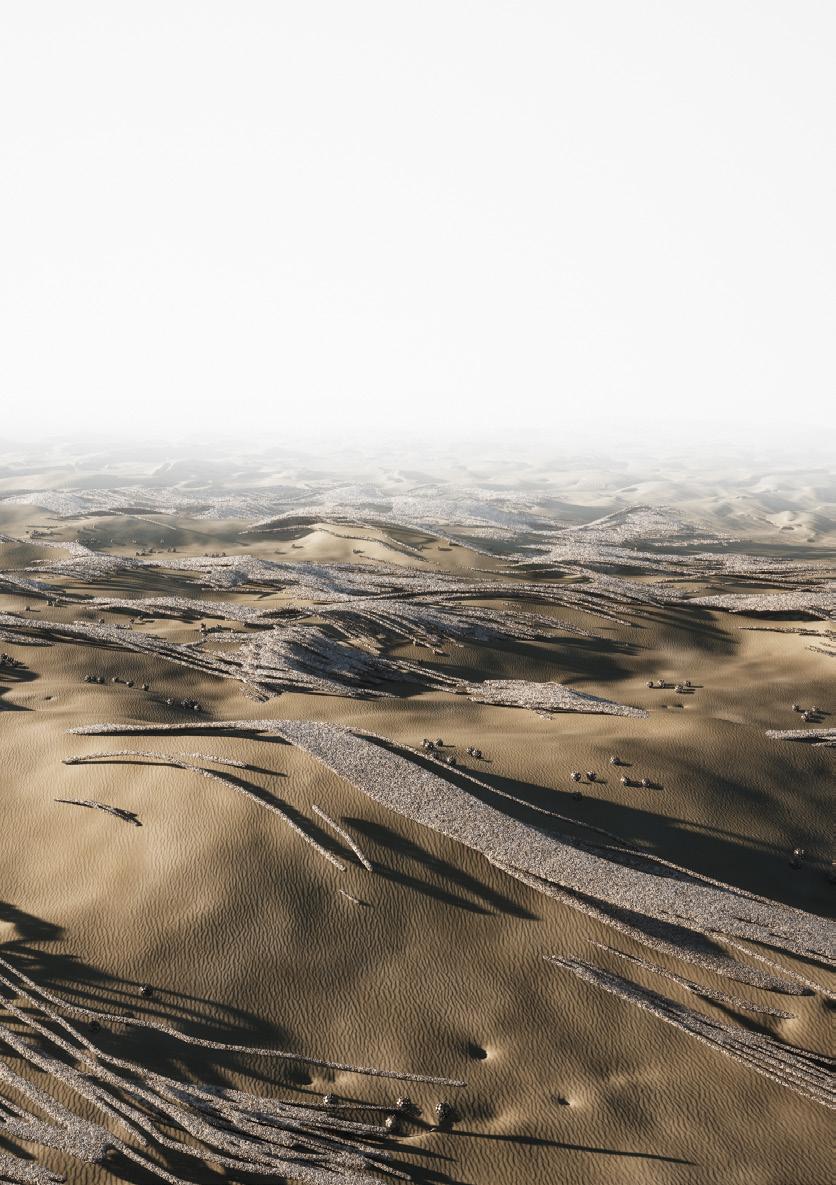
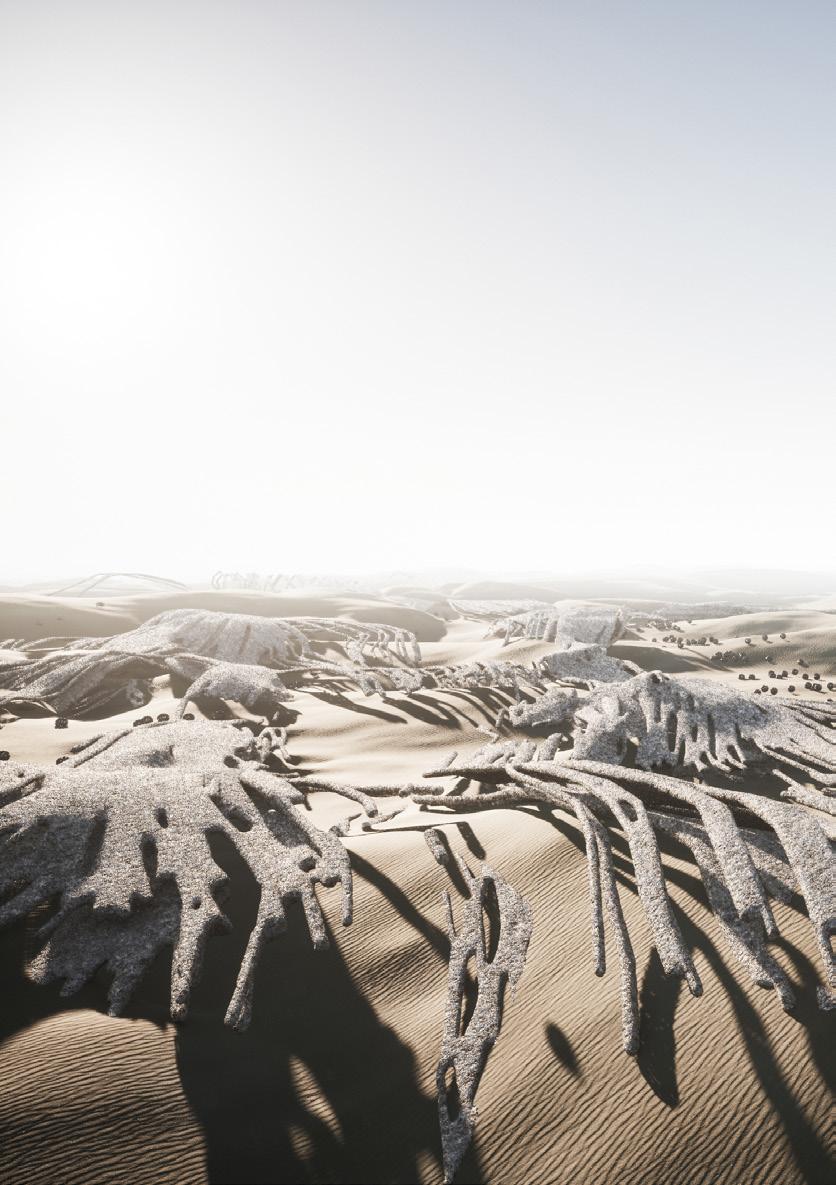
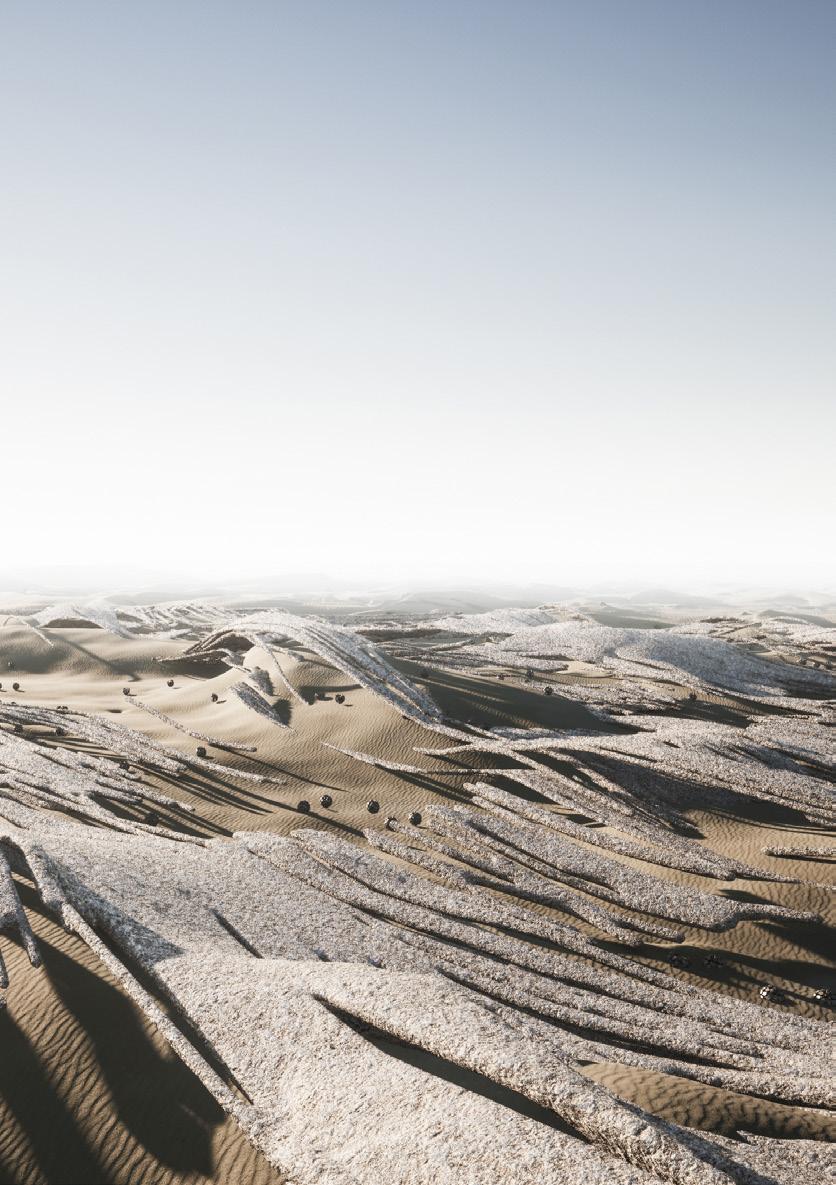
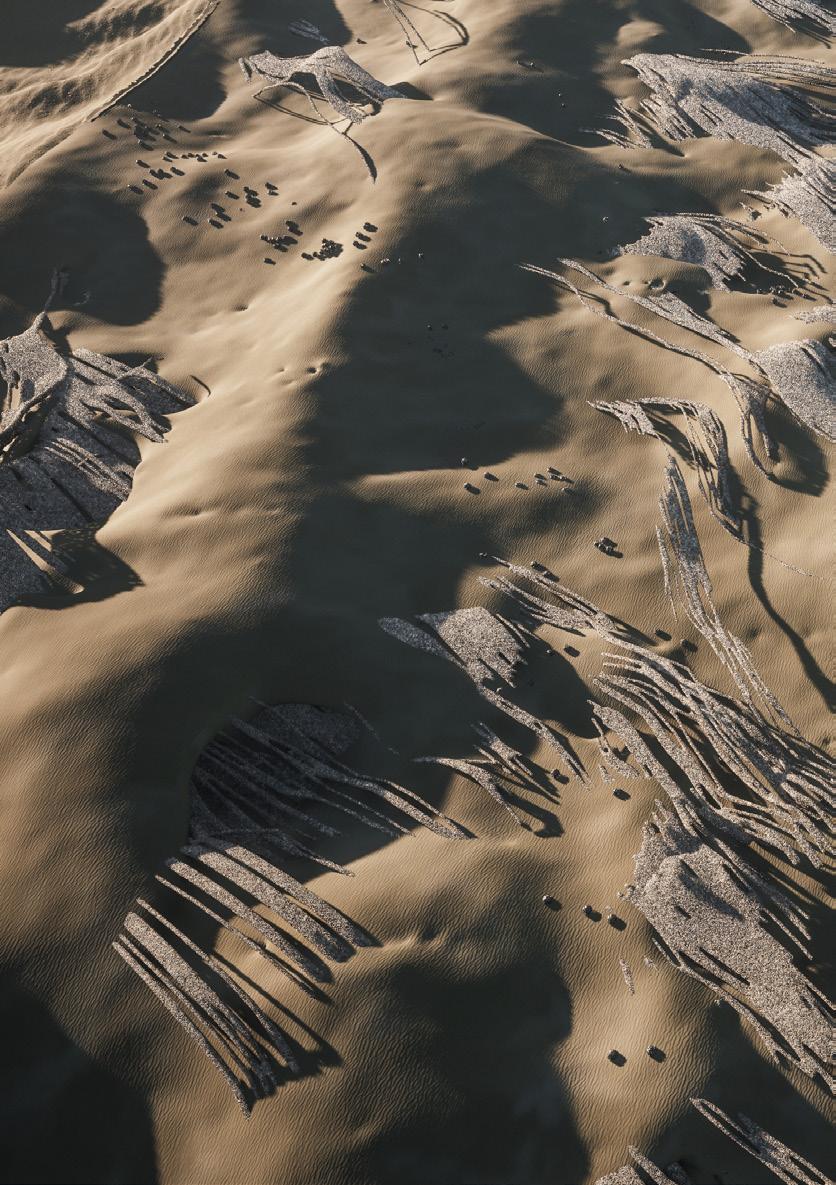
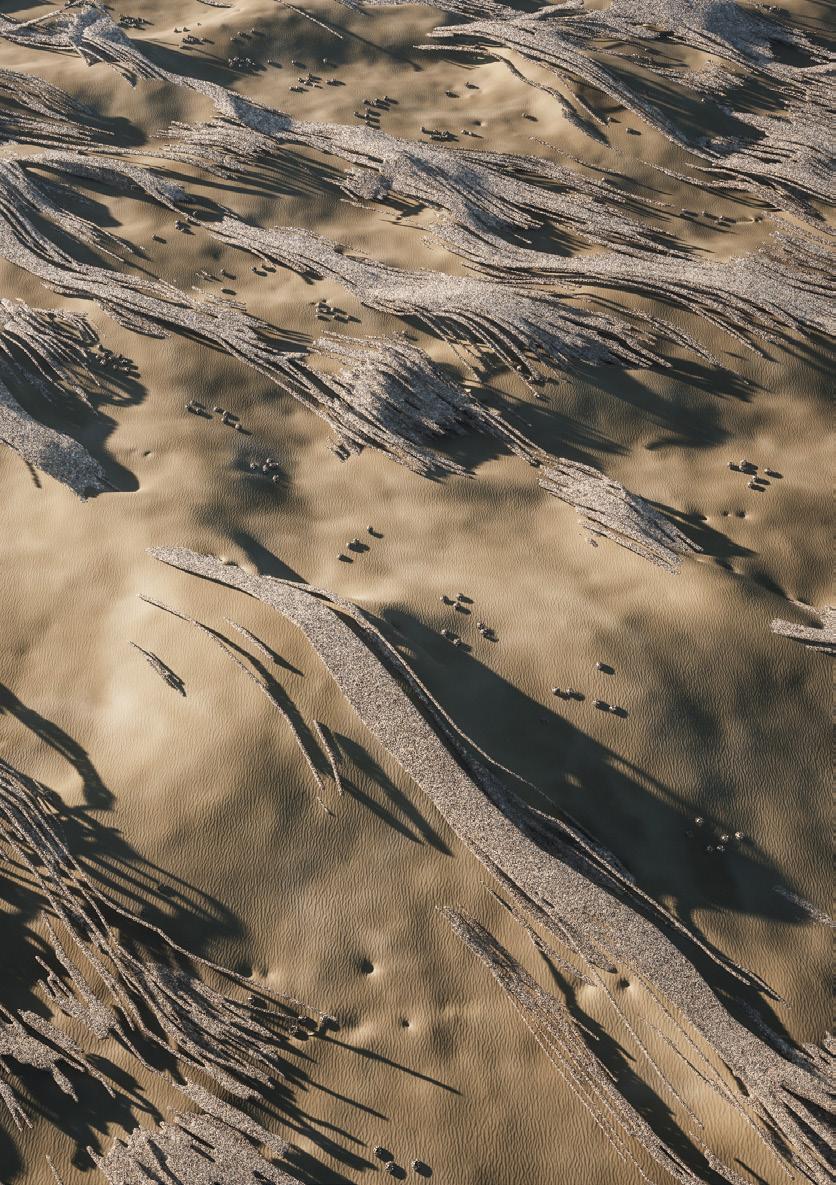
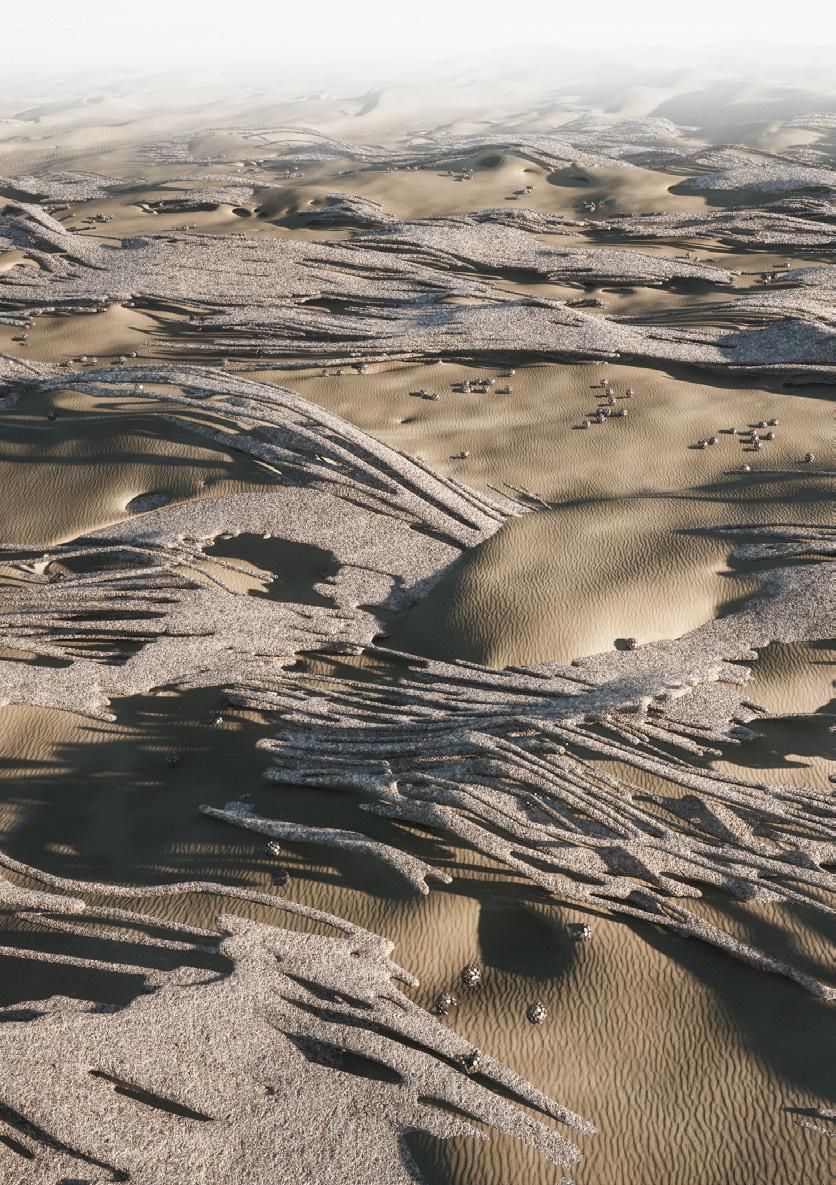
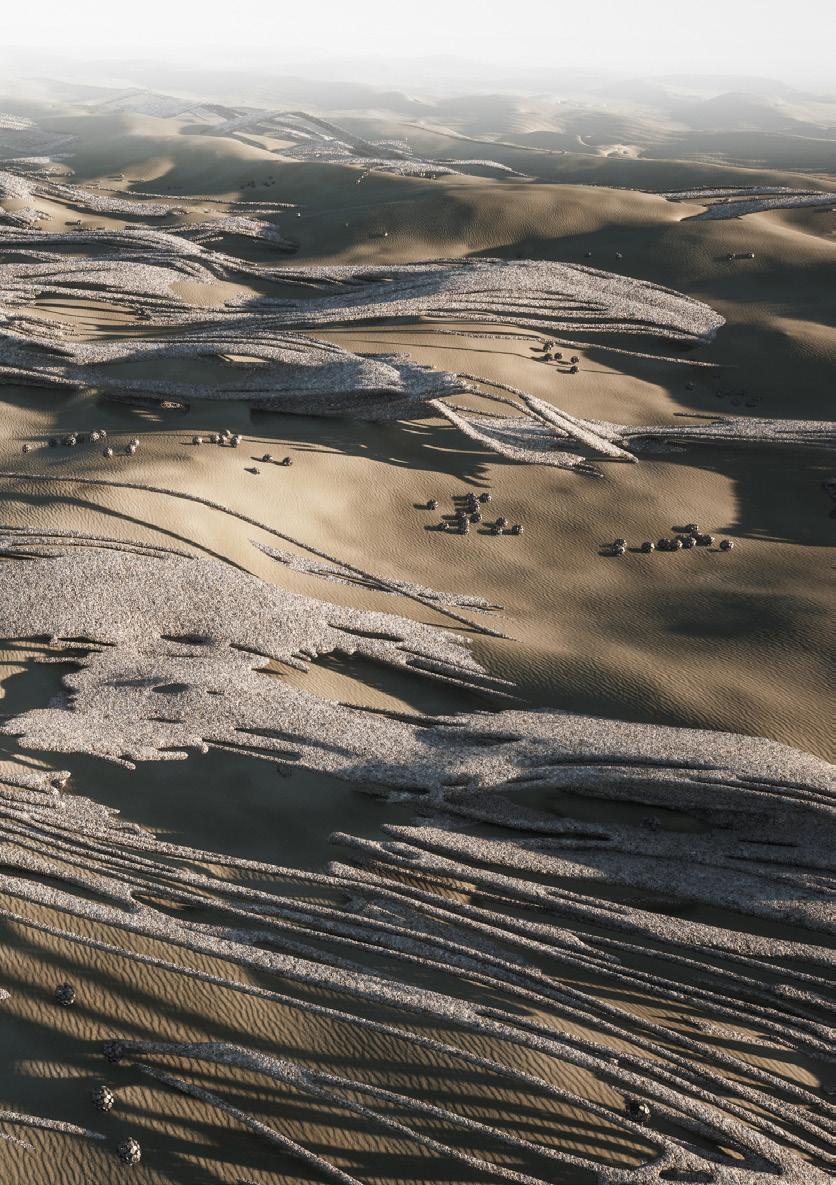
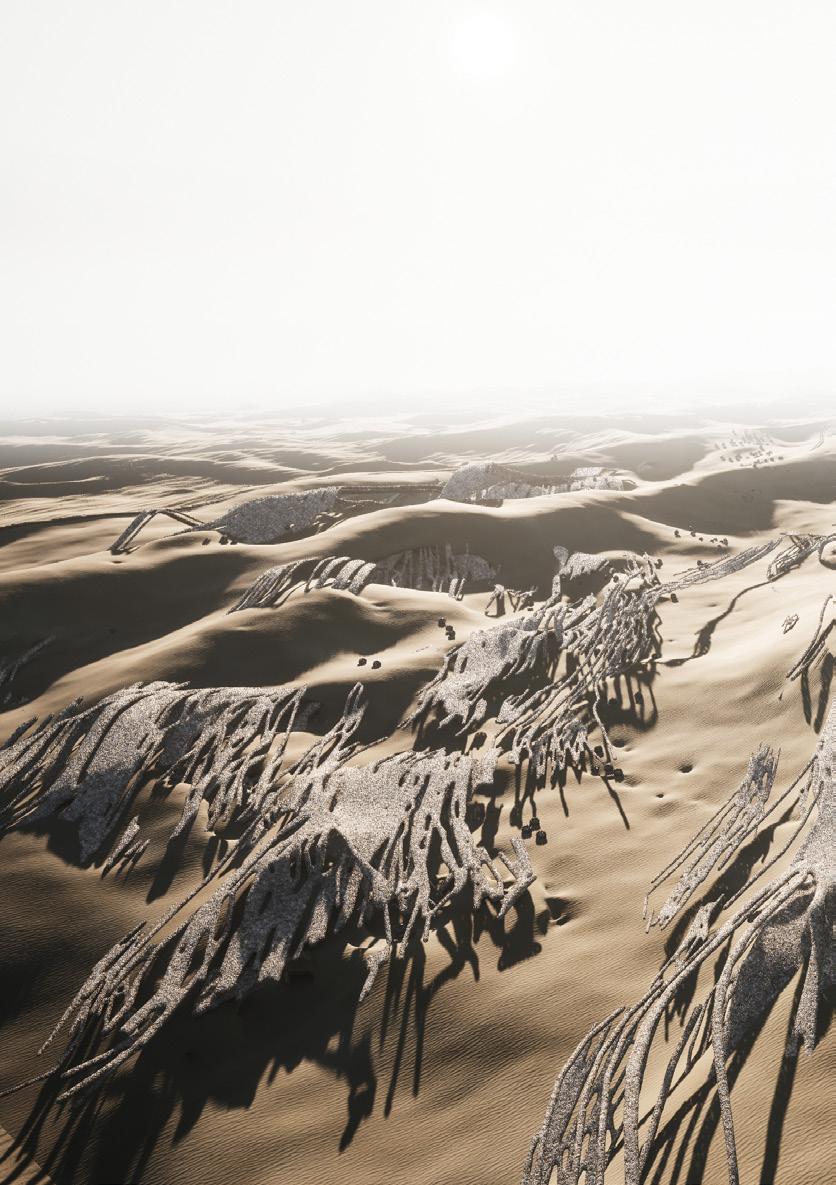
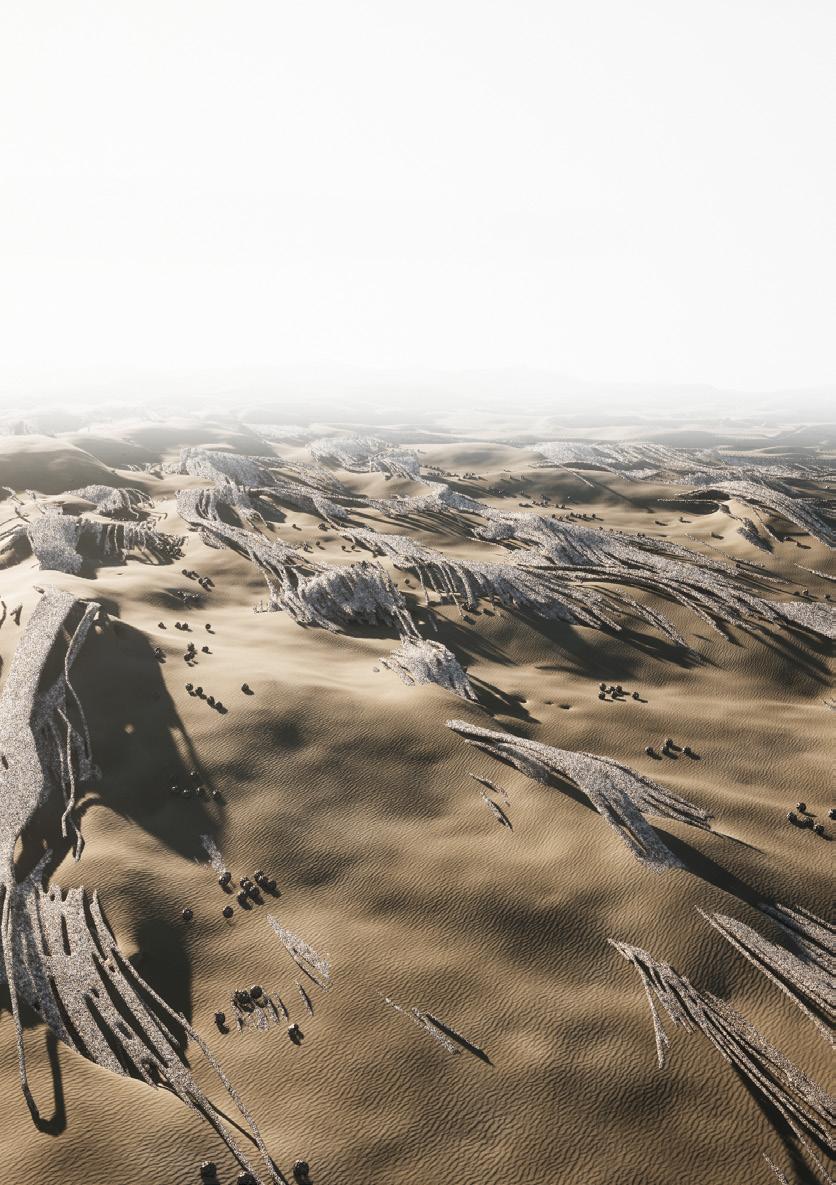
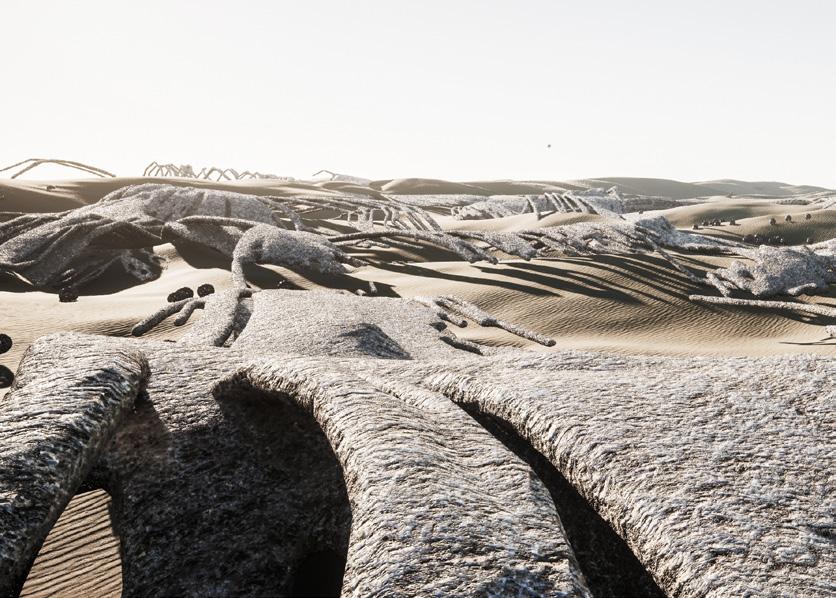
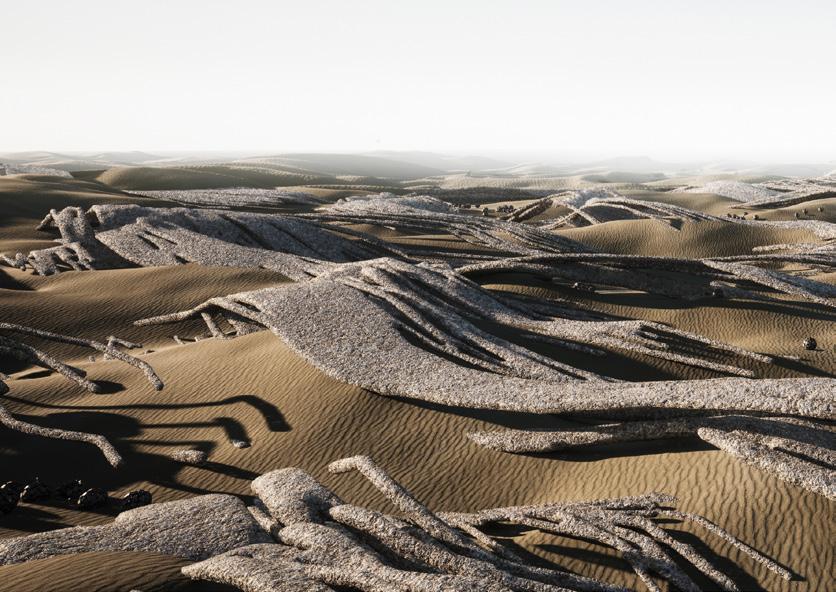

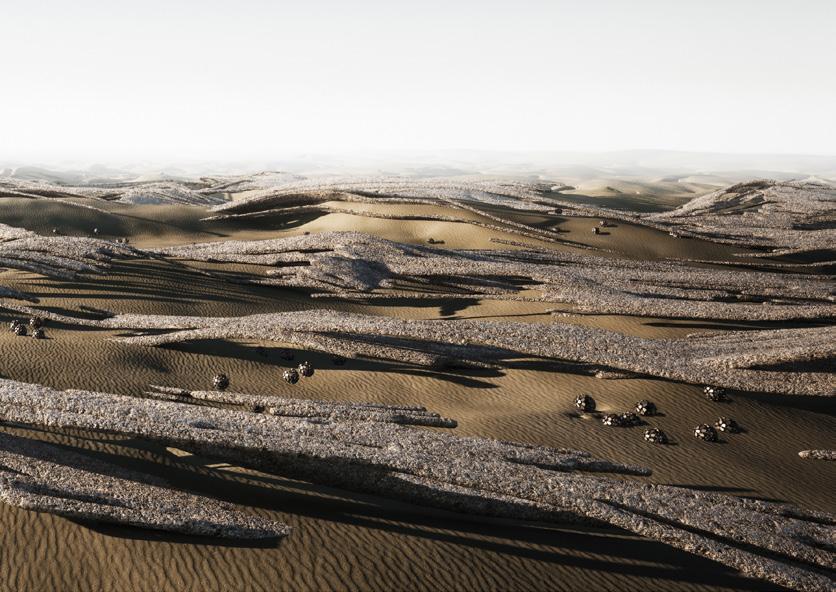
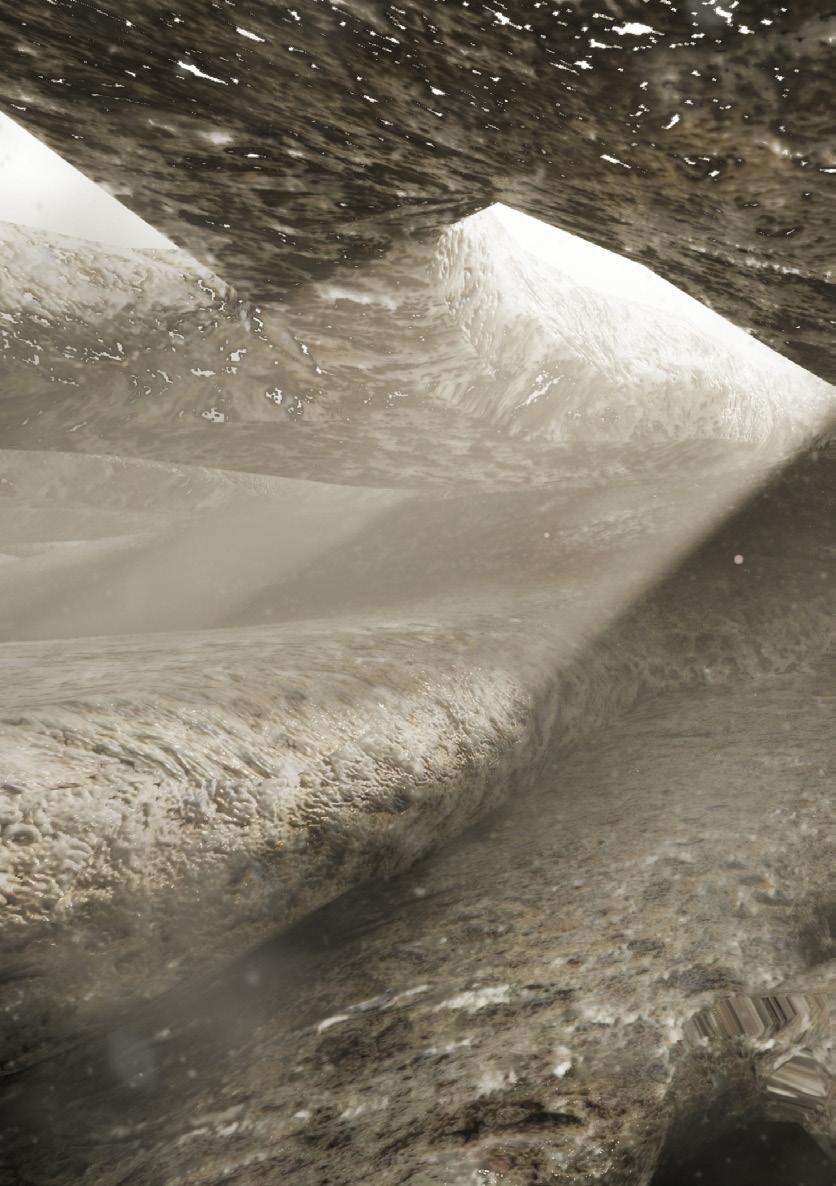
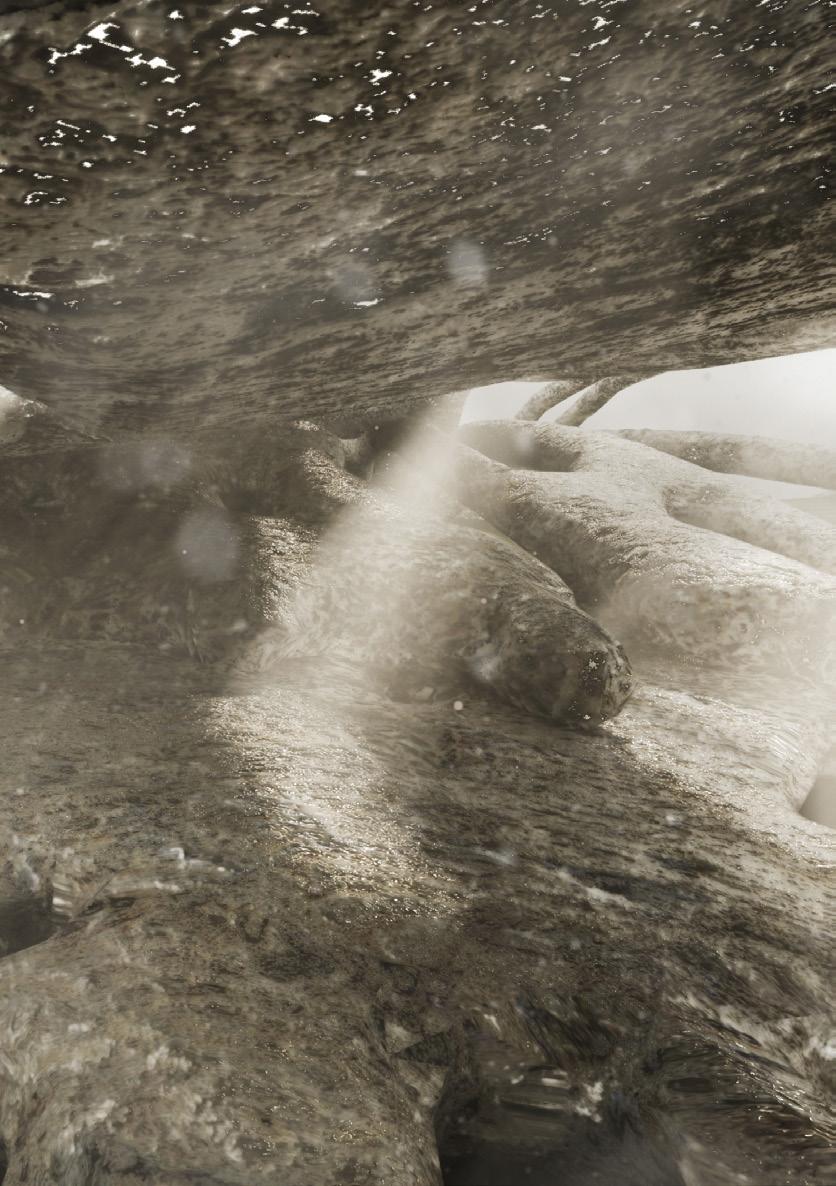

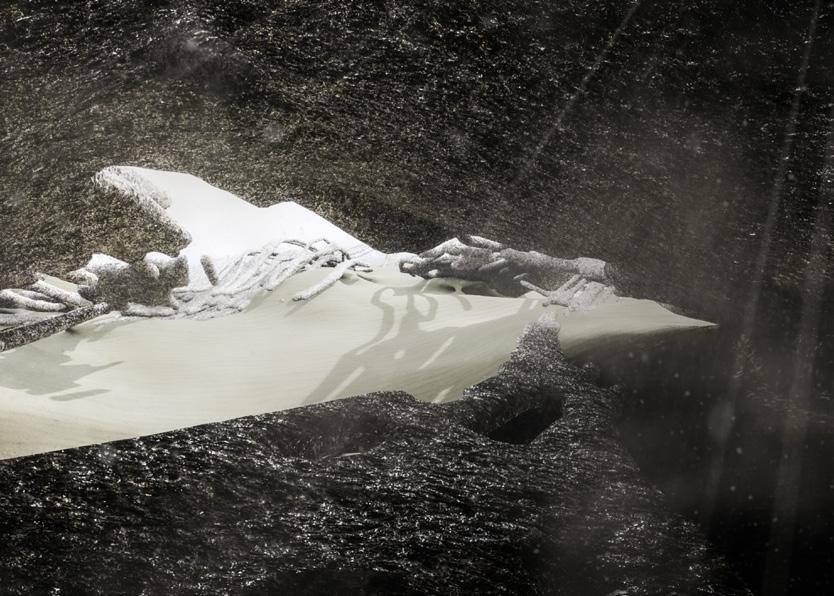
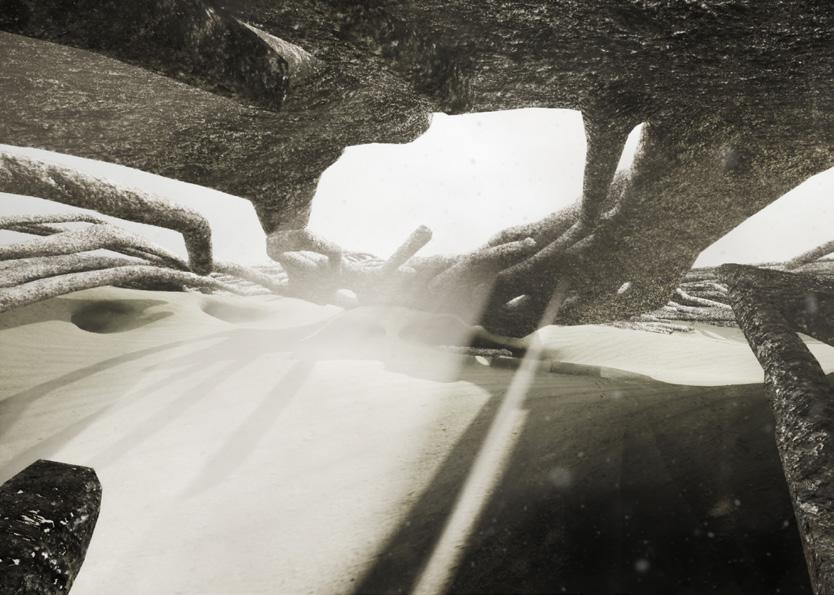
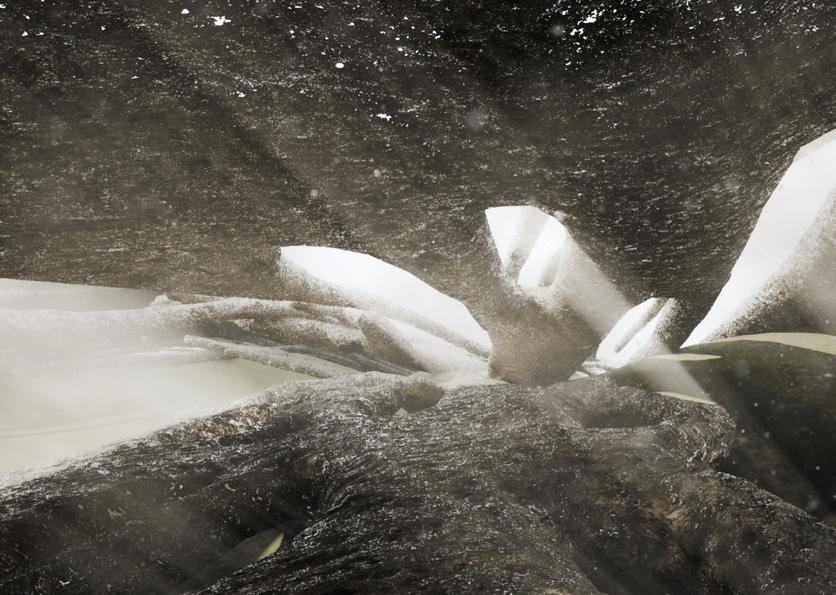
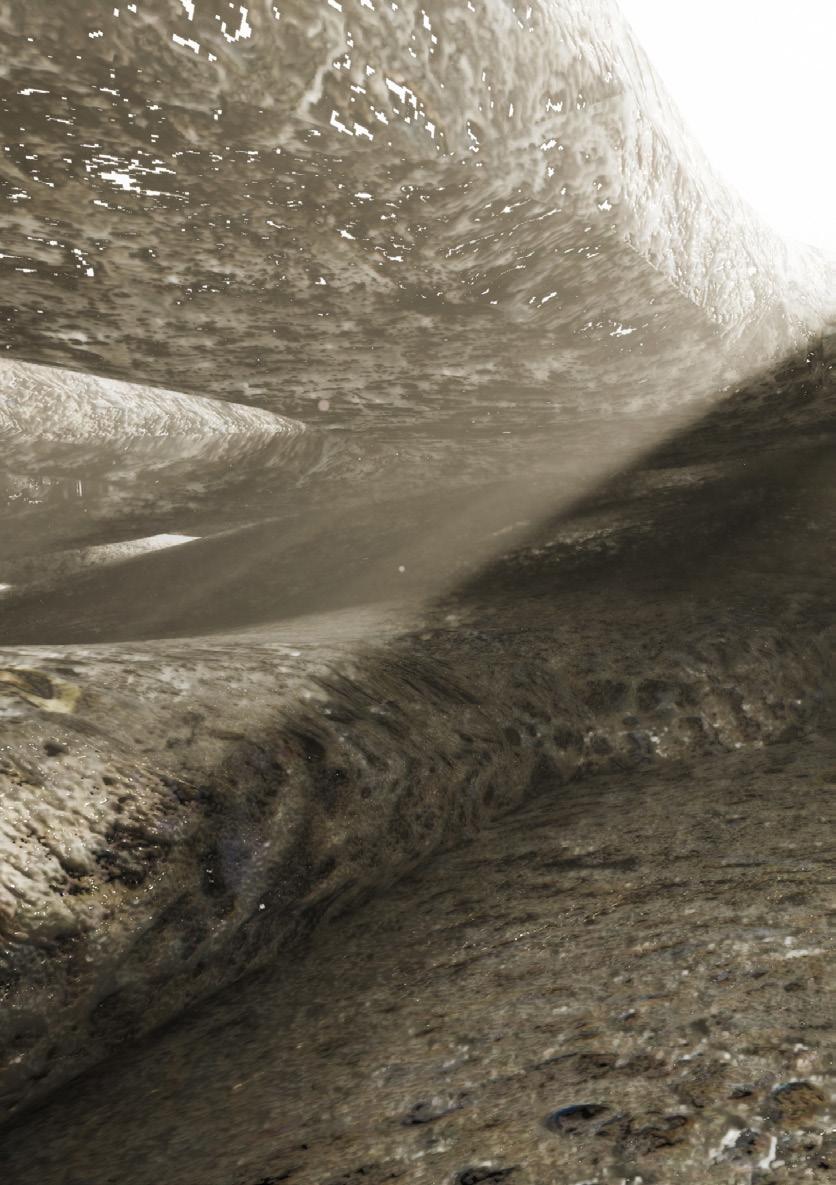

CONCLUSION ARCHITECTURE
The objective of this project is to utilize onsite fabrication to construct infrastructural glass formations in desert regions, in order to intervene and address the physical expansion of deserts over living ecosystems. Given the harsh desert environment and large scale of implementation, the structures will be fabricated by fusing sand particles on the desert’s surface through the use of a high population of autonomous robots, being autonomous and capable of making decisions in a constantly changing environment where solutions cannot be pre-planned.
The initial stage of the project involved researching the causes and processes of desertification in various regions and conditions, in order to gain a deeper understanding of the differences and origins of desertified lands. A range of experiments and simulations were conducted to study the behaviour of sand under the force of wind, specifically in the context of sand dunes in deserts. Techniques such as sand 3D printing with a magnifying glass, natural erosion, and sand-to-glass transformation under high temperatures were also explored as potential fabrication methods using sand as a local material. Ultimately, the decision was made to focus on utilizing a welder tool to fuse sand into glass as the primary material system research direction. Glass models were fabricated using this method at various scales and techniques in order to investigate the potential of this approach.
During the research phase, a variety of physical models were created using additive manufacturing techniques such as 3D printing and industrial robots, laser cutting, CNC, and 3D scanning of terrains. Arduino was used to program the behaviour of the robots and various physical experiments were conducted to explore the potential of sand as a construction material.
Computational software was studied and employed to simulate the behaviour and performance of the proposed structures in order to slow down and redirect particles away from living environments. The strategy is to fuse the back-side of dune faces in order to block and change the direction of particles’ paths. The collective behaviour of the robots would result in a geometry consisting of a large number of individual, segmented surfaces of glass that repeat the natural surface of the landscape of the desert. The design of the agent employs a range of behaviours, it analyses locally the landscape, communicates with other agents, moves on top of sand, fuses the sand and harness energy. The physical prototypes of its behaviour and motion were executed and tested with the Arduino platform and various sensors.
The use of glass as a material for this project is sustainable and recyclable as over time, the activity of wind and erosion can return the glass to its original state as sand. This means that no new materials are being introduced to the environment and instead, the physical state of the existing sand is being altered.
AEOLIAN | SCENARIO | 400 |
This is an infrastructural project, whose architectural value unfolds in its ability to sustain life. Architecture in a conventional sense of a building cannot address the planetary scale problems. Therefore, the research is based on a type of augmentation on a scale of a city, architecture on a scale of infrastructure.

AEOLIAN | SCENARIO | 401 |
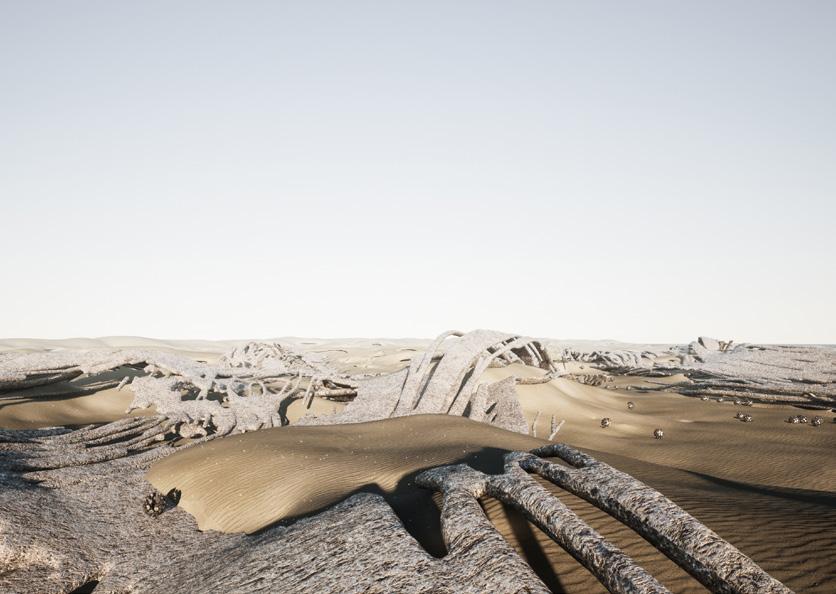
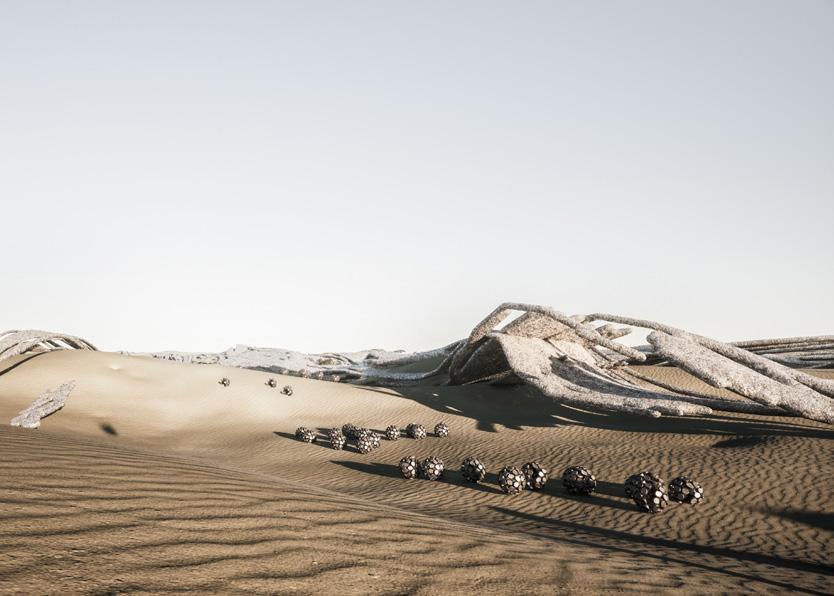
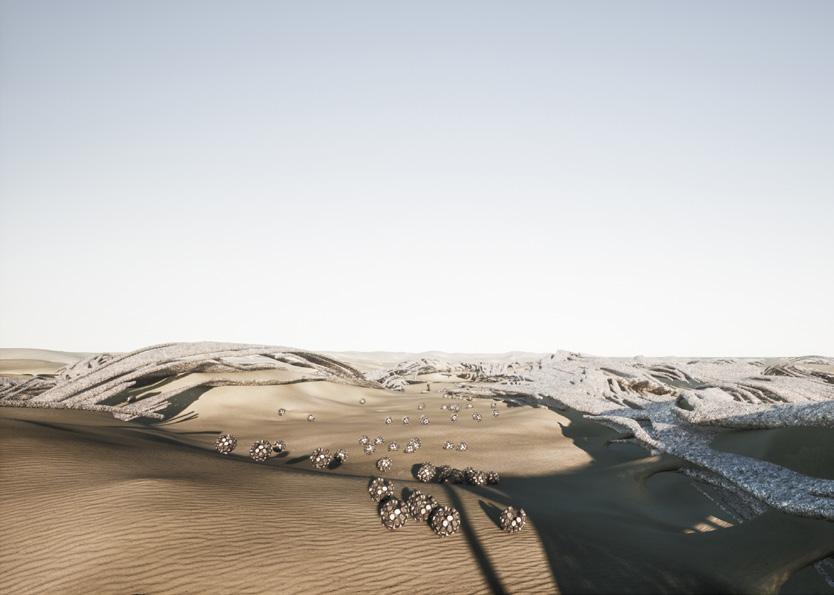
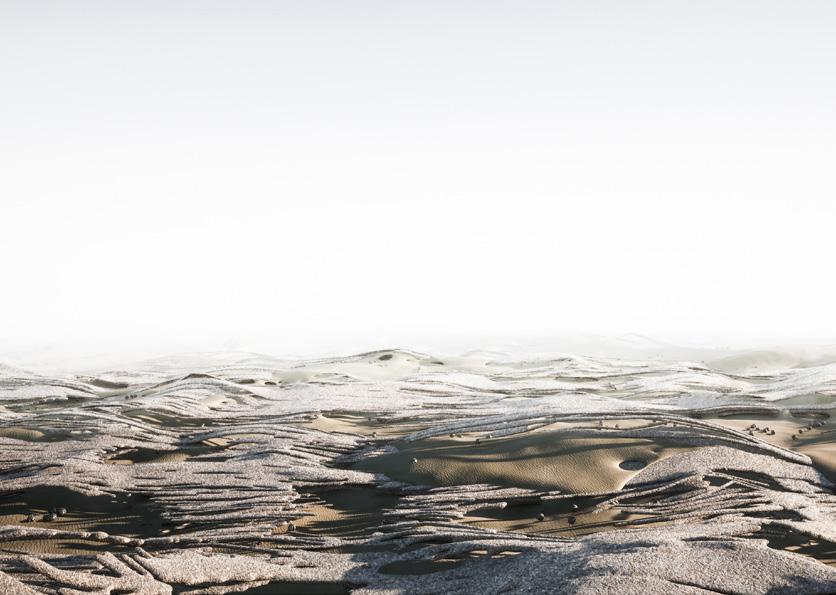
BIBLIOGRAPHY
Almasri, Eyad, and Firas Alawneh. “Petra – Holy City from the Perspective of Art, Architecture, Inscriptions and Other Features.” StudiesinAncientArtand Civilisation22 (2019): 65–94.
“Cappadocia.” EncyclopædiaBritannica . Encyclopædia Britannica, inc. Accessed September 7, 2022.
https://doi.org/10.12797/saac.22.2018.22.04.
Dabaieh, Marwa. “A Future for the Past of Desert Vernacular Architecture: Testing a Novel Conservation Model and Applied Methodology in the Town of Balat in Egypt”. Department of Architecture and Built Environment. Division of Architectural Conservation and Restoration. Faculty of Engineering. Lund University. 2011.
Etherington, Rose. “The Solar Sinter by Markus Kayser”, Dezeen, 28 June 2011.
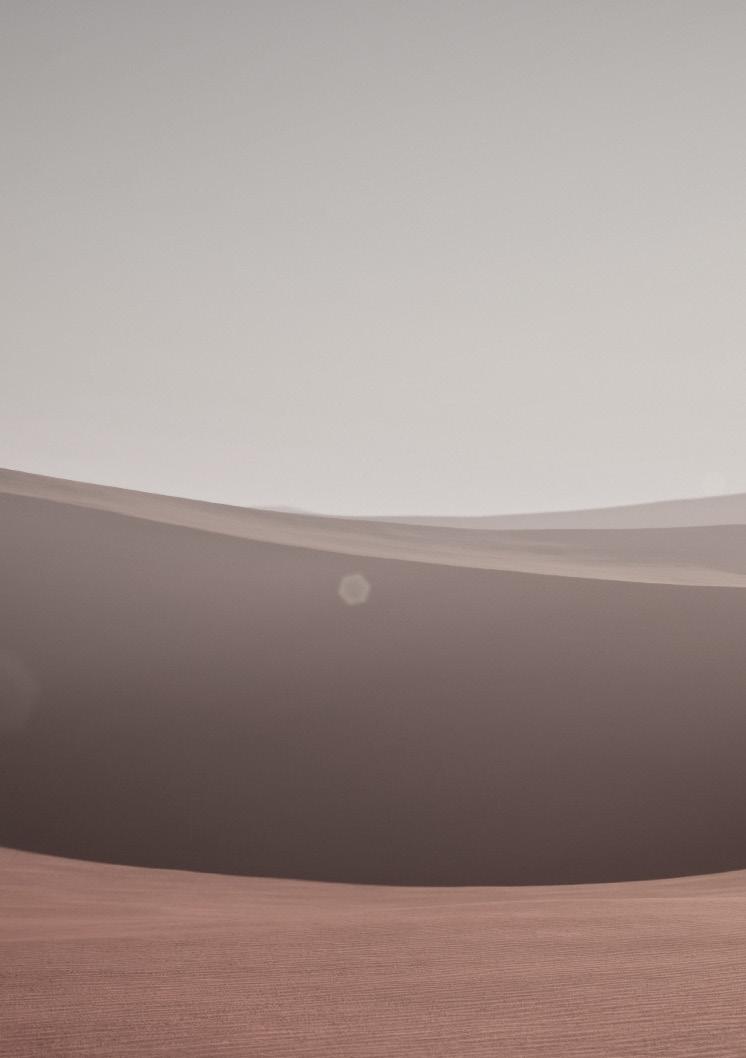
https://www.dezeen.com/2011/06/28/the-solar-sinter-by-markus-kayser/
Etzion, Y., D. Pearlmutter, E. Erell, and I.A. Meir. “Adaptive Architecture: Integrating Low-Energy Technologies for Climate Control in the Desert.” Automationin Construction6, no. 5-6 (1997): 417–25.
https://doi.org/10.1016/s0926-5805(97)00020-4.
Frazer, John. AnEvolutionaryArchitecture.London: E.G. Bond Ltd., 1995
Gray, Richard. “The wall holding back a desert”. BBC. September 9, 2019.
https://www.bbc.com/future/article/20190902-the-wall-holing-back-a-de sert#:~:text=Over%20the%20past%20century%2C%20the,km%20over%20 the%20same%20period
Lao, Wanda. “MIT’s Neri Oxman on the True Beauty of 3D Printed Glass”. Archtect Technology. August 28, 2015.
https://www.architectmagazine.com/technology/mits-neri-oxman-on-thetrue-beauty-of-3d-printed-glass_o
AEOLIAN | BIBLIOGRAPHY
Lucarelli, Fosco. “Musgum Mud Huts”. SOCKSSTUDIO. June 26, 2015.
https://socks-studio.com/2015/06/26/musgum-mud-huts/
Nunez, Christina. “Desertification, explained”. NationalGeographic . May 31 2019.
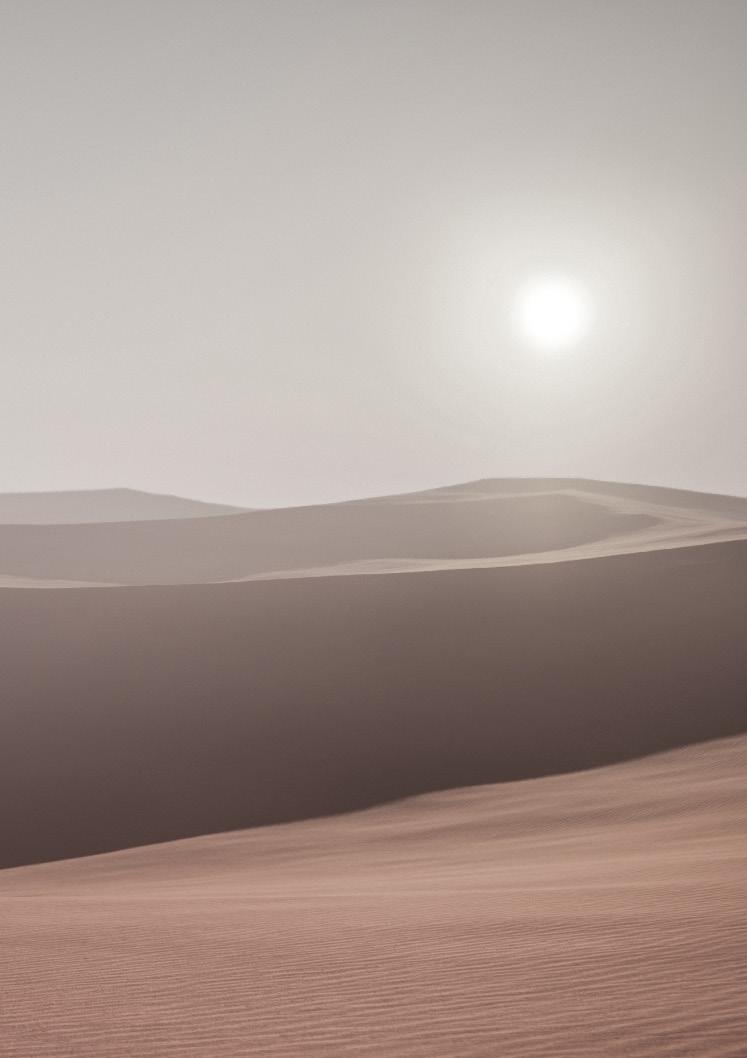
https://www.nationalgeographic.com/environment/article/desertification
Nývlt, Vladimír, Josef Musílek, Jiří Čejka, and Ondrej Stopka. “The Study of Derinkuyu Underground City in Cappadocia Located in Pyroclastic Rock Materials.” ProcediaEngineering161 (2016): 2253–58.
https://doi.org/10.1016/j.proeng.2016.08.824.
N. Lancaster. “Eolian Process”. EncyclopediaofGeology.2005.
https://www.sciencedirect.com/topics/earth-and-planetary-sciences/ eolian-process
Pasik, Maxim “How water scarcity triggers the refugee crisis – and what tech can do to solve it”, World Economics Forum. June 4, 2019. How water scarcity triggers the refugee crisis – and what tech can do to solve it | World Economic Forum (weforum.org)
“Petra: The History of the Rose City, One of the New Seven Wonders of the World”. North Charleston, SC: CreatespaceIndependent Publishing Platform, 2015. USA National Park Service, Aeolian (Dunes) Landforms, NPS.
https://www.nps.gov/subjects/geology/aeolian-landforms.htm
Winssen, Ilse. “Mousgoum Dwellings”. AD. November 18, 2019.
https://architectureindevelopment.org/project/68
https://www.britannica.com/place/Cappadocia.
Zdruli, P., Marcello Pagliai, S. Kapur, and A. Faz Cano. LandDegradationand Desertification:Assessment,MitigationandRemediation . Springer, 2014.
AEOLIAN | BIBLIOGRAPHY

APPENDIX
EARLY RESEARCH AND THE PROCESS

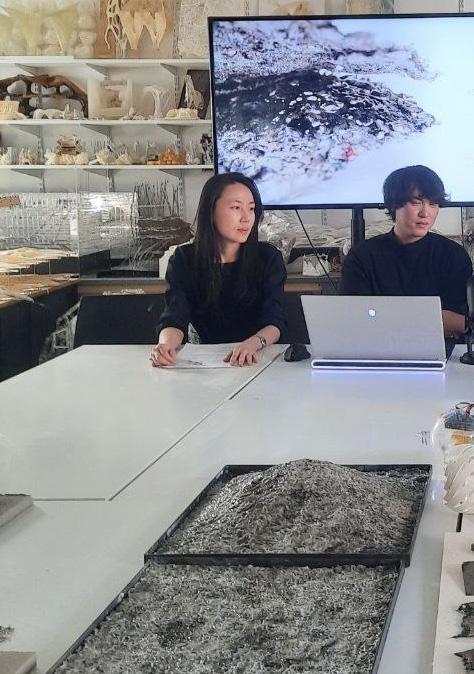
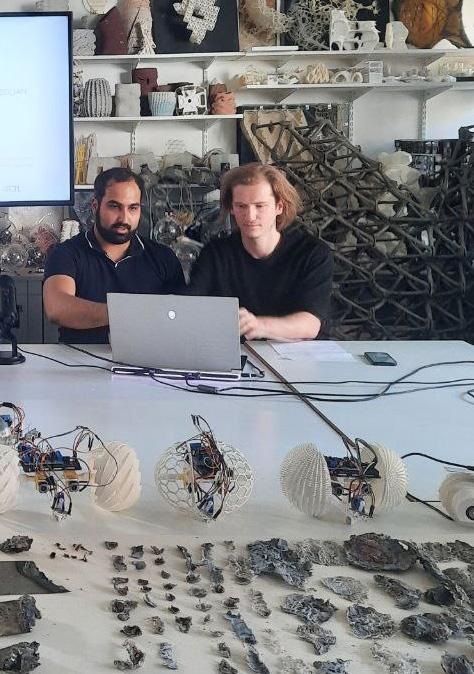
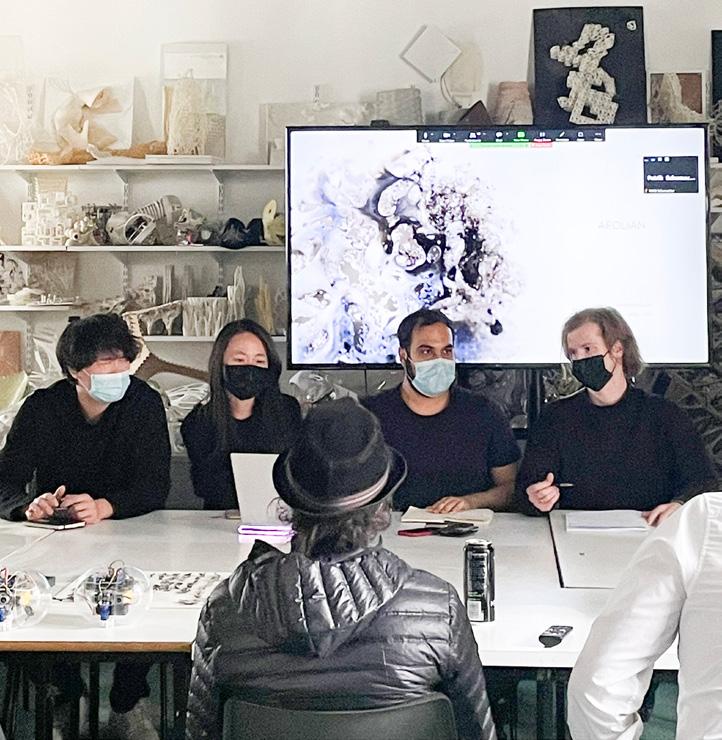
AEOLIAN | APPENDIX | 410 | Term 3 presentation

AEOLIAN | APPENDIX | 411 |
4
Term
presentation
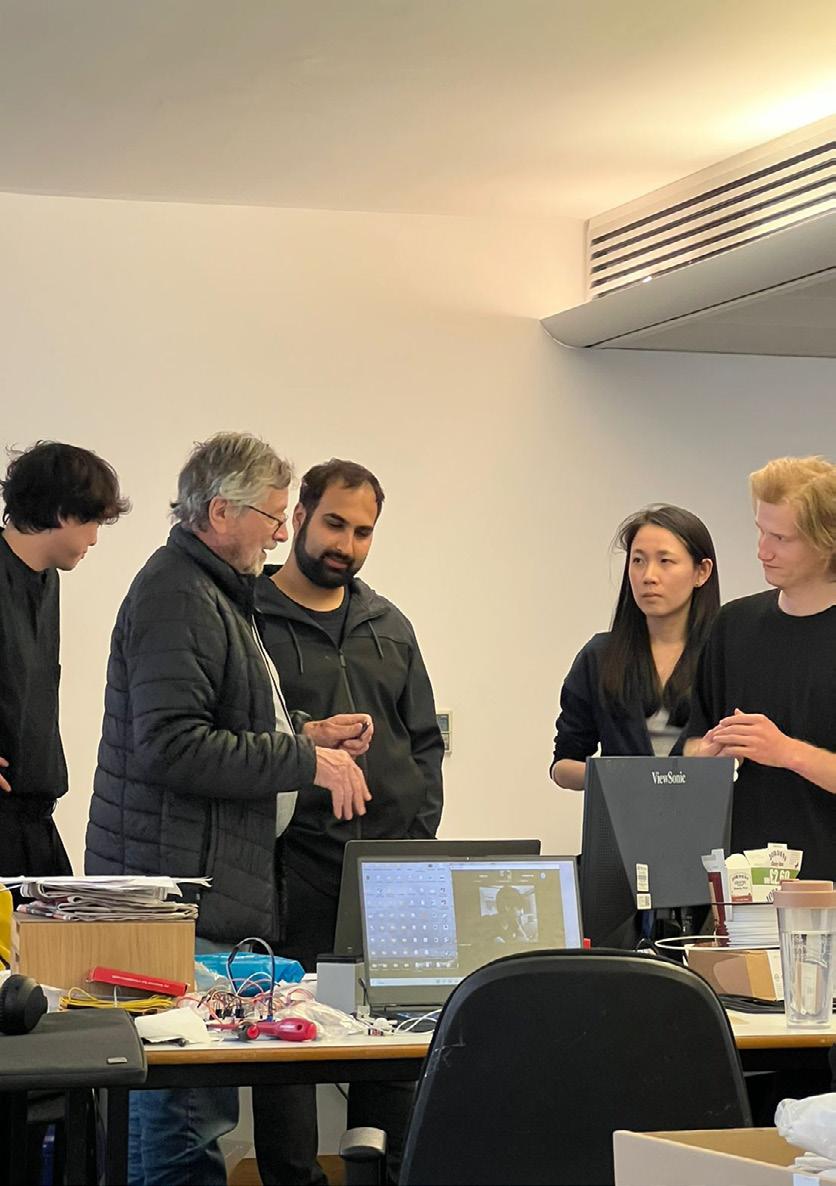
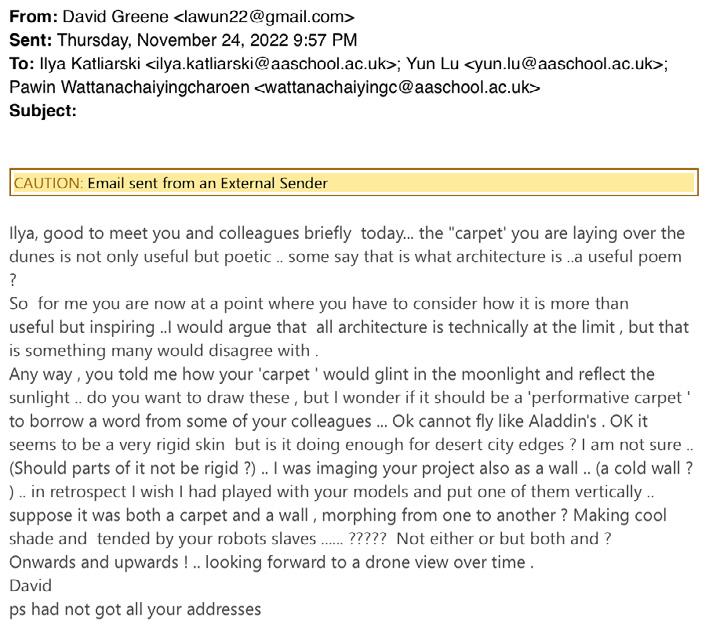
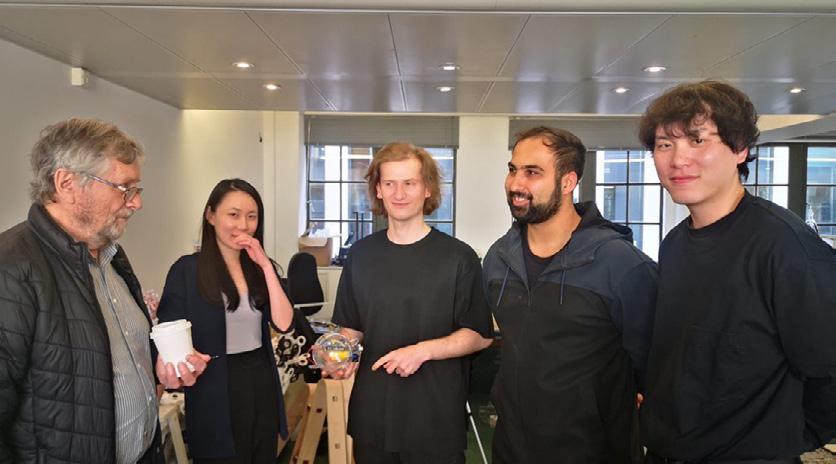
AEOLIAN | APPENDIX

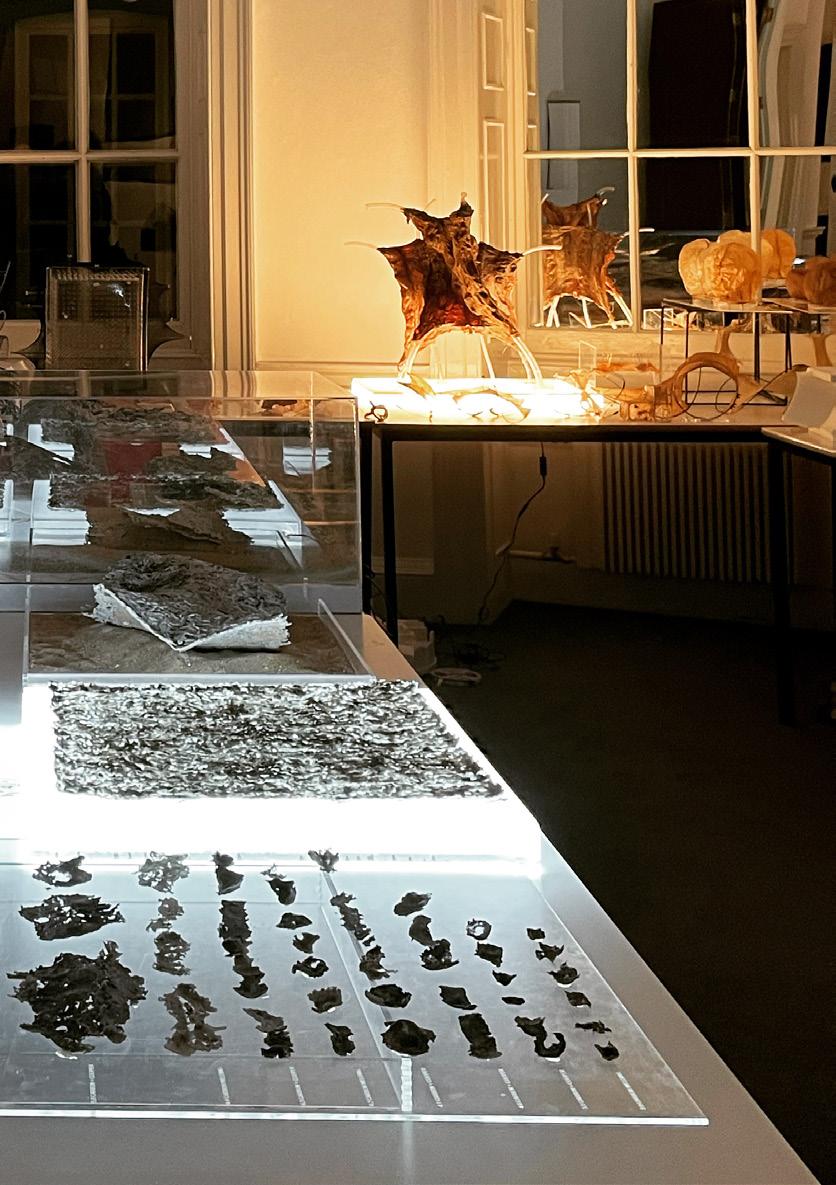
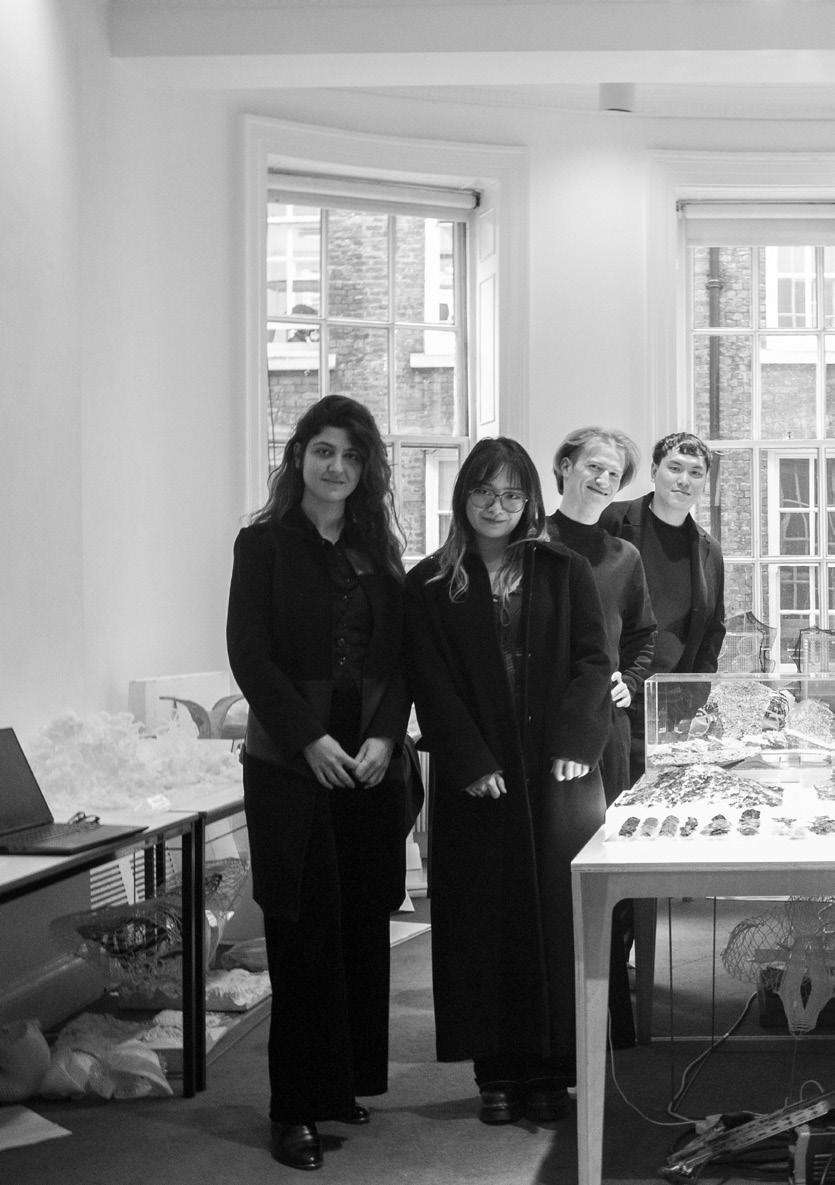


AEOLIAN | APPENDIX

AEOLIAN | APPENDIX
Carbon electrodes for the welding were taken out from the lantern batteries. The picture displays the number of batteries used for the research.
EXHIBITION PROJECTS REVIEW EXHIBITION 2022
The project was displayed during the annual Architectural Association’s projects review exhibition in June 2022 among other DRL projects of phase 1 and phase 2. Physical models were exhibited, which includes glass models and arduino robots. For the exhibition the models were specially prepared. It involved production of concrete bases and boxes for the glass pieces, and LED stripe lighting in the transparent acrylic base boxes.
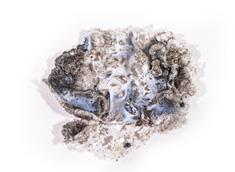
AEOLIAN | APPENDIX | 420 |
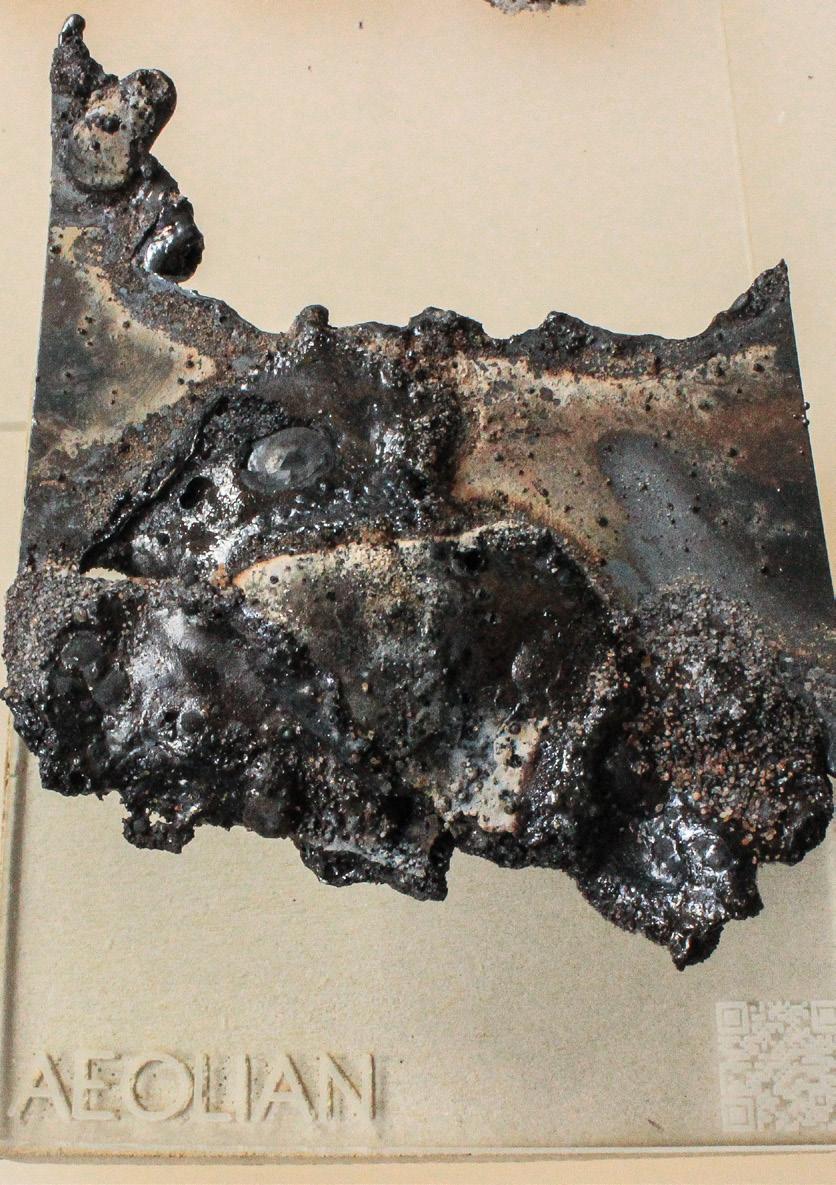
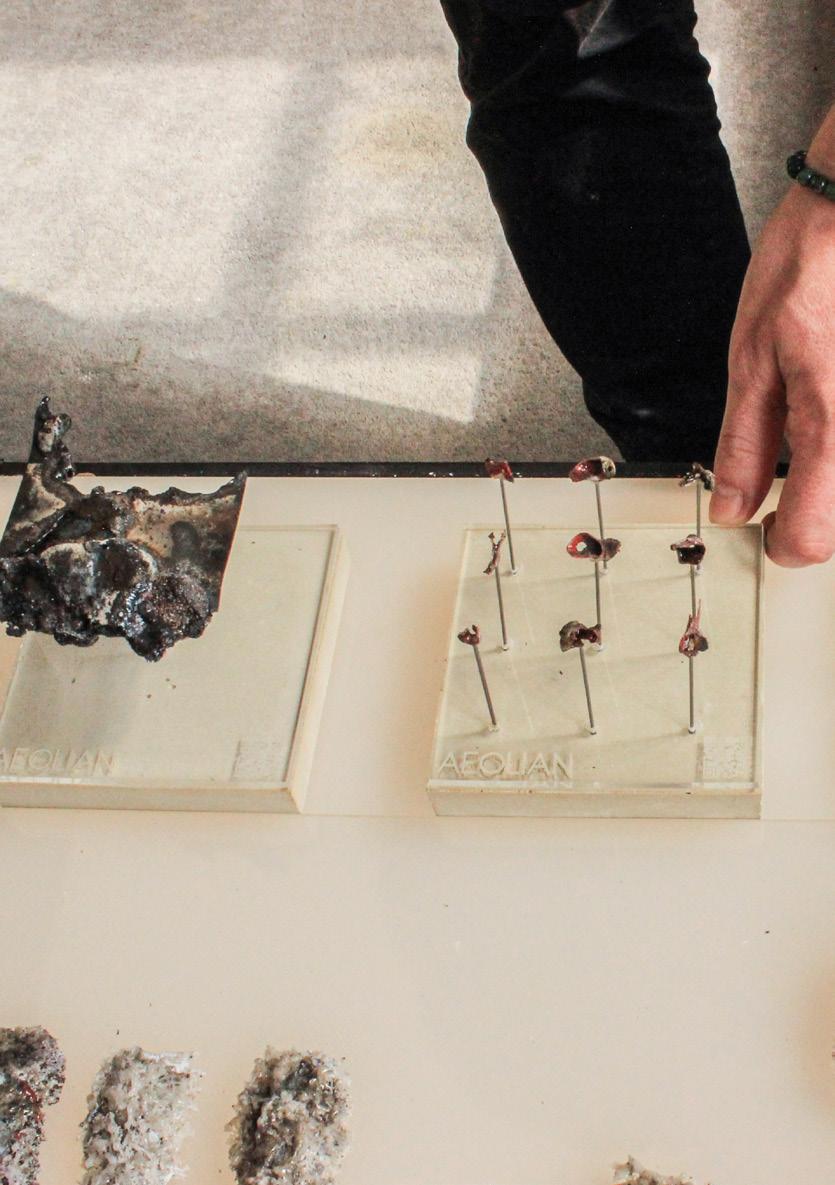
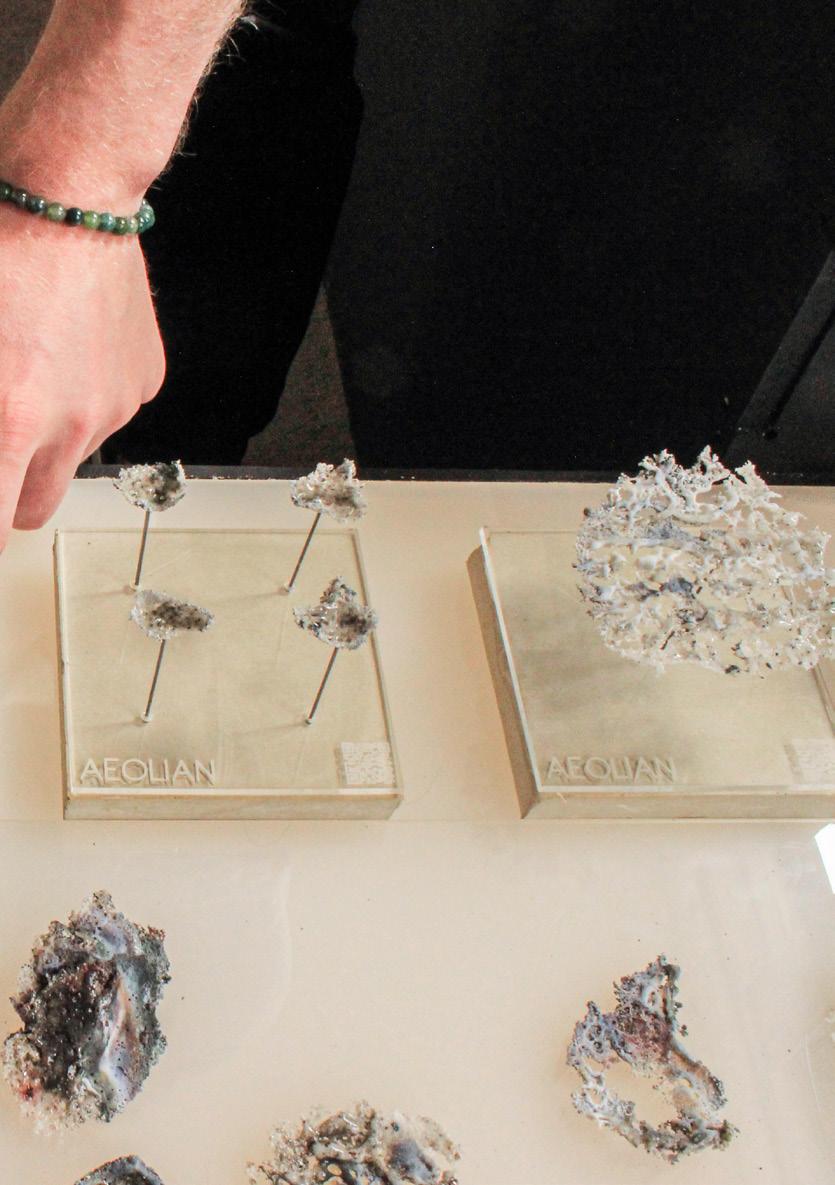

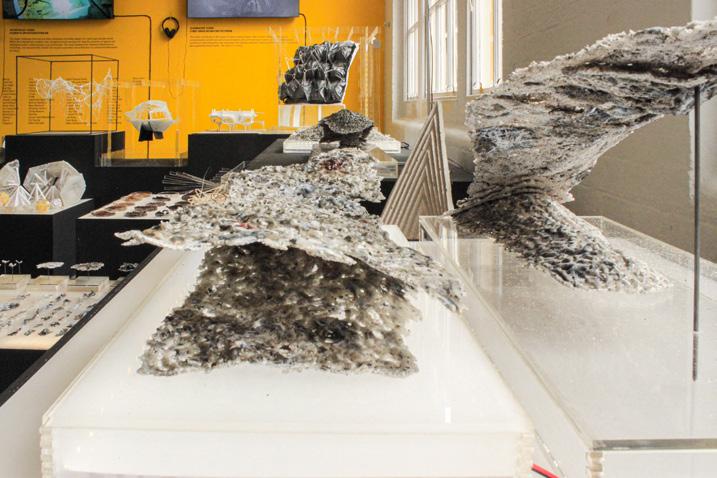
AEOLIAN | APPENDIX | 424 |
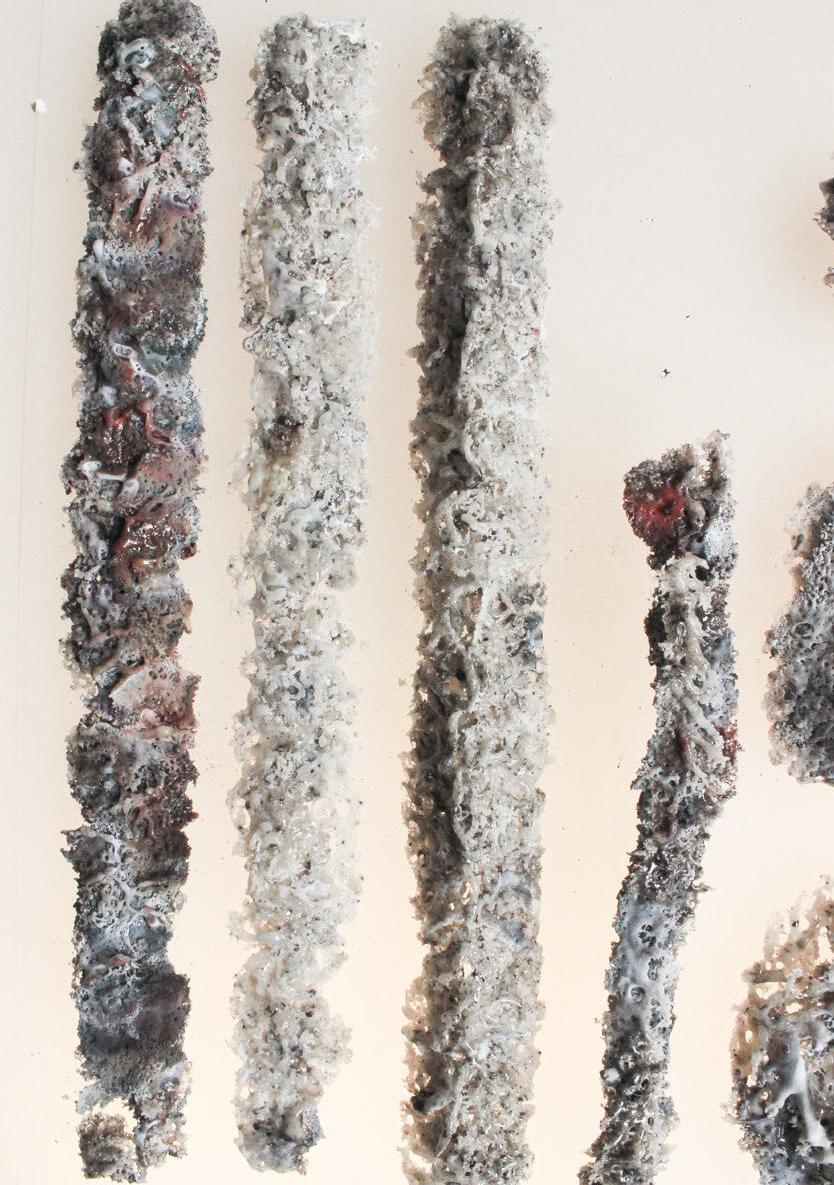
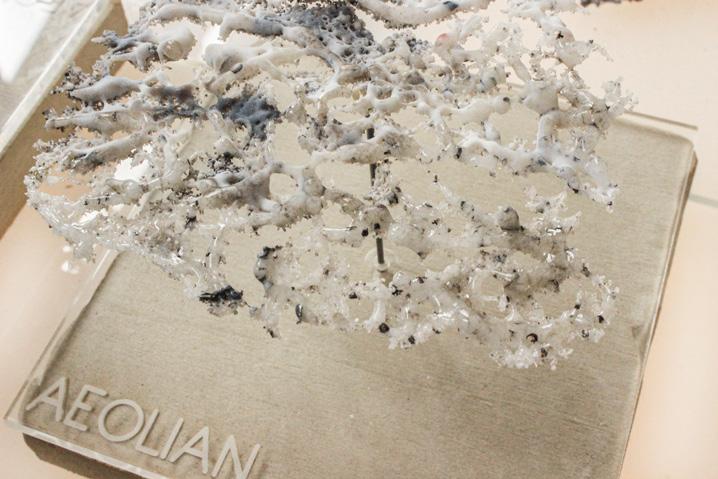
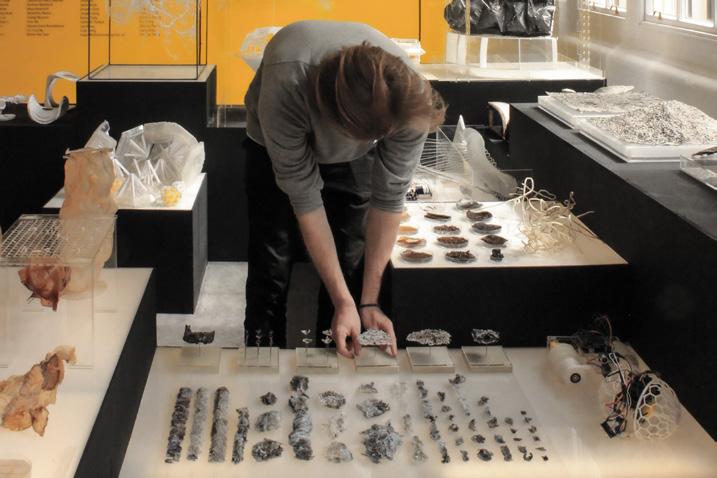
AEOLIAN | APPENDIX | 426 |
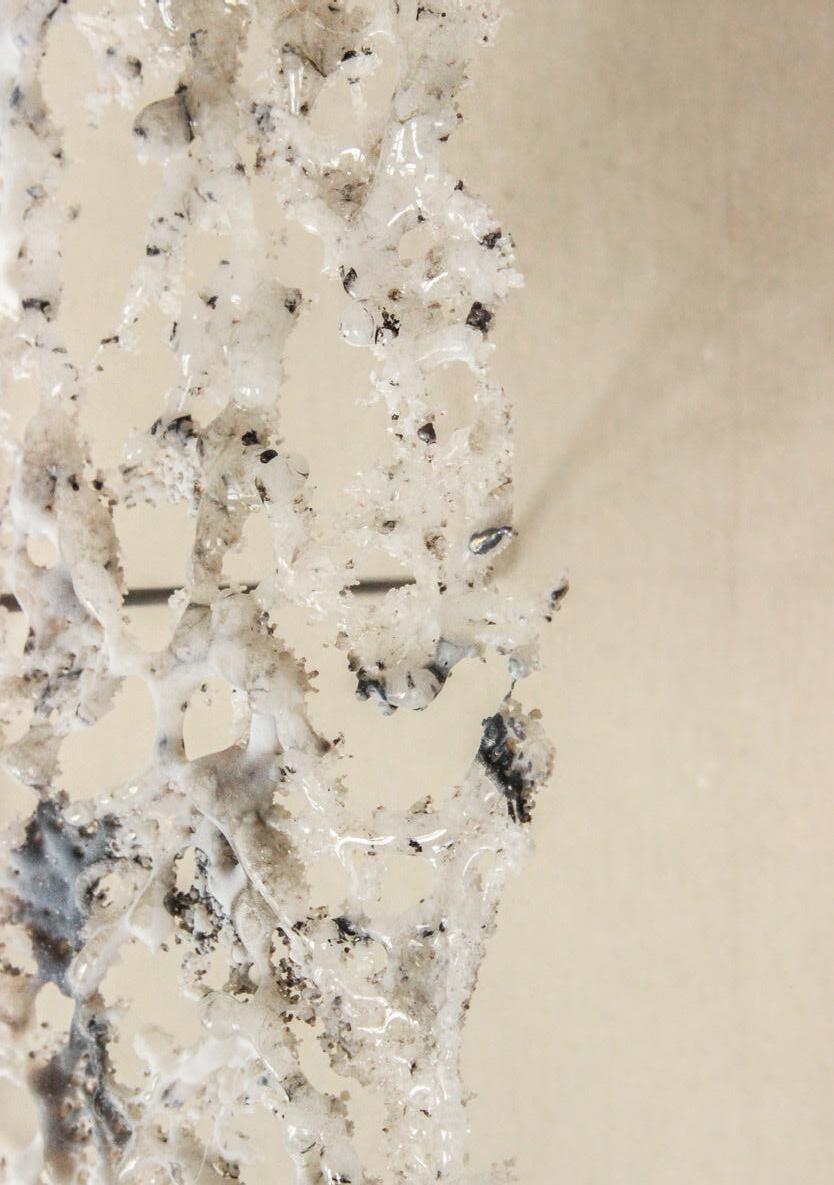
LIGHTNING
USING THE LIGHTNING TO CREATE A GLASS ARCHITECTURE
The natural phenomena of lightning was an inspiration of the research, particularly the action, when lightning strikes the ground, it is hot enough to fuse silica sand and clay together into fulgurites: shafts of glass produced by lightning. The natural process of solidification of sand brought another way of fabrication with sand. Initially the research was divided into to directions. One opportunity was to harvest the lightning to produce glass structures another was to imitate it with artificial tools to melt sand into glass. As the primarily direction was the glass production way, the lightning harvesting idea was left behind. Therefore the research about lightning is not in the main chapter of the project.

AEOLIAN | APPENDIX | 428 |
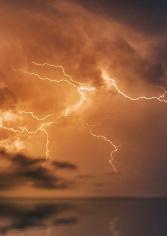
Initially, a faint luminous process descends in a downward-branching pattern in regular distinct steps, typically 30 metres (100 feet) in length, though they can range from 10 to 100 metres (33 to 330 feet). The time interval between steps ranges from 10 to 50 microseconds (millionths of a second). Carrying currents on the order of hundreds to thousands of amperes, the stepped leader propagates toward the ground at an average velocity of 1.5 × 105 metres per second. Diameter estimates for the stepped leader range from a few centimetres to a few metres. The current-carrying core has a diameter on the order of 1 or 2 cm (0.4 or 0.8 inch), and photographic measurements indicate that a corona sheath of electric charge with a diameter of 1 to 10 metres (3 to 33 feet) surrounds the core.
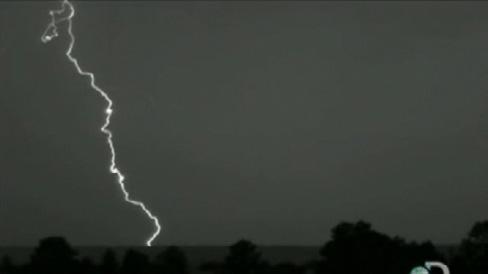
As the stepped leader nears the ground, approximately five coulombs of charge have been deposited along the channel, inducing an opposite charge on the ground and increasing the electric field between the leader and the point to be struck. An upward discharge starts at the ground, and rises to meet the stepped leader about 15 to 50 metres (50 to 160 feet) above the surface. At this moment of junction the cloud is short-circuited to the ground and a highly luminous return stroke of high current occurs. Portions of the stepped leader that have not reached the ground become the branches of the return stroke, and charge on the branches flows into the main channel. Peak temperatures in the channel are on the order of 30,000 °C
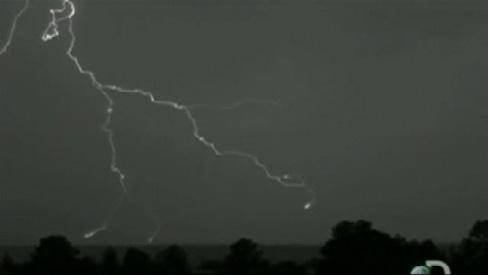
AEOLIAN | APPENDIX | 430 | LIGHTNING
Initial stroke - the stepped leader
Return stroke
FULGURITES PETRIFIED LIGHTNING
When lightning strikes the ground, it is hot enough to fuse silica sand and clay together into fulgurites: shafts of glass produced by lightning. The word fulgurite comes from fulgur, the Latin word for thunderbolt. Glass can be made by heating sand, which is mostly silicon dioxide, or quartz. The lightning bolt vaporizes the sand it encounters, generating a hollow tube. As the heat moves outward from the entry hole, the sand grains melt and form a smooth inner surface. As the heat moves further outward, it fuses grains of sand. The outside is rough, looking like petrified lightning when the fulgurite has branching assemblages. But the inside is hollow and smooth. The composition of the sand determines the colour of the fulgurite.
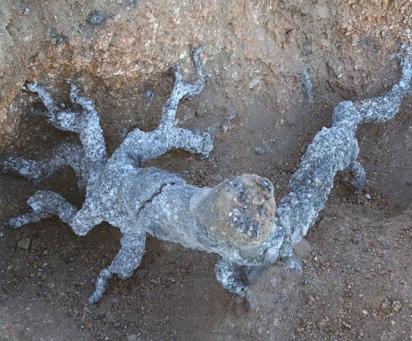
AEOLIAN | APPENDIX | 431 |
LIGHTNING SIMULATION
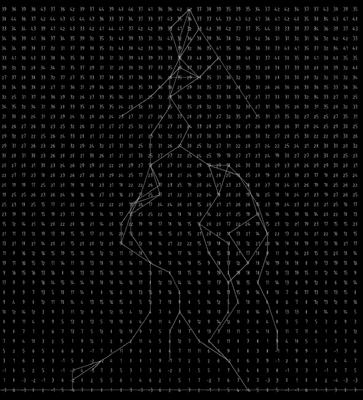
The simulation was done as research on lightning formation. The field of points was charged to be amplifying upwards. Then the points were randomised in a certain radius to have a random charged field of points but in general with an increasing charge upwards. The process of lightning starts from one point on the top and finds the points with the lowest charge in a certain radius. It can select several points to move on and thus the branching occurs. A branch can stop developing if it will not find a smaller charge.
After simulating the lightning process the goal is to harvest the lightning. The idea is to attract the lightning with the grid of pillars, as the lightning is attracted by lonely pointiness objects. The pillars with less amount of charge are introduced to the simulation. And the simulation stopped when the lightning reached the pillar.

AEOLIAN | APPENDIX | 432 |
A set of simulations with different randomisation of charges was executed to archive visual similarity with lightning and get the most suitable input conditions.
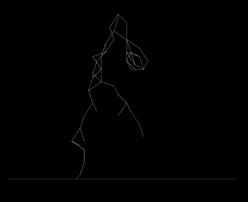
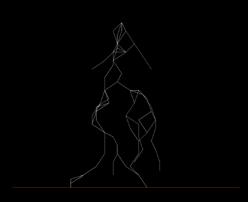
The same conditions of charges were examined for the simulation of the attraction of lightning to the grid of pillars.
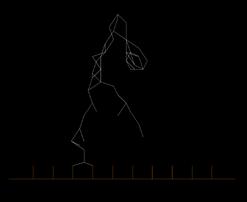
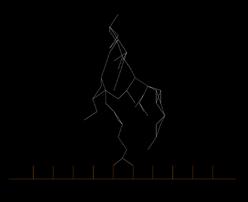
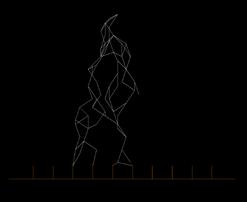
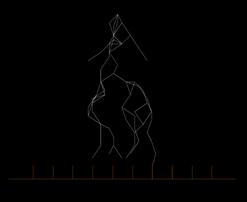
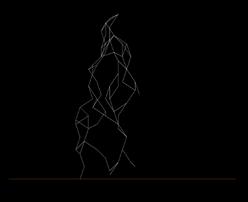

AEOLIAN | APPENDIX | 433 |
FULGURITES SIMULATION - STRUCTURE FORMATION
To create the fulgurites simulation the DLA was used. DLA, Diffusion-Limited Aggregation, is a process whereby particles undergo a random walk due to Brownian motion clusters to form aggregates of such particles.

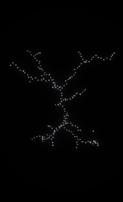
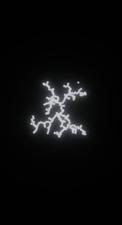
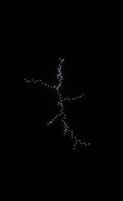
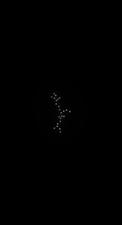
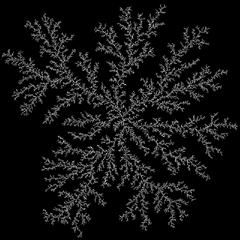
The moving point moves a tiny bit into a randomly chosen direction for each step. After the point is moved, it checks if there is any fixed point within a given distance. If there is no static point close by, the point moves again, choosing a random direction. If, after some steps, the moving point finds a static point within its vicinity. It turns into a static point itself and spawns another moving point.
RANGE SIZE OF BRANCHES SEED INT
DISTANCE BETWEEN PARTICLES NUMBERS

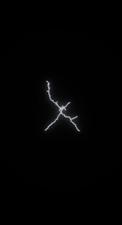

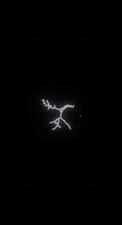
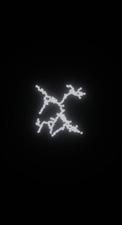

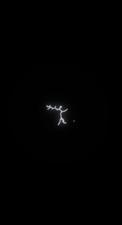

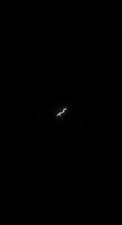

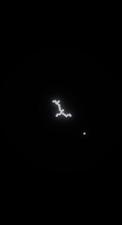
NUMBERS OF PARTICLES RADIUS SIMULATION RADIUS SCALE
START/END SIZE DIFFERENCE
STRUCTURE FORMATION 1.0
The structure of fulgurites is a branch-like shape. By using the DLA algorithm, the branch formation could be created. The structure grows from the starting point and grows randomly in all directions. In this step, the controllable settings are size, distance, and numbers.
AEOLIAN | APPENDIX | 434 |
2.50 s. 2.50 s. 2.50 s. 2.50 s. 5.00 s. 5.00 s. 5.00 s. 5.00 s. 7.50 s. 7.50 s. 7.50 s. 7.50 s. 10.00 s. 10.00 s. 10.00 s. 10.00 s.
It. 2 It. 3 It. 4 RANGE 20 SEED INT 1.0 NUMBERS 5000 RANGE 80 SEED INT 1.0 NUMBERS 8000 RANGE 150 SEED INT 4.0 NUMBERS 2000 RANGE 200 SEED INT 1.0 NUMBERS 1500 It. 1
STRUCTURE FORMATION 2.0
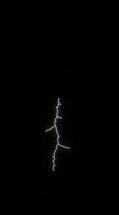

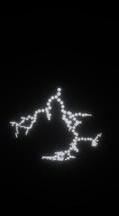
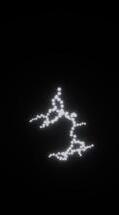



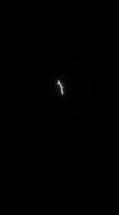
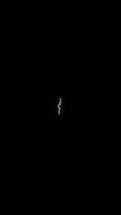

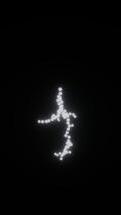
In reality, the fulgurites are grown mainly from the top point where they were struck by lighting. To create the real-like simulation of the fulgurites, the starting point is on the top of the structure and then it grows downward. Moreover, the initial area always has a larger structure than the latter. Using scale settings it is possible to simulate the gradual change in thickness of the fulgurites structure.

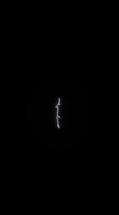
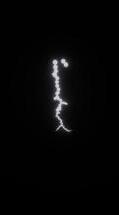
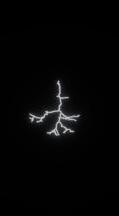
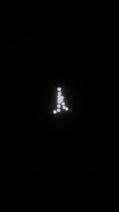

AEOLIAN | APPENDIX | 435 | 5.00 s. 5.00 s. 5.00 s. 5.00 s. 2.50 s. 2.50 s. 2.50 s. 2.50 s. 7.50 s. 7.50 s. 7.50 s. 7.50 s. 10.00 s. 10.00 s. 10.00 s. 10.00 s.
RANGE SEED INT NUMBERS RADIUS SCALE 70 1.0 7500 2000 50 100 1.25 6000 6500 300 120 1.0 10000 2000 100 200 1.0 15000 6000 100 RANGE SEED INT NUMBERS RADIUS SCALE RANGE SEED INT NUMBERS RADIUS SCALE RANGE SEED INT NUMBERS RADIUS SCALE It. 1 It. 2 It. 3 It. 4
FULGURITES SIMULATION - STRUCTURE FORMATION
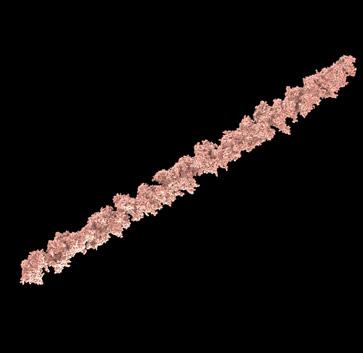

In this step, the main focus of the simulation is how to grow sand particles from the initial path—using the DLA algorithm with specific settings to reproduce the part of the particles, growing from the starting pathway to the outward direction, creating the roughness shape of fulgurites body. Controlling of alignment of particles and noise scale settings can simulate the roughness and bumping skin of the fulgurites simulation, in reality, which is the skin of fulgurite’s outer shell.
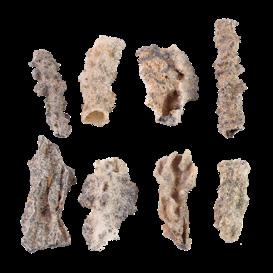
AEOLIAN | APPENDIX | 436 |
PARTICLES AGGREGATION
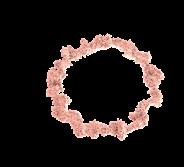
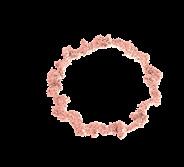
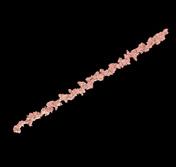

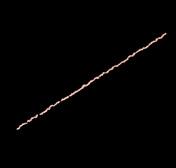
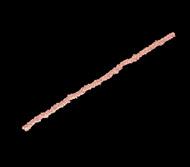

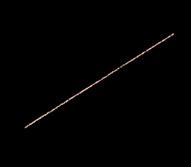

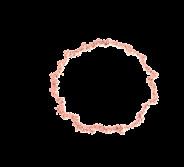

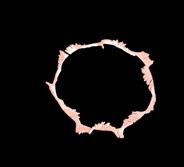
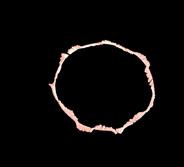
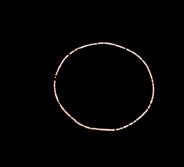
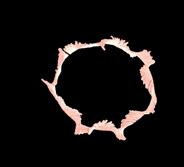

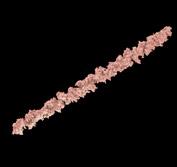
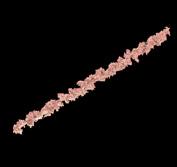
The initial area in these simulations is a linear and circular shape—the growing particles created the roughness of the skin and the thickness of the structure.

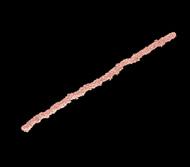
AEOLIAN | APPENDIX | 437 | Circle Linear 2.00 s. 2.00 s. 2.00 s. 2.00 s. 4.00 s. 4.00 s. 4.00 s. 6.00 s. 6.00 s. 6.00 s. 8.00 s. 8.00 s. 10.00 s. 10.00 s. 4.00 s. 6.00 s. 8.00 s. 10.00 s. POINTS/FRAME ATTACH DIST. NOISE SCALE ALIGNMENT 1000 1.75 3.00 0.2 POINTS/FRAME ATTACH DIST. NOISE SCALE ALIGNMENT 1000 1.00 7.00 0.4 POINTS/FRAME ATTACH DIST. NOISE SCALE ALIGNMENT 3000 1.00 3.50 0.8 POINTS/FRAME ATTACH DIST. NOISE SCALE ALIGNMENT 3000 1.75 6.00 0.4
FULGURITES SIMULATION - STRUCTURE FORMATION
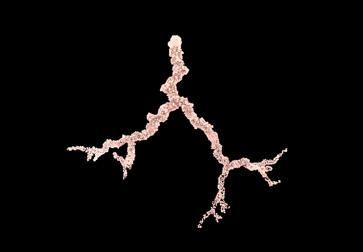
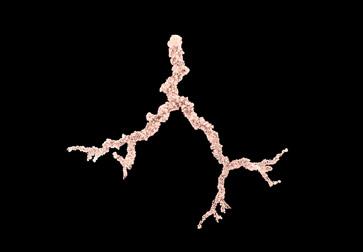



COMBINING
The structure formation and particle aggregation are combined in the final simulation. In each second, the structure grows from the top to the bottom direction, and the particles grow following the structure path.

AEOLIAN | APPENDIX | 438 |
2.00 s. 6.00 s. 10.00 s. 4.00 s. 8.00 s. 12.00 s.
RANGE SEED INT NUMBERS RADIUS SCALE 50 1.0 5000 5000 200 2000 1.75 3.50 0.3 POINTS/FRAME ATTACH DIST. NOISE SCALE ALIGNMENT
RANGE SIZE OF BRANCHES
SEED INT
DISTANCE BETWEEN PARTICLES
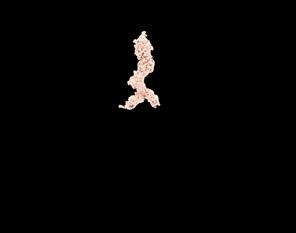
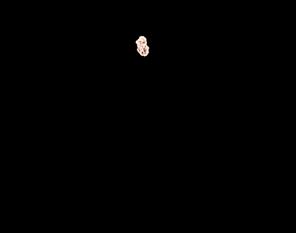
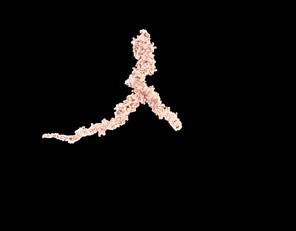
NUMBERS NUMBERS OF PARTICLES
RADIUS SIMULATION RADIUS
SCALE
START/END SIZE DIFFERENCE
POINTS/FRAME NUMBERS OF PARTICLES PER FRAME
ATTACH DIST. PARTICLES DISTANCE
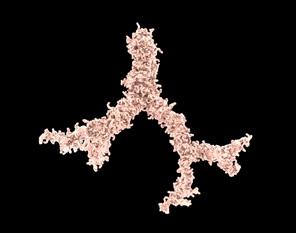
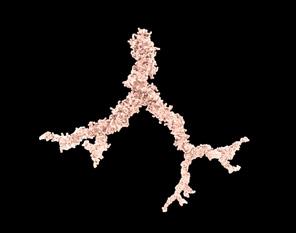
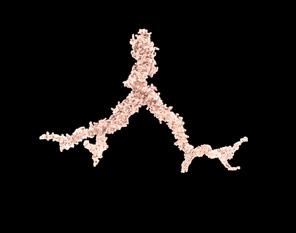
NOISE SCALE
ROUGHNESS
ALIGNMENT PARTICLES
ALIGNMENT
AEOLIAN | APPENDIX | 439 | 2.00 s. 6.00 s. 10.00 s. 4.00 s. 8.00 s. 12.00 s. RANGE SEED INT NUMBERS RADIUS SCALE 50 1.0 5000 5000 250 2000 2.50 5.00 0.5
ATTACH DIST.
ALIGNMENT
POINTS/FRAME
NOISE SCALE
FULGURITES SIMULATION - 3D PRINTING

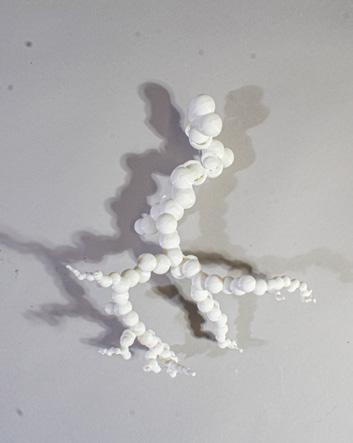
After the DLA simulations the thickness, length, number of branches and direction of the structures are able to be controlled. The results of the simulations were 3d-printed for the physical expertise.
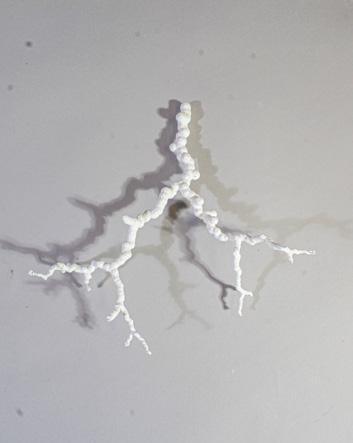

AEOLIAN | APPENDIX | 440 |
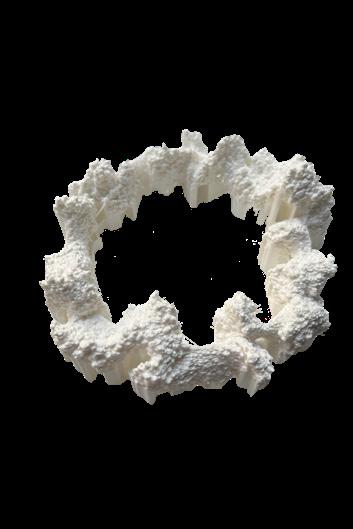
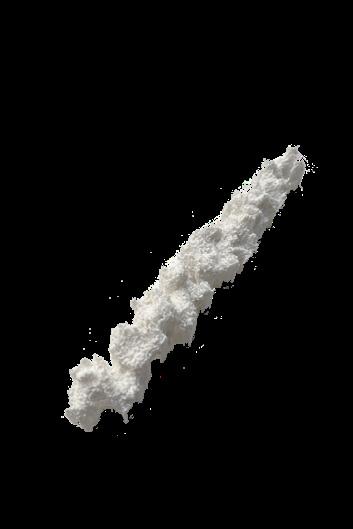
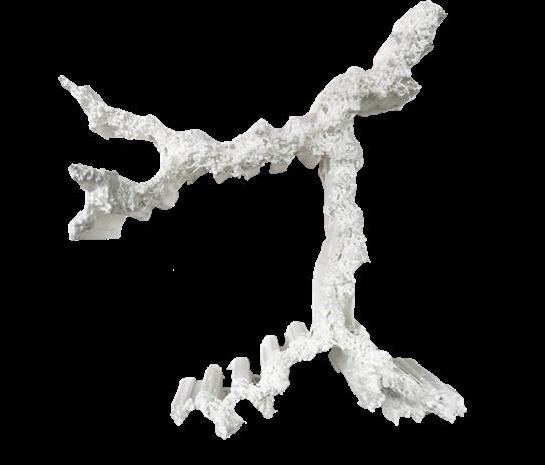
AEOLIAN | APPENDIX | 441 |


2021-2023
































































































































































































































































































































































































































































































































































































































































































































































































































































































































































































































































































































































































































































































































































 Robots’ Drawing from Iteration 1
Robots’ Drawing from Iteration 1















 Robots’ Drawing from Large Scale
Robots’ Drawing from Large Scale


















































































































































































































































































